Trout & Grayling Report
by Oliver Burch
December 2018
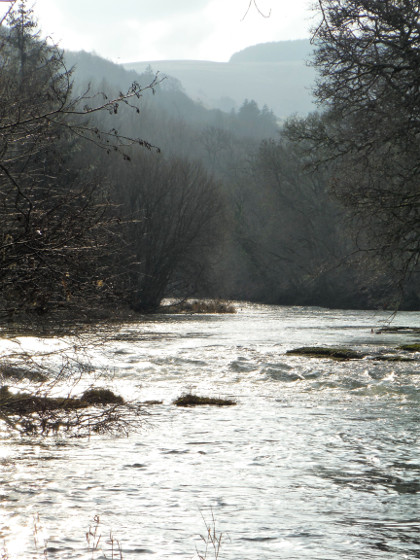
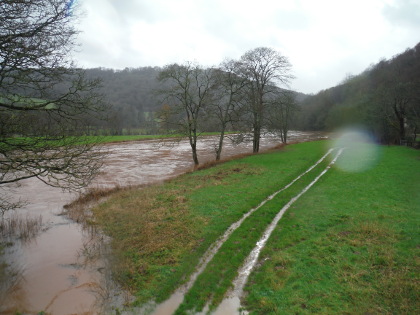
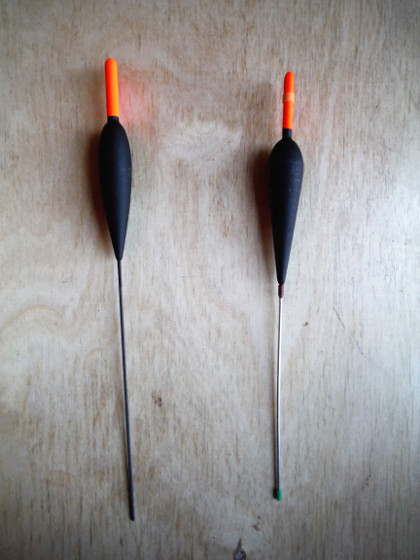
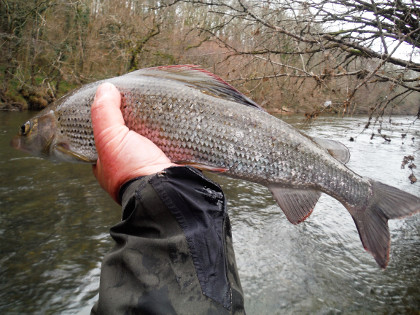
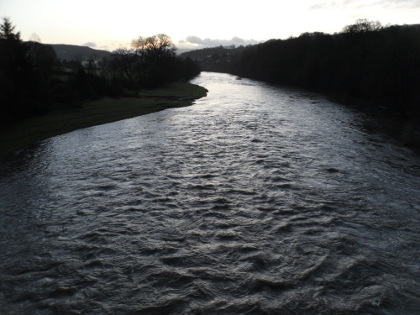
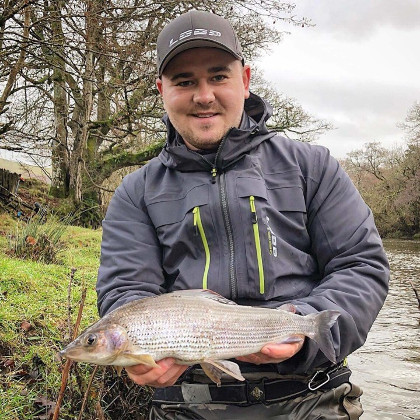
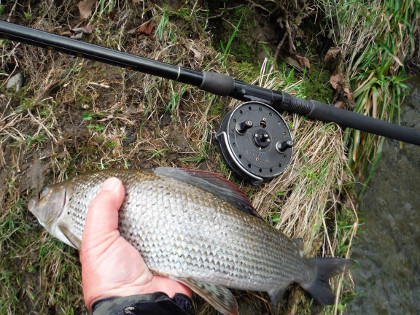
December, the winter solstice month, must always be a dark time. At this latitude we can expect light from about 8 in the morning till 4 or 4.30 in the afternoon, a little more or a little less according to the cloud cover. This year in our region it was mostly cloudy and usually with rain somewhere in the offing too as front followed front on winds from the western ocean. It's a very curious fact - and maybe some meteorologist can explain it to me - that if clouds are already hanging low, the rain usually starts with the dawn. But if the later part of the night has been one of rain, then dawn often brings a cessation, briefly at least. Often I find myself watching this, early at the waterside, drinking coffee by the car and waiting for enough light to put the tackle together. So December 2018 was dark and wet, but at least it was mostly warm. To be honest, it was not much of a fishing month, except for the last few days. I fished local lakes a good deal for rainbow trout, but river fishing was hard to find as the rains and floods continued until Christmas.
All our rivers seemed to be in flood at the beginning of the month, but apparently North Wales escaped some of the rain which we had received further south. Rob Evans went up to the Dee and the International Grayling Festival at Llangollen on 1st and 2nd December, and that event went ahead as planned. The river seemed in barely fishable condition but in fact plenty of grayling were caught by the assembled match teams. Then a solitary report came in from SW of Derby, who fished the Llangollen Maelor Angling water of the Dee on the 1st and caught 11 grayling. He was trotting red maggots and worm and reported that the river was up almost half a metre, but not too coloured. He was fishing with a centre pin reel and one of the Italian "Bolo" floats, originally designed for fishing deep water on the great River Po at Bologna, and not so very different from our wire stemmed Avons.
SW mentioned that he desisted from loose feeding as it seemed to switch the grayling off. This is an interesting point. As a boy fishing for roach and chub, I was taught that when trotting maggots in winter, if any loose feeding is done, it should be carried out with a very sparing hand. The reason is not so much because fish are easily over-fed in cold temperatures, but also because of difficulty in working out where loose-fed maggots, a very light ground bait, are travelling in strong winter currents. If the maggots are drifting hundreds of yards before reaching the bottom, loose feeding may achieve nothing more than to send the grayling chasing downstream after them! Thames anglers used to use a bait dropper to get down to the bottom - I may still have one somewhere - but I doubt that most grayling anglers want to tote so much kit around or accept a static mode of fishing.
On our upland rivers it's common enough to try a likely run, probably baiting with double maggot, and get a solid bite from a good grayling on the first or second trot down. If there is one grayling, very likely a shoal is there, particularly in the depths of winter. You could try a little loose feeding if it seems likely to concentrate the fish, but, if you do so, make it little and often and I would confine it to no more than half a dozen maggots on each trot. If it doesn't work, desist at once; you may get on better introducing only hook baits. After all, you already know where the grayling are. If, after catching a few, the shoal seems to be still present but becoming nervous about the tackle, a common enough scenario demonstrated by lightning-quick flickers of the float which never quite goes under, go down from double maggot to single maggot and consider reducing the size of the float and associated shot. Experiment with the float setting. On some occasions it may help if the bait is dragging the bottom. Alternatively, try holding the float back occasionally or reducing the depth at which the bait swims; often you may get more positive bites if the grayling are in the mood to rise from the bottom to take. On occasions, I work a shoal from the side, wading with a 12 foot Tenkara rod and using a single maggot, a dust shot or no shot, and literally a match stick as a float. This is hardly "long trotting" but can be absolutely deadly. Another possible disadvantage of loose feeding is that you may wake up some unwanted trout which will certainly push aggressively in front of the grayling. In any case, I find a half pint of maggots is as much as I need for a winter trotting day.
The floods continued on for many days and some who had organised grayling fishing holidays were sadly disappointed. Bravo for trying, GB from Hertfordshire who fished the Llynfi with heavy nymphs on the 8th and managed to hook - and unfortunately lose - a grayling in a slack at the side of the main current. I calculate that the level on the Three Cocks gauge must have been 0.65 at the time. 0.50 here is about the maximum, so conditions must have been challenging. PD from Buckingham was faced with dangerous conditions at Ty Newydd on the same day, the Wye being in high muddy flood and the Llanstephan gauge out of sight below the surface. Wisely he stayed out of the river. There were later attempts to fish Gromaine and the Colonel's Water of the Irfon. GB did try the Arrow's Court of Noke on the 9th, but was defeated by the conditions. Now the weather became extremely cold for a short period while the water was still high. On the 14th BH from Oxford with a friend fished at Wyecliffe near Hay, normally considered to be near the lower end of the grayling zone, and managed 11 grayling around the 12 inch size. On the following two days PB from Leicester with a friend tried trotting the Irfon at Cefnllysgwynne, but were virtually overwhelmed by post-spawning trout. Between showers of rain on the 15th and despite the high water, Shaun Watkins and three friends from Hereford did manage 26 grayling from Shaun's upper Wye beat at Craig Llyn. This nymph-fishing band enjoy producing some consistently good catches from the upper Wye.
A long gap in reports followed due to high water until after Christmas when high pressure weather established itself, the skies cleared and the water levels slowly began to subside. We didn't see the sun so much, but the air temperature was unusually warm, very often in double figures. On Boxing Day, owner Shaun Watkins with two friends fished at Craig Llyn for 27 grayling. Apparently this day was preceded by a bacon breakfast cooked in the fishing hut. So that's what the hut on wheels is for. AG from Cardiff fished the Irfon at Cefnllysgwynne on the 27th for 11 grayling and noted that one fish with a distinctive deformed gill cover had been caught by him the month before. You know, I think this probably happens much more often than we realise. Back in the summer I caught a nice lower Monnow trout (in this case with a slightly deformed ray in the caudal fin) and eventually realised from comparing photographs that it was the same fish I had caught in the same place a few weeks earlier. It took a dry Parachute Adams each time and presumably hadn't learned much from the first experience. An experience with either a very game or very stupid fish occurred at Cefnllysgwyne a few winters ago. I was trotting maggots down to a shoal of grayling and through sheer clumsiness allowed a sudden lunge from a hooked fish to break me. I was thinking that it's a shameful thing to lose tackle in fish, but I put on another hook link and went right back to work, almost immediately hooking another grayling in the same spot. Only maybe it wasn't another grayling, because this one felt a bit tired as if it had already been played for a while. Sure enough, when I got it into the net, there were two identical size 16 hooks to be removed from the upper lip, the one currently attached to my tackle and the one which had broken off 10 minutes earlier. Apparently the experience of being hooked and played for a while had not diminished this grayling's readiness to take. On the 30th TD from Stourbridge fished at Craig Llyn for 10 grayling. Thus, a difficult month on our rivers ended with a few halcyon days for those who turned out.
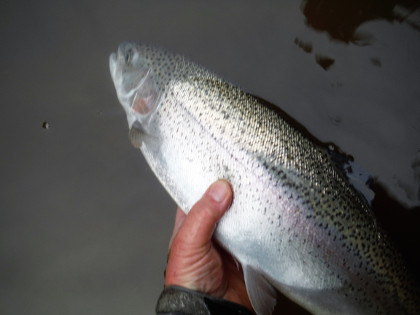
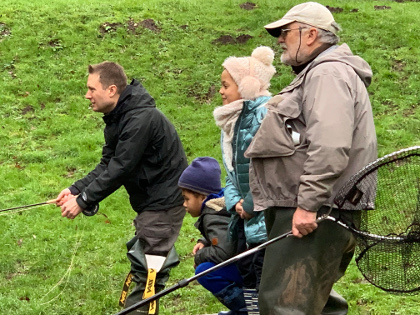
There tends to be a festive mood on the local trout fisheries just before Christmas. For one thing, the Exmoor hatchery which supplies them all saves up a few big rainbows to treat the regular customers on the last deliveries of the year. I was pleasantly surprised one morning to find a 5 pound fish in our Forest syndicate lake (we never order such monsters). Also we had our family visits early this year and two of our grand-children wanted to have a go at fishing. I'm all for that, although with children I would advise that it's a good idea to wait until they actually ask to try it. Let them pester you first. I have a fishing friend who has tried and tried to persuade his son into the sport, only to find he seems much more interested in football. Nerma and I have four children between us, but it turned out there is just one who likes to fish. Of the five grandchildren to date, well, we shall see in time. Anyway, Eddie and Ella were duly set to work with a little adult help at the Big Wells trout fishery in Redbrook and caught a rainbow each. A lovely morning finished up with lunch at the Ostrich, which is just uphill in the ancient village of Newlands. Wyesham salmon anglers, or at least the ones prepared to miss a fish in the interests of lunch, will know all about the Ostrich across the road from the church, with its gently smoking log fire, jazz playing quietly in the background, well-chosen wines and cooking to die for.
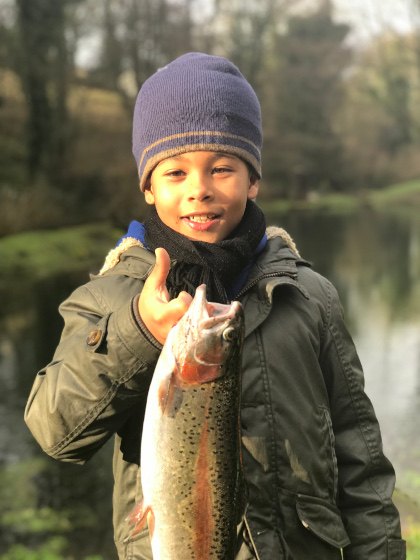
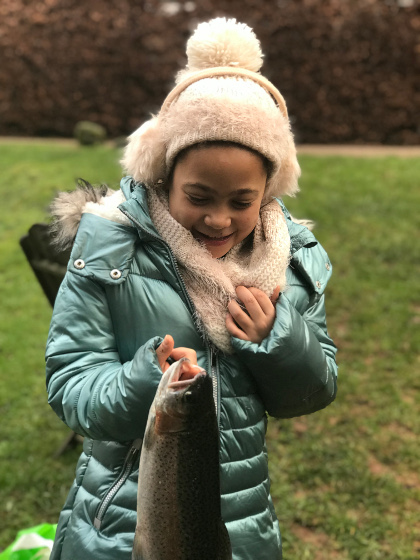

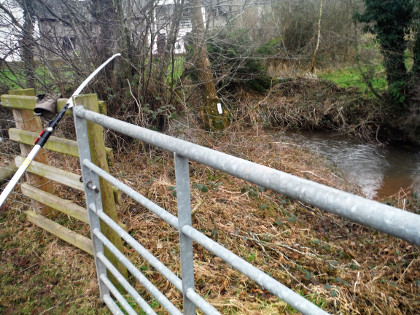
While working on the Wild Streams this year, I was reminded yet again what a curse is barbed wire, not only for the winter working parties but for anybody fishing these small streams during the summer. What tends to happen is that the original wooden stiles over fences become rotten and insecure, or galvanised iron gates put in during coppicing and livestock fencing projects end up in quite the wrong places for passage because of eroding banks. What's left to get past or over is barbed wire, and very often extra barbed wire put in since the coppicing by inadequately briefed fencing contractors. We can't go cutting it away if we wish to remain friends with the landowners. I don't mind rolling under a cattle fence of two barbed wire strands, but where sheep are the livestock involved, you very often find a mesh fence of small squares from the ground and barbed wire along the top. In this case over the top is the only way to go and with a very good chance of ripping your expensive waders as you do it. Short of a new gate or a stile, we used to put lengths of grey foam pipe insulation over difficult places. This comes with a longitudinal slit so it goes over the wire, can be bound in place with cable ties and lasts for a short while. Before long, however, the barbs push their way through as the foam breaks up and it certainly doesn't last in place for a season. A better solution is a piece of hard plastic water pipe with a slot cut in the side. This is tougher and can be carried around with you as you fish, assuming you don't mind a metre of pipe sticking out of your back pack.
The other day, Chris at the Foundation put me onto another idea. This is a metre long canvas strip, really tough sail-cloth material, which encircles the barbed wire strand and is then held in place by Velcro pads. This folds away neatly to go into a jacket pocket, is not too much weight to carry around, easy to put in place and remove, and does the job beautifully. It is called a "barbed wire cover" logically enough, and available from Fur, Feather and Fin who sell it to shooters and fishers both - see www.furfeatherandfin.com
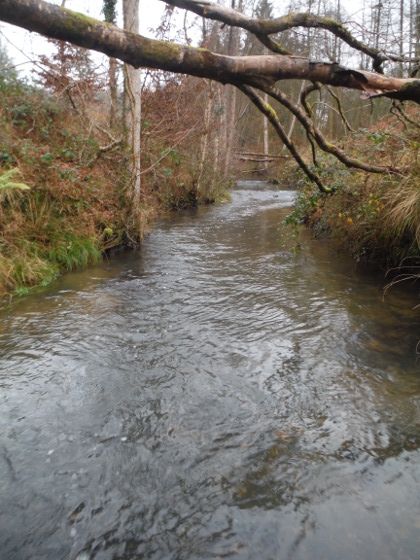
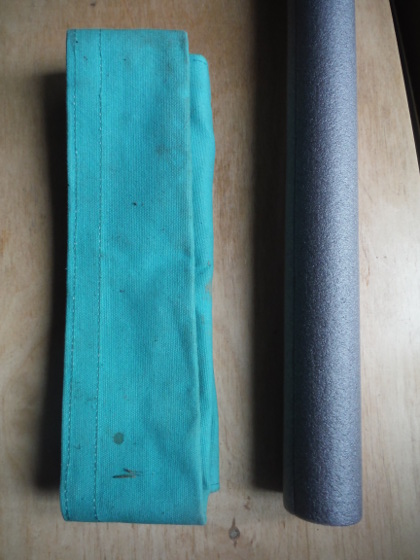
For those interested in NRW's proposed by-laws for migratory fish, the public inquiry opens at 10 AM on January 15th at the Elephant and Castle Hotel, Newtown, Powys. The NRW will give evidence first. I am not sure if the process of hearing evidence is time-limited, but the report is expected within 3 months of the closure of the inquiry. It seems unlikely, therefore, that any changes will be introduced before the 2020 season.
Sad news came a few weeks back that we have lost angler and television presenter John Wilson, who died in Thailand. I must say that his programmes gave me a great deal of pleasure, and I even include that famous giggle which always overtook him when playing a fish. I understand that habit annoyed some, but to me it seemed like pure boyish delight which was quite infectious. I confess I tend to do the same when I have a good fish on. John had an easy going style and descriptive powers, accessible to all, which made him a natural for television. Don't under-rate this; the art of speaking to the camera can be studied, but many people (including me) just don't have the knack. John was not so much a game angler but in coarse fishing, particularly with a trotting rod and a "pin," he was a master. His later programmes were often about exotic fish in far-flung locations, but I liked best his earlier programmes made on home ground, catching winter roach on the Wensum and Waveney, or barbel from the Severn and Wye.
I'm afraid that the darkness of winter, the long nights and the short days, hardly bring out the best in me. Those niggling traits of intolerance rise to the surface. Maybe it's a normal trend that, as you get older, things around you bother you more. I may not be alone in this. For example, the other day I heard on the radio about Bristol's "punctuation vigilante." It seems this chap lurks in the dark night streets of the city dressed in black and, when he judges the moment is right, swoops into action with portable ladder, paintbrush and glue pot, correcting the grammar and punctuation on street and shop signs which have offended his sensitivities by being written in English which, as he puts it, is just plain wrong. Most of the problems, I understand, come from the misuse of apostrophes by those who confuse the possessive and the plural. Our hero thus has apostrophes ready to be stuck on, and white patches ready to place over apostrophes which shouldn't be there. I thoroughly approve but I was rather surprised to learn that this grammatical caped crusader is still only in his thirties. I was starting to imagine that it was only the elderly like me who get themselves discombobulated about the misuse of the language. I would have to include myself in that group of protesters, so I'm putting a marker down right now.
Grumpy old man as I am, I suppose that I must recognise in my saner moments that the English language, like all modern spoken languages, is a living, changing creature and probably should be allowed to go where it will. You can't really legislate for language. In the 19th century it was the Greeks who made an attempt to clean their language of the Turkish and Slavic words which some believed had defiled its classical purity. So was born Katharevousa, "cleaned Greek," which was always hated by poets and writers and eventually became associated with reactionary right wing politics. Katharevousa as a project is no more in Greece, having died with the Colonels' regime. However, some politicised scholars in Croatia are busily working on Serbo-Croatian in just the same way, in hopes of creating a purified Croatian language with lots of Latin words, Catholic references whenever possible and definitely no Turkish words. A friend of mine in the UN called Tony used to be addressed as "Antonius" by Croatian politicians, which he and we found ridiculous. Croatia's nationalist government may be pleased by the result of these efforts, but I doubt whether the populace will speak it much. On the other hand, speakers of the colloquial and neighbouring Bosnian and Serbian versions of the same language, best described as expletive-laden quite apart from the Turkish words, can hardly get through a sentence without "f*** your mother" being used once at least. The phrase has become so over-used as to be virtually inoffensive.
Meanwhile English has of course been affected by the majority of English-speakers around the world who have never even visited Britain. I will be the first to admit that American English has affected my choice of words, probably because of the number of western movies (sorry films?) I have watched. Military-speak is another influence. After several years working with the US military, I had to stop myself coming up with "outstanding!" as a description of any vaguely positive event. (I spent a similar period with the Russian First Separate Airborne Brigade too, a liaison almost unimaginable today. The Russians turned out to be great fun and they gave me their blue beret and striped under-shirt as mementos when we parted, but I don't think they altered my speech patterns much). From my daughter now, as well as at the staff college, I still get to hear British military-speak. Thus, "we smashed it, Dad!" translates as "we pushed straight on and solved the problem without too much thought about it," while "does he get it?" means "does he fully understand the situation?" Military planning throughout NATO has also developed a more formal English language of its own, for example substituting the words "end state" for "result," which is a little boring but easy enough to understand. Military-speak, of course, can consist mainly of acronyms, so you are supposed to know that a COA is a Course of Action but a COG is a Centre of Gravity and a TOC is a Tactical Operations Centre. In the field, good relations with the officer commanding the TOC are always advisable. PIFWiC is my favourite one - Person Indicted For War Crimes. (The small "i" is there because it has to be). In Bosnia we used to have a dog named PIFWiC.
There is always regional dialect of course, which often has its charms. It's perfectly OK to say "ain't" in most American western and southern states. President Lincoln, who could certainly use the English language better than most, was fond of using "ain't" in his more humorous moods. If the man who composed the Gettysburg Address wanted to use that short form, who are we to complain? Meanwhile and for another example, why shouldn't a small grayling be called a shott or shoat in Shropshire? A shoat can also be a small pig and the same word would be familiar in Kentucky. The Forest of Dean dialect, in its older form at least, gleefully takes a hatchet to any English grammar book. There is the habit of transposing nominative and accusative cases, which you will still hear in local pubs and shops: "Him told I all about that last week, old butt." I also like the Forest habit of adding the word "mind" at the end of almost any sentence: "Be up and see us soon, mind." Also the much-used expression: "I spect it's something to do with it all," which means that the speaker totally fails to understand the situation which has just been discussed and now wants to talk about something else.
I had a house master at school who always objected to anybody describing a "retrograde step." “Retrograde comes from the Latin retro and gradus," he would explain. "So retrograde already means backward step. How can you have a backward step, step?" I always thought that was a bit pedantic. My sister, an English teacher, who usually signs herself as Disgruntled of Chessington (and who reads this letter, by the way, looking for split infinitives and thus keeping me on my toes), tells me she is annoyed by people saying that something is "very concerning," rather than "a matter for concern." She also wants to know why this habit of a rising inflection when pronouncing the couple of words at the end of a sentence has crept in, thus introducing an element of uncertainty as if the speaker expects to be challenged? Why do young people do that? And why is anything even vaguely desirable or useful always described as "amazing" or "incredible" these days?
Then we come to the expressions and pronunciations which really annoy me for some reason. This is probably a sign of advancing age. But oh dear me, why do so many people now say "everythink" when they mean "everything?" Why do so many people now write that they "could of" done something or other when they clearly mean that they "could have" done it? Have you noticed that the old London cockney - which I rather liked - is disappearing and being replaced by a new version in which nobody pronounces the letter "t." Just listen to a young London social worker, bright-eyed and bushy tailed, trying to pronounce what is probably her favourite word: "community." Meanwhile I feel the need to ask where this new verb to "disrespect" came from? You know the one: I disrespect you; you disrespect him; he disrespects me etc. I thought that was American ghetto slang and ugly at that, but apparently it goes back to obscure 17th century English, so I suppose I will have to accept it. (If you want to hear truly vintage English, go to up-country Jamaica. In the Cockpit Country older people speak with a courtly politeness and don't "want" things, they "crave" them).
For a few years now we have had that strange habit of describing a revolving dialogue: "Then he turned around and said to me..." Why all this rotation during conversation? An image of the whirling dervishes of Konya comes into my mind. Situations used to go wrong or deteriorate, now they always have to "spiral out of control" evoking the image of a failed missile with a defective giro compass. Once we had "problems" to deal with; now we have "issues" instead. Today, even BBC newsreaders describe being "bored of" something. I find myself jumping up and down in front of the television shouting: "It's with, bored with, you idiot!" That change crept in during the last decade or so. All too often lately, even from journalists, I am hearing the phrase "very unique." Something is either unique or it is not; it cannot be "very unique" or "a bit unique."
Another thing: why is any object vaguely admirable or nice to look at always described as "iconic" these days? As a result, "iconic" now is a word almost impossible to use. This reminds me of my grandmother who lived to be 99 years old, an Edwardian lady somehow surviving almost to the end of the 20th century, and who would often describe "such a gay afternoon" when visitors had been with her. Nobody in the family managed to get it across to the old girl that the gay word, one of her favourite adjectives, was being used in a different context now. Another concern of mine: why do magazine articles and filmed documentaries insist on events which happened in the past being described by the writer or presenter in the present tense? You know the kind of thing: "Napoleon, seeing that Wellington is hard-pressed at the centre and the battle is reaching a critical point, decides now to commit his famous Imperial Guard." I gather this is now called the historic present tense and that over at the BBC Melvin Bragg and John Humphrys have practically come to duelling with pistols at dawn over it.
For that matter why do most television documentaries have continuous upbeat background music of guitars and drums and insist on focussing the camera constantly on the presenter, who is explaining all the time and not very eloquently how what we are supposed to be looking at makes him or her feel? Amazing, usually. Most of the fishing documentaries are like that these days (not you, Paul Young) and most of the wild-life documentaries (not you of course, David Attenborough). More serious: what are we going to do about this word "awesome?" Could a UN resolution perhaps get it banned if we can get it through the Security Council? And, worst of all, why do young people describing past conversations say: "I was like..." and "he was like..." when what they actually mean is "I said..." and then "he said..." I think I would prefer the turning round to the being like, if I get any choice in the matter.
Then we have all those politically correct uses of language which actually mean very little. People don't do things any more but "work towards" them. If you want to sell a project nowadays, I can recommend including the words: "It's all about partnership" - you can't go wrong with that phrase. You see these strange juxtapositions of reassuring words, always in the present continuous tense, on the sides of vehicles belonging to various public organisations. "Working with the Community" is a favourite one. I always feel an urge to cross it out and substitute: "Using up large amounts of tax-payers' money with little apparent result." Herefordshire has recently come up with some roadside signs for approaching motorists: "Welcome to Herefordshire: You can." Look back the other way and you will find somebody on the Gloucestershire side has chalked up: "Welcome to Gloucestershire: You definitely can't." Now here is a new and most irritating development for an old man to deal with. Almost anybody being interviewed by the media now prefaces a detailed (and obviously prepared) reply to the journalist's question with "So,"...followed by a slight pause, before setting off into the explanation. So annoying that.
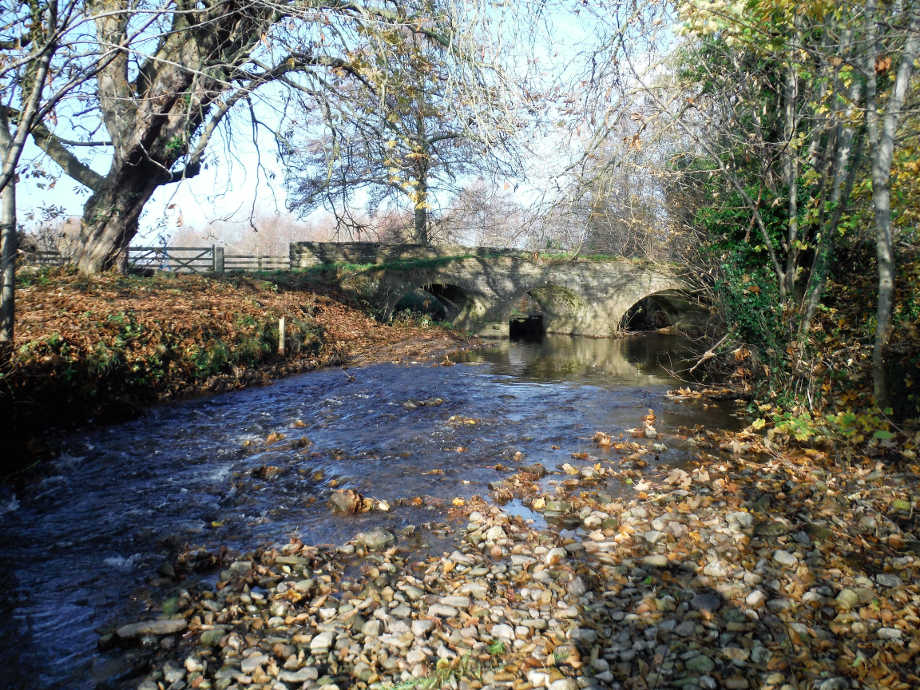
Well, that was my mid-winter rant for this year. Thankfully the WUF let me off the leash now and then. I'm off now to read my copy of The Oldie and maybe plan another grayling trip. Happy New Year to all!
Oliver Burch www.wyevalleyflyfishing.com
November 2018
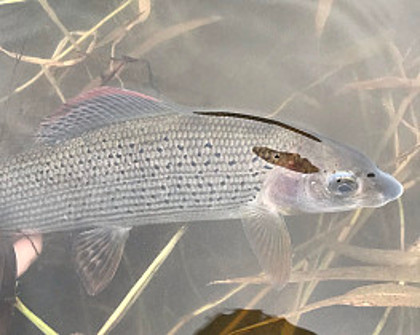
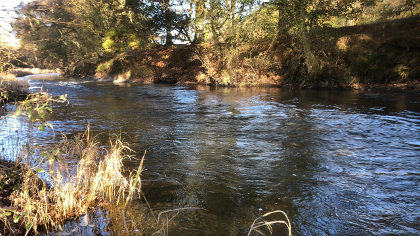
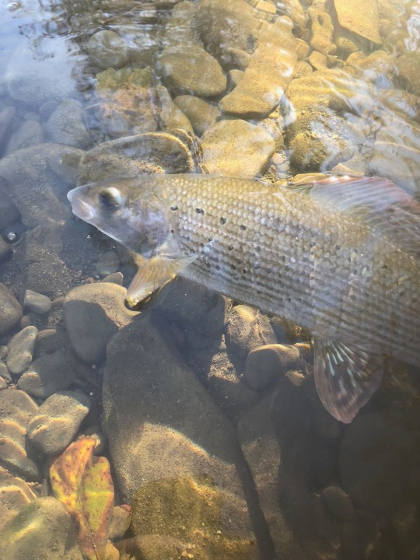
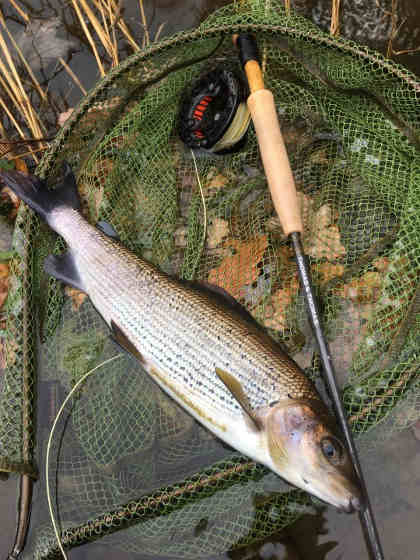
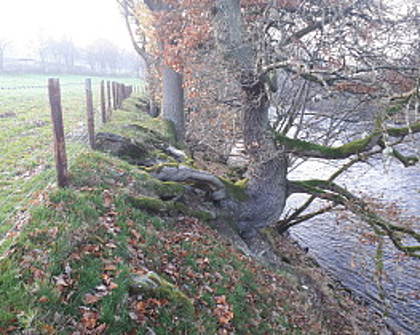
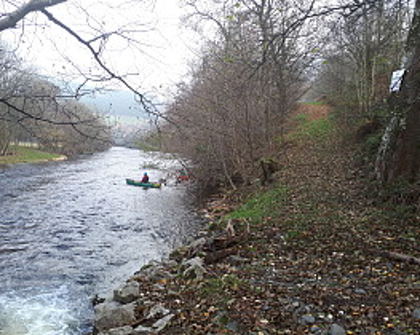
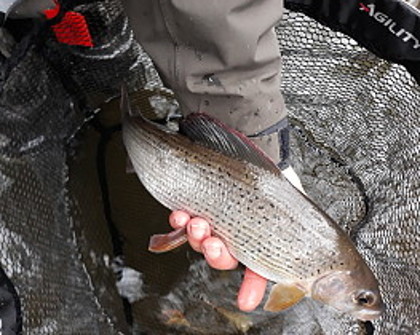
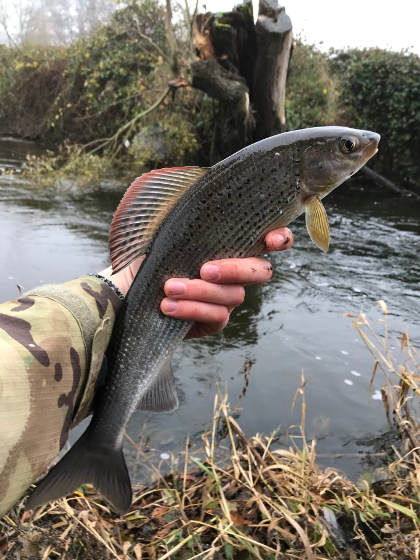
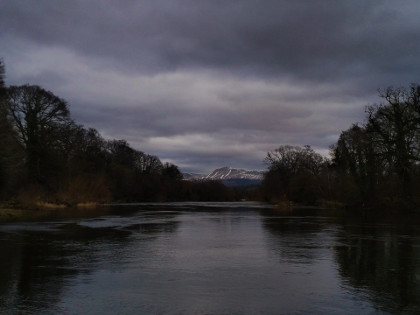
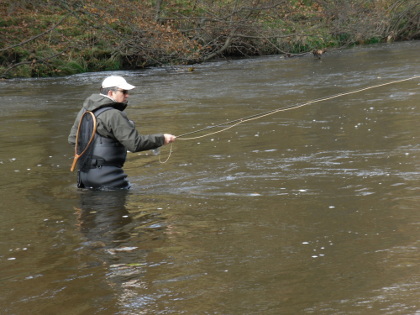
From November onward we often have a choice in our grayling fishing where the fishery owner allows it: do we opt for trotting a maggot under the float or fishing either one or a team of flies, and on the bottom or on the surface? There are those who will tell you that the trotting option is the easier method and that it will always score better. I'm afraid I don't agree with that at all! It's unwise to state absolute rules in any kind of fishing, but my experience is that hatching flies on the surface usually trump bait as far as grayling are concerned. I write this with those times in mind when grayling have started rising a few yards away to a surprise winter hatch of large dark olives. Often enough I have not had a dry fly rod made up ready and my maggots or a worm under a float, although trotted accurately to the spot, have been doggedly ignored. The same might apply to a team of heavy nymphs; the attention of these fish is fixed on the surface and will be until the hatch finishes. This may seem disconcerting, but the general advice is not to underestimate the power of the fly rod, even as the weather grows colder. Another good general rule, or at least one I adopt, is to tend toward choosing the trotting gear when the water is high and coloured, but perhaps to favour the fly rod if the conditions are low and clear. This November we experienced several kinds of fishing, with dry flies, nymphs and trotting all scoring well at different times.
So, garnered from the month's reports: BT from London had a good time trotting the upper part of the Cefnllysgwynne beat on 2nd November and recorded 15 grayling. On the same day, noting that the weather was bright but the water very cold, Dave Collins and Glyn Williams from West Herefordshire and Worcestershire fished the GPAIAC water of the upper Wye at Builth Wells and caught 24 grayling from 8-14 inches using various methods. They were eventually tempted away from trotting by the dry fly as flies were hatching and fish were rising. AL from London was out downstream at Ty Newydd the following day and by contrast found few natural rises. In this case a team of spiders worked best and he recorded 8 grayling from 7 to 15 inches. WD of North Nibley also had 8 grayling from Craig Llyn, this time on nymphs. KJ from Abercynon with a friend fished Doldowlod on the 4th and together they had 15 grayling, one of which was measured at 51cm. That's 19.5 inches and, believe me, such fish are rare! I note from the photograph that the captor has one of those interesting Loop reels which run on 6 conical bearings rather than a central shaft.
At this point the weather took a hand, and from the 7th we experienced heavy rain on a number of consecutive days, the ground was truly saturated and the rivers rose into flood. You will read no more complaints of drought from me for a while! People were trying their best on some of the tributaries, but high water made fishing very difficult. I always feel sympathy for visitors from abroad who doubtless planned their trip months in advance, only to be confronted with conditions which are close to impossible. One such was TB of Hudson, Canada, who was hoping to catch his first grayling. After blank days at Dayhouse and Court of Noke, thankfully he did eventually catch a few on the North Wales Dee at the Glyndwr Preserve water - well done! AG of Harleston made another visit from Norfolk around this time and also managed to scratch a few grayling from the Dee. As the water levels began to fall, opportunities began to open up again. On the 16th GJ from Sevenoaks managed 5 grayling from the Court of Noke Arrow. On the 17th AG of Cardiff had 12 grayling trotting at Cefnllysgwynne while AG (Harleston) had 6 at Doldowlod. Meanwhile, CS from Yatton with his son managed 9 grayling to 1.25 pounds trotting at Abernant - a main river beat which gives more opportunities than most when levels are high. MP from Neath with a friend were on the Colonel's Water at the top of the Irfon and apparently caught red-handed a poacher operating with a fixed spool reel and a multi-hooked Devon Minnow. Unfortunately, if I read the report right, nothing was done about it at the time. Let's be quite plain about this: if we tolerate poaching, we are likely to see a great deal more of it. Genuine WUF customers who have booked will know quite well that they have the only tickets on this fly-only water. Given the date and the tackle he was using, this character will certainly have been trying to take spawning salmon or trout out of season. Ticket holders on the Colonel's Water are given the owner's mobile number plus a 999 call should have evoked a quick police response as the crime (theft of fishing rights, an offence under the 1968 Theft Act) was taking place there and then. Nothing much of value is likely to result from a subsequent report/complaint. Please see last month's newsletter for more details on poaching.
A day later IG from Hereford had 10 grayling on nymphs from Lyepole. AG of Harleston was still with us and managed 11 from Abernant. While the water levels were going in the right direction, the weather now became pretty raw with an easterly wind, daytime temperatures of 3-4 degrees, and we saw the first of the winter's snow on the mountains. On the 19th SJ from Herefordshire - now I have a good idea who that might be - had an excellent day at Lyepole with 15 grayling, mostly taken by bugging, but a few with the dry fly during a large dark olive hatch early in the afternoon. On the 22nd AM from Worcester was unlucky enough to break the tip of a new float fishing rod while trotting at Court of Noke. Luckily he had a spare and was able to catch 5 grayling to 14 inches. Around 4 o'clock as dusk was falling over the Arrow valley, he was impressed by a barn owl which swooped close over him. I always think that particular owl is a mysterious and rather magical bird. I remember one year I did some early season salmon fishing at Bigsweir in the gorge of the Lower Wye. Every March and April evening towards dusk, a barn owl would show up and sit quite close on one of the fence posts of the old railway line, apparently watching me. I had the idea he was mocking my lack of salmon as I made the last casts of the day.
A good few anglers were out on the 25th, a chilly Sunday with that east wind blowing. The weather was cold and grey, but grayling were still rising at times and friends of mine caught on both spiders and nymphs while fishing the Builth Town water. Three anglers - DM, SW and SB from Hereford - fished at Craig Llyn, mainly with dry flies and had 18 grayling between them. GW from Cheltenham with a friend took 25 grayling at Abernant. AC from Nailsea was also fishing with a friend at Cefnllysgynne. They recorded 21 grayling between them with the trotting method. A few of us were out fishing at the beginning of November's final week, but then a series of fronts arrived with rain accompanied by gales, and all rivers were out of commission due to floods at the end of the month.
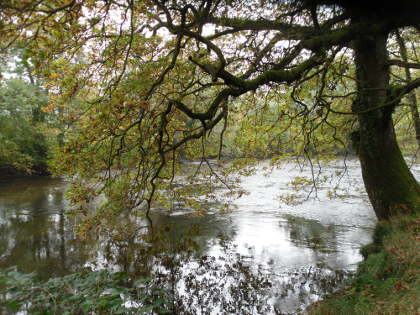

The final count of the 2018 salmon catch on the Wye came to just over 500, or around a third of what we have come to expect recently in a "good" year. As usual, I have been out and about for grayling on the upper river and tributaries a fair bit during the last month, and I certainly have the impression that the salmon stock in the Wye this autumn is much lower than usual. You can expect to see salmon during November. In some years and some places, particularly high up the system, you can expect to see a lot of salmon. Not so this year. There were one or two on the Irfon, and I watched a big coloured fish break the surface a couple of times at Builth the other day. We will see what the redd count shows up, although the success and relevance of that operation depends very much on water conditions as the winter goes on. Given the desperate drought conditions we experienced in 2018, I suppose we could hardly expect a better result - although there is that report of a 37 pound fish from Upper Bigsweir to add a bit of cheer to the record book. Let's not forget that the five and ten year average catches are still trending upward. During the rainless 2018 summer, there was much talk of "not since 1976..." I'm only hoping it will be 42 years until the next such drought, in which case I will be spared from seeing it.
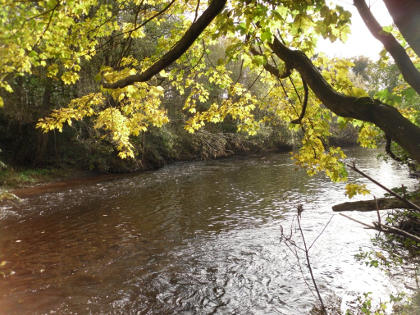
The latest report of the Monnow Rivers Association (see via 23rd November WUF newsletter) makes interesting if depressing reading. It includes the quite frank assessment that, since about 2010, the overall numbers of trout to be found in the Monnow have been falling to levels which are of grave concern. This is a brave admission from the organisation which has been working for years to restore the river. The MRA report relies mainly on electro-fishing results. I can only speak anecdotally, but I certainly have the impression that numbers of smaller fish, particularly in the main river, have been falling. Results on many stretches seem to have fallen back to reports of "just a few large ones," while not so many years ago there were plenty of 10 inch fish to be found. It seems to me that numbers of grayling have reduced also. The MRA report has no definite conclusion, but is worth studying in detail. As usual, there are several possible culprits. I see plenty of fish-eating birds here, perhaps even more than on other rivers. The factor which keeps coming into my mind is that this particular catchment has been experiencing a more rapid switch from stock-rearing to arable farming than most of our valleys.
Here's a curiosity. Trout and Salmon reports that a rare fly, Heptagenia fuscorgrisea, or the brown may dun, has been identified on the Lower Usk at Great Hardwick. It has also been seen on the Ribble. Dr Nick Everall of the Riverfly Census was the finder of this creature, previously only known in the Thames system and SW Scotland. Apparently it hatches in May and June and, judging by the description, has probably been mistakenly identified as a large brook dun in the past. I can see why some anglers get hooked on aquatic entomology; it's a slightly obscure field but, quite apart from the obvious assistance to fishing, one in which you might well stumble on something new.
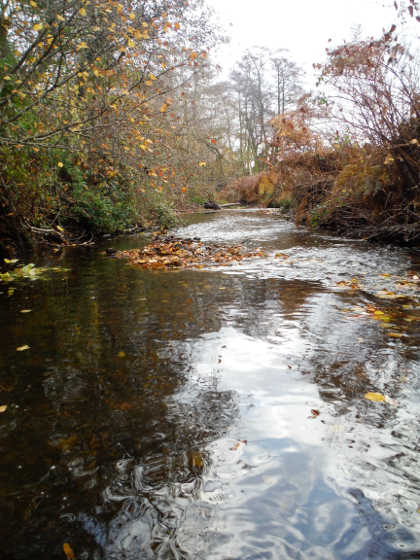
While the rivers were up I had a spell of fishing for rainbow trout in Forest of Dean still waters. There isn't much choice when all moving water known to contain grayling is muddy and flooded. So I fished our syndicate water a couple of times and the commercial fisheries once each. What made it extra fun was that I used dry flies all the time. Despite having reached the middle of November, the weather remained comparatively warm and the rainbows were still looking up. It is remarkable how even very spooky trout on clear catch and release commercial waters will fall for a dry fly. I think the reason is that very few visitors to such fisheries consider the dry fly as an option, so the trout don't see many artificial patterns on the surface. I was using dry buzzer patterns in size 14 and 16, and the takes were coming quite regularly. It's always fascinating in clear water pools to watch the trout sidling up as if they didn't really intend to do anything, and then sucking the fly in with an almost surreptitious sip.
I tend to arrive early at our Forest Pool (the syndicate water), just about dawn if I can, mainly to get ahead of the dreaded dog-swimmers. Thus, while I make the tackle up, I sometimes get a glance at the creatures of the night if they are delayed on their way home. Pigs are now routine visitors to the banks which they diligently spend the night ripping up and often still out in the open at dawn. There might be a family group or a big boar standing solo before he turns back into the trees. I remember a badger making a trip home over the dam and we know we have an otter visiting us now. Recently I have caught several fish with bite marks. Fallow deer will occasionally be visiting the water if all is quiet. The Forest panther legend has been resurrected recently and I know several foresters who swear blind they have seen a big black cat. This story has been running for twenty-odd years. I never saw any such thing, but believe the shape of a boar through the thick woods might be easily confused with something else. This morning it was a muntjac deer, the first I have personally seen in the Forest although they have been populating the countryside around over recent years. It was a curious little thing and for a moment I was not sure what I was looking at. He shyly picked his way down to the water, but before he could take his drink the early bus to Cinderford with its heavy diesel engine rumbled across the dam and he was away, the white scut of his tail showing as he disappeared in the trees.

Dark winter evenings are upon us; there will be fly tying ready for the next season or do you perhaps find yourself in the mood for reading another good fishing book? I'm going to recommend an unusual choice. Sometimes, now that I think of it, you find good angling writing in surprising places, or that is to say in books which aren't on the surface supposed to be about angling at all. Hemingway's collection of work is one famous example - if the man saw a chance to bring some fishing into one of his novels, he didn't miss it. Whatever you may think of his shortcomings as a human being, the quality of his writing is hardly in doubt. Less well known I am sure, but a favourite of mine since I first discovered it, is TH White's England Have My Bones, which begins with spring salmon fishing in Scotland. Most people look blank when you mention this one and it's out of print, although I dare say an internet search would turn up a copy. Earth Stopped or Gone to Ground from the same author, humorous portraits of the hunting scene, might be slightly more familiar. The one book which "Tim" White is surely remembered for is the Arthurian novel The Sword in the Stone, which was followed by three more in the Once and Future King series, including The Candle in the Wind. The subsequent musical Camelot and the film of the same name must have earned money for White's estate over decades.
Who exactly was Terence Hanbury White? It seems to me there was a "lost" generation of talented writers during the twenties and thirties who either had survived service in the Great War and been deeply affected by it, or had just missed the massacre and maybe could see what was coming next. Either way, there was a loss of faith in modern civilisations and fellow human beings which at times filled their work with pessimism. Some of them sought the wilderness and some sought nature. Gerald Brenan filled trunks with books to read and headed for southern Spain, eventually packing his library on mule-back to the remote village of Yegen, high in the Alpujarras. There, in a shepherd's community which had hardly changed since the Moors left the high valleys, he wrote the classic South from Granada ... and eventually entertained the visiting Bloomsbury set. He is remembered in Yegen even today. Back in England, TE Lawrence was alternately hiding from the world under assumed names or "backing into the limelight" of intellectual society, while writing The Seven Pillars of Wisdom about the war in Arabia. Some of the best poetry of the age was famously affected by the recent mass dying of the young. Henry Williamson, whose health had been damaged by years of wartime service on the western front, subsequently settled down to write prolifically, including, in The Sun in the Sands, a distinctly strange and presumably autobiographical story about romance in the Pyrenees. He was a friend of Oswald Mosely and flirted for a time with fascism. Much more successfully he became known as a "ruralist," a word which must have been coined for him. Tarka the Otter and Salar the Salmon are only two of his books about the countryside which are still widely read today.
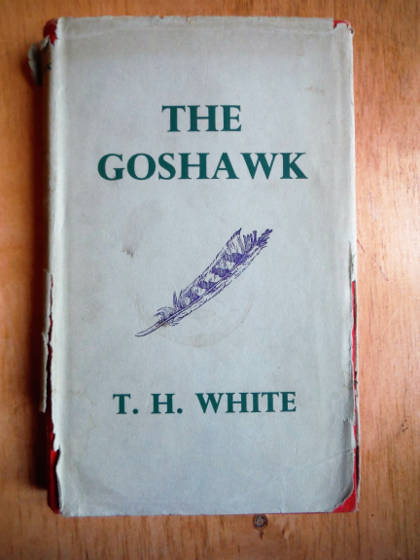
T H White belonged to the second group (he was born in 1906) of those who grew up in the shadow of the Great War which had taken fathers and uncles. After an unhappy childhood, he graduated from Cambridge with a first-class degree in English and then spent four years as a teacher at Stowe School in Buckinghamshire. Earth Stopped and Gone to Ground written during this period were rapidly followed by England Have my Bones (1936). For reasons I shall explain, I was lucky enough to read this book in combination with The Goshawk, which was probably written in about 1938, but not published until 1951 - this at the insistence of his publisher who discovered the manuscript by accident. White himself seemed reticent. The fact that The Goshawk was not published immediately was, I assume, because it was too personally revealing. The combination of the two books show White's progress in a few short years from a fairly well-heeled and confident member of the county set, enjoying every aspect of rural life and sport, to a man who lives alone with his thoughts and depressions in a remote cottage while training hawks. He still occasionally enjoys his country friends, farmers and foresters, the neighbouring markets and rural pubs, but he is in dread of the coming storm in Europe and the world, signs which he is far too intelligent to ignore. Besides this fear about the future of mankind, his concerns about the urbanisation of what was then still essentially a rural English shire, seem minor.
England Have my Bones is one of those "year in the life" books, taking the form of a country diary running from 3rd March 1934 to 3rd March 1935. White would have been teaching at Stowe at the time, but we don't hear too much about that. Instead we quickly realise that this is an account of country life in a place the writer, hobbit-like, describes only as "the Shire." For the first couple of chapters, the reader is left wondering exactly which county is meant; it is somewhere north or west from London, obviously. Northamptonshire is a candidate for a while, until we realise eventually from references and historical clues that it must be Buckinghamshire, but a much more rural Bucks than today. The diary begins (and ends) with accounts of the local hunting season on what he admits is a slow horse, but within his means. Fishing gets an early mention, but only because the writer knows where to get a rare trout (with a worm) from a ditch he could jump his old hunter over.
Then, on 16th April, we are off to Scotland for the first try at spring salmon fishing and this is where the Bentley sports car makes its first appearance. Be in no doubt that in the mid-thirties, a 4.5 litre Bentley with an open sports body would have been the car for a man of means to drive. (I can remember the glamour because in the early sixties a music master at my school used to own one. It was painted in British racing green and, despite the fact that he used to drive it wearing a highly unfashionable deerstalker hat which made him look like Sherlock Holmes, every boy in the school envied him). I don't think White was a very responsible driver of his Bentley; he describes a gang of Buckinghamshire road-menders calling on him to "let her go then," after which he roars off with his foot down and a tail slide, showering chippings behind him. Fast driving then was considered with more humour and tolerance than it is today - except on Top Gear perhaps.
White makes it up to Scotland, recording 516 miles on pre-motorway roads in just under 11 hours of driving. Upon which the car shears its magneto drive and is out of the story for a while, except for visits by representatives of the Bentley Company to repair it. Never mind, two weeks of glorious spring salmon fishing follow. We aren't told which river he is on, but the weather is seasonably cold as mid-April used to be in the north, Macdonald the gillie is a character, while the birds and the landscape are dramatically described. With cold easterlies blowing, the fishing isn't easy, but on the third day he hooks his first salmon, plays it in dread or even near certainty of losing it, and finally (after one missed stroke which is agonising to the angler) Macdonald successfully gaffs it:
"My first salmon. 10.5 pounds, 13 minutes. Incredible, but killed. I stuffed a pound into Macdonald's pocket, against his will, nearly cried, and went on fishing. Occasionally I peeped at the salmon. For some reason I didn't like to give it a close look. It would have been a kind of hubris to look at it closely. It might have vanished."
For two more weeks White and Macdonald fish on, through fair weather and foul, and eventually break the pre-May record of salmon for that beat. It is by all accounts a happy partnership, briefly interrupted by the arrival of a visitor. White, like many of us, is not immune to being annoyed by other anglers:
"A Major Wynne came over to fish today, and will be here on Saturday and Monday. Hence, Macdonald's absence, ghillying him. I disliked him at sight and he is a rotten fisherman. He brought about a hundred weight of stuff, fished the Mill Pool with a minnow because he said it was too windy to get a fly across, and had two people trailing down the bank after him carrying his collection of gadgets. He was here so that he could talk about his fishin' later on. He treated Macdonald and his chauffeur abominably (actually handed the rod to Macdonald to wind up the reel when he had finished fishing a pool), came over after the morning take and left before the evening one. He has three rods on the Spey, and bucked about it. Enough of Wynne."
Back in the Shire, there are long reflections on the delightful experience of Scotland and its salmon, but plenty of new activities are crowding to fill up White's year. He finds something to wonder at in everything from the shape of trees to the behaviour of birds, the birth of a foal and the art of pub games. He ponders on the curious history of the Shire, the great mediaeval forest which once existed there, its poachers, rural uprisings and repressions. On a whim, he has adopted the habit of keeping grass-snakes and watches them curiously as they zig-zag across the polished floor of the living room. As he lives above (and sometimes minds) the village pub, one wonders how he managed to square his landlady about this hobby? His big enthusiasm now is flying and the technicalities of learning to fly a Tiger Moth take up a great deal of space in the middle of the book. I found these details more than interesting as this is the aircraft on which my own father learned to fly about five years later.
Of course the repaired Bentley has to be fetched from the North - it had somehow been relayed as far back as Penrith. He does this by catching a midday train and then driving the open car south through the night, so as to be ready for work the next day. There is a distinct whiff of John Buchan about this part:
"It was pleasant to stop at road-house coffee stalls in the black of the night, and to find in the light inside all sorts and conditions of people: people as unshaven as oneself, lorry drivers, honest men looking like villains, villains trying to look like honest men, but without exception people on strange errands. For errands must be strange which will keep their emissaries travelling, enduring, whilst everything sleeps: even if they are only market errands to Covent Garden. The night was bitterly cold, and a snatch of coffee and firelight, rubbing one's frozen elbows before the same sort of wayside hearths that had warmed Dick Turpin, made one feel an enduring specimen of this human race. It was fine to drive the moors in the numb night, to drive fast in a motor-car made for it: the only kind of motor which I have driven far without feeling bored. It was fine to see the sun rising cold and yellow on the near side, whilst the night, long before sunrise, retreated on the off: to feel the dew and the slight mist: to think about the test pilot, high in the cirro-cumulus clouds of dawn, feeling as keen-set as oneself: to overtake another early bird in a fast motor, and to race him by common consent to Middlehampton, all before breakfast in the quickening sun."
The different types and formations of clouds, by the way, is yet another subject which Tim White examines in depth and even with diagrams. This is typical. He is interested, not just in ideas or people, but in everything he sees, whether natural or man-made. It's in his nature to want to understand the workings of a car or an aeroplane, just as he wants to learn how to milk, how to plough a field with a tractor, and all the details of the farmer's, the blacksmith's or the game-keeper's trade. He wants to know why the animals and birds he encounters behave as they do. As the year proceeds, of course shooting creeps in, first clay pigeons and then early morning ducks which coincide with notes on dawn tench fishing; later still there are organised shoots and walked up birds. On angling, there is not much more, beyond a few remarks about trout and dry fly fishing. In the Shire, as he points out, trout fishing is hard to find and closely preserved. Once shooting really starts, it's almost a daily event for him with local farmers and one wonders where he found the time to teach. There is a contentment about what he is doing and even the idea of pleasure in growing old doing it.
So the year goes on and by November he is hunting once more, with thoughts on fences and ditches and the nerves involved to take them. You have the impression that he is at times quite glad that his horse is not of the first rank, which means that he himself is not expected to be. When March comes round again, England Have my Bones ends in sadness, as after a good dinner, maybe too good a dinner, the Bentley is crashed at speed into trees at the end of a friend's drive: "...God hit me across the eyes with the poker, and hit me with all his might." The car is injured and so is he. We leave Tim White recovering in the care of friends.
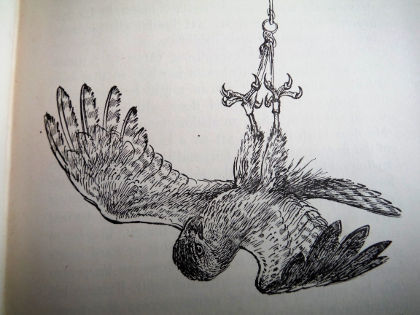
The Goshawk takes us to just two years later (1937) and everything is different. White is in the Shire still, but no longer teaching and no longer in the village pub, instead renting a remote cottage in a dark wood: "...I had to write a book of some sort, for I only had a hundred pounds in the world and my keeper's cottage cost me five shillings a week." He determines to train a young eyas (taken from the nest rather than a captured adult) goshawk. He has the hawk sent to him from Germany, by a man who is also supplying a gyrfalcon to Herman Goering. As a manual for the young bird's taming, he relies mainly on Edmund Bert's Treatise of Hawks and Hawking, 1619, which he later admits was hardly up to date advice on the business of manning a hawk. The description of what followed is fascinating: he attempts to outlast the bird by keeping it on his fist day and night, until eventually, even more exhausted than the holder, it ceases bating, screaming in anger and hanging upside down from the jesses, and at last consents to fall asleep perched on the weary man's fist. It took 72 hours of wakefulness. There follows all the complicated business of training the hawk, finding food for it, mending broken feathers and preparing it for flying at prey. For anybody interested in the art of the austringer and falconer, White goes into the many historical and literary references to hawking (Shakespeare is full of them). There are mentions of carrying Gos, the hawk, to town on market day and also the hunt passing by, but generally this book concerns just two individuals locked in their strange and intense relationship, the man and the hawk. The man is not without friends, but it seems that the news from the outside world is beginning to make him despair of the human race. Now White is reaching the point of being able to fly Gos reliably at game. And then, tragically, he makes a fatal mistake and loses the hawk downwind. Shakespeare again, from Othello:
"If I do prove her haggard, though that her jesses were my dear heart-strings, I'd whistle her off, and let her down the wind to prey at fortune."
The mood is bleak. There are futile attempts to find and recapture Gos, who will probably die of starvation, and later attempts to buy a passage hawk (captured adult), again from Germany. The winter is grim; White has an appendicitis operation and when he returns the weather (and political news heard on his battery radio) is grimmer still. With the spring, the mood lightens; he has sent to him a new passage goshawk, Cully, whom he makes a quicker job of training, followed a couple of months later by a Merlin, Balan. And, as the book ends, Cully successfully kills her first rabbit. In his afterword, dated 1951, White who had by then trained a number of hawks, admits that contact with other modern falconers would have made his task much easier.
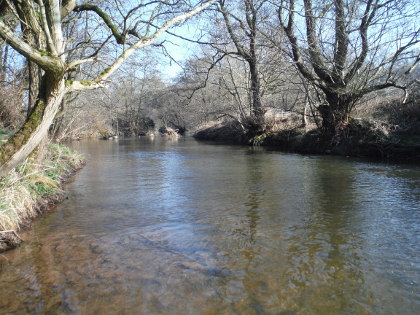
England Have my Bones is a celebration of the English countryside, its history, its traditions and what once would have been called English yeomen. It's very much of its time, but a recommended read. Taken as a sequel, The Goshawk (which is still available from Coch y Bonddu Books), admits to growing personal doubts and insecurities. White's biographer, Sylvia Townsend wrote about him: "Notably free from fearing God, he was basically afraid of the human race." Whether or not he was a repressed homosexual has been a matter for debate, but there are no definite conclusions. His books contain hints, but no real clues. Whatever else he was, he was a quite marvellous writer. In 1939 he moved to Ireland, where he spent the Second World War, a de facto conscientious objector. For most of the rest of his life he lived in the Channel Islands. He died in 1964, on a ship in Piraeus harbour following a lecture tour of the United States, and is buried in Athens. Ironically enough, England did not, in the end, have his bones.
It's early, but I'm wishing everybody a very Happy Christmas and maybe also some fishing during the holidays.
Oliver Burch www.wyevalleyflyfishing.com
October 2018
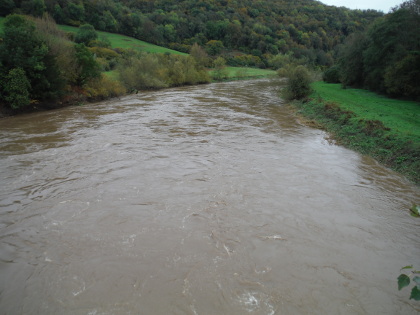
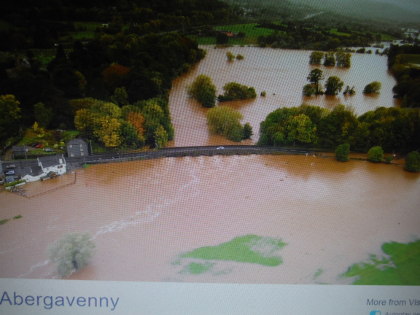
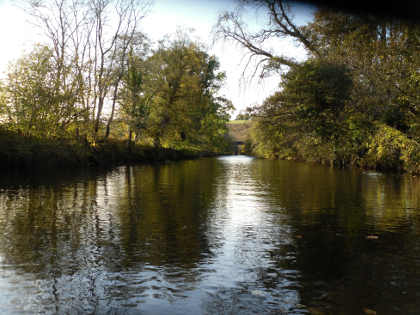
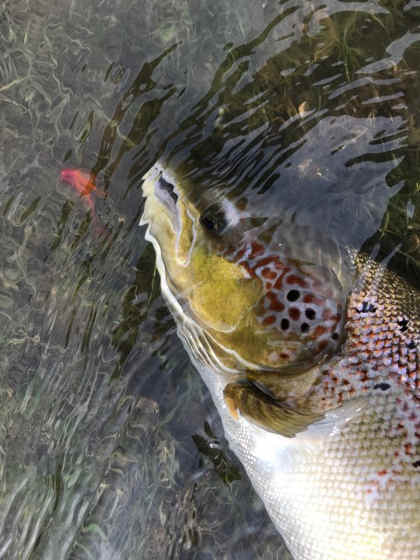
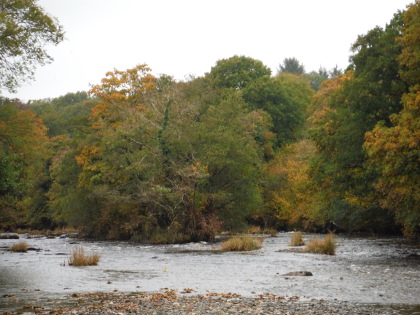
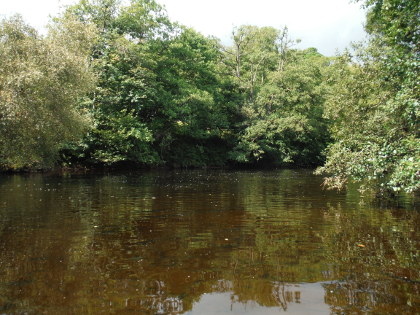
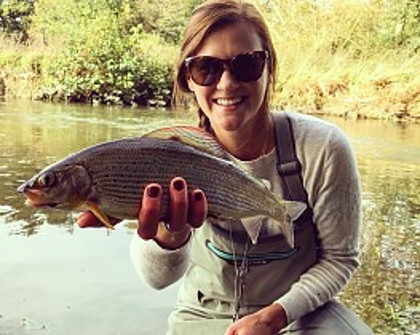
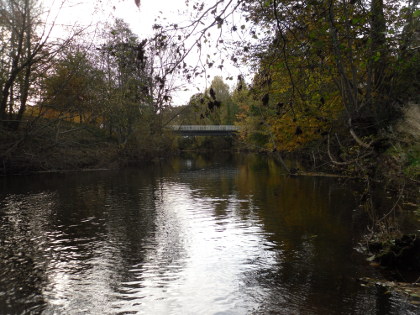
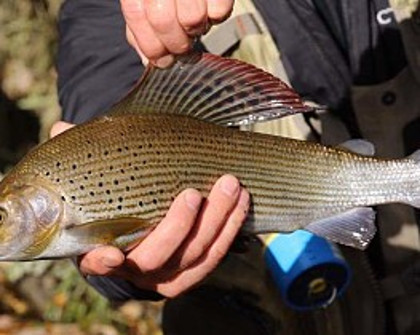
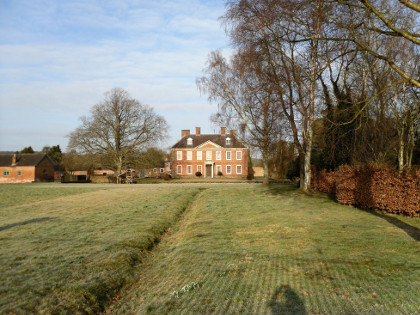
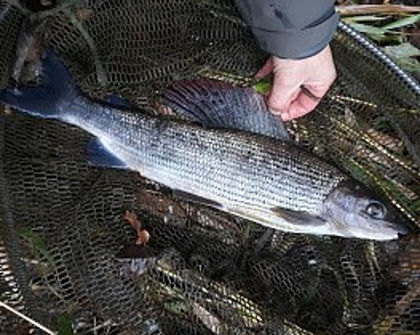
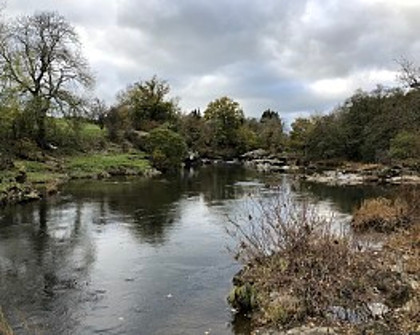
The first 10 days of October gave us typically pleasant autumn grayling fishing and there was good work to be done on both dry fly and nymph. It was a fine time to be out and about with a fly rod. However, although the drought had been broken definitively enough with rain and high water in late September, it was surprising how quickly some of the streams now reverted to being low and clear. This was particularly true about the Lugg, a stream on which I tend to be happier when that famous greyish stain is apparent in the water. Everything changed when Storm Callum arrived on the 12th, bringing high winds and several days of really hard rain. Floods arose everywhere, amber warnings were published and both main rivers burst their banks in places, the Usk showing a particularly dramatic spike in level. At one point the bridge at Abergavenny was closed with river water up to the top of the arches and even washing over the roadway at the town end. Worse still for some, the river had crept over the beer garden and was invading the bar of the Bridge Inn! Meanwhile the unruly Irfon was causing trouble over at Llangammarch Wells, where the well deep in the cellar of the Cammarch Hotel erupted with water and flooded the beer cooling machine. Thus no drought ale was to be had in the village at all for a while; these were certainly troubling times! For the Usk flood see: https://vimeo.com/294920880?ref=em-share
Fishing on rivers was necessarily halted for a few days. As the Usk dropped back I turned out on the 16th at the Breconshire Fishery for a last try with the salmon rod. Evidence of the recent flood was all over the riverside meadows where debris had been stranded in fences. Today the Usk was still high but not too coloured and it was falling fast, so fishing with a fast sink tip and a fair sized tube seemed viable. It was good to be out and casting, but in the end I desisted, mainly due to the number of out of season trout hitting the tube fly. A good salmon was taken that day downstream at Glanusk Park and on the 17th, last chance of the season, PR of Shrewsbury had a super 38 inch hen fish on a Pot Bellied Pig at Abernant on the Wye. See his photograph taken with an admirable regard to fish welfare and a safe release. A 30 pounds fish was also reported from the lower Usk.
What followed as the levels fell was another period of exactly the kind of autumn weather which grayling anglers hope for: high pressure, cold, misty starts and warm days as the sun got up. And we did have some good catches although I was a little disappointed in the lack of natural fly on the water. Possibly the previous drought and its effect on invertebrate life was to blame for this. Even now, and this does seem extraordinary, river levels fell off rapidly because the ground was still basically dry. There were afternoons of warm sunshine without a breath of wind, but very few late olives, willow flies or other insect life in evidence and not the ring of a single rise to be seen disturbing the surface over hundreds of yards of river. Nevertheless, grayling could often be persuaded up by a well-presented dry fly and they would certainly take nymphs. While storms assailed mainland Europe, we finished the month with a sharp and frosty cold snap and our rivers low and clear. Incidentally, I have evolved my own system for measuring the dryness of the ground, although it may not be very scientific. This is the old pit engine pond in front of the Mosely Green Rising Sun, a watering hole where I am quite well known, as my father was before me. Normally this pond, fed by nearby springs, is overflowing for most of the year, but drops by about a foot during dry summer months. On the last day of October this year the pond was still on mid-summer level and the gold-fish with a couple of carp were clustered in the muddy centre.
Let's go to the detailed reports beginning with a couple of late ones from September and the back end of the trout season. JH from Chepstow fished the Edw at Hergest on the 30th and recorded 17 small trout. On the same day WP from Presteigne fished the Hindwell Brook at Knill, and using a small Pheasant Tail Nymph with a tungsten bead had a fine 16 inch trout in his bag of 7 fish. You never quite know what's to be found in small brooks, do you, especially if they are not fished too often? On the 4th October GM from Usk fished at Talybont Reservoir (still open for trout) and caught 11 fish to 35cm. Over on the Wye, regulars Dave Collins and Glyn Williams fished the GPAIAC water at Builth Wells for 35 grayling to 13 inches. They used small dry flies although they were troubled at times by downstream winds. DM and SB from Hereford fished at Ty Newydd, catching 40 grayling to one pound by various methods. Also on the 4th, AM from Dorridge recorded 20 grayling from the Lugg at Lyepole. Next day Dave Collins was out on Cefnllysgwynne, where he found the number of rising fish rather limited (5 grayling recorded). What was really annoying for him was the spectacle of five canoes ploughing their way through the pools, quite illegally and without concern for the sport they were spoiling. There just isn't room for boating along with serious fishing on a river the size of the Irfon, but - have a care - this may be an example of what is coming for us all if the access law in Wales changes.
JD of Hereford fished at Abernant, caught 9 grayling to 10 inches fishing a team of wet flies and asked whether anglers object to recording their catches with metric measurements. Or is it perhaps an age thing? Might it even indicate a view of Brexit, I wondered for a moment? Let's not go there. JD, I think it probably is an age thing and I admit I am one of those who take measurements in "old money," in my case using marks notched on the landing net handle. Young anglers, especially match anglers, are usually in the habit of giving metric measurements. Never mind, we have a conversion chart and we are happy to read either. Did you hear about the last salmon I caught? Fully an ell long, it was. That's a Scottish ell, not an English ell, you understand?
IR from Leamington Spa was after salmon when he fished at Llangoed and Lower Llanstephan, but I note from his report how he was pestered by curious cattle where he parked his car. Having seen what cows can do to a parked car, can I advise anglers who prize their wheels to use an alternative parking spot when stock are in a field? Sheep won't damage your pride and joy, but cattle or horses might well. I am sure it is only a matter of curiosity at something unusual in their familiar field, but typically they will slobber over it, defecate over it, give themselves a thorough scratching until they rub the mirrors off it, and finally award the panels a couple of good kicks before leaving. It's up to you, of course.
JA from Leominster reported a good day on the 8th with 22 grayling from Lyepole on the Lugg. However, he also reported "something odd in the water, and it turned out to be the leg of an otter." This set some alarm bells ringing. I should refer everybody to last month's newsletter on illegal hunting using more than two dogs and AP from Wirral's report on 29th September of so-called "mink hounds" working this part of the Lugg. Quite apart from the law on hunting with dogs, I'm perfectly aware that these days there is a section of the angling community who are not so much in love with the presence of otters in their waters. The impression I get is that while otters have to work pretty hard to make a living in rivers with wild fish, they can be very damaging to heavily stocked and enclosed waters. In some carp fisheries individual fish are worth thousands of pounds. We can have a debate as to whether, when and where this presently protected animal might be culled, but they delight me and I would always vote for restraint and a humane method. The last time I saw the Lyepole otter alive and well was on the 27th when he was fishing just below the cottage - as I reported the same evening. Judging by the recent catch returns, he didn't take so many of our grayling, did he? On the more optimistic side, two live otters were spotted at Lyepole by anglers on the 10th, which raised the possibility that JA was mistaken and a mink was the victim in this case. It might even, we suppose, have been killed by otters who certainly don't get along with mink on their territory. Natural England and West Mercia Police's wild-life crime officer for Herefordshire have been informed of the circumstances. Back to our fishing reports and also on the 8th Craig Llyn owner Shaun Watkins accompanied a party of three visitors from Normandy. Between them they accounted for 28 grayling. The same party had 26 more grayling from Craig Llyn two days later. Apart from seeing Lyepole otters on the 10th, MB from North Shields and a friend recorded 26 small grayling.
The next day Storm Callum came in and it really began to rain hard along with powerful winds. All our rivers rose rapidly, bursting the banks in places, and so fishing came to a halt for the best part of a week. Despite the floods, there were those anglers who tried in difficult conditions. AG from Harleston fished at Doldowlod on the 15th and managed three grayling including a fish of 17 inches. He was fishing the edge of the flooded river with nymphs under an indicator. AG, who I think comes over from Norfolk every year to fish our waters, stayed on here for five days. MM from Aspen found the Lugg in flood when she came to fish at Eyton on the 17th, but she still managed a grayling - see photo. Was that the first grayling for MM, I wonder? I don't think they have the species in Colorado although the trout fishing is world famous. Despite the water being still quite high, PB from Gloucester and 3 friends managed 18 grayling to 18 inches when they returned to the Wye at Doldowlod - also on the 18th! These were mostly taken on dries. AG of Harleston was on the Rocks and managed 9 grayling to 14 inches. On the following day he had 9 more to 16 inches from Cefnllysgwynne. Meanwhile LB from Bude with a friend fished the Colonel's Water upstream and they had 12 grayling on spiders. DS from Dymock with 3 friends had 16 grayling between them from Craig Llyn on the 20th, the river still being quite high although now running clear. Meanwhile DR from Bristol fished at Monnow Valley and had 4 grayling. He mentioned in the by-catch part of his report an out of season 16 inch trout with a blue dye-mark, the usual identification for a stock fish on the Monnow. According to their website, Tregate Anglers immediately upstream have continued to stock with dye-marked fish in recent years, but in reduced numbers and only in the upper part of their water. Occasionally you find one at Skenfrith. I suppose this one must have travelled a way in the other direction. Monnow Valley hasn't introduced stock fish since I have known the fishery.
DM, SW and PB from Hereford shared 16 grayling from Craig Llyn on the 21st. GW from Cheltenham had a good bag of 28 grayling from Abernant on the 23rd while NA from Worthing had 6 from Lyepole. On the 24th LR from Swansea had 7 grayling on nymphs from the Arrow at Court of Noke. GW from Milton Ernest had a good day trotting on the Wye at Abernant, with 18 grayling recorded. On the 25th JB from Tewkesbury had a very good day at Doldowlod, with 15 grayling including several big fish - 19 inches reported. JD from Porthcawl also found the Rocks fishing well, and took 15 grayling to 15 inches. He was fishing the duo method and saw quite a number of rises. NW from Bromsgrove fished at Lyepole the next day for 24 grayling to 42cm. AP from Wirral also fished at Lyepole on the 27th, catching 10 grayling and seeing a salmon on the beat - good news of course. If I read the report correctly, he also shared the fishing during the afternoon with two rod and line poachers, which is not at all good news. Unfortunately a report after the event does little or nothing to resolve the problem - see the end of this newsletter on poaching.
Congratulations to the fishery management for replacing the "wonky" stile at Ty Newydd, plus also building a new stile arrangement to get us over the next fence upstream - we more elderly anglers will appreciate these repairs a great deal! Incidentally, if you haven't visited Ty Newydd for a while, you will see that the old fishing lodge, the one which we used to know affectionately as "the Scout Hut," has been replaced by a modern Scandinavian-style wood building as a holiday let. It's quite impressive if you fancy a riverside holiday with views as well as fishing - see here. Meanwhile, anglers now have their own parking at the bottom end, as you will see from the directions. You will find when you get to the top end that there is now a path with a couple of stiles running down to the right just above the bank; this gets you through to the mouth of the Clettwr at the top of the beat without disturbing occupants of the holiday cottage and its garden.
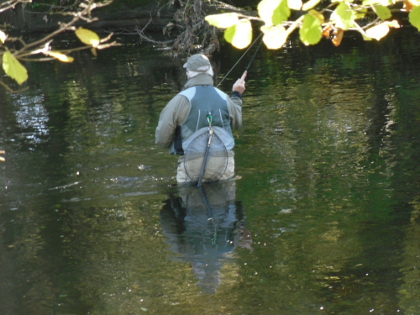
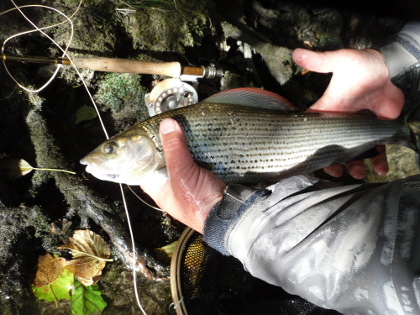
This has proved to be another grayling dry fly season in which "white hackle flies" worked for me at times. That should not to be taken to mean that I am going to turn my back on those old fly box standards such as Red Tag or Grayling Steel Blue - far from it. But there were certainly days and times when the fish were getting nervous and a switch to something like a Sturdy's Fancy or a Grayling White Witch produced an immediate and positive response. The lesson I keep in my head at such times is that if the shoal you have in front of you is no longer ready to rise freely, work through the fly box and ring the changes. On one occasion I visited a pool once in the morning and caught a few before they switched off, but then went off to have lunch, fished elsewhere for a bit, and then came back for a second try at the original spot with a few different flies and in fact did significantly better.
There also seemed to be quite a few days this autumn when grayling proved difficult, the rises being "short" or aborted at the last moment, so that few fish were hooked. Quite apart from changing flies, I proved to my own satisfaction again - should proof be needed - that this problem can often be solved by casting downstream or across to the fish, rather than taking up a conventional position below and casting diagonally upstream. No lesser authorities on grayling than Reg Rhygini and more recently John Roberts recommended these tactics, the important point being that the fly should lead the tippet down over the fish rather than the other way round. Using a parachute cast downstream, you should be able to create enough slack in the leader so that the fly will trot downstream about 10 feet before drag sets in, at which point you lift off and re-deliver the fly further up. Other points to bear in mind with grayling is that the best fish usually lie at the leading edge of the shoal, and also that if a shoal is unduly disturbed, it will tend to move slowly upstream.
Back on the subject of traditional grayling flies, I see that in his report on Abernant for 1st October, PB of Upton on Severn had much praise for the Grayling Steel Blue dry fly. I happened to be there with a client that same day and PB was quite lyrical in expressing to us his support for the pattern. Nobody could have been more pleased than I to hear this, because it is also a great favourite of mine. It was invented in Derbyshire during the 1940s by the legendary fly dresser Roger Woolley, but I probably would not have come across it had Reg Righyni in his famous book Grayling not suggested it along with a handful of others for both dry and wet fly use. I can't think of a better recommendation than that. The GSB has much to commend it: robust, easy to make, giving a vague impression of the sort of small grey insects which are about on the surface during the autumn, and, due to its lightweight body construction and palmered hackle, easy to dry out with a couple of false casts. Now here's another one, almost as good, again from the Derbyshire school of bumble-style palmers, probably originally designed by David Foster and again recommended by Righyni. As always, use a cock hackle for dressing the dry fly version and hen hackle for the wet:
Yellow Bumble
Hook: 14 or 16, wet or dry
Rib: Yellow Pearsalls silk no 4
Body: Peacock herl
Hackle: Palmered light blue dun
Halford in his day seems to have modified these old bumble patterns by reversing two materials, making the body from the silk and using a single peacock herl or peacock sword as a rib. I can't see the reason for the change which hardly makes for a long-lived fly; I like the version described above and like to think it is probably the original. It works for me - why not give it a try. Meanwhile, if you want to try out some modern grayling flies, Paul Proctor gives a good list of patterns in the November edition of Trout and Salmon.
Good news for trotting enthusiasts! After a hiatus in supplies, Drennan have the revised version of their float fishing nylon back on the market. This should stay quite happily on the surface all day without the need for greasing or spraying it with silicone, and thus making for easy pickup on the strike. For grayling, I'm using the 3.2 pounds BS version. If you can't find it elsewhere, try my local tackle shop in Lydney: Forest Tackle 01 594 844729.
We now have an update on NRW's proposed new regulations, or perhaps I should write "draconian regulations" as described by the Angling Trust, for salmon and sea trout fishing in Wales. The situation as detailed in the April letter was that NRW was declining to discuss the situation further with the angling community as the organisation had decided its position and would not budge from it. Therefore the proposed new regulations regarding catch and release and hook types would be put before the Welsh Assembly during the winter and, assuming a positive vote, would become law in time for the 2019 season. Anglers by this time had a strong sense that NRW had made up its mind on the subject even before consultations and that their views were being totally ignored. It now appears the Welsh Government, with good reason I would suggest, has become concerned about the apparent and growing rift between NRW and a large section of the general public it serves. Pressure has come from Assembly members and Westminster MPs to revisit the matter. Accordingly, there will now be a public inquiry into the proposed bye-laws, at which anglers will have an opportunity to re-state their views. The Angling Trust will take the leading rode in presenting the case for the salmon and sea trout anglers.
Here is a story from quite a long time ago. A man I will call Keith could usually be found in his favourite corner of the pub in a mid-Surrey village just below the North Downs, telling stories and accepting a pint from anybody who would listen. A dark, saturnine looking man in early middle age, he nominally earned money doing odd farm jobs, but this didn't seem to take up much of his time. His rented cottage was around the corner; this was just before the place became completely gentrified and all the 17th and 18th century cottages were bought and restored by commuting stockbrokers, BBC producers and the like. Keith was a representative of the village as it used to be, not of what it was about to become. At home there was an old-fashioned kitchen with a wood-burner stove on which stood a large and blackened game pot which, according to legend, had been kept permanently simmering and unwashed for years on end. Now and then Keith would add some onions or chopped carrots, potatoes, pepper and salt, but mainly pieces of rabbit and pheasant to keep the show on the road. A hare would be a nice treat. A plateful would occasionally be ladled out from the famous pot and more materials regularly added. When Keith talked about taking "one for the pot," he meant it more literally than most. In the kitchen, his dogs would be curled up on the stone floor and his old 12 bore stood against the brick wall, ready to be tucked under his arm as he went out.
However, Keith was taking and selling a lot more game from the surrounding fields and woods than was needed for his pot. According to his own account, he knew exactly what to do with nets and snares. His involuntary benefactor in the acquisition of marketable and edible game was the owner of the local estate, a nationally known millionaire - you would recognise the name - who had made his money in the hotel and catering industries. It was a proper shooting estate, with serious efforts under way to raise large numbers of driven pheasants, and two keepers to look after it all. Keith, I imagine, must have been quite a thorn in their sides. A typical story he would relate in the pub might be about the last time he was had up in front of the magistrates at Guildford: "It was the usual thing - taking game illegally. Both the keepers were there to give evidence against me. I pleaded guilty... thought I might as well... and got fined 20 quid with a warning to mend my ways and that was that. But the keepers, they stayed behind at court to claim their expenses. I got a taxi straight back here and shot more than 20 birds before they showed up. I figure it's worth 20 quid any day to know where those two b******* are!" Amid gales of laughter, Keith would graciously accept another pint.
It's a very curious and rather illogical thing, this attraction the figure of the traditional poacher has for the British public. Perhaps it's the idea of the little man showing the finger to authority, something of the charm of Charlie Chaplin's antics in the silent films. Nearly a century ago, Lilias Rider Haggard, who was a girlhood friend of my grandmother's, edited or more likely ghost-wrote I Walked by Night: Being the Life and History of the King of the Norfolk Poachers, Written by Himself. Along with The Rabbit-Skin Cap, it's still in print (Coch y Bonddu Books) and in popular demand. City people love this sort of stuff. In the countryside, quite a number of people will happily tell you about their poaching past, assigning a more or less heroic role to themselves. Nowadays they will even boast about it on social media.
I was going to write that, oddly enough, I never came across an East European poacher, a figure much discussed these days, although I have known quite a few English and Welsh ones in my time. However, just recently I came across three Russians (so they claimed to be) spinning our Forest pool, lobbing small Mepps spoons at our rainbow trout. They hadn't realised it was private, they explained, although they had walked past two signs making it clear that it was. They left amiably enough. I suspect that, unchallenged, they would have made a good job of emptying the lake. A less savoury incident which made it to the national news recently was the case of a commercial fishery owner, according to his own account with his patience tried to the limit, who put up a sign effectively reading: No dogs or Eastern Europeans. He was rightly made to take this offensive sign down. I need to pick my words carefully here; it's easy enough to be accused either of racism, or, alternatively, unwarranted political correctness. The fact is that angling is perceived differently in some other European countries, where even coarse fish are still routinely taken for the pot. Restaurants in Central and Eastern Europe commonly serve smoked carp or eels as a delicacy, and even pikelets, perch, roach and tench are available on occasions. So too they were once in the UK, where Victorian anglers would even slaughter bream for the pot. The catch and kill issue is a matter of evolving differences in culinary and sporting customs, and I would suggest that few are quite as conservative in their views as British game anglers. I do remember inviting some refugee friends from Bosnia for carp fishing on a Surrey pool some years ago and they were deeply shocked when I caught and returned the first one. They had brought the barbecue all ready. Meanwhile, much work has been done to translate and explain our somewhat arcane laws on fishing rights for visitors to our shores. In Poland, for example, fishing laws although strictly applied are much simpler to understand. Fishing is extremely popular in Eastern Europe and many sporting immigrants living and working here have taken to conventional angling under British rules with alacrity. "Migrant anglers" is the new expression for this group and some of the ones I know who come trout and salmon fishing on our rivers are as keen as mustard. Eastern Europe over the last few decades has certainly taught us a series of new ways to fish weighted nymphs in heavy water. At the last count, 29 "migrant anglers" were working in the voluntary bailiff scheme (see below) and 2 more as full-time EA enforcement officers.
Back on the subject of the home-grown poachers, I'm reminded of a gentleman I will call "Old Tom," who happily admits to a long history of salmon poaching offences recorded at Monmouth Magistrates Court before it closed. Tom claims to be retired now and therefore to be considered an honest man, although other anglers call him "the old reprobate" to his face. He just grins. Now he haunts the Usk clad in a battered oilskin and armed with a well-used spinning rod. He takes his fish legally today, although in fishing terms he certainly comes right to the point. And the whole and only point of fishing, as far as Tom is concerned, is to catch more and bigger salmon than anybody else. There are none of these silly ideas about "there is more to fishing than fish" with Tom. Nor would he waste time on any of this falsely polite "you take the pool first" nonsense, because Tom always makes darned sure that he gets the pool first if he can manage it. In that sense, Tom is still a poacher. A typical meeting with Tom is that I have just started with the fly rod down from the head of the pool, fishing systematically and with anticipation towards the well-known hotspot half way down. The club rule is that fly-fishers have precedence and any late arrivals should step in behind those already fishing. But what is this I see in front of me? Tom with his battered hat and ancient coat suddenly appears from the bushes half way down my own bank, right opposite the hotspot, and lobs a Toby lure straight to the crucial lie. And he does it again and again, until I catch up with him. Whereupon Tom does a theatrical double-take and with a look of angelic innocence on his face says: "Sorry about that. Didn't see you there mate." Right. Somehow I never have the heart to be angry with him.
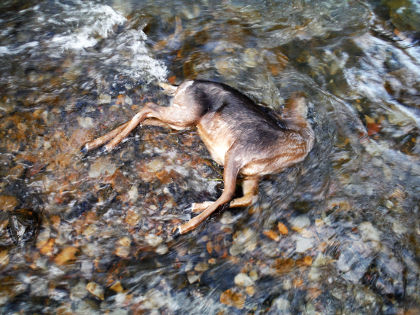
So much for poachers and their supposed charm. There is really a much more serious and unpleasant side to it. My father didn't fish but he was a sometime shooting man and, in his day, shooting in the Forest was fairly relaxed. Anybody was welcome to shoot vermin such as grey squirrels and good luck if you could find a rabbit or a hare in neighbouring open spaces. There were always a few half-wild pheasants around in the woods. But today, in a more controlled and safety-conscious environment and with many more visitors about, poaching has become a serious matter in the Forest of Dean. It takes place at night and fallow deer and now feral boar are the main targets. Even in 27,000 acres of woodland the sound of a rifle in the night has become too much of a give-away to the police and so a cross-bow is often used. Do you imagine that injured animals are followed up humanely? The likely clues to be found in the morning are a pile of eviscerated guts, maybe some blood and a head, and the van's tyre tracks in the mud. It's hard to see the charm in business of this kind.
Once, while walking along the Camel estuary in Cornwall, I saw a man fishing in what seemed to be a strange way. With a powerful rod he was casting a very heavy weight across the channel, before wrenching it back along the bottom in a series of violent sideways strikes. When he saw me watching from the other side, he took off. It was explained to me later that he was probably "snatching," or attempting to foul-hook salmon and peal with a line of big hooks fastened above the lead. NRW will remember the case of the net which we found stretched across the tidal section at the bottom of our Loughor waters a few years ago. It contained some 20 dead salmon and sea trout and it emerged that the perpetrators had come up from the estuary on jet skis in order to set it.
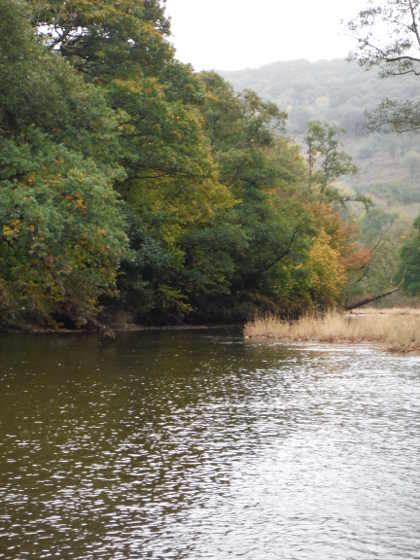
Again, on an early November day I was making up tackle ready to go grayling fishing on the Irfon. As I did
so, a chap was on the other side of the car park loading a van. When he was finished he came over for a chat.
"Seen any fish about?" he wanted to know. My antennae pricked up, because somehow I didn't think he meant
grayling at all. I had an idea from the beginning this would be an uncomfortable conversation.
"You mean salmon? No, we have finished with them at this time of the year. I'm after grayling."
"You would be better off fishing near Garth for grayling wouldn't you?" Well actually I wouldn't; I
couldn't think of a better place for autumn or winter grayling fishing than this very part of the Irfon.
But I let it go. However, my interlocutor kept on talking and pressing for information, which is a valuable
commodity if you have designs on the spawning salmon running up into the tributaries. Eventually, he
couldn't resist taking out his mobile phone and showing me a photograph of a large cock salmon, maybe 20
pounds and very definitely dead, hung from a beam with a rope round its tail. The colour of the fish was
almost completely black.
"What do you think of that?" he said.
"I think that is a pretty sad sight."
"Oh, you're one of those are you?"
"That's it. I'm one of those."
He was off with an old-fashioned look and nothing more to say. And believe me, NRW are well informed about
the problems of the area. It seems a depressing thing to conclude, but I think as long as our rivers have a
salmon run there will be those who try to take them by any means foul or fair. The fish are at their most
vulnerable when the rod and line season closes and they make their way into the thin water and pools of the
tributaries. If you fish for grayling during the winter, you will certainly become aware of just how
vulnerable they are because on November and December days, you may find yourself at close quarters with the
big fish busy with their family arrangements. They come close because in these circumstances they have lost
much of their fear. Learn to move away to avoid undue disturbance and tread carefully where there may be
redds.
In a very real sense the sight of spawning salmon at close hand should be a privilege. I remember that years ago I was home on winter leave and with the (then quite new) Foundation's help, fixed up some fishing at Llangurig on New Year's Day. This was in the era of cold winters and the upper valley of the Wye, when I got there after a 90 mile drive, looked bleak and ice bound, a haunt for buzzards and ravens. The water was low and clear. However, I did manage to catch a few grayling, which pleased me tremendously. Then wandering the beat with the afternoon light already beginning to fade, I found myself looking over a boulder into a deep and still pool. As I watched, a pair of enormous fish glided into view just below me, keeping close together. The hen fish was in the mid-teens of pounds, but the cock salmon was significantly larger, easily in the twenties I would guess. I could clearly see his deep red colour, the individual spots on his flank and the hook of his jaw. I held my breath, feeling I had been granted something very special with this meeting - an audience with the king and queen of the river.
While the rest of us worry about the decline of salmon and sea trout runs affected by a long list of threats and while we agree to restrict our fishing in various ways and work out what else can be done to improve the situation, maybe donate money for the benefit of the fish, the poacher continues as if the days of plenty were still here. The evidence of what goes on is clear enough: hooks and spinners left in trees, thick nylon attached to weights and worming hooks found in the bed of the river. Last year a man wearing a face mask and in the act of introducing a white powder from a can to an Irfon pool ran off when surprised by an angler. An idea still lingers among some on the upper reaches that there is a kind of moral right to take salmon after the season closes, simply because there are no local chances for a fish earlier in the year and that there is a long community tradition of doing so. The justification is: "We have always done it." Certainly I have heard that idea expressed quite shamelessly in the pub and those strangers who would romanticize poaching might be disposed to listen. They would be less likely to do so if confronted with the reality of what is involved. By that logic, some Cornish communities would have a right to take up ship-wrecking again.
Poaching has led to violence in the past, not just during the "daughters of Rebecca" social unrest of the 1830s, but much more recently. During the 19th century, Usk proprietors employed several Scottish keepers to watch the river. These were reportedly tough characters who could be relied upon to resist local pressures. J Arthur Hutton, one of a number of owners who worked to improve the Wye during the early 20th century, in Wye Salmon and Other Fish wrote: "Frequently we have had very serious troubles with gangs of poachers. On one particular night in 1931 on the Ithon over a hundred men were out, armed with spears and gaffs, with which some of them assaulted the Bailiffs. It is a mercy that no one was seriously hurt or killed. I am glad to say that the Bailiffs succeeded in catching fourteen of these scoundrels. But the worst of it was to come. In spite of the strongest evidence of serious assaults made on the Bailiffs, the Bench of Magistrates at Llandrindod inflicted only nominal fines, and one of the magistrates went out of his way to make a short speech afterward, which could only be regarded by the poachers as an encouragement to continue their illegal practices."
The photographer J Allen Cash, who travelled down the Wye with his camera in 1950, could be put down as one
of the apologists for the poaching tradition. In The River Wye he wrote:
"The modern technique of salmon poaching was explained to me near Rhayader. A handful of men go out after
dark, armed with long slender poles with large hooks or gaffs fixed to the end. One man carries a light in
a large reflector, either acetylene or electric. At night, when the salmon are spawning, they go up into
such shallow water that their backs often show above the water. The light, shining across the water,
discloses the salmon, whereupon the hook end of one of the poles is dropped into the water, upstream from
the salmon. The current carries it down, and when the hook is opposite a salmon, the pole is swiftly dragged
into shore. If properly done, the fish is hooked and dragged ashore, despite often fierce struggling. This
is said to be a deadly way of poaching, and a good many spawning salmon never find their way down to the sea
again as a result of it. The light cannot but attract the attention of water bailiffs or police, but it
serves also as a weapon of defence. The technique is to turn the light fully upon the intruder as soon as he
is heard approaching. The man holding the light must stoutly stand his ground, blinding the keeper while his
poaching friends make a get-away. Then the light will suddenly be turned off, and it is up to the man behind
it to get clear away before the intruder is able to see again in the darkness. I was assured that this was a
most effective scheme, without any known defence."
Further downstream and in more recent times, keepers had a hard time of it in defending the Wye's salmon. I know an estate where most of the council houses are said to have been privatised on the profits of salmon poaching, where salmon nets (not illegal to own in themselves) used to be hung between the houses drying, and where on occasions sewage workers were called to unblock drains choked with salmon guts. In this case the conflict in the darkness also became distinctly rough: boats were stove in, people were pushed into deep water and razor blades left imbedded in hand rails.
Hutton in his day had great sympathy for the bailiffs charged by the Conservators with watching miles of streams during lonely winter nights at a time when locally "every man's hand is against them." Today, the NRW and EA have vastly reduced anti-poaching resources, and they rely heavily on the support of anglers and the general public. It would be nice to think that they can rely on that support. Even if the scale of poaching reduces, it should be remembered that every fish which survives to spawn is now more valuable and more needed.
I have described some large-scale poaching operations from the past, but we still have our share of individual chancers. It's generally known where the problems exist and probably none of our riverside towns are without a few characters with a history of offending. I would suggest that today the motives are generally not financial, even though I still hear that well-worn story about poor working men looking for some way to feed their families. I'm afraid I don't believe that for a moment. Dark salmon with encroaching fungus taken in the act of spawning can be of little food or commercial value. I am utterly convinced that these days it's done for sheer devilment and I never met a poacher who didn't like boasting about his own exploits in the pub. If you want to join the circle of amused and admiring listeners, go right ahead!
Apart from the professionals you also have the rather slimy individuals who are just too mean to pay for their fishing. These are the so-called "rod and line poachers" and probably the ones we are most likely to meet on the river. Some of these individuals do very well out of legitimate day-ticket anglers who are too polite or nervous to object when told the age-old story: "I have the owner's permission." Brecon and some of the other Usk towns still have a reputation for this, despite the fact that it is easy enough to spot from the road bridges if somebody is fishing who hasn't bought a ticket... Dinas, Abercynrig and Ashford House are all vulnerable. Some are also ready to break the rules about methods; it isn't uncommon to come across somebody with a spinning rod on the Usk in spring. A while ago I was fishing high water on an Irfon beat when I came across a character float fishing with a worm. As this was a fly fishing only beat and I had the only ticket, I suggested he leave. He objected that he had permission from the owner. As I knew (as he surely also did) that the owner had died a couple of months before, I mentioned that his widow was in right now and why wouldn't we go round the corner and check with her? At that point he took off. I found out later that, rather than an impoverished individual, he was a lecturer at quite a famous Welsh college.
The EA and Angling Trust have organised a voluntary bailiff scheme, NRW also relies heavily on information, and of course fishing clubs absolutely rely on patrols by their own bailiffs. Police are paying more attention to "wild-life crime" these days, but not all police officers are adequately briefed on laws which are actually quite complicated. To put the situation as simply as possible, poaching is theft. Fish in enclosed still-waters are effectively treated as "live-stock," so the crime of removing them without permission comes under the Theft Act 1968. Fishing without permission is more or less the same thing, in this case "theft of fishing rights," but also covered by the Theft Act 1968. Fish in rivers and streams whether stocked or not are considered "wild," but fishing for them without permission also constitutes "theft of fishing rights" as covered by the Theft Act 1968. Police are directly responsible to prosecute for offences against this Act. The Environment Agency/NRW are responsible to prosecute failures to possess rod licences. Help is needed to combat poachers, but all those involved will ask you to ensure you do not put yourself at risk. Two documents on the subject available from the Angling Trust site are very helpful - see link HERE.
Updated Guidelines for Club Bailiffs
Essential Guide to Elementary Fishery Law and Enforcement in England
There is much important information here but the vital advice is that, if you see poaching happening, make the call to the authorities at once, while the crime is actually being committed, thus vastly increasing the chance of a successful prosecution later. If you don't have a phone signal, drive to where you do. The numbers to call are on your fishing ticket and should be on your phone. 0800 80 70 60 (EA England) or 03000 65 30 00 (NRW Wales) are the normal numbers to report incidents of poaching or intelligence on the subject. Police can be informed directly on 101, asking for the Wild-Life Crime Officer. Police at a recent fishery law enforcement seminar also advised that if the crime is actually in progress, it's perfectly acceptable to use the 999 number to report that theft is being committed. Have all the details to hand.
November can be a good grayling month, although days are becoming short. Also there may not be many days left when the dry fly can be employed - although when grayling are seen rising naturally it usually works better than any other method. Look out for large dark olives around the middle of the day. Otherwise it will be mainly nymphs from now on, with trotting a good option on those beats which allow it. Tight lines!
Oliver Burch www.wyevalleyflyfishing.com
September 2018
We started the month off with all the rivers still low and not much sign of serious rain on the horizon. The general mood was therefore distinctly glum. Wye salmon anglers were picking off a few long-term residents from fast water in the upper river, while those with access to the bottom end tried for a few more which came in with the tide. There was still very little good news about salmon from the Usk. Most sea trout anglers had by now given up for the season and Towy banks were overgrown and largely untrodden. On the other hand, the trout and grayling men were often still catching, mainly from the upper Wye and its tributaries, although of course low and clear pools rarely make for easy fishing.
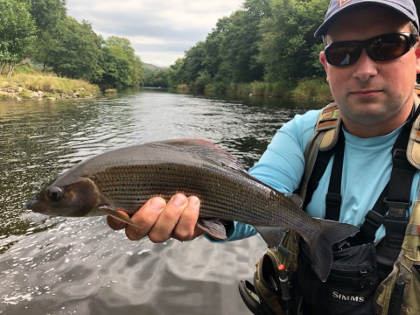
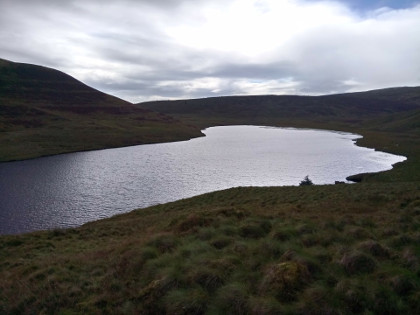
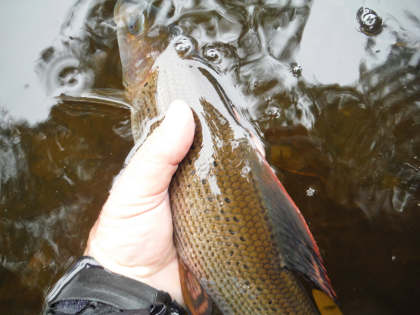
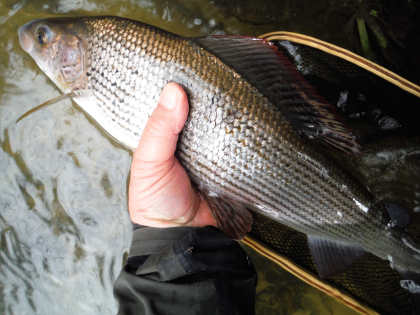
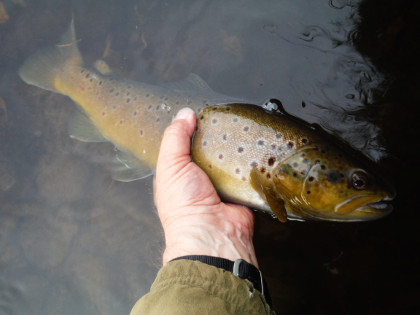
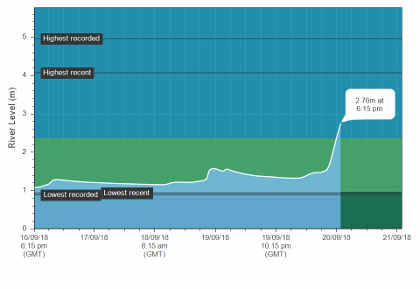
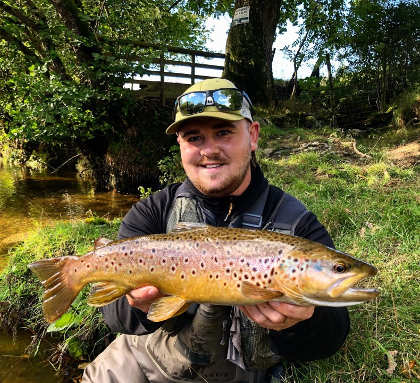
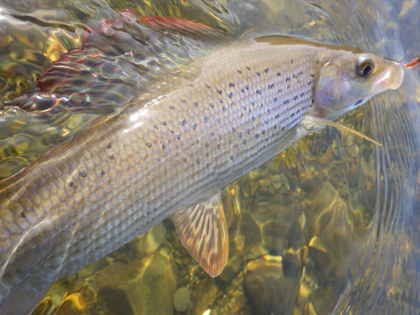
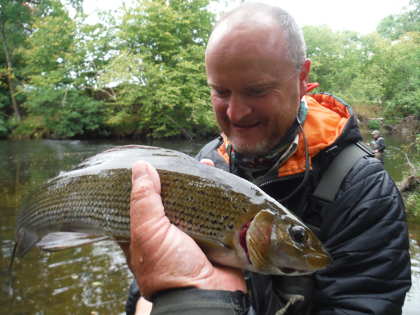
DD from Blakeney was one of those fishing the upper Wye on the 1st September, recording a dozen trout and 2 grayling, one at 1.5 pounds, these from Gromaine and Upper Llanstephan. AS of Newent was fishing further upstream at Craig Llyn, where he caught 10 trout and 10 grayling from 8-14 inches. DM and SW of Hereford fished Craig Llyn on the following day and between them had 14 trout and 21 grayling. Meanwhile BP from Pembridge was high up in the mountains at Llyn Bugeilyn, where he caught 15 trout, including one larger than usual. On the 3rd HW of Swansea with a companion fished using various methods at Craig Llyn for 6 trout and 20 grayling. Dave Collins of West Herefordshire had a good day at Ty Newydd on the 4th, catching 6 trout, 22 grayling and a couple of chub. He followed up the next day on the GPAIAC fishery (effectively the Town Water) at Builth Wells, accounting for 4 trout and 26 grayling to 14 inches. While fishing on trout tickets, DF and his son from Llandrindod Wells caught a salmon using an 8 weight rod and a Teal Blue and Silver.
To reflect the situation fairly, we also had some reports from experienced anglers who faced tough days. PB from Gloucester with a friend had 8 trout and 2 grayling from Craig Llyn, but found a lack of rising fish with the water cold and level falling slightly. Were fluctuations in dam release flows responsible? On the 7th MN from Bristol fished the Usk at Glan yr Afon and found the very low water difficult, although he did get a 16 inch trout in a bag of 8. Fly, worm and spinning are allowed on the main Taff at Merthyr and on the same day RO from London reported 20 trout taken with the spinner. On the 8th, AM from Dorridge with a friend had 2 trout and 18 grayling from Doldowlod on nymphs. There was drama on the 10th when MG from Littleborough, who was coarse fishing with three friends at Home Fishery, saw a Hereford calf in the river and in danger of drowning. They managed to wrestle it out of the water and so the calf survived, but the anglers were left somewhat wet and dishevelled at the end of it all. I hope the farmer was grateful. PB from Leominster fished at Gromaine on the same day and reported an unusual (for the upper river) half pound perch.
The Aberedw beat performed well again on 13th September for MB from Seaton. He caught 19 trout on dry flies. JA from Bath caught 1 trout and 13 grayling from the Colonel's Water of the Irfon. DE from Menithwood had 1 trout and 9 grayling from Lyepole. On the 15th AS of Newent found the low-water Irfon at Llanfechan difficult, but he had a pretty good result: 11 grayling to 17 inches on the duo method, using a very small nymph. Five members of the Charfield Angling Association fished Gromaine, Llangoed and Ty Newydd for a catch of small trout and grayling. A weather front came through on the 16th with rather more rain falling on the Wye catchment than had been predicted - thin, drizzly rain it was, but it lasted all day and the ground must have been slowly moistening. Change was coming at last. The Irfon rose and coloured for a time (I was chased by the conditions off the Colonel's Water) as did the top of the Wye, coming up as far as 18 inches at Llanstephan. A report came from MT of Evesham about fishing Llyn Gwgia on the 16th; he was much amused by the business of launching the boat which is a bit of a "plastic tub." He had a good day, though, taking 15 trout including a large one and using traditional wet flies. JD from Porthcawl fished the Edw again at Hergest and also had 15 trout on a Parachute Adams. On the 18th MD from Barry had a good catch of trout at Ty Newydd.
It was on the night of 18th/19th September that the long drought really began to end with a band of heavy rain passing over our western hills. This brought high water at last to the upper Wye and Usk, and produced sharp rises up to flood level on the Irfon, Towy and Loughor. However, there was no change yet to the Ithon, Lugg, Arrow or Monnow, where the graphs continued to flatline. One more very windy day on the 19th, and then another front with a second band of really heavy rain followed. The ground now being well wetted, this time the rivers rose definitively and quickly, and the more reluctant streams, Ithon, Lugg, Arrow and finally even the Monnow, followed suit. The drought was over and, hopefully, all that dirty water pouring downstream represented the algal slime being flushed away from the riverbed stones.
There was an understandable hiatus in reports for a while, although DM from Hereford with a friend avoided the floods on the 22nd by fishing the Elan tributary, which is a dam tail-water with relatively stable levels. They recorded 14 trout and 10 grayling. Four friends (DMSW from Hereford) braved high water at Craig Llyn on the 23rd and managed 26 trout (see the picture of a particularly nice one) plus 12 grayling, mostly using French leader techniques. On the 25th CN from Berkeley encountered poachers encroaching on the Dinas water near Brecon, took photographs and reported them - thank you. On the following day, RW from Portishead had a nice 14 inch fish in a bag of 4 from the tiny Upper Grwyne Fawr beat. SJ from Herefordshire had 5 trout and 13 grayling from the Colonel's Water of the upper Irfon. On the 27th, NC from Minehead had a fat trout of 17 inches in a leash taken on Upper Clochfaen at the top of the Wye. There are a few big ones up there. On the 28th TH from Brecon had 3 trout and 17 grayling fishing with nymphs in the Chapel Catch area of Llangoed and Lower Llanstephan. MR from Monmouth fished the Edw at Hergest and took 15 trout using a nymph fished New Zealand-style below a Klinkhammer. On the final weekend NR from Solihull was camping and philosophising about the season's send as he fished Lower Longtown on the Monnow and Pantyscallog on the Usk. NG from Godalming had a large catch of small grayling at Lyepole and believed he was close to a pack of supposed "mink hounds" that day. I also am fairly sure I have heard a pack working that part of the Lugg valley, as I have on the upper Monnow, and would remind what the law says on the subject, which is that no more than 2 dogs can be used to flush a legal prey animal out to the gun. If you see a pack of 20 hounds after any mammal, protected or not, it isn't legal. In fact I should note that this part of the Lugg hosts protected otters, not mink. Finally NG from Godalming finished his season with 10 trout to 15 inches from the Usk at Glan y Cafn.
By now high pressure had re-established itself and, as the river levels dropped away again, we experienced cold nights and big temperature swings to warm sunny days. I saw white ground frost in Forest valleys on a several cold mornings. Any expected rush of salmon into our rivers when the drought broke does not seem to have materialised, at least not in numbers and not yet. Meanwhile Adam Fisher will be reporting the coarse fishing, but some of it during September seems to have been superb, certainly contrasting with difficult game fishing. Many barbel and chub were caught during the floods and anglers came from far and wide to enjoy the sport. Is there a better barbel river in the UK currently than the Wye? The famous barbel rivers were once the Thames, Trent and Hampshire Avon, later the Severn, but I think that would not be the case today. For the grayling anglers, we were left at the end of September with the kind of high pressure conditions we enjoy during the autumn and fish were certainly rising, at least during the afternoons. I like fine autumn weather but it was Oliver Kite, so very conscious of his surroundings, grateful to be alive and never one to measure his angling days by the spring balance, who wrote that given a choice between a wet day in April and a fine day in late September, he would prefer the first. His reasoning was that the spring day with its showers, its sweet smells and new green growth, promises fresh life and pleasures soon to come. He thought the autumn day, however much the sun shines and warms, nevertheless smells of decay, dead leaves and fungus, ripe or rotting fruit and inevitably reminds of the darkness and cold due to arrive shortly. For myself, I am not sure; that's a matter for debate. I do believe that Kite's friend and keen grayling angler Reg Ryghini would have voted for the autumn day. I only know that I love our changing seasons and would do almost anything to avoid living again in countries without a proper spring and fall.
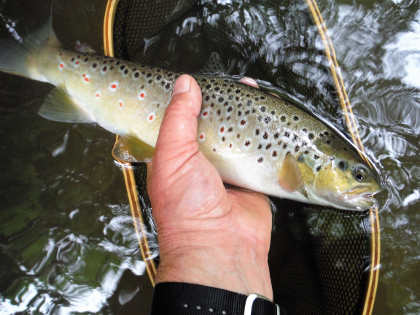
Well, that rounds up the 2018 trout season, which I think turned out to be quite different from anything we expected. Those who hoped to find migratory fish were having a hard time of it, but in fact the trout fishing held up reasonably well even at the height of the heat and drought. The secret generally was to head upstream and hide from the sun under trees, and some of the brooks on the Wild Streams scheme fished surprisingly well. Let's look at our catchments systematically. The Usk gave excellent sport during the spring as usual but it tailed off (again as usual) during the hot weather and didn't really come back. The Upper Wye fished well in the spring, a little later than the Usk as we might expect, and then it became difficult, although fish could be taken from fast water. The shaded beats from Builth up to Rhayader did noticeably better than other parts. Dam release water was a factor in the flow of both main river stems. Our section of the Teme (above the Onny junction) went dry, but then it usually does. The Lugg and Arrow fished consistently well all through, from the mayfly season on. The main Monnow had good fishing during the mayfly, but was disappointing thereafter. However, Monnow tributaries such as the Escley Brook, Honddu and upstream beats around Longtown fished well. The little Edw fished consistently well, as it usually does. Some of us had fun on Forest of Dean streams. The Irfon began to produce fish once the shorter days arrived. There were some excellent catches on the mountain lakes. Meanwhile the Taff and many more of the small streams, too many to mention, provided interesting days for some. I suppose this might depend on what you call interesting. I went out on the lower Monnow this morning, probably my last time this season, and found a very low river again, initially with a white frost on the banks followed by a hot bright sun. I searched a lot of river but only saw one fish rise. On the plus side, I caught it, so I awarded myself a celebratory glass when I got home at lunchtime. It's all a matter of managing expectations.
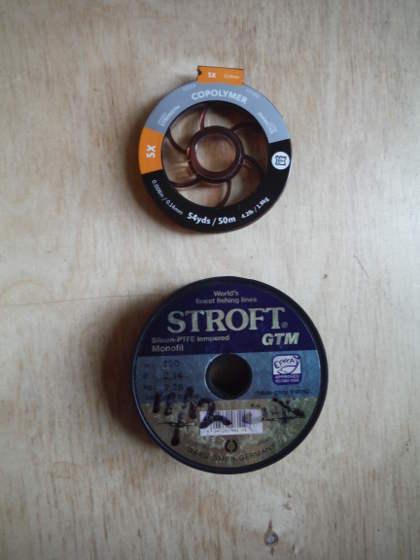
Some thoughts on technical matters come to mind. Over time I have messed around a lot with dry fly leaders, trying to find what I consider to be the ideal combination for the conditions in order to deliver the fly accurately, but gently. Normally I am wedded to quite long leaders and I may well start off with 16 feet on the open river, especially on pool tails. In calm weather or across the wind, these can be more accurate than you would think. On the other hand, the problem is that I get lazy, and find myself doing something silly like driving such a leader straight into a freshening breeze in an attempt to make it turn over properly. The result is usually a tangled mess of twisted monofilament, whereas what I should have done is sit down on the bank for a few minutes to construct something shorter and more suitable with a steeper taper. Usually in the business of leader construction one is looking for a stiffish butt and a more limp and compliant tippet section. I have chopped and changed over the years in experimenting with tippet material and the current Hardy copolymer is not bad. However, lately I have got to like the German Stroft brand, the nylon which nymph fishermen are so keen on. The abrasion resistant ABR version which avoids tangling droppers seems to be the one for nymph fishing, but I find that the softer GTM Stroft makes a very nice dry fly tippet. Nor is it much prone to deteriorate with age, even in the finer diameters. If you are minded to try it, you should be able to get it from Tungsten Beads or Funky Fly. Needless to mention that on the tight little brooks I am still perfectly happy with a tapered leader of no more than 7 feet.
One experiment I made this summer also concerned dry fly fishing on the brooks. I'm on record, more than once, as having stated that small stream trout are not usually "picky" and that a small rusty coloured Klinkhammer pattern is probably as good as anything and can be used most of the time. I still think that idea is true and the "Rusty Klink" has three distinct advantages: it floats very well in rough sections of water; the white wing can easily be seen by the angler; and finally mine are tied on Kamasan B100 curved grub hooks in size 16 or 14, and consequently are "good hookers." On the other hand, I have also stated, and more than once, that any little dull-coloured fly would probably do the job as well and why not a Parachute Adams? Well, I thought it might be an idea to prove that statement, at least to myself, so this year I fished the Parachute Adams on the brooks for most of the season and it lived up to my expectations. The PA, I believe, is a very good imitation for the olive upright and certainly rarely fails during that particular hatch, but it has a much broader application than that and gives a reasonably good general impression of most olives. I keep the pattern in a range of sizes from 12 to 18; a difficult Usk trout might refuse it on occasions, but it has a very good chance of working for less discriminating fish in the brooks.
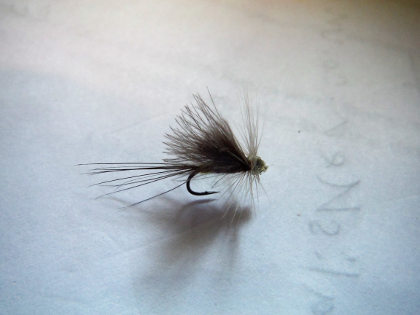
Another thought: Dave Collins wrote to me the other day and was extolling the virtues among other patterns of Charles Jardine's Duck's Dun, a fly which he finds consistently useful. Now I tied up a few versions of this years ago, but for some reason only tried them out occasionally. Come to think of it, when I did try them out, they usually worked! The Duck's Dun is really a generic pattern, which can be used to imitate any up-winged fly by varying the size and colour of the materials. One prominent feature of the fly is a CDC wing, which is a material which sometimes annoys me. It looks great, but when it gets wet, perhaps in rough water, it stays wet, the fly sinks and is difficult to resuscitate - better put it on your fly patch for now and get a new one from the box. But in the case of the Duck's Dun, it does not rely on the CDC for flotation because it also has a perfectly good hackle. It also has a tail, which helps the fly to consistently alight at the right attitude and you have the option of clipping the hackle underneath depending on how high you want the fly to sit. Note to self: experiment more next season with Duck's Duns of different types.
Now we are on the subject of fly patterns, I'm reminded of a recent chalk stream experience. A lot of anglers I meet or correspond with don't seem to appreciate how very different the chalk streams are from our free-stone rivers of the borders and Wales. They do things differently in Hampshire and the neighbouring counties. Border angler Edward Powell was famously annoyed in his day by the assumption of chalk stream writers that the lessons they had learned on their hallowed waters would be applicable everywhere. In this, at least, the forthright and irascible Reverend Powell was right. You still occasionally come across an attitude amongst the chalk streamers that they are somehow at the epicentre of fly fishing knowledge and development. This slight arrogance rather overlooks the fact that, wonderful as they are, and whether with fish wild or stocked, chalk streams are exceptional environments and very much the minority among rivers in Britain and indeed everywhere else. The undeniable fact is that most of the world's trout fishing is free-stone river fishing.
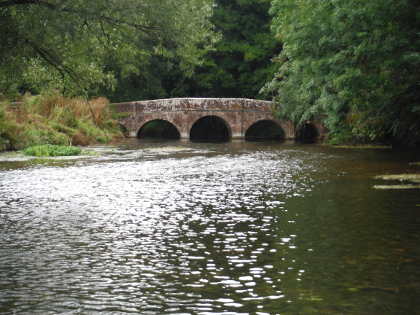
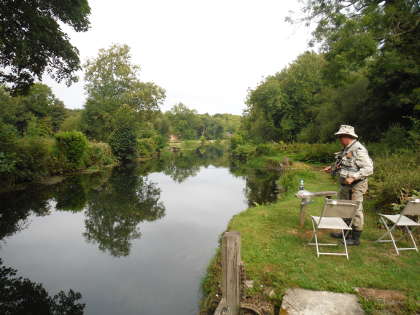
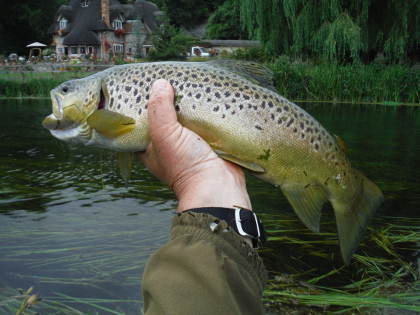
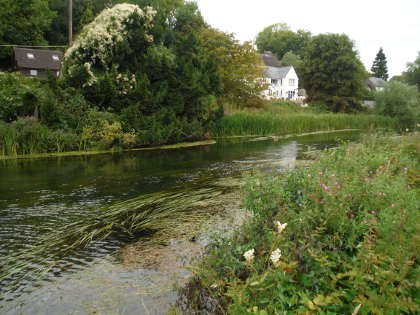
Still, Britain's chalk rivers are to be treasured. The particular chalk stream day I have in mind occurred during August. Even without the drought problems we experienced this year, August can be a rather a dead time on the river. There might be some blue winged olives during the evening but insect hatches are generally at a low ebb. Trout, if they are interested at all, have to make do with the odd terrestrial or perhaps some sedges later in the afternoon. I was mindful of this fact when David Burren kindly asked me over to his syndicate water at Heale on the Wiltshire Avon. Keeper Peter Major had told David on the phone that there were plenty of fish in the river, but they were distinctly spooky and fussy risers at the moment. The last time I fished at Heale, mayflies had been fully on the blossom and there were great glooping rises all over the river. As we arrived on this morning the surface was only broken intermittently by the odd "oncer" and very occasionally at that.
On the other hand, the Avon on this August day looked to my eyes to be in pretty good condition compared to our over-heated rain-fed rivers which were then suffering so much from reduced flows. The water was gin-clear with rich green tresses of weed waving and the river looked everything a chalk stream should be. And there were certainly plenty of fish in it. It was a cloudy day, not too warm and with a little drizzle of rain during the afternoon. As usual here, it turned out to be a dry fly day. David, who is suffering badly from a damaged knee, was unfortunately restricted to the section near the car park and main hatch gates - the place known as the Turbine. This area gets fished a lot and trout here were distinctly wary, as he found out. I was able to roam around to the less pressured parts of the beat and this did pay off. I saw very little in the way of flies: a few pale wateries, just the odd sedge as the day wore on, and also the true mayflies, for which this beat is famous, were still occasionally in evidence. I counted a half dozen through the day. With few fish rising, I did some spotting with polarized glasses and rather more of blind prospecting in likely places on my way up the river. I am aware that Halford would thoroughly have disapproved of the prospecting. Never mind, I wanted to find out what would bring them up. At one stage I actually tried a mayfly pattern for about 10 minutes, but it wasn't working. Instead, it was a matter of reducing the tippet thickness and going down to smaller and smaller flies as the larger patterns were approached from below and rejected. I saw a lot of swirls under, for example, a size 14 Parachute Adams. A size 16 Goddard Olive Emerger seemed to be much more acceptable.
Peter Major turned up with his son Ben just as I missed another rise (one of quite a number I missed that day) and discussed his river-keeping year so far. During the winter he had been concerned about the lack of rain and the levels for the coming season, but thick spring snow on Wiltshire uplands and Salisbury Plain had recharged the aquifers and saved the day, or so he thought at the time. I commented that his lovely river looked pretty good to me, certainly in comparison with our water-deprived border streams. However, Peter would still have preferred more flow. Peter's own view about the fishing was that the fly pattern didn't matter so much, but the size and the tippet thickness certainly did. I pressed on with the small Goddard pattern which was now being taken with confidence, and ended up with three modest-sized grayling, four trout in the 12-14 inch range which looked like they might be wild Avon fish, and nine of the almost copper coloured stock brown trout running up to a hefty 19 inches. At one point I used a thicker tippet again. This was on a section just below Woodford Bridge which was almost choked with ribbon weed. Here there were plenty of the big stock trout which were quite ready to come up for a small fly trundled on the clear surface between the weed beds. Once a fish was hooked, however, after the initial thrashing at the surface with a broad golden flank showing, there was nothing for it but to take firm charge and walk the fish steadily downstream about 30 yards to a clear patch where it could be played and netted. This worked in most cases and I marvelled, as often before, how a large fish, strong and freshly hooked, will become so tame and allow itself to be led by a steady pull in one direction.
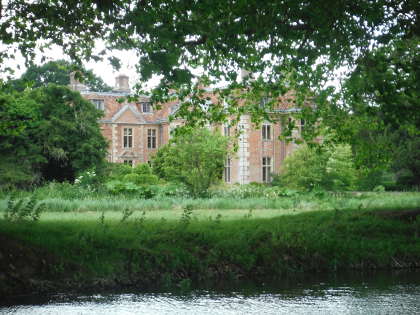
Thanks to David and Peter, I always enjoy a day on the Avon at Heale where the beautiful surroundings make a contrast to our own wilder and very different kind of fishing further west. The Heale estate certainly has a romantic history. The old house of faded red brick, which has looked for centuries now over the Avon water meadows, for six dangerous nights hid the fugitive King Charles II on his way to the Channel. He spent his days with the horses tethered in nearby woods and copses while friends on the coast negotiated for a ship. Were they days and nights of terror as Parliamentary cavalry scoured the countryside for him? I suppose he knew that his head was at stake and that France was about the only chance for him. I would like to think he remembered Heale kindly during the years of exile which followed. According to Samuel Pepys, in the later years following his reinstatement the sovereign talked incessantly and enthusiastically about his weeks on the run, remarking that it was the one time in his life he met numbers of ordinary British people - ostlers, carriage drivers, inn servants - on a more or less equal basis. Some recognised him and some did not, but the direct contact was something not normally experienced by a monarch in those days.
If I have a soft spot for Heale, I have another one in my heart for the Cannop Brook, which is just minutes away from my home. To tell the truth, I have a soft spot for all the Forest of Dean brooks which I sort of contributed to the Wild Streams scheme. A few years ago, Seth at the Foundation twisted my arm about them, asking what was available, and Adam Fisher, who was then the Marketing Officer, came along to look at them with me and then we talked to the Forestry Commission about Blackpool and Cannop, and to the Penn family about Bideford Brook. I have known these streams a very long time and it was Blackpool Brook, just by the old ruined pumping station, which gave me my very first trout, when I was 9 years old. Long before that, when we were toddlers, on hot summer days the family used to bring us downhill from Danby Lodge to splash around happily in what was known as the Bathing Pool. This was just a short section of the brook dammed with rocks to be about 15 inches deep. We could pretend we were swimming while still keeping our feet on the bottom. It was a different Forest then, not long after the Second World War, with mines, quarries and railways still working. There was little traffic on the roads, but men with red flags used to close the one alongside the Blackpool Brook at 6 every evening so that charges set in a nearby quarry could be fired. Supposedly you could set your watch by the shots going off. Today my grandchildren still splash in the same brook just upstream at Wench Ford, sharing it with hundreds of other children now, while smoke rises from family barbecues and the Forestry Commission charges us all two pounds per car to park. The world has changed all right.
Meanwhile pools come and go and rivers change too; in just 10 years some sections of our wild streams can change out of all recognition. There are some unusual features about the Dean streams and Cannop, in particular, is changing quite rapidly. It's worth looking at the reasons. If you take a map and look down on the Forest from above, you are really examining quite a complicated geological area. The Forest is a dome of different layers: sandstone of different sorts and colours, millstone grit, limestone, seams of coal and iron ore. The dome actually has a collapsed or eroded centre and a distinctly high rim, although nowhere more than 1,000 feet, and the sides have been fissured by the streams which drain it. This high ground has been mined since well before the arrival of the Romans and covered more or less continuously with thick forest since prehistoric times, although the woods were badly depleted for ship-building during the Napoleonic Wars. Industrial railways, complete with embankments, cuttings, gradients and tunnels, have come and gone between the 19th and 20th centuries, their traces covered now by the trees. Even the mine spoil heaps, one of which at New Fancy I can remember smoking slightly with internal combustion during hot weather, are now grown over.
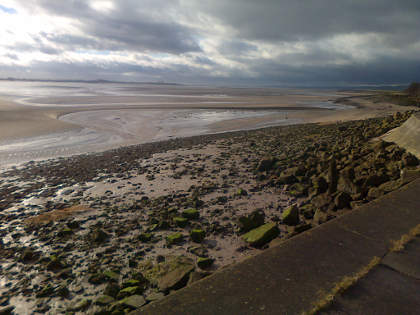
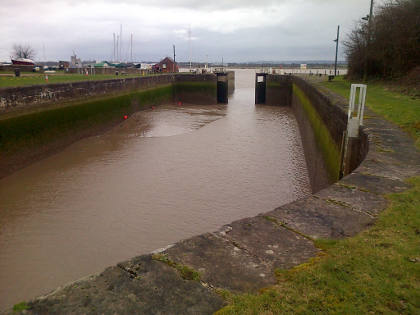
On two sides the steep Forest slopes are closely bounded by the Wye, which in its gorge twists interminably, so a salmon has much further to swim upstream than the two straight sides of a triangle indicated by a ruler laid on the map. On the third side, the one facing the Severn, the wooded hills come down to a strip of flat and quite valuable agricultural land, through which the easterly flowing streams on their way down from the Forest must pass before reaching the salt water of the estuary. This strip of reclaimed land, varying in width, runs all the way from beyond Newport up to Gloucester, and it is in fact quite artificial, the result of mediaeval land drainage and sea wall building. (There is of course a corresponding strip on the opposite side of the estuary, including the Wildfowl Trust land at Slimbridge and the Gloucester-Sharpness ship canal). Once these areas were no more than marshland, flooding on every tide. It is still maintained by pumping in places, and the sea wall has recently been raised by several feet of earth bank (the resulting ballast hole by Lydney station is already being fished for carp). "The Tack" is the name given to the part of this flatland below our town: cattle and sheep are pastured on it and there is an emergency landing strip for light aircraft. Hares love the open grassland and winter winds blow wildly across it without restraint. For centuries there have been small tidal harbours where muddy creeks, known locally as pills, reach inland from the estuary. Apart from the salmon fishing, ocean-going ships were once built here. Lydney's Greyhound Inn refers not to a dog, but the name given to a locally built schooner. Great four-masted barques piloted up the Bristol Channel once docked to unload grain at Sharpness across the water. There is a small ship-breaking industry at Newnham even today. Control of the water levels is quite a complex affair and smaller streams have had one-way tidal gates installed, to prevent back-flooding of the pastures. Meanwhile wind turbines are being erected at a steady pace and along with two nuclear power stations on the far shore and the motorway crossings downstream, they represent the typical landscape of modern Severn-side.
There remains a kind of acceptance of the impermanent nature of the estuary grasslands. In fact a decision has recently been taken to sacrifice some of this Gloucestershire farmland if and when global warming produces the expected rise of several inches in sea-level. This worry about the power of the water has always been present for communities living at the edge of one of the biggest tidal ranges in the world (only Canada's Bay of Fundy has larger tides). The main South Wales railway line, a relatively modern construction, runs bravely enough straight across the reclaimed lands on low embankments. But the A48, which is effectively a Roman track, plays safe and stays inland skirting the foothills. Blakeney and Lydney, both Roman in origin, keep to the road and the edge of the hills. As always with flood plains, it is rare to find a house dating before the 19th century built in an area which might be at risk. Modern engineers rely on pumps or maybe take arrogant chances with their projects; builders of former generations made sure to keep just above historic water levels. At Blakeney the remains of a Roman dock has been discovered near the main road in the middle of the village. We can therefore surmise that the WUF beat of the Bideford Brook below Blakeney, today a stretch of rippling pools over gravel where we fish for small trout, was once a winding tidal channel leading through reed beds full of game and water fowl, a place where small Roman vessels would be poled upstream to be moored and loaded close under the Forest hills. Even now the salt water and reed beds are only about three miles downstream and a spring tide will cut off the road between Blakeney and Awre for a couple of hours. There is a depth gauge by the road so that drivers can calculate their chances.
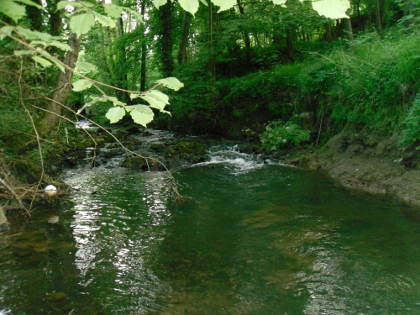
The nearby Cannop Brook, which just above Lydney town runs over a series of weirs associated with former iron working forges, has a different character of its own. It splits into two, one branch being the remnants of an 18th canal which one carried coal and the man who services my car in a garage on the edge of town saw an otter in it behind the rugby pitch last week. Below the high street the main stream, known here as the Lyd, skirts the town's sports fields which have to be pumped dry every winter, crosses what is still an obvious marsh, haunted by rabbits and full of rushes and briars, and passes the railway junction to supply a wide canal and the basin and docks of the port. Further up in the Forest, the part of the Cannop Brook which we fish in a valley between Parkend and Whitecroft might look at a glance like any stream draining hills and formed by nature. In fact it is really quite unnatural. If you check your satellite navigator map, you will find that here you are driving on something called the "New Road." A century ago there was no motor road here; instead this wooded valley with its flat marshy floor housed a stream which made natural meanders from one side to the other, rebuffed each time it came to sloping ground. The railway line had already been built on very slightly higher ground up the east side of the valley, the embankment carefully culverted to drain the slope above. Otherwise, there would have been paths and tracks, but no bridges and no heavy road traffic.
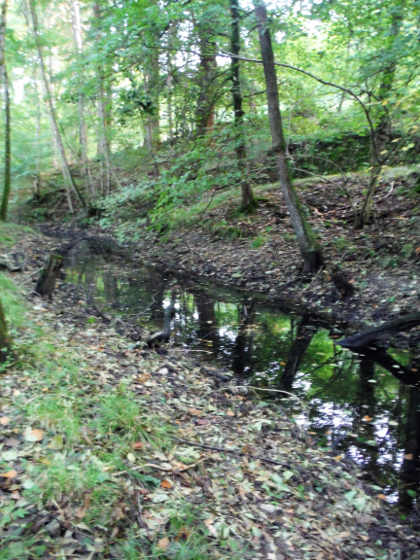
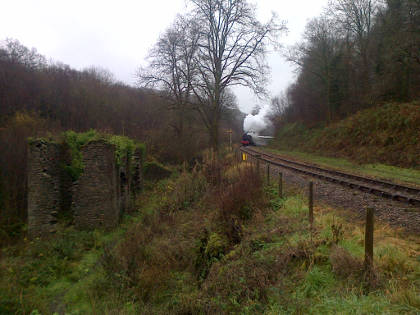
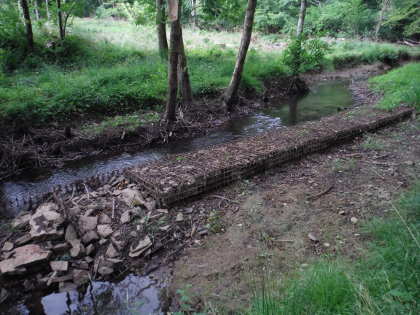
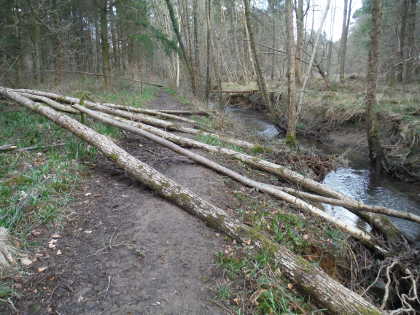
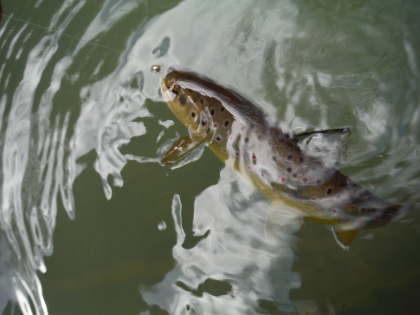
The New Road, to the best of my knowledge, was built for motor traffic just after the Great War. It runs on a built-up causeway following the railway line closely, and today is quite busy taking north-south traffic through the heart of the Forest. The engineer might have opted to build a series of bridges taking it across the various bends in the river. Instead, the decision was made to move the stream instead and a new straight channel about 3/4 mile long was dug for the water about 150 yards to the west of the road. If you walk the pavement of the New Road between Parkend and Whitecroft, as you must do on the way to start fishing, you can still spot the mostly dry bed of the old river, curving in places between the road and the railway. Today even the railway is working again, restored by Forest of Dean steam enthusiasts. One winter morning when I was parked ready to trim branches on the brook, I had a chat with a team of railway volunteers who came along the track clearing weeds from the ballast and checking the sleepers. They had a kettle boiling on the inspection car and treated me to a cup of tea. Back in the 1920s, moving the river sideways to make space for the road must have seemed the perfect solution. And yet it seems the river itself does not agree and never did, because it is constantly fretting in its channel, working to restore those natural winding meanders. Some of it is still straight, oddly so, but many new bends are developing. The stream bed consists of gravel of different types, rock in places, but there are many areas where the bottom is nothing more than pale coloured clay and the current can scour deep holes at will, only to refill them with silt as the whim seems to take it. As far as growing little trout is concerned, there seems to be no problem at all - this stream has as many small trout in it as any I know and there are mayfly too - but the water is more than wayward in the way it is cutting into the landscape. Efforts have been made in the past to control it with gabion baskets filled with rocks, but these are also being undermined steadily.
One more man-made change has affected our Cannop fishing over just the last couple of seasons. This beat used to be very overgrown and the middle section ran through a trackless piece of forest. You were more likely to meet a deer or a boar than another human being. There was no path along the stream, although the road is close and one of the wide forest tracks capable of taking heavy machines runs a couple of hundred yards further west. (Some of the main forest tracks still in use were built by Italian POWs during the 1940s). I used to worry about the number of inaccessible places with steep banks to the brook and the number of fallen trees fallen into the channel. Then the Forestry Commission undertook a tree thinning operation in these woods. The work was done by a contractor, but to give the Forestry Commission their due, they made a point of consulting us about what would be good for the fishing. By the end of the work, many of my worries about inaccessibility and debris blocking the channel had been resolved.
However, shortly afterwards a group of Parkend villagers, without referring to anybody else, came up with the idea of making "a nice riverside walk" along the brook and through the forest from their own community to Whitecroft, the next village. To give them their due, they worked hard at it, clearing undergrowth, bridging side ditches and cutting fallen trees away. I came across them one day while I was doing my own winter trimming and the plan was explained to me. The Forestry Commission hadn't been consulted at all and the Ranger rang me up to ask what was going on along the bank and was it us?
It's hard to be sore at anybody who only wants his community to have "a nice riverside walk." At least that was the view I took and the Forestry Commission too. When it was all finished, the pools were about as open as they will ever be and a path had been completed right the way through, just above the water. This did not seem to reduce the number of trout in any way, but the effect became rapidly apparent. Whereas I used to fish deep in the forest, making my way either up the channel or through briars and bracken, I was now just below an open path. Stream-side traffic along the path has grown, week by week, and by my reckoning 4 out of 5 walkers are accompanied by at least one dog, often more than one. And of course the dogs are not kept on a lead and in most cases, naturally enough, they splash into the water of every pool as they bound along. Nor do the owners seem to have any idea that this might inconvenience an angler. I have lost count lately of how many ladies have greeted me with a bright and uncomprehending smile as their animals frolicked and splashed around my waders. And I have learned that there is absolutely no point in trying to explain the problem of spooking fish. The most likely response you will get is: "...there are hardly any fish in here anyway." I'm fond of dogs, but generally speaking they don't mix too well with fishing unless they are very well trained dogs, a rarity nowadays. Of course I know there are anglers who reckon to take their dogs fishing - Hugh Falkus, for one, used to take his Labradors with him on the Cumbrian Esk. The Falkus dogs are introduced to us in a river fording photograph on the jacket of his famous book on sea trout fishing: Prince and Stinky Wow-Wow. Of course, the publisher may have been responsible for that tit-bit, but I can't help thinking that if I had given a dog such a name, I would have kept quiet about it.
Anyway, there the situation is and I see from the reports that I am not the only angler to have been inconvenienced at Cannop. We will have to share this stream, and its new bank-side path. My best suggestion for next year is to fish it on week-days and early in the morning - although it will have to be quite early. One dawn-rising owner with a dog splashing its way upstream can spoil the whole thing for hours. Or, perhaps, one could make a point of fishing it during a day of pouring rain?
Following on from the piece about fly reels in last month's letter and particularly referring to British Fly Reels, John Brown wrote to me about the contribution made by Ken Morrit to designing fishing reels in the UK. Morrit began in the years after the Second World War, working originally in Surrey with the Intrepid name and later in Cornwall for BFR. This ingenious designer was responsible for the Intrepid Black Prince, a reasonably priced and reliable fixed spool which introduced a large number of young anglers to the sport, the excellent BFR Rimfly, one example at least of which was at one time owned by most fly-fishers, plus a host of technical innovations including the one way clutch and separate line cartridges. The fact that his ideas and the production of them in the UK came to that sudden end with the loss of 60 jobs in Cornwall, makes the tale all the more sad. Look at https://whiteaddersflyfishingmuseum.weebly.com/k-p-morritt.html for the whole story.
Finally, I am sorry to harp on about something which has been mentioned more than once, but perhaps as the guy who has the job of collating the reports, I can be forgiven. We are more than grateful for all the photographs sent in, but photography should take second place to fish welfare and safe catch and release techniques. Thus, we really don't like to see photographs of live fish laid out on grass, on dry rocks or on dry shingle. As we all know, live fish don't lie still, but are very prone to kick and injure themselves and big fish are more vulnerable than small ones. By all means photograph your catch laid in a wet net with fish-friendly mesh, on a wetted fish mat, or else lifted momentarily above the surface on one or two wet hands to take the shot. Please don't "grip" the fish and most importantly make it quick - get the fish back in the water again as soon as possible and make sure it is actively swimming and strong again before final release. If you catch a salmon while fishing alone, there usually isn't a responsible way to take a photograph of the whole fish. Don't be tempted to drag the poor creature onto the bank, but content yourself with photographing the head or the tail while in the net and in the water, before releasing it carefully. Giving a weight or a measurement for the fish you have caught is much less important, but if you do either, for everybody's sake please make it an accurate one. "Around," "nudging," "getting on for," "just short of," and "more than" are not measurements. On the other hand and purely as an example, 14.5 inches, 15 inches or 15.5 inches certainly are. A measuring tape is not much weight to carry in your pocket, or else mark the inches on your landing net handle or staff.
Tight lines for grayling during October!
Oliver Burch www.wyevalleyflyfishing.com
August 2018
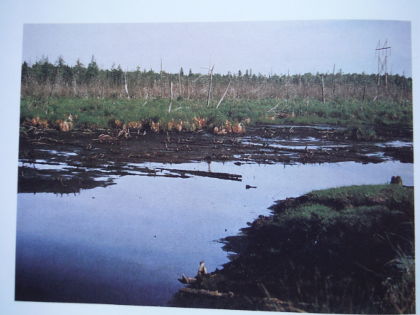
Firstly, apologies because in the July letter I missed out a photograph from Robert Hunt's book showing what beavers can do to a landscape. Here it is and the picture clearly demonstrates the scale and nature of the possible damage (to a stream in Wisconsin, in this case). I suggest it gives an idea of what we might face if the current drive to reintroduce the species to the UK after an absence of 400 years succeeds. American visitors tell me that dismantling beaver dams is a regular chore in states with well-maintained angling streams. I do wonder at those who seem to have the idea that any species ever known to live in these islands should be reintroduced and nature left quite alone to find a balance. With that thought already in mind, I smiled rather cynically to myself when I read that the RSPB is in trouble with some members as the bird protection organisation begins culling crows (and foxes). This is being done in order to protect ground-nesting curlews, and the RSPB, who have contracted some professional keepers from sporting estates to do the work, have stated that "...there were no non-lethal options available." This is something to bear that in mind while we anglers are again tasked with counting the flocks of cormorants and goosanders on the river to provide yet more evidence that they might be harming fish. As a result of the crow cull, RSPB has been accused by protesters of "...behaving like blood sports enthusiasts." I assume these protesters include those who wouldn't cull any species under any circumstances. People in field sports and agriculture have always understood that considered interventions of this sort are pretty well essential, although the details and the target result can be discussed. In fact you won't find better conservationists than many people in field sports and that goes for the majority of farmers also. It does seem a shame that so many people who claim to love our countryside and its wild-life seem to be pulling in different directions.
Enough of beavers and re-wilders and the quarrelling conservationists! August was the month when the heat wave ended, but the drought to all intents and purposes continued. We had some showers in the middle of the month and a few hours of heavy rain on the 26th. Each of these was enough to start a small muddy pulse down the Wye, mainly because of the Irfon rising, but not the kind of sustained high water needed to clean the river out or get salmon moving properly. The Usk hardly moved and the Monnow not at all. It does seem that there was enough water on western mountain slopes to move a few fresh salmon and sewin into the Towy. Meanwhile the trout and grayling anglers had a rather better time of it, either fishing on the upper Wye or the Herefordshire tributaries. Blue winged olives produced some evening rises on the Usk. Small streams, which are of course quite difficult to fish when there is hardly any flow between the pools, nevertheless produced good results at times. In fact there were reports of some surprisingly good catches.
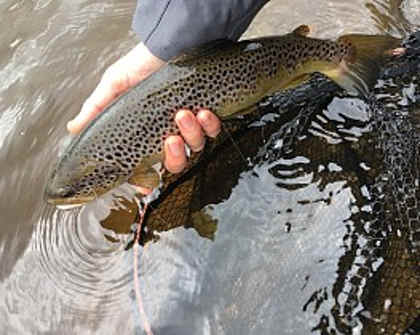
Mountain lakes also fished well, at least on days of soft light with cloud cover and a ripple. I really enjoyed reading MD from Llanelli's report about fishing Llyn Egnant on the 30th July. An overcast day with a good wave, as he put it, brought the fish up and made all the difference. That is almost always true of this kind of water; fishing a calm on an upland lake in sunshine tends to be hard work. He caught 11 trout, mostly 10 inchers, but including a larger fish, and the black and red Bibio did most of the damage. That's a great fly for the mountain lakes and MD doesn't tell us where it was on the leader, but I would fish it on the top dropper. On the 2nd August, AM from Dorridge had 3 trout to 12 inches and 6 grayling to 14 inches by various methods from Doldowlod. The Usk at Fenni Fach came back into the picture as MN from Bristol took 7 trout to 16 inches with light nymphs. CH from Bexleyheath had 8 trout from the Bideford Brook and fishing it again on the following day he had another 10. "Bideford Brook is a little gem," he wrote in his report, and so it is. MP from Abercynon had 10 trout from Llwyn On, while TH from Brecon fished with small nymphs at Gromaine for a large catch of grayling and 8 trout. PB from Leominster had 3 grayling and 5 trout from the Rectory. Meanwhile MD from Llanelli was having another energetic day at Llyn Bugeilyn where he took 12 trout with traditional wet flies and remarked on the difficult, not to say slightly dangerous, walking conditions on the sloping peat bogs surrounding the lake. I can echo that, having once torn my Achilles tendon on my way round there - a very painful affair. There are mud slides and more than a few treacherous crevasses where the peat has split open. Unseen water can be heard trickling far below and you get the impression, accurate I think, that the peat is very slowly on the move like a glacier.
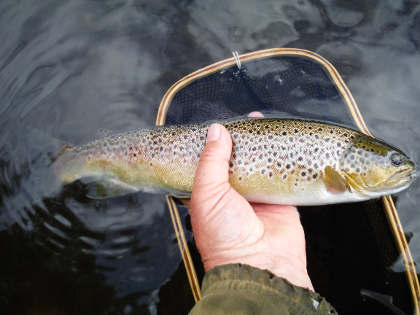
Also on the 3rd, JL from Biggleswade while fishing at Lyepole had 12 trout and 15 grayling to a maximum size of 12 inches. On the 4th, SF from London reported 7 trout and 15 grayling from Abernant. AS of Newent had 5 trout and 25 grayling from Llangoed and Lower Llanstephan while SJ from Stoke on Trent reported 2 trout and 24 grayling from Doldowlod. NJ from Cwmbran with a friend had help from owner Shaun while fishing Craig Llyn, and they managed 1 trout and 11 grayling, including a good one. MC from London was another who in his report was quite unhappy with the access at Monnow Valley. This is an old chestnut and I am really not sure what more I can say about it, apart from encouraging newcomers to our waters to please read the beat descriptions and also some of the catch reports before making a choice about where to go. Monnow Valley is honestly described in the Passport as somewhere which is quite hard work, but often rewarding. It is patently untrue to state: "you can't possibly fish," because we can and we do - but Monnow Valley is not one I would chose to take beginners to. On the 5th KL from Bristol was also upset - this time about Cannop Brook, where he took 18 trout on a dry fly, but also had his life made a misery by unsympathetic dog-walkers. Well, I can try to be sympathetic about that because I have been having similar experiences lately. There is a reason for the increased activity along the bank which I will explain in next month's newsletter.
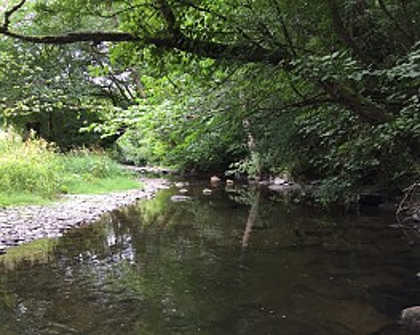
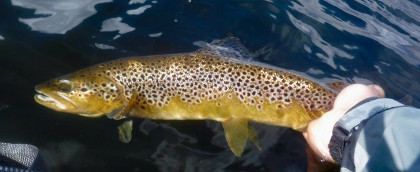
SF from London had an extraordinary catch from Gromaine and Upper Llanstephan on the 5th. Apart from 10 grayling, he had 15 trout, all of them reported to weigh between 1 and 2 pounds. For wild brown trout on the Wye - or any freestone river - that is a remarkable average size (fish of between 14 and 17 inches) and a rare catch indeed. On the 7th my old friend Dave Collins of West Herefordshire fished at Abernant, mostly prospecting with an emerger pattern. Roaming around in very low water he got 6 trout to 12 inches and 27 grayling to 13 inches. On the 9th SJ from Stoke had 6 trout and 3 grayling from Craig Llyn, while AM from Dorridge had 1 trout and 6 grayling from the same beat. RW from Portishead did well to catch half a dozen trout from 7-11 inches on a small Parachute Adams from the Half Moon beat at the top of the Honddu. Season rod holder RW of Boughrood fished at Gromaine and Upper Llanstephan to catch 12 trout and 7 grayling using nymphs under an indicator. On the 11th AS from Newent fished at Lyepole for 2 trout and 10 grayling. On the same day, JD from Porthcawl (that will be Jonathan Dabernig, one of our regulars) treated himself to a nice little holiday on the Edw tributary, a productive stream entering the Wye below Builth Wells. He fished first at Aberedw, the lowest beat, and caught 17 trout from 6-10 inches on dry flies before staying overnight at the Hundred House pub. This community always intrigues me, firstly because I am tempted to work out if there actually are 100 houses - inevitably I run out of patience during the count. Secondly, because during a hard winter it vies with Sennybridge as one of the coldest places in South Wales - they have recorded minus 20 degrees here on occasions. Anyway, JD recommended the pub - good real ale, steak and a comfortable bed - before reporting on his second day on the Hergest beat, where the Edw runs over sandstone slabs. This time he scored 20 trout up to 12 inches, a good size for any small stream. Rain had by now coloured the water slightly, which may have helped the fishing. JD remarked that much pruning work has been done on this beat. Another good report came from Llyn Egnant on the 12th. On a nice "soft" day of low cloud and rain, CT from Cardiff with a friend took 20 trout by traditional methods including a handsome fish of 2lbs 2 oz. Meanwhile TH from Brecon fished the main river at Gromaine and Upper Llanstephan and using a 2 weight rod scored 6 small trout and 13 grayling.
We had some more rain in the catchment very early on the morning of the 16th. According to the Metcheck forecast, this was only supposed to involve 3 millimetres or so, but I believe some upland areas must have received very much more than that. That morning the Wye below Builth started as low and clear as ever, but quite suddenly around midday the river began to colour and rise. The culprit was the Irfon tributary upstream, famous for rising and falling quickly. On this occasion it had shot right up into flood and, naturally enough after so many weeks of drought, a dirty flood at that. The Wye rose around a foot in not much more than half an hour, enough to push us off the river, after which it slowly fell again. Encouraging, perhaps, after all these weeks of drought, but the fact is that it was not by any reckoning enough water to make a real difference. Still, the lift seemed to stir up the trout fishing for a time. On the following day HW from Penclawdd fished the Irfon at Cefnllysgwynne for 5 trout and 8 grayling, mainly on dry flies. JL from Biggleswade found the main Wye fining down at Craig Llyn and caught 8 trout to 15 inches and 3 grayling. TH from Brecon (this would be Tim Hughes of Fishtec, I think) had 5 trout and 12 grayling from Llangoed and Lower Llanstephan, while JA from Leominster had 6 trout and 2 grayling from the Llynfi tributary at Pontithel. BD from Swansea caught half a dozen trout from the Usk Reservoir.
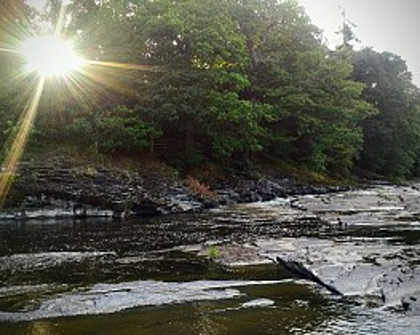
On the 18th, ZS from London had 16 small trout and 4 grayling from the upper Wye at Ty Newydd. SB from Cwmbran and a friend reported 6 trout and 17 grayling, including a couple of good ones, from Craig Llyn. Round about this time, and I imagine with much soul-searching, the WUF suggested that salmon fishing, which had been suspended during the heatwave, might restart as water temperatures had now fallen. I think, given the depressing standards of internet debate about our fair sport, whatever the WUF suggested at this juncture would have been criticised in exaggerated and personal terms. Anyway, salmon fishing did indeed start again, if slowly, and TH of Brecon duly kicked off the "second half" with a resident fish taken from the Millstream, a fast water run on the Rectory beat. This was followed by a grilse from Wyesham at the bottom end and later another larger fish from fast water on the Rectory. On the 19th RB from Redditch had 12 trout and 18 grayling from Gromaine and Upper Llanstephan, using a small nymph. On the 21st DR from Bristol fished both Bideford and Cannop Brooks, finding them very low, but nevertheless catching a dozen trout between them. He was lucky enough to meet a responsible dog owner on Cannop. On the next day DC from Cwmbran fished at Ty Newydd catching 6 small trout and a couple of grayling. He had a complaint to make about the rickety condition of the stile in the middle of the beat. I can echo that - the loose footrest wobbling left and right really is a nasty accident waiting to happen. Something should also be done about the improvised fence/gate/barricade between there and the fishing lodge which anglers are obliged to risk their waders on while clambering over. On the same day, RW from Portishead caught 13 trout to 11 inches at Aberedw using a small dry olive. On the 23rd ST from Caerphilly fished at Usk Reservoir and caught 6 trout using a small damsel pattern on a slow sinking line while JA from Leominster had 7 trout from the Clywedog. There were some very strong showers that afternoon in parts of both catchments, certainly more rain than had been predicted and I found myself driving through a downpour of tropical intensity. To my considerable surprise the river levels did not rise much this time. However, the intense rain overwhelmed the sewage pumping station in Hay for about an hour, during which period raw sewage was running off into the Wye. What many do not realise is that however modern and regulation-compliant sewage treatment plants may be, in the case of a sudden and overwhelming flow which cannot be managed, the fall-back arrangement is usually that it goes straight into the river. Certainly the incident produced much negative comment on the internet and a friend of mine was heard to mutter that the fall-back arrangement should be an overflow pipe poised over the operations manager's office carpet.
KB from Abingdon had a dozen fish, 5 trout and 7 grayling, from Lyepole on the 25th. Meanwhile BP from Pembridge took 17 trout to 10 inches using traditional wet flies on Llyn Bugeilyn. More rain on the 26th lifted the Wye slightly and the Towy also had a flush of extra water. On the 27th, SW from Hereford with two companions had a very good day on the upper Wye at Craig Llyn, reporting a total of 37 grayling and 25 trout on nymphs. The rains may well have played a part as the water colour was described as peat-stained. Next day GN from London also had good fishing on the Usk at Dinas, taking 25 trout on nymphs. He fished at Dolgau on the 29th, taking 7 grayling shots and a trout. PB from Leominster had 6 trout and a grayling from the Rectory on the 29th. Meanwhile PW from Evesham had complaints to make about access on the Ashford House beat of the middle Usk. This gave me pause for thought; there is a rickety stile there and the banks are naturally quite steep, but no more than an average level of difficulty I would have thought. However, PW knew the beat 10 years ago when he says access was maintained to higher standards. The following day FS from Banstead had 4 trout and 5 grayling from Craig Llyn, while regular RW from Portishead managed 9 trout to 11 inches on dry flies from Lower Henllan on the Honddu. AM from Dorridge had 3 trout and 12 grayling, mainly on Klinkhammers, from the upper Wye at Doldowlod. At the end of the month, we found ourselves about where we started, with all the rivers clear and low.
I'm going to indulge myself this month with some thoughts about fishing reels, those small objects of desire which fascinate many of us. Are there are any other items of tackle, even including fly rods, which are so coveted by anglers as they leaf through the catalogues? Occasionally you meet some ruthlessly practical individual who will insist: "It's just a reservoir for the line; any reel made with reasonable engineering competence will do." For certain types of fishing, that mantra may just about be true. But in modern times we have been assailed by new developments such as adjustable drag clutches, large arbours and wonderful techniques for machining aluminium so that the tackle companies can come up with apparently completely new designs every couple of years. Anglers can make some quite odd decisions when it comes to buying a reel. The sales departments have a deal to answer for, although I admit that I can become as fascinated by a good looking reel as much as anybody else.
The 20th century saw the fascinating evolution of the fixed spool reel, the underlying principle of which at least really was revolutionary (forgive the pun). I think the idea originated in the textile industry. I still spin occasionally with a fixed spool and of course they can be used for trotting and every kind of coarse and sea fishing. There is much to be said about them, but for now let's confine ourselves to straightforward fly reels and other centre pin designs in which the spool rotates. What should you look for in a fly fishing reel? Let's try and analyse the options. The recent developments which are touted so much in tackle trade advertising as being valuable or indispensable are:
The quality of machining aluminium components. Computer controlled lathes and milling machines have made it possible to achieve a whole variety of interesting shapes by cutting material away, without involving too much in the way of labour costs. The result may be attractive to you, but I query how much of it is necessary, except when choices are being made about strength versus lightness.
Machined from solid "bar stock" aluminium, versus cheaper "cast" aluminium components. The first is supposed to be stronger, but is it? Friends in the aircraft industry tell me that it is not necessarily so.
A large arbour. For those confused by the expression, we are talking about the diameter of the spool. A "wide" arbour refers to the width of the spool. A large arbour (or large diameter spool) should achieve a rapid rate of retrieve when winding in, likely quite important if a hooked fish runs suddenly towards you. However, there are some pitfalls. When you are looking at an advertisement which claims, for example, that a reel has a 3.75 inch diameter, check whether the outer rim or the bed of the spool is being referred to. In many ways a more useful measure of a reel's performance is how many inches of line are wound in per turn of the handle when fully loaded. Some manufacturers will now give you that figure. Consider also that an old-fashioned reel of 3.75 inches diameter with a "small" arbour, little more than the axle tubing which runs on the spindle, once it is loaded to the rim with a line and lots of backing, will wind in just as fast as the "large" arbour the same size. It will also have a much greater line/backing capacity. I know one modern angler who refers to large arbour reels as "reduced line capacity" reels. (On the other hand, should an exceptional fish run right down into the hundreds of yards of backing packing out a small arbour reel as described above, the spool will begin to run faster and faster with implications for the check and/or drag setting. This is not a common event, but it is a point which might be worth considering).
Adjustable disc drag. Another modern innovation consisting of multiple clutch plates, invariably adjustable, which will slow down outgoing line against the power of a running fish. (An unusual American variant by Stan Bogdan instead has brake shoes expanding inside a drum, just like a Vincent motorcycle clutch). More traditional anglers will claim that an old-fashioned click check mechanism with some judicious hand braking to the rim will do the same job well enough. In the case of river trout and grayling, rainbow trout, and even salmon and sea trout, they are probably right. However, when it comes to very powerful salt water game fish I don't doubt that an adjustable clutch type drag is pretty much essential. Advertisements talk a great deal about the ultimate power of disc drags and the amount of torque they might be able to resist, theoretically at least, in order to stop a huge fish dead in its tracks. However, bear in mind that in such circumstances something will have to give when the rod is pulled down, whether it is a matter of the hook pulling or straightening, or the tippet breaking. In most cases, screwing down the drag and holding tight is something to be done only in desperation.
Sealed drag. Many big game or salmon reels incorporate cork discs alternating with steel ones. These need to be periodically dismantled and the cork lubricated with neatsfoot oil (taken from the feet of cattle) to keep them working properly and reliably. As far as I am concerned, life is much too short to be engaging in that sort of trouble. Also, some of the cheaper disc drags are extremely vulnerable to water ingress, either from fishing in the rain or when wading deep. What then happens is an annoying phenomenon known as "aquaplaning," in which the discs, however they are adjusted, alternatively spin free and then lock up without warning. Imagine playing a fish with the reel in that state. In either case the solution is the same: choose a reel with a waterproof sealed drag.
Exposed rim for hand braking. This is certainly a useful feature which I always appreciate. When I do play a fish on the reel, in most cases I'm inclined to leave the drag alone and rely on the click check combined with some judicious braking with my thumb or palm. In the case of a full cage reel with no exposed rim, bear in mind that you can still brake by hand if needed by introducing one or two fingers into the back of the reel to press onto the rotating line pack.
Click check mechanism - no need for it? There is a regrettable modern tendency to dispense with these altogether, on the basis that the reel has already been provided with a disc drag so no more is needed. I absolutely disagree with this reasoning. I want to hear when line is coming either in or out, so I definitely want an audible click check, ideally working in both directions. When I'm working on a pool with a fixed length of line out, looking ahead and concentrating on my casting, I don't want that length of line to alter without my realising it. By setting the drag, I can counteract any tendency of the current to pull extra line off the reel. But if that drag is mounted on a silent one-way clutch, it is possible that the reel handle will catch on clothing and wind in, little by little, as the reel goes backwards and forwards in casting. I find that is very annoying and an audible check is the solution. Nor do I want the reel to spin too freely, in any direction. Very free running fly reels are always a nuisance and tend to result in dangerously loose packing of the line on the spool. Finally, if I'm netting a fish for somebody else, it's very useful to be able to hear when the fish starts taking line. When there is a clicker provided, some surprisingly nasty and unreliable mechanisms to achieve it have been devised lately. The worst I ever came across was a ball bearing mounted in a piece of valve rubber brushing against a toothed wheel. Another idea consists of spring loaded plungers or carbon brushes moving in and out of drillings in a circular plate. This usually results in trouble sooner rather than later; brushes and plungers tend to stick. I am quite convinced that the best way of building a clicker mechanism is to have a spring-loaded hardened steel pawl bearing against a toothed wheel, which is of course the traditional engineering solution. Some of the older examples have checks which are to a limited extent adjustable by having a knurled wheel and threaded regulator mechanism bearing against one end of the spring. To be honest, the advantage of these adjusters is dubious and I rarely play with them. There are anglers who dislike the sound of a click check and one famous if secretive Welsh sewin angler feared that others might track him down at night in his favourite fishing spots if his reel made too much noise. Personally, I love a bit of reel music!
So there are the seven points most often discussed about modern fly reels and you notice the concentration on playing fish. However, there is much more to be considered when buying a reel than how to play fish with it. Line capacity must be a prime consideration and do be careful when you read advertiser's claims. I am certain that, in some cases, reels have been jammed so tightly with line and backing in order to come up with a quotable result, that it wouldn't be practical to fish with them. Bear in mind that a double tapered line, should you choose one, will take up more space than a weight forward one. A sinking line will take up much less space on the reel than a floating line of the same size. When a length of backing is quoted, you can bet that the advertiser is talking about very fine and expensive Gelspun, and he may well be discussing 20 pounds BS backing when you really need 30 pounds BS for the job. The factor which is so often missing - some catalogues have given up quoting figures altogether - is the weight. Obvious as this may be, I would say that the weight of a reel and how it will balance with the rod on which it will be used, is the most important consideration of all. It's unpleasant to fish with an over-light reel so that the balance point of the rod is far in front of the hand, and even more so with an over-heavy reel so that the balance point is behind the hand. During a long day, such imbalances make themselves felt to a considerable degree. An over-heavy reel is the more common problem today. Over the years, rods have become lighter with the introduction of carbon fibre while reels have generally become heavier, usually due to the addition of largely unnecessary disc drags. I would suggest that a single handed rod fitted with a loaded reel should ideally balance just forward of the handle. If in doubt, pick the lightest reel which will give the line capacity you need. Double-handed rods are slightly different and I personally have a liking for a heavier reel than most salmon anglers would choose.
Many modern reel designs incorporate a one way clutch, mounted together with a bearing on the centre spindle. The idea is that this will slip and allow the spool to rotate freely forward with line inbound, but lock up at once and engage the drag if line is pulled out. Provided the one-way clutch works as intended this is all fine and good, but an unreliable one-way clutch is an absolute curse, occasionally allowing the reel to spin off without drag and loops of loose line all over the place.
I have collected a few reels of my own over the years, and sometimes, in hindsight, made my purchases for no good reason at all. I am as susceptible to glossy advertising as the next man. Looking at it now, my own collection of reels is a reminder of how rapidly this particular aspect of fishing tackle dates. Some wealthier angler would probably replace them all tomorrow! Anyway, have a look at the photographs to the right and then the text.
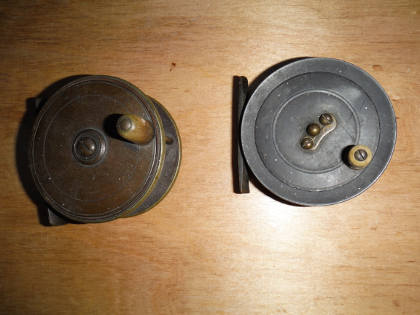
Reels A - Early trout fly reels.
Historically a very large number of craftsmen tried their hand at making fishing reels. Just as in the early days of the car, motor cycle and aero industries before consolidation, hopeful entrepreneurs were much in evidence. Clock-makers, locksmiths and gunsmiths in particular had the right kind of light engineering skills. It's surprising how often designs were copied between craftsmen and despite patents being taken out, there seems to have been a remarkably free interchange of ideas. This was probably facilitated by early fishing tackle makers who tended to cluster together in a parochial way: London's Temple Bar, the Strand and Crooked Lane, but other clusters existed later in Nottingham, Sheffield, Redditch and Perth. The same cluster pattern still exists in Asia where shops selling the same items gather in one street. If you want to buy a tyre for your car, go to the Street of the Tyre Sellers. It suits everybody. Retailers can borrow stock and assist each other; customers know exactly where to go and can easily compare prices. The British tackle trade also had a long tradition of one group of people making reels for other people to sell, something which led naturally to the globalised pattern of today.
Both of the reels shown here are small arbour click check reels which would have held a very modest amount of line and backing. They are of the plate wind type which generally supplanted the earlier crank wind design. The handles are horn and ivory. The one on the left is a Wilkes Osprey and the fact that it is made of brass probably dates it to the end of the Victorian era. You could use it today, although it is on the heavy side. Of course it would originally have been paired with a wooden rod weighing 6 ounces or more. On the right is an early alloy reel bearing the name of the gun-maker Westley Richards, a firm which is still in business. The telephone-shaped latch retaining the spool and more importantly the letter D stamped inside the case indicates that it was actually made by Walter Dingley, a craftsman who manufactured reels for various retailers. It was probably made during the 1920s. Rather sadly, the spindle bush is badly worn.
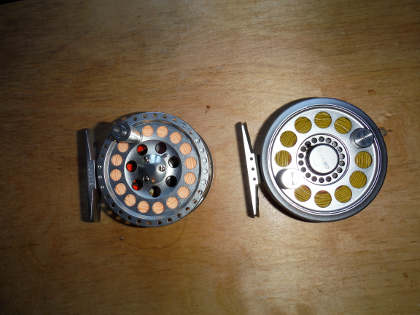
Reels B - Modern trout reels for small streams.
These two aluminium click check reels are very much the modern equivalent of the pair above. The one on the left is a Hardy Angel (Featherweight size) and that on the right a Greys Streamlite 3/4. They are both in fact mid-arbour reels, but again with a very limited capacity, each holding a double taper 3 floating line and a very few yards of backing, which is more than adequate for their intended use. Like the first two reels, they are fitted with pawl and spring click check mechanisms. However, the Streamlite was originally supplied with a pawl and toothed wheel made of carbon fibre which wore out rapidly. Hardy-Greys took the reel back and without charge replaced these with hardened steel components which have been quite satisfactory.
Most importantly, they both weigh about 3 ounces which makes each of them a perfect match for a 7 foot carbon brook rod.
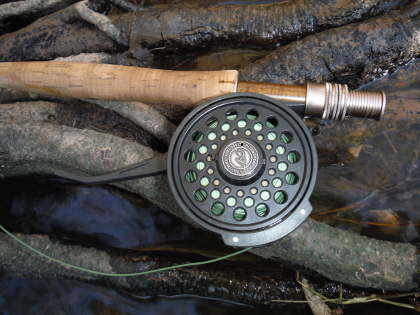
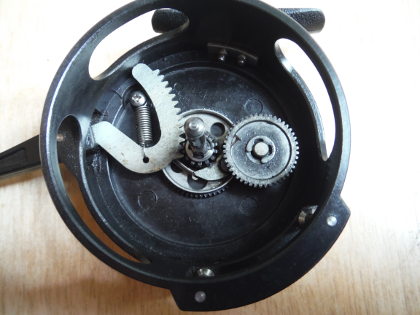
Reels C – Lightweight semi-automatic trout reel by Vivarelli.
Reels C1 – Mechanism of the Vivarelli reel.
This innovative Italian reel, built in Bologna, is much more common on the continent than in the UK. It is loaded with a 4 weight double tapered floater line with about 50 yards of backing and takes a radically different approach to trout reel design. There is no winding handle on the spool which has a blank face. To lengthen line you simply pull line off the spool against a built-in clutch with a pre-set tension. To pick up loose line you squeeze the handle, the gearing results in the spool spinning wildly and a surprising amount of line comes flying back into place. The housing and spool are made of carbon and although the gearing looks complicated, it needs little attention beyond a drop of oil now and then. The clutch mechanism built into the spool seems to be the weak point. You adjust it with an Allen key through a hole in the spool front. If the clutch is left too slack, obviously it will slip when the lever is pulled rather than pick up line. If the adjustment is over-tight, a big fish taking off at speed can easily put the tippet at risk. In fact I found it quite difficult to get the adjustment right and there seems to be a moment of inertia when the clutch is first asked to yield line - again, dangerous for the tippet and the hook-hold. For this reason I gave up using it on the Usk where large brown trout may be encountered. On the other hand, it weighs only a useful 3 ounces and might well make a good match for a brook rod. I still have plenty of uses for it. I see the Swiss company Peaux is now selling a semi-automatic reel of very similar design and they claim the adjustable drag on this one is excellent: "Very easy to use, it will avoid you to break the leader during complicated situation." I'm all for that, because I always get nervous during complicated situation.
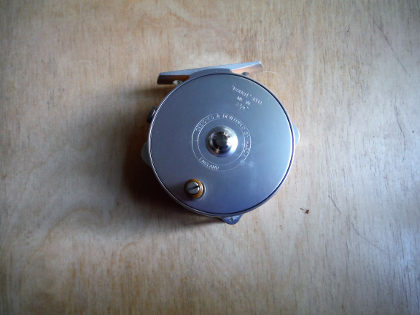
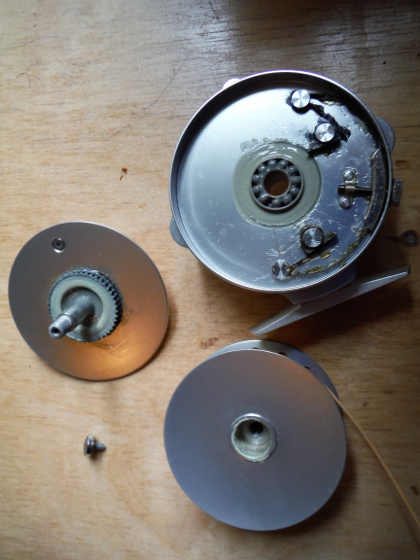
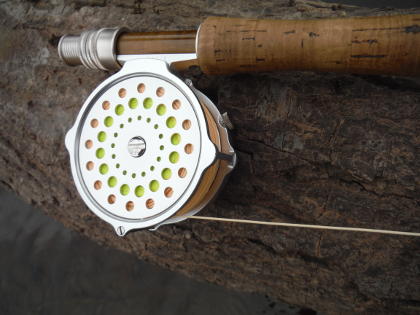
Reels D – Classic Hardy Bougle trout reel.
Reels D1 – Hardy Bougle dismantled.
Reels D2 – Reverse of Bougle showing cage and back of spool.
The Bougle is indeed a classic, launched in 1903 and still in production today. Monsieur Bougle was a French casting champion, interested in a light weight version of the already famous Model Perfect design. The Hardy Company obliged him and produced a reel which, apart from impeccable engineering, has a curiously stream-lined art nouveau appearance to it. I'm reminded of a Bugatti racing car, combining artistic design and function - yes, really! We are used to most modern reels being in two pieces, but the Bougle and Model Perfect family of reels all come in three pieces: the main cage in the middle attaches with its saddle to the rod and holds everything together and then the spool and winding plate come in from either side and screw into each other. The check mechanism is hidden away in a chest - one or other pawl is engaged, depending on which side is being wound, and the second pawl can act as a spare. Note also that in this case the mechanism has been over-lubricated and a clean-up is due! The Bougle has a rolling pillar line guard to save weight, while Model Perfects were famous for their heavier ring and agate line guards. In this case all the pillars are raised, only possible with a full cage design, and this permits more line to be stored on the drum. Whoever designed the check mechanism did a wonderful job. There is no moment of inertia, no jolt when the spool begins to run and thus the tippet is perfectly protected. The noise the reel makes is quite delightful to my mind and certainly unlike anything else. My belief is that the hollow chest reverberates when the check is working and also that the pitch alters slightly according to the amount of line remaining on the spool - the Stradivarius of fishing reels! The clearances are very close on the Bougle; you would not wish to get sand anywhere near it and I certainly would not wish to take it apart on the river bank. A white sheet of paper on a well-lit table makes a better working area. This 3 1/4 inch version has about 50 yards of backing and a 4 weight line squeezed into the spool. If I could change anything about it, I would still like it to weigh about an ounce less. Weight is today a slight and inherent problem with this design, and would definitely be more so with the Model Perfect variant. When they were first produced, of course, they were to be married with heavier wooden rods. This particular one was made in South Korea, which certainly allowed me to buy it at a better price. I can't fault the construction, but some customers complained and production is now back in Alnwick. For all that and in a spirit of pure self-indulgence I dearly love using my Bougle, which is normally twinned with a 9 foot 4 weight rod for dry fly fishing. Long may it sing!
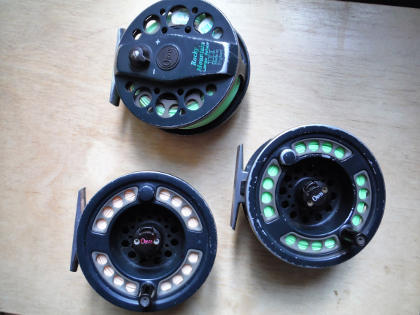
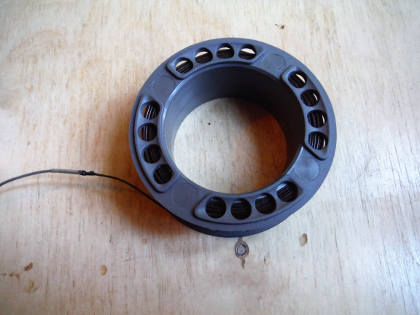
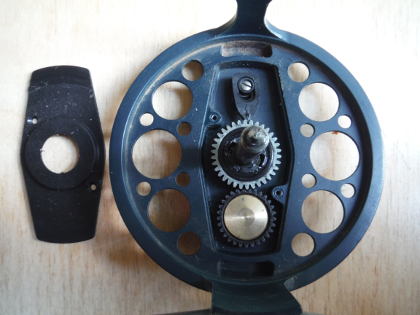
Reels E – Orvis Rocky Mountain cassette reels.
Reels E1 – Rocky Mountain cassette.
Reels E2 – Rocky Mountain stripped for cleaning.
The first thing to say about these reels is that, while the Orvis Company marketed them, they were actually made in Cornwall by a firm called BFR or British Fly Reels. In fact a good deal of badge engineering was going on at this time in the old reel making tradition, with BFR making slight cosmetic adjustments to a basically excellent design, so that several other firms could sell them under their own brand name. It really was a super design, produced I think in two different sizes by altering the width of the arbour. The 5/6 versions shown here are logically enough intended for 5 and 6 weight lines. As far as I was concerned it ticked all the boxes for rainbow trout fishing and, as you can see, I ended up buying three of them for about 50 pounds each, which was very good value at the time. The weight, at around 6 ounces, gives reasonable balance for a 9 or 10 foot 6 weight rod. Arbours are large at 3.75 inches, but the capacity is also good, taking the stated lines and a good 50 yards of backing. The cassette idea, relatively new at the time, was also very welcome because one often wants a big choice of lines for rainbow trout fishing. Although I rarely use it, there is a relatively light offset drag built in, which does not seem to be affected by water. The spool does not spin over freely and I really appreciate the provision of a good loud click check when line is leaving the reel. I even like the olive green paint colour, as opposed to the flash of polished alloy from so many reels. I have had a huge amount of work from these reels and they are all still going strong. Personally I play most rainbows from the hand, in other words controlling the line with my non-rod hand and recovering by pulling it down into a stripping basket. But if a good one goes rushing off and uses up all the loose line, I play it on the reel from that point, palming the rim. These reels manage it all very nicely.
However, there is a sad end to the story. Orvis took over BFR and fairly quickly moved production to China, thus ending jobs in Falmouth. The market was generally not pleased with the Chinese version and the design is no longer in production today. In fact it is very difficult to get hold of spare cassettes.
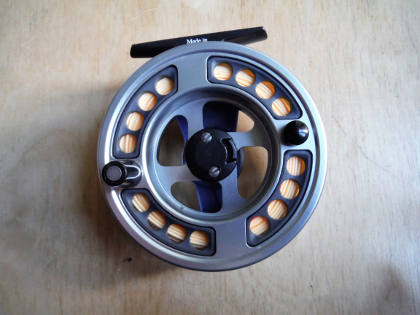
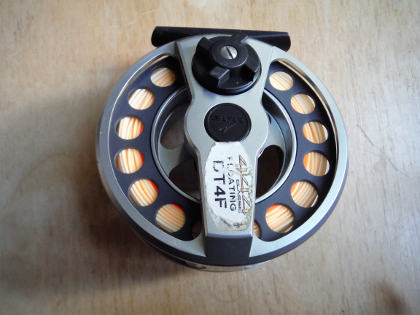
Reels F – Far-east built BFR reel.
Reels F1 – Far-east built BFR reel, reverse.
This is the Chinese version of the same design, again with cassettes, but a slightly smaller size to those above. I have it loaded with a double taper 4 weight line and find it is about the right weight to match with a 10 foot rod for fishing a team of spiders. Personally, I have no complaint against the Chinese manufacturing standards but it does seem a pity that this design cannot be produced again.
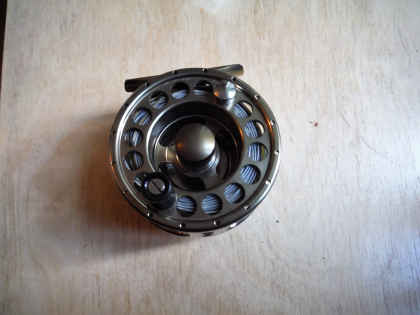
Reels G – Airflo T7 3/4 trout reel.
This is a cute little reel, a present from Rob Evans a few years ago. I don't believe it is still in production. As usual there is a disc drag and also a plunger-type check mechanism. It is relatively heavy for a small reel but quite compact, and in fact it balances very nicely with a 10 foot 3 weight rod. I have it loaded with a 3 weight line which rarely sees the light of day because attached to that is a very long (12 metres) French leader. There was a famous occasion when I was experimenting with spiders on the 3 weight rod; a large salmon picked up one of the spiders, panicked and set off downstream at a rate of knots. For a time the little reel, doubtless much stressed, emitted a high pitched whine such as I have not heard from it before or since. The reel survived, as did I, but the salmon got off.
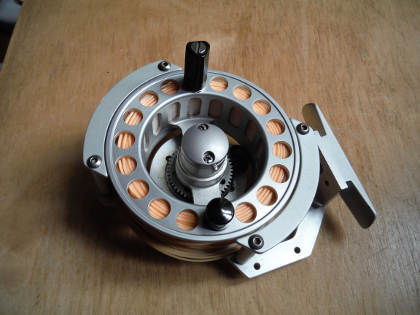
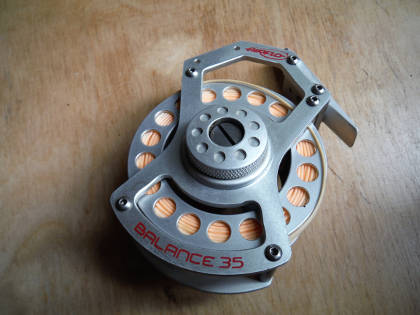
Reels H – Airflo Balance trout reel.
Reels H1 – Airflo Balance reel, reverse.
It's an unusual design, isn't it? I think, as best I can remember, that I purchased this one mainly out of jealousy. Lyn Davies had bought himself one of those interesting designer Ari t'Hart reels and, not wishing to be left out, I wanted to have something minimalist to show off as well. So in a spirit of rivalry I bought this. The idea of the extended arm is to move the reel weight forward in front of the hand. I seem to remember the blurb told me this would somehow make my casting easier or more effective, but I cannot claim to have noticed much difference. There is the usual centrally placed drag, a one-way clutch and a plunger type clicker involving a tiny coil spring which I have had to mend a few times. The real problem with it is that the cut away frame which makes it looks so interesting results in the line becoming jammed round the back of the spool all too easily. That's the very reason why other frames aren't cut away. I have a 5 weight line on it and use it occasionally for nymphing, but not often.
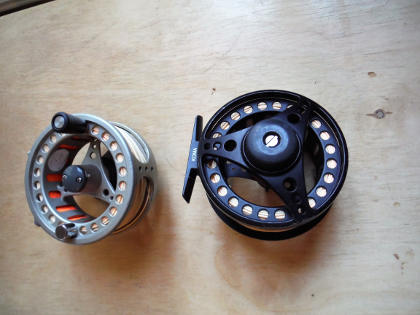
Reels I – Vision Koma trout reels.
These reasonably priced general purpose trout reels from Finland were in production for a long time. You could get them in silver-grey or black, as seen here. The arbour is large, but without a huge space for line lay (a shallow spool) and you will note that capacity is made up by making the arbour also wide. It is therefore necessary to be careful to spread the line lay from side to side across the spool, left and right, as you reel in. These are loaded with 4 weight lines and around 50 yards of backing. I once played an accidental salmon of 17 or 18 pounds to the net with the silver one. There is the usual central drag and a reasonably reliable plunger type clicker, which is nevertheless difficult to hear. At 5 ounces they are slightly heavy, but overall not bad value.
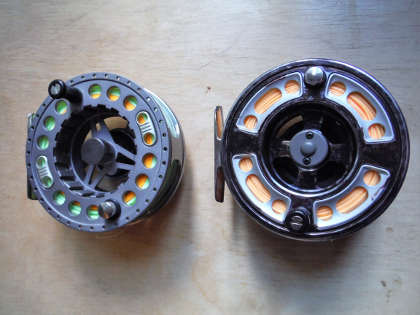
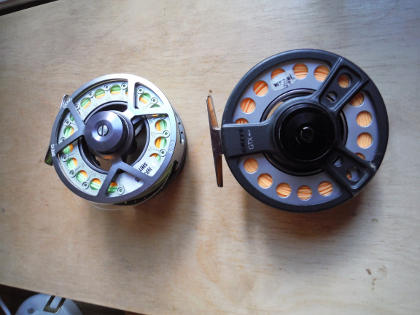
Reels J – Two Greys reels used for sea trout fishing at night.
Reels J1 – Sea trout reels, reverse.
We have now reached the reels for 7 weight lines. Both of these weigh around 7 ounces and provide a reasonable balance for a 10 foot 7 or 8 weight singlehanded rod. On the right is the Greys GTX, a reel which more or less satisfied me for many years. It has a cassette system; again a good idea as a variety of lines are often used for sea trout. The capacity is good and it will easily hold a floating 7 weight line and 100 yards of backing. When a sewin goes off in a sudden rush, it can sometimes really go and I start to worry about having enough backing, particularly on the open Towy. It has a very quiet click check on outgoing line, better than none, and a central drag which does seem to be reliable and waterproof. In the case of a strong sea trout in darkness, things can become very chaotic very quickly. I therefore get any slack line onto the reel (or out through the rings if the fish so decides) as soon as possible and rely on the drag and the exposed rim thereafter. Black magic marker pen, by the way, is periodically applied to dull the shiny reel face and prevent undue flash at night.
The reel on the left is a Greys GX 700, 6/7/8 size, the replacement for the GTX model and normally used on the second sewin rod. On the plus side, it still has the cassette system. I care not at all for the fiddly system of plastic markers for identifying lines (in any case the line makers always supply a little label which you can stick on the back of the cassette). I like the dull grey colour for use at night. There is a quiet check working in both directions, although unfortunately not a metal pawl and wheel system. At night, when hearing is heightened, I can hear it purring away all right. The drag seems to be reliable and reasonably waterproof, while the rim is accessible. On the minus side, notice that the outer diameter is slightly less than the old GTX. Also, the inner surface of the spool is larger, leaving more space around he spindle. As a result the line carrying capacity is less and I can't get 100 yards of backing onto the GX700. By comparison, the GTX now looks more like a mid-arbour reel. Both these reels, incidentally, are suitable for low water salmon fishing with 10 foot single handed rods and I sometimes use the GX700 with an 11 foot switch rod, which it balances nicely.
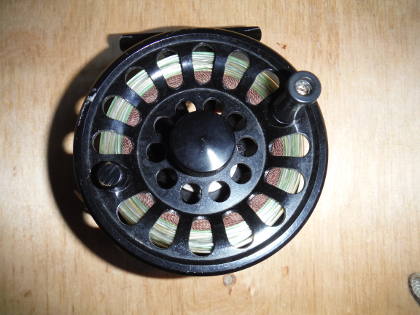
Reels K – A bad choice.
This one is so bad, that I am embarrassed to name it. The makers apparently intended it for sea trout fishing (it's black) and it arrived free of charge with a sea trout fishing rod. It is in fact the very last reel with which I would wish to be connected to a big angry sewin in the middle of the night. There is no click check; the reel is completely free running and sometimes spins without warning because of the unreliability of the one-way clutch. The drag is also vulnerable to water ingress and can vary between aquaplaning and lock-up. I keep an intermediate 6 weight fly line on it and occasionally use it for rainbow trout, playing them on the hand rather than on the reel.
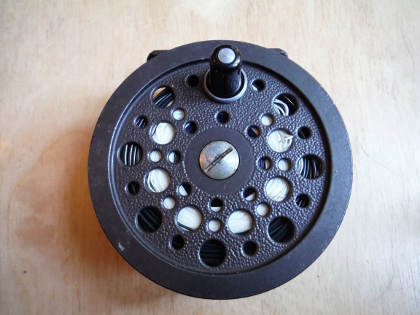
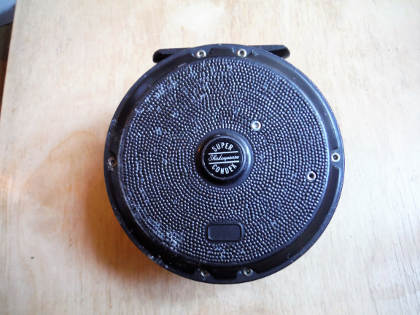
Reels L – Youngs Condex salmon reel.
Reels L1 – Youngs Condex salmon reel, reverse.
All salmon reels used to be like this. It's a strong, simple and reliable design with a full cage, an exposed rim and a permanently engaged metal pawl type click check working in both directions. The arbour is small, so an enormous amount of backing is needed to fill it up - no worries about the capacity of this one, even with a long Spey line fitted. Once loaded it is relatively heavy, giving 12 or 13 ounces, which is not really a problem with a 15 foot double-hander and a deliberate casting movement. I used to fish it with an old Bruce and Walker rod and it is currently loaded with a Wetcel 2 type full sinking line - rarely used these days. Probably the most important thing about it is the click check, which is quite loud and carefully judged in strength so that the most powerful current dragging on the line will not turn the reel - but a taking salmon will. Note there is no drag system apart from the click check and hand pressure on the rim. The great salmon of yore were all fought with reels of this type and some modern anglers are still quite content to rely on similar uncomplicated reels. This particular one probably dates from the early sixties. The Shakespeare Company have their logo on the front, but it was in fact manufactured for them by Young's of Redditch. JW Young, who are still going in a small way, and have a very long tradition of building all kinds of reels, both for their own direct marketing and for other firms. For a long time all the individual model names for Young's reels used to end in the letter "ex", hence Condex. (This wasn't unique to Young's; Hardy and Allcock also used similar series of names, such as the Altex). I once needed a new pawl for this reel, but Mill Tackle of Redditch were able to supply one. More about Young's reels later.
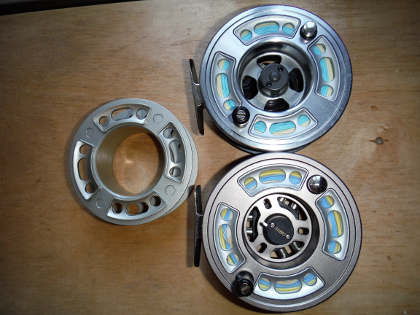
Reels M – Two versions of the Greys GTX cassette reel, salmon size.
Here is something more modern for salmon fishing and two reels which kept me content for a number of years. This is a larger version of the GTX already described for sea trout, so most of the comments already made apply. Both can hold 100 yards of backing plus almost any kind of line. Apart from the reasonable price, the cassette system was quite attractive to me as I then used a number of different salmon lines. However, times have changed since shooting heads came into such great popularity and most salmon anglers, myself included, tend to have backing and shooting line permanently mounted on a single reel and when a change is made it's a matter of fitting a different shooting head or tip. These are all kept in pocket wallets. There is therefore no need now to have lots of different reels, spare spools and cassettes. The use of shooting heads in particular brought in a new requirement for reels: that they should not tend to tangle shooting lines held at the bottom of the rod during the casting and shooting process. The Greys reels scored about 8 out of 10 in this respect. I do have a slight complaint about the later, pillared version of the GTX shown at the bottom of the picture. Water ingress to the drag is an occasional problem resulting in aquaplaning, while the earlier version seemed to be proof against this. Salmon fishing does require deep wading at times, so this is not an insignificant fault.
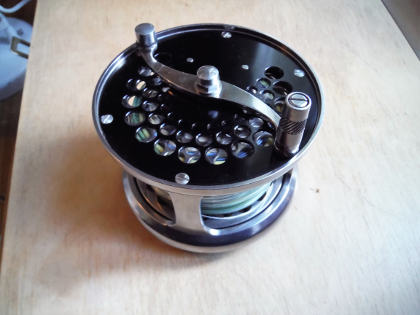
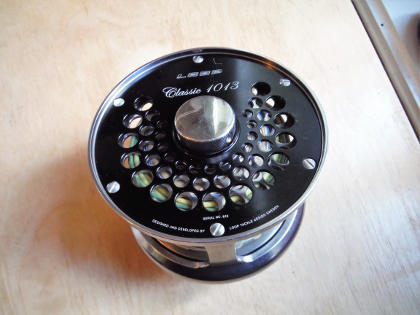
Reels N – Loop Classic salmon fly reel.
Reels N1 – Loop Classic salmon fly reel, reverse.
All right, this was pure self-indulgence. There is nothing as ridiculous as a self-indulgent salmon angler spoiling himself with tackle. I know it too, but that's just the way it is. Soon after this arrived I showed it off to Rob Evans, who took no interest in the reel but wanted nothing more than to breathe deeply from the interior of the leather case in which it arrived. "Like sitting in a Bentley," he muttered to himself. Like so many before me, I had decided to buy myself a really nice salmon reel and had spent some time over the choice. I wanted a well-made reel which would hold plenty of backing and shooting heads without any worry about capacity. I wanted it designed in such a way that shooting line would rarely tangle on it. I wanted a bullet-proof sealed drag without any maintenance requirement. With winding speeds in mind, I wanted a decent spool diameter - say 4 inches minimum on the outside rim. I definitely wanted a strong audible click check working in both directions. And I had recently come to the conclusion, despite moving to shooting head casting using short rod strokes made with the lower hand, that I liked quite a heavy reel which seemed to add deliberation to my movements. I had a big choice of reels to look at, but all the American ones with cork drags were quickly ruled out. Hardy was then making a new version of the Fortuna and the availability of the famous Hardy service facility was certainly attractive. However the Fortuna had no proper click check. The Lamson ARX reel is a beautifully made thing, deliberately made to avoid tangling line, with a full cage for strength, but a section machined away for hand palming. Unfortunately no click check and the Lamson is on the light side. I finally settled for the Loop Classic, but not because of the glossy black sides and S-shaped winding handle, both deliberately reminiscent of the vintage Hardy Cascapedia design. This is an old-fashioned crank wind design and the black side plates are both secured to the cage. What really swung it for me in the showroom was a pronounced check sound, more of a cackle than a buzz (the handbook translates the Swedish word for the pawl as "claw," which seems quite appropriate). The check is permanently applied in both directions. There is no routine maintenance required on the Loop, which has a strong drag, a fairly streamlined design to avoid line tangling and a huge line capacity - I think when it came to it I loaded about 300 yards of backing on to fill it, which is a ridiculous amount. Anyway, I suppose I can stop worrying on that score. At 12.7 ounces it is on the heavy side, which really does suit me when used with a 15 foot rod. And I do like fishing with the Loop, although for a while after I bought it I did wonder if I had made a mistake. I usually fish "off the reel," by which I mean that when a salmon takes it gets a yard or two of line off the reel while it turns with the fly in its mouth and while the check buzzes in warning. Only then do I clamp down on the line and lift the rod into the fish until I feel it. This technique seems to work most of the time but in those first months with the new reel I had a number of salmon which pulled line off the reel but failed to stick. Could it be that the loud check mechanism was too stiff and that salmon were letting go when they felt the resistance? I stopped worrying when the run of bad luck mysteriously ended and I then had a run of fish which took hard and did stick. I decided it had just been one of those things and nothing to do with the reel. Incidentally, even on hefty fish I haven't yet found the need to apply much reel drag with the Loop. The click check alone applies plenty, aided with some hand pressure from me on the line pack through the back of the reel.
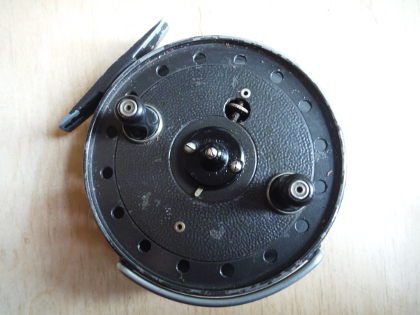
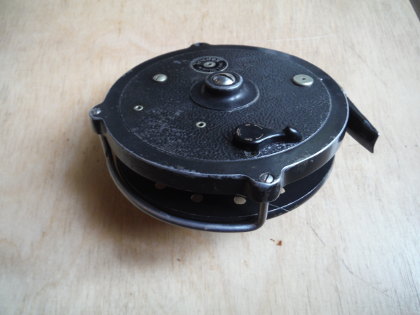
Reels O – Young's Trudex trotting reel.
Reels O1 – Young's Trudex trotting reel, reverse.
Centre pin trotting reels aren't fly reels of course, but they are much used for grayling during the winter so I thought I might include them. While the trout fly fishing angler might claim that his reel is no more than a reservoir for line, the grayling trotting man will rightly assert that in his case a good reel is much more important than a good rod. I do love this particular 4 inch reel for which I swapped a multiplier many years ago. It seemed an expensive deal at the time for a second hand reel, but over the years I have learned to appreciate what I have got. It must have been made about the same time I was (beginning of the fifties) but as a kid I didn't see centre pins around much on the bank, except very occasionally in the hands of older anglers. What schoolboys wanted then was a fixed spool reel known as the Intrepid Regent and I think we all got one sooner or later. Later centre pins came back into fashion. You can trot a float with a fixed spool reel of course, but once you have learned the technique, a centre pin is more efficient and more fun. The basic requirements for a good "pin" are firstly a decent diameter - 4 inches is good, 4.5 inches better and you do see 5 inch models (a match version of the Trudex, enlarged to a huge 5.5 inches, was being sold by Young's in the middle sixties). This is because much of the day will be spent rewinding the float back to begin another trot downstream. It should run very freely indeed with no play in the bearing. Near perfect balance should result in the reel running literally for a couple of minutes after being flicked. Most models, including this Trudex, have a very fine drag adjustment bearing on the spindle so that if needed the float can be continually held back very slightly against the current. For obvious reasons the reel should not be too heavy. I would advise a line guard to avoid tangles and the Trudex has a simple one fitted as standard. However, some who like to "Wallis cast" by swinging the rod and setting the spool spinning as the float flies across the river before a new trot, would prefer to remove the line guard altogether. Some even like to remove the handles and recover line by batting the rim. I will mention that the Trudex, although it is very well balanced, has a relatively heavy spool compared to some other pins. This gives a flywheel effect which definitely aids Wallis casting. For other thoughts on trotting with a centre pin, see the letter for November 2014.
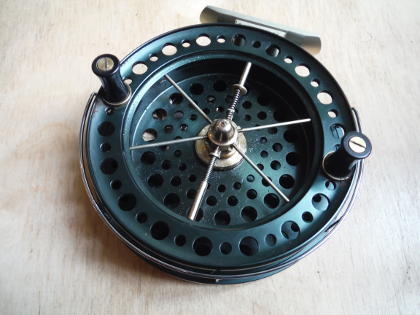
Reels P – Young’s Purist (John Wilson edition) trotting reel.
Here is a Young's float fishing centre pin reel to bring the story up to date (I think this one was made in 2003). A 4.5 inch reel this time, with a very lightweight spool. In fact the design has a long history. I understand the first Mr Young was involved with Allcocks and their famous early 20th century Aerial design in which the outer half of the spool is formed by spokes connecting the rim to the hub. This is very like a wire wheel on a bicycle, motor cycle or old-fashioned sports car and the rim is finally trued to the hub by adjusting spoke tension. When Mr Young left Allcocks, he brought the idea with him. You will note that two of the spokes have springs mounted on them. One is a spring loaded latch for taking the spool off the pin. The other is a spring loaded plunger which can be adjusted to give a very slight drag against the pin in order to hold the float back. All good centre pin reels need treating with care when fishing as the clearances are machined very close in order to keep errant line from finding its way inside and tangling in the mechanism. With only a couple of thousands of an inch to spare between spool and backing plate, a grain of sand will make itself heard. Apart from keeping the reel scrupulously clean, the only maintenance involves a drop of light oil on each bearing before use. Short of allowing grit to get inside or dropping the reel on a hard surface, these reels should last indefinitely, although the Trudex is the more rugged of the two.
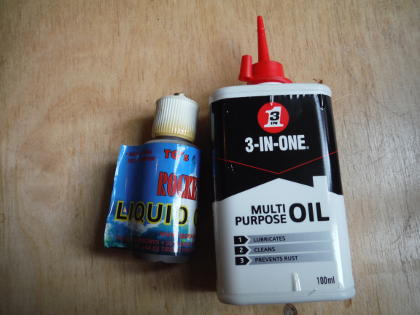
Reel lubricants
Surprisingly, not all tackle shops stock suitable lubricants. The main thing to remember is that very light lubricants are needed and they can be applied sparingly. General purpose 3 in 1 oil, to be found in every ironmongers, is light enough for reel bearings, as is sewing machine oil. Grease should be so light as to be very nearly liquid. Gunsmiths usually carry suitable light grease intended for the bolts and actions of fire arms.
One final point about fly reels before finishing: pay attention to line lay. Alternate loose and tight coils allowed to accumulate on a spool are very dangerous and likely to result in sudden jams, as are accumulations of line allowed to bunch up on one side. When reeling in, get into the habit of using one finger of your rod holding hand to distribute to distribute the line under slight steady tension left to right on the drum, backwards and forwards. Laid down evenly it will come off the same way without any sudden jerks or checks. When in doubt, before fishing find some clean grass on which to strip off the whole line and then wind it back onto the reel carefully. This only takes a minute or two and you will certainly be glad you took the trouble if you find yourself attached to a large fish.
The other day I was with a client who as a boy had been introduced to fly fishing by his grandfather. The old man was long gone, but his grandson, after being distracted for a bit, just like the rest of us, by career, marriage and family, had not forgotten those early days and now thought he might get back to fly fishing. We had a day on the upper Wye, starting again with casting instruction. For the sake of interest he brought along the tackle which his grandfather had bequeathed to him. I opened up an old, well-worn Hardy rod bag handed to me and was hardly surprised to find a split cane Palakona inside, the handle with a dark patina from long use, but the rod well cared for and probably re-varnished many times. As you know, I'm not a great fan of cane rods, not for actually fishing with at least, but this one told a story of happy fishing days long past and was a lovely thing to look at. It betokened an owner who had taken his fishing seriously. I explained to my client that it would have been married with a silk line, upon which he said: "There's a reel too," and handed me another bag. As I opened the draw strings I had already half-guessed what I was going to find next, and suddenly there it was in my hands: a bronze coloured Hardy Model Perfect, really in very nice condition. I asked my client whether he knew what it was; he didn't. I told him to look after it because it was surely worth 400-500 pounds. It might be worth sending back to the Hardy service department, because there was a bit of play in the bearing. There was a time when almost every discerning angler would have had one of these, but many have been passed down to people who have no idea what they have been lucky enough to receive. That's the third time I have had the pleasure of telling somebody who has shown me an old Model Perfect, long kept in the family, that they have not inherited a piece of obsolete angling junk, of historic interest only, but a wonderful example of engineering design, quite valuable, still usable for fishing, and in fact still in production today.
Incidentally, if you are interested in the history of fly reels, or are even thinking of collecting antique reels, the two volumes of Phil Waller's Fishing Reels: Collecting for All make an inexpensive guide for a start.
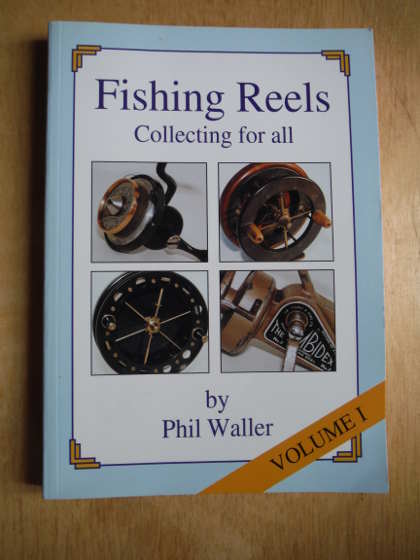
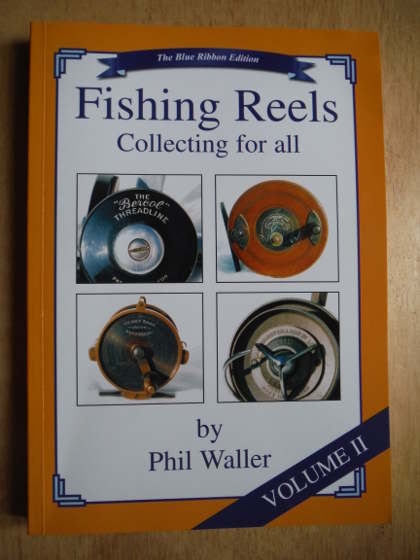
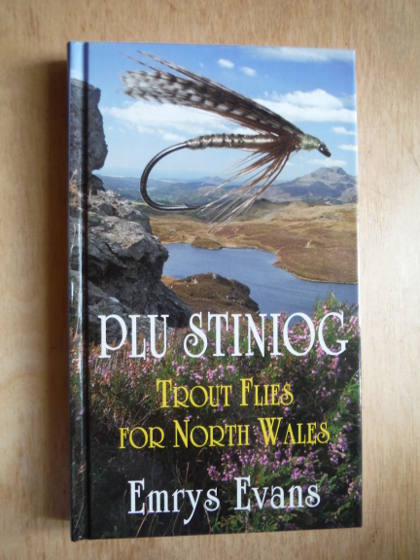
For those who like the mountain lakes, Fly Fishing and Fly Tying in its September edition carries another article by Ceri Thomas, this time about the Blaenau Festiniog group of lakes in an area of North Wales once known for its slate quarries. These belong to the Cambrian Angling Association and tickets are available on the WUF Passport. It's a rather remote area known for its own local culture of fishing and fly patterns – see Plu Stiniog by Emrys Evans. There are many lakes to choose from and plenty of climbing to reach some of them, but Llyn Conlog, which is 2,000 feet above sea-level, seems to be the interesting one according to Ceri.
It has been a strange summer, but let's assume that the desert has been crossed and we will have a more normal autumn. As usual, I have made myself a list of places to go during September and October, and again as usual the priority will be grayling and dry fly fishing. If the weather is mild, we should see some hatches and rises. On fly selection, my best advice is that most of the natural flies around will be small and grey, so why not stock your fly box accordingly? Pale wateries will be with us for a while, as will the little, clumsy, willow flies which like to perch on my spectacles in a friendly way. I would suggest that grayling flies should be small, so size 16 and occasionally 18, and my suggested list of "grey" patterns would include the ever-useful and easily made Grey Duster, Grayling Steel Blue, Griffiths Gnat and maybe John Storey. Later in the year, as the weather cools and natural insect hatching reduces, you could supplement those with some flame tails like Red Tag, but still in a small size. Orange Otter might be useful as a "startler." By all means use something more modern if you prefer.
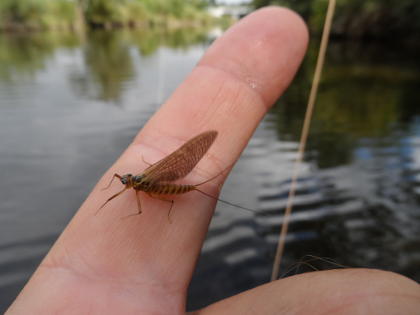
An exception to the general rule of "small and grey" and a fly which I usually accord a mention around this time, possibly relevant if you want to fish the upper Usk before it closes, is the autumn dun or August dun or more precisely Ecdyonurus disapar. I think this rather handsome insect more than any other has caused entomologists and angling writers to get their knickers thoroughly in a twist. No lesser historic authorities than Alfred Ronalds, Major Evans of Brecon, the Rev Powell and Courtney Williams all had a go at identifying it. A fly once known as the Whirling Blue Dun, on which the modern consensus is that the natural never actually existed (although the artificial was a darned good fish-taker), used to be confused with it. The autumn dun is not that common a creature, but it appears to be alive and well and living on the upper Usk above Brecon and some of the border streams further north. I believe I have seen it on the upper Lugg. Suffice it to write that during September you might see a big up-winged dun similar to a March brown, with striking chestnut coloured segments to the abdomen and evolving to an even more striking long-tailed spinner with a strong orange colour to the body. Given the time of year, this is almost certainly not a March brown, but an autumn dun. I can certainly vouch for seeing them at Fenni Fach; trout were taking them with enthusiasm and I caught several by digging out the first size 12 March Brown pattern I found in the fly box. What more do we anglers need to know? I would advise you to try the same.
Tight lines for September!
Oliver Burch www.wyevalleyflyfishing.com
July 2018
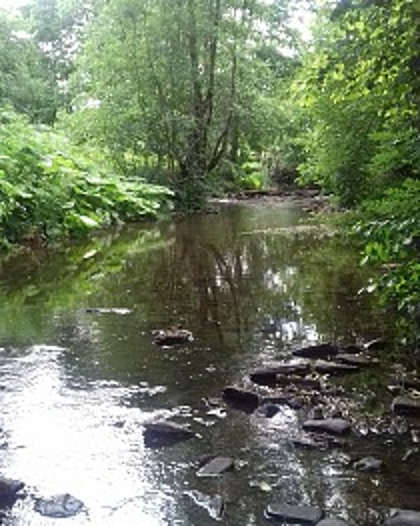
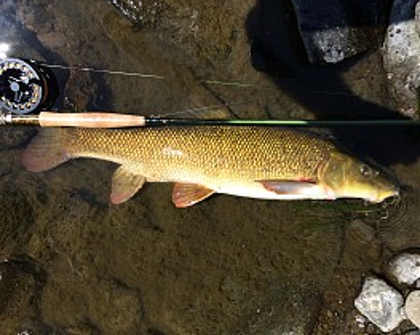
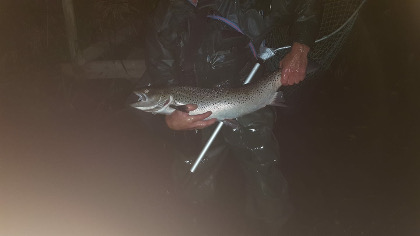
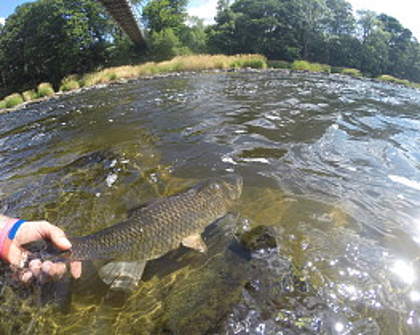
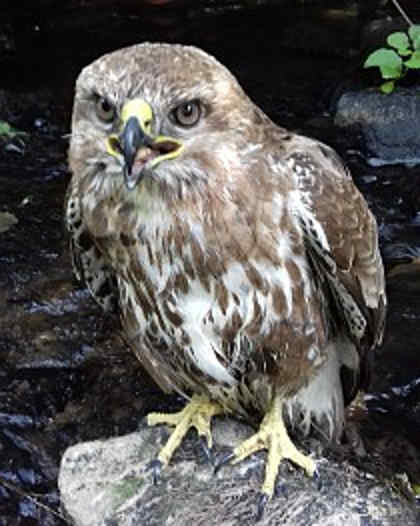
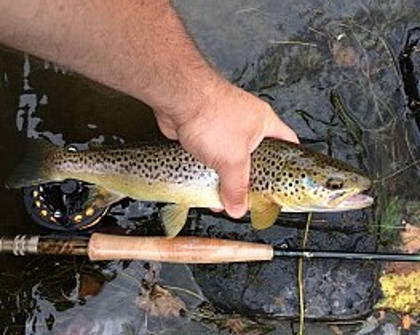
Everybody must be aware that we experienced another month of severe drought. A lack of rain in itself is not so unusual for July, but as this one followed on from a dry June, we were hit quite badly by both the lack of water and the steadily building heat. Salmon fishing more or less ground to a halt due to high temperatures recorded in the lower rivers. Sea trout fishing, with a very few exceptions (see below), was similarly affected. The grayling in the upper Wye did continue to co-operate to some extent and some of the shaded brooks provided sport, both on dry fly and nymphs. The Lugg and the Arrow both held up well this month. I am convinced the situation on the upper Wye would have been much worse without the cold water being released from the Elan Valley dams. It was of course incumbent on anybody practising catch and release to be very careful about fish recovery in high temperatures.
As usual at this time of year, there were some big catches of barbel being reported by the coarse fishermen on the lower river. Although this species is generally more tolerant of warm water than the salmonids, fish r ecovery was also a matter for concern when releasing barbel. A slightly less usual report came from game fisher SF of London, who, given the low water conditions, had a super day at Abernant on the 30th June. Despite the unlikely weather he caught 40 grayling and 15 trout, using both nymph and dry fly. The surprise catch of the day was a barbel, which I assume was taken on a nymph - see his photograph. A barbel on the nymph is certainly not unknown (I once caught one on a bug from a gutter at Pwll y Faedda and I believe Kim Tribe has done the same), but the experience is not exactly common. To the best of my knowledge, these bottom feeders have made their way up the Wye at least as far as Builth Wells. Barbel are a big, tough fish with a generally higher tolerance for warm water than salmonids, but about this time GJ from Merthyr Tydfil saw two dead ones floating in the lower river at Courtfield and reminded us of sensible catch and release procedures for hot weather conditions.
On the 1st July, RB from Redditch fished the Lugg at Dayhouse and took 8 trout and a grayling on a dry fly. Up in North Wales, RG from Telford had a good day on the Dee's Llangollen Maelor Angling water. This was by the golf course, so a relatively hard-fished piece of water as I remember it. He reported 20 trout, 6 grayling and also a small sea trout. SF from London fished the Wye again at Ty Newydd and reported 10 trout and 15 grayling with a long French leader, although the sport had faded by lunch-time. AF of Nailsworth had 10 trout and 2 grayling from Abernant with North Country spiders, while PJ of Hereford with a friend fished Doldowlod and between them caught 2 trout and 20 grayling.
About this time came a surprise from the middle Towy, which, affected badly as it is by algal growth (see last month's letter), has hardly been fished this season. On the night of the 2nd our friend Eifion Williams caught a 28 inch sewin from the river at Llandeilo - see the photo.
Despite the drought, the algae on the river bed and the very low water levels, it's clearly a fresh fish. For those interested in Bluett's theories on sea trout catches and phases of the moon (see last month's letter), this one took a Black and Gold tube fly on a very hot night with a gibbous moon, waning. Eifion emphasized that a lot of care was taken in returning this lovely fish. His son Lyn lost another good one during the same night. By this time we had a general consensus that salmon fishing on the Wye should stop because of extremely high water temperature. In the unlikely event that a salmon would take a lure, it would very likely be killed by the experience of being played in water which was measured at 23.5C in the lower river. At the beginning of the month I went out myself on the middle Towy and found the water clear and actually cooler than expected, if very low, and a few shoalies were certainly present in the pools, willing to take and full of bounce. On a warm night with an air temperature which never dipped below 15 degrees (and without any sign of dew), I caught a couple of about a pound each using a small aluminium tube fly and the Surface Lure. At dusk I had measured the water temperature at 18 degrees, which compares well with the over-heated Wye. Of course the Towy receives most of its water from the base of the Llyn Brianne dam, which is the reason for its permanent reputation as a cold river.
DP from Tewkesbury with a friend fishing Abernant on the 5th with dry flies and spiders reported 8 trout, 13 grayling and a chub. MN from Bristol fished Gromaine and Upper Llanstephan during an evening rise and got 4 trout, 1 grayling and chub of 3 and 3.5 pounds, all on the dry fly. JA from Leominster sent us an interesting photograph from the Arrow at Kington - a young buzzard perched on a stone by the water. That is certainly unusual behaviour for that particular bird. Normally it is a sparrow hawk we glimpse dashing up the channel where the tree canopy allows. Adult buzzards seem to have difficulty in soaring during very hot weather; maybe this youngster was just enjoying the cool shade by the stream? ME from Towcester with a friend had a good day at Lyepole on the 7th. The Lugg was low by now, but they caught 12 trout and 40 grayling, nearly all on nymphs. AM from Dorridge fished the upper Wye at Abernant on the 8th and caught 9 trout and 5 grayling. During his day he was accosted by somebody on the bank accusing him of poaching the Nyth and Tyrcelyn syndicate water (next beat below).
Just as problematic is the situation we often see with Wild Streams where we only have rights to one bank. With fishing in small streams, if the situation is to work to the mutual benefit of rights holders on either side, a bit of flexibility is required. It's rarely possible in practice for an angler to keep to one side only while working up, given the normal environment of deep holes, overhanging trees and steep banks. The worst case scenario seems to be when non-anglers have purchased a house and a garden which ends on a river bank, giving them an idyllic rural view into which, as far as they are concerned, no alien figure should ever intrude. At least the estate agent never warned them that such a thing might happen. We can indeed hold our ground and insist on the right we have purchased to fish up the opposite bank which they don't own, but in the case of argumentative owners who "only want to see themselves" it won't help the situation much. Personally, I can't think of anything more likely to spoil the pleasure of a fishing day than an argument about trespass and fishing rights. On the other hand, let's hear it for all those nice people we do meet as we fish past their riverside homes - for example exchanging "good afternoon and how are you?" with a family tea party on a lawn while passing up the Edw. I can remember fishing during a summer evening at Pwll y Faedda while a wedding party was in full swing on the terrace above, guests waving to us while a jazz band played in a white marquee.
The heat wave continued. On the 9th, RB from Redditch fished the Lugg at Dayhouse for 8 trout and 1 grayling. RF from London had 8 Usk trout on the dry fly at Glan y Cafn, fishing during the evening of the 11th. MN from Bristol fished at Gromaine on the 12th and reported a superb catch of 20 trout to 16 inches and 40 grayling to 15 inches taken with a French leader. Dave Collins from West Herefordshire was fishing upstream at the Builth town water and had 10 grayling and a trout with a small Hare's Ear Emerger. He measured the water temperature at 17 degrees, which markedly contrasted with the lower river which was 5 or even 6 degrees higher.
By the middle of the month, there had been just a few localised showers in the catchments, sometimes almost tropical in their brief intensity, but nothing to raise the water levels much. Water companies were asking for restraint on domestic water usage, just as the EA was warning about river water irrigation on licences designed for normal flow. The WUF and owners, wisely I think, now took a decision to suspend sales of game fishing tickets on the lower sections of both Wye and Usk due to the high water temperatures - I think nobody has been salmon fishing during July. Occasional cloudy days helped the situation a little for trout and grayling anglers. On the 14th HW from Swansea reported 15 grayling from 6-18 inches and 11 trout of good average size from Doldowlod on the upper Wye. On the 15th AM from Dorridge had one trout and a large catch of grayling from Lyepole using spiders. On the 17th SJ from Stoke had 2 trout and 7 grayling from Dolgau on nymphs. RW from Portishead, one of our regulars, tried out the Taff Fechan above the Aberglais Inn and took half a dozen trout to 9 inches. He reported the wading was very tough. On the 19th, AP from the Wirrall took 2 trout and 7 grayling from Lyepole, fishing during the morning. PB from Leominster found mainly chub to be feeding on the Wye at Llangoed and Lower Llanstephan. He took 7 of them along with a trout. On the 20th MN from Bristol had a good catch of 12 trout to 16 inches and 22 grayling, one of them a large one, from Doldowlod. A Black Foam Beetle was attractive on this occasion, he tells us (see below about beetles). This particular day included a couple of hours of rain during the late afternoon, but welcome as it was, this had virtually no effect on river levels. The following day SF from London had good fishing at Abernant with a French leader, taking 25 grayling and 15 trout. He followed this up by a day on Ty Newydd, taking 5 grayling and 15 trout this time. Also on the 22nd, SD from Aberdovey caught 11 trout from Llyn Bugeilyn. Lyepole came into the reports again on the 24th, when PB took 13 grayling to 13 inches, all on the dry fly. DM from Hereford had 6 trout and 15 grayling from Craig Llyn on the 25th, while AB from London had 8 small trout from Aberedw on French nymphs. Lyepole was fished again on the 26th, when AM from Dorridge had 16 trout and 6 grayling by different methods. RW from Portishead had a good day on the Hergest beat of the Edw, taking 26 trout to 11 inches on a small Parachute Adams. Lyepole was again the news on the 28th, when AP from Wirrall reported 2 trout and 12 grayling. This beat is often quite pressured compared to others on the Lugg and nearby Arrow, but seems to stand up to it well. Both otters and signal crayfish were in evidence on this occasion (as we know, one likes the other).
The 27th was anticipated to be the hottest day of the year and it certainly tried very hard to live up to the "phew what a scorcher" headlines of the media. However, during the 28th and 29th the hot weather drifted off towards the continent and we were treated to cool air temperatures and some intense showers of long-awaited rain. The question is: was it enough to improve our fishing? Writing now on the 31st, it appears that it was probably not enough to have much effect, most of the water having been absorbed by the thirsty ground, while no more rain is due and the air temperatures are predicted to heat up again. We aren't into August yet and there is still plenty of opportunity for mid-summer blues. During that last wet weekend of July, there was a rise of just a few inches on most of our rivers, a little more noticeable in the headwater streams, very dirty water in the Forest of Dean streams which I looked at, but the level quickly subsided again. NG from Dilwyn reported 6 trout and 2 grayling prospecting with dries at Dayhouse on the 29th while the Lugg was rising slightly. The largest increases in level, short-lived as they were, occurred on the Towy and Loughor to the west, where more rain seems to have fallen.
In the final week of the month, Welsh Water began a planned extra release from Usk Reservoir into the river. This was in no way intended for the benefit of anglers, but due to a need to expose part of the dam wall for repairs. The extra water released was not wasted by the water company, but taken up again at the Priory Mills pumping station for Llandegfedd Reservoir and Newport's supply. However, the River Usk was used as a conduit between the two and the cool water added at the top end must have added an inch or two to the levels and should improve the environment for river creatures for a while. At the end of July, Merthyr Tydfil Angling Association issued a very downbeat newsletter, pointing out that so far this has been the worse season since the association took on Usk fisheries in 1979. Just 2 salmon have been caught in what should have been ideal spring conditions, before the drought conditions arrived.
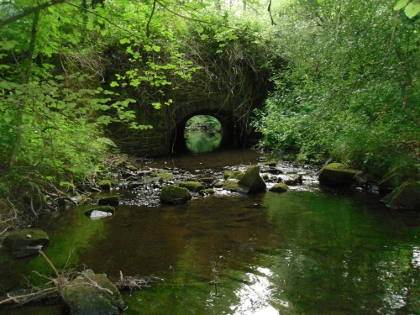
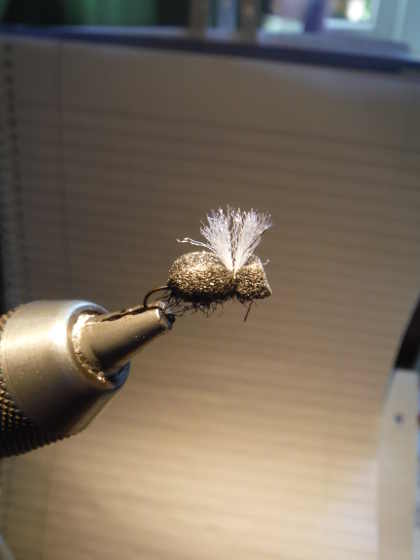
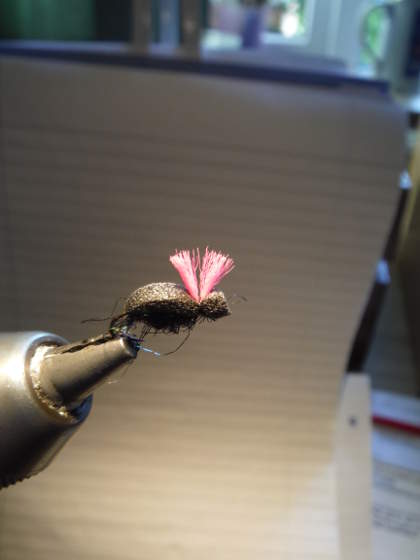
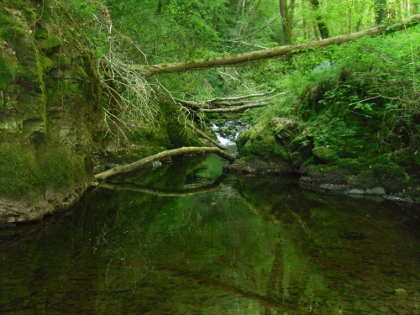
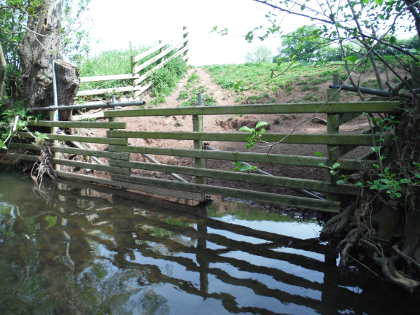
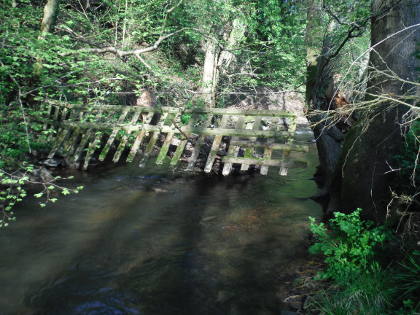
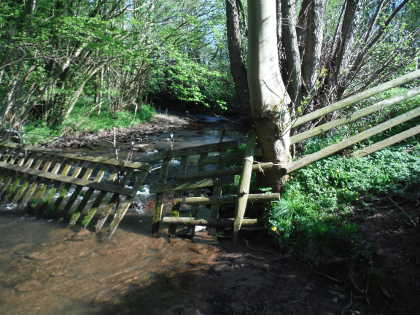
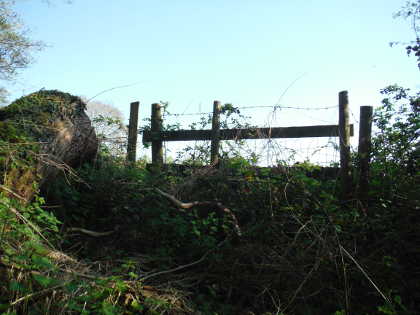
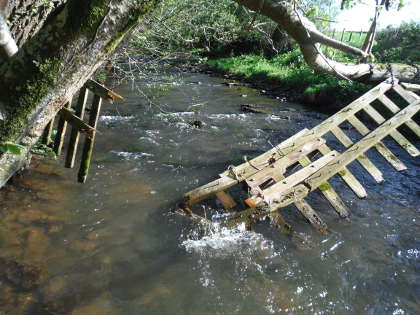
Trying to look on the bright side, there is no doubt that mid-summer is a good time for fishing the wild streams, shaded from the sun as most of them are by leafy trees. This was certainly the case during July. Trout do well out of the beetles and bugs which drop from trees at this time, particularly if there is any kind of breeze to shake the branches. On a breezy day I sometimes replace my usual olive-imitating dry fly patterns with a little Foam Beetle, tied on about a size 14 dry fly hook. These work better on the slow pools rather than in the streams. If your Beetle arrives on the surface with a little plop, all the better and you will sometimes see a trout whirl round to grab it. The pattern I use is simply made with black ethafoam strip pulled over a tangle of peacock Glister Sparkle Dubbing which gives that greenish beetle shine to the underside. There is a version known as the Kicking Beetle which has short rubber legs added, but I find the plain one seems to work as well or better. One problem with the pattern is that it floats very low in the surface and the resulting tiny hump of black ethafoam is difficult to see. For this reason, a sighter wing of white Antron fibres is added on the back of the fly, but even this can be difficult to spot in a dark shaded corner. Paul Proctor favours a sighter wing of bright pink on his beetles and in theory the fish can't see this while the angler can. In practice I think flies so adorned are taken rather less often, but it's difficult to prove. In any case, if you see a swirl or hear a splash out in the pool, your artificial beetle is probably the cause, whether you can see it or not, so make sure to tighten up.
At this time of year you may find yourself cursing a bit as you push your way through the undergrowth, even more so if biting midges or horse flies are around. However, please understand that it isn't practical to visit the streams monthly in order to trim short-term summer growth of creeping brambles and vines. Annual visits are what we hope for and most of the maintenance is necessarily going to be done in the winter. Wild streams are just that, not gardens, so if needed take along a wading stick to beat your way through. Instead of the two "North and South" teams used in previous years, we now have quite a number of individuals who have adopted brooks local to them and who have undertaken to keep up branch pruning maintenance on them. I am hoping this adoption system may turn out to be the best way forward, because in my experience, once a stream is in reasonably good fishing order, an annual pruning visit after the leaves are down and at least one winter flood has been through is by far the easiest way to keep it that way. By comparison with organising a big team, the flexibility of being able to pop down to your own local stream when you find you have a morning free is ideal.
Every time I write about this, I find myself emphasizing that our volunteers don't have power tools, so tree falls and major log jams are going to be left in place. Also, the more of this work I do, the less I feel inclined to cut away. It's all too easy to approach a stream with the idea of making conventional casting easy at all possible places. Beginners tend to take this approach and I have seen a number which have been "ideally" pruned from the casting point of view and which have produced a reduced number of trout as a result in the following seasons. Woody debris is perfect cover for baby trout, indeed fish of all ages, so plenty of it needs to be left along with the alder roots and overhanging branches which are fish havens. There is no reason to do any pruning over water which is too shallow to hold fish. Such sections will be left with untrimmed branches hanging low so that they can continue to deliver their freight of falling insects and other food to the stream below. Pleaching, which is rather like laying a hedge in the water by bending over and inter-weaving half-cut stems, is a good way to create cover in margins where it does not exist. Log jams, unless so solid as to block upstream migration, are not necessarily to be deplored and having some areas of fish refuge is almost essential if you want to see large fish in your water. A 1.5 mile stretch in which, say, one third is inaccessible to anglers due to deep holes and log-jams, might make for a really exciting mile of fishing, enough to keep you busy for a day.
At the same time, I believe that there are some things we and the landowners might be able to find a way to do better. When the WUF habitat teams visit a stream, they are normally funded to do so just once. The important tasks, for the health of the stream and the system, are likely to be fencing out livestock and possibly coppicing thick overhanging trees to let in more light, apart from more specialised work with gravel, modifying bank width, work on weirs etc. Without going further into the science, there seems to be a general agreement that unrestricted livestock access is bad for a stream. So the cattle and sheep are to be fenced out, but they also need at least one drinking point in each riverside field. This can be done where the banks aren't steep by allowing some triangular shaped projection of bars from the field into an area of shallows, so that they can at least get their heads to the water. But this is more difficult to arrange than might be imagined and tends to be vulnerable to floods and droughts. More common is a cattle drinking ford in which the animals can access the whole width of the river for a short distance, and which is defended by water gates above and below to keep them out of the rest of the channel. The water gates are mounted on a strong wire cable between opposite tree trunks. From eye bolts attached to the wire depend one or more heavy wooden gates, formed like open fencing and left free to swing in the current at the lower edge. The gates are mounted so that they angle downstream and just about touch the gravel at the bottom. Normally the current flows between the slats of the water gates. In the case of a powerful flood, the water gate will be swung up by the power of the flow and, theoretically at least, logs and debris should pass underneath. On a small stream there might be just one gate going right the way across; more typically there are two or even three.
So much for allowing livestock drinking access to just one small section of the stream. From the point of view of the angler making his way up the channel fishing as he goes, he will have two water gates to pass at every cattle drinking ford he comes too. It should be noted that on some of our beats bordered by numerous small fields - the Escley Brook for example - there are a very large number of gates to be passed. Angler's access has been allowed for in the design, because the fences on either side leading cattle down from the field to the ford area have a break in the barbed wire with a short wooden section, almost like a stile, which can be climbed over with ease. So the angler comes to the first gate, up the bank, over a wooden fence, a few yards of field (unless he wants to fish inside the ford), over another wooden fence, down the bank above the second gate and he's fishing on upstream again.
That is how it should work. In practice, things begin to change within a year or two of the system being set up and there are three things which tend to go wrong. Firstly, the stream bed and the banks in a small stream change with remarkable speed due to power of floods, and water gates in themselves tend to produce scouring forces. A steady sloping bank leading up to the wooden fence section can become an impassable cliff. Secondly, farmers, or farmers' fencing contractors, for some reason don't seem to be able to abide an area of stock fencing which is not topped off with barbed wire. Possibly there are problems with sheep hopping over the wooden sections (although I haven't seen it happen), but at some time after the water gate system is set up you can be almost certain to find a tight barbed wire strand along the top rail so that what was intended to be a stile can't be passed without extreme peril to your expensive waders. There are things which you can do, such as carry a length of split plastic pipe to put over barbed wire, but that is hardly convenient. If the stiles are wired off, the angler has no choice but somehow to go through the water gate or over the top of the main cable. This was never intended as a route, although a short gate which doesn't weigh too much can sometimes be swung backward so that the angler can wriggle through the gap. Usually the gate sections are too heavy. And sometimes it is possible to hang onto a tree trunk to get over the main cable attached to it and so pass over the gate. And then we come to the third problem which occurs, which is that heavy drift-wood fails to pass under the gates, a major log jam forms around a tree trunk or two, and eventually the power of water either breaks up the whole gate or leaves an impassable mess.
There are some other ideas for restricting the movement of cattle into stream channels from drinking places and a while ago I had a discussion with Louis at the WUF about these. One is to have a grid of parallel bars sunk into the bottom of the stream, just like those used on motor roads leading onto free-grazing land, so that hooved beasts are unable to pass. There would be a notice to warn wading anglers about the obstruction. This is apparently used in some American states, but it seems expensive and rather impractical to us. Another American idea is to have, not heavy wooden gates depending from the main wire cable, but a row of chains a few inches apart dangling down to water level - rather like those vertical plastic strips which used to be in café doorways, so that a waiter with a tray could duck through at speed but diners couldn't see into the kitchen. The idea is that livestock are dissuaded from pushing past, but anglers can part the chains and progress upstream. Well, according to Louis, this one has already been tried and it doesn't work. British livestock at least are intelligent or stubborn enough to just push against the chains and keep going. Also chain is expensive material and if large amounts are deployed in the countryside, there is a risk of theft. The WUF teams also experimented with the idea of making screens from hanging strips of thick rubber conveyor belt which blocked off the view beyond. The problem was the same; livestock just pushed through and kept going.
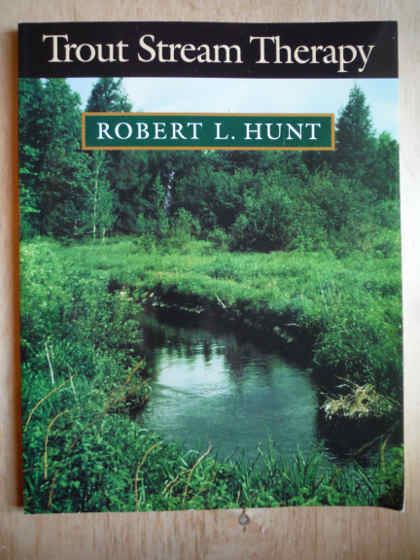
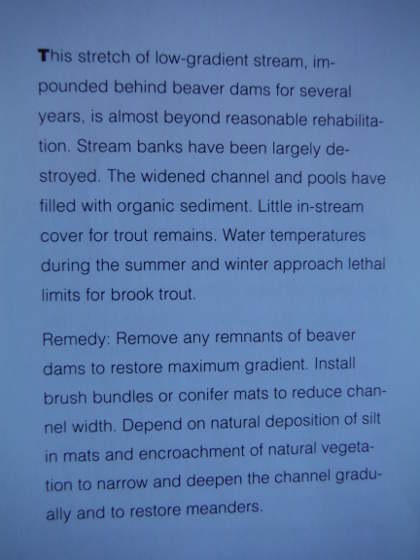
Louis' view is that we should look to farmers to do some regular maintenance once these drinking places have been created, such as clear log-jams from the gates and ensure that barbed wire across wooden fences is not used to block angler's side access. He admits that many are not very assiduous about this. In the case that the livestock concerned are cattle, it seems to me that, instead of heavy gates, a single strand of barbed wire at about waist height across the stream should be enough to keep them from wandering up or down the channel. My farmer friend Martin at Bideford Brook tends to use a single crossing strand of barbed wire to keep his cattle in order and it seems to work. Anglers can just pull the wire up and duck under as they move upstream. I accept that a single strand would not work for sheep, which, although not obviously bright in most ways, are certainly great escape artists. For short periods I once used to look after a property with sheep grazing on it. I was warned at the time: "A sheep's main aim in life is to die before you can get it to market, preferably in the most public place possible." That certainly turned out to be true. Once on its back, a sheep with a full wet fleece can't right itself again and dies surprisingly quickly. Given half a chance they get their necks stuck in fences and they constantly fall into deep water. Did you ever see a proper river flood without a drowned sheep floating downstream?
Failing any other plan - and I would love to hear if anybody has a good idea - I think we are likely to be left with trying to squeeze through or under the water gates as they are. It might be a big help if water gates are always made with one short and light wooden section about a yard wide, hanging from a pair of eye bolts at the side immediately next to the bank. Hopefully anglers would be able to lift this up and pass while the livestock would be dissuaded.
Meanwhile, for those (club members perhaps) in a position to make more drastic management changes of their own to a stream to improve the natural production of insects and fish, the Wild Trout Trust is usually the first port of call in this country for advice. Of the literature on the subject, Trout Stream Therapy by Robert L Hunt is one I found interesting. Coch y Bonddu books probably have a few copies left. Mr Hunt is a retired fisheries biologist from the Wisconsin Department of Natural Resources, and his short book is a very practical guide to modifying the flow of damaged streams and designing in-stream structure to promote the growth of trout and other fish. This is serious stuff with heavy machines moving boulders around, all-wheel drive trucks tipping riprap into strategically chosen locations and baulks of timber attached to the bed of the stream with huge screws driven in by power tools. Note what Mr Hunt has to say about the damage to fisheries created by beaver dams (see photograph and text). I am afraid this is something which we have to look forward to as beavers are reintroduced to the UK, albeit over the objections of anglers and land-owners. As far as Mr Hunt is concerned, if you have a good trout stream, keep beavers away from it. Generally, if the photographs are anything to go by, in the state of Wisconsin they certainly spend a lot of time and money on improving their trout streams. In fact I felt I wouldn't mind going to fish some of them.
Crisis? What crisis? It's fairly well established that the media will always work hard to make a drama out of a problem and to define anything more than a problem as a crisis. This year we have already had the Hysteria from Siberia, followed later by a couple of months of Drought. At the end of July, we had something called "Extreme Weather", by which journalists (and apparently railway operators) mean localised rain and thunder storms. The subject of the weather, in the UK at least, always provides good fodder for journalists to work on - when they run out of that material, I am sure they will be back to Brexit. Meanwhile, professor this and professor that, pundits all and keen to be heard, can be wheeled out to discuss the meteorological statistics on air. My own guess is that predictions of what the current weather portends will prove to be about as accurate as those financial predictions which the media also loves to bombard us with. How many of the much-interviewed financial pundits predicted the 2008 crash?
As the drought went on, the refrain changed to "Not since the summer of 1976..." We have certainly been hearing those particular words, referring to the last really major drought in this country, regularly enough from the news broadcasters lately. I have been experiencing definite feelings of déjà vu at times. The river full of bathers, the scent of smoke from brush fires on the hills, emergency services including fire engines dashing around: something seemed rather familiar about it all and in fact I can remember that 76 summer quite well. I had an old red Austin-Healey at the time and the hood stayed off it all summer. I accept that droughts are of course bad for nature, for fishing, for gardens, for agriculture, the water supply and the emergency services, but it wasn't all doom and gloom. We were young then, with a new family; in free hours after work we swam in lakes and sun-bathed on lake-side sand. My angling pal John and I went tench fishing, revelling in the brief coolness of dawn while watching the tips of quill floats. Then came a holiday on the north Cornish coast, which we reached in an even older Ford which burned an exhaust valve out on the way down. I had the head off the car and found a near-enough replacement valve from a marine engine in a boat chandlery in Padstow. This took up a whole day but with the tip ground down to fit, this makeshift valve eventually got us home at least. Meanwhile there was Constantine Bay to swim in and the little whitewashed restaurant across the road from the fish docks in Padstow (this was of course before Rick Stein's arrival) for a very reasonable price was offering a nice white house wine and whatever the boats had brought in - salmon peal, bass, lobster, and deep sea crayfish. The menu of the day used to be chalked on a blackboard by the door. I fished the River Camel without much success, and discovered the delights of wrasse fishing while clinging to steep rocks under Trevose Head. I was using John's beachcaster rod with a multiplier attached, baiting with hard back crabs we found in the estuary of the Camel. As expensive leads were constantly lost on the rocky ground, I weighted everything down with ordinary stones, tied into the leader with a "rotten link" of weak twine. A morning of fog with a calm sea barely visible and the light-house siren overhead booming was no good at all, but another day with a bit of a breeze onshore pushing waves against the rocks brought the wrasse onto the feed and they hit the bait hard.
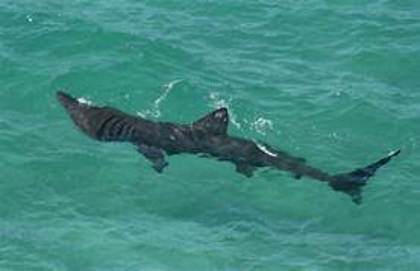
Best of all were the basking sharks, the monsters which had swum lazily up the Gulfstream in the heat. I see that they are back again this year. You could get a ride on a pleasure boat from Padstow to view them close up where they were cruising, just beyond the bar at the mouth of the estuary. I think this was where I learned you can estimate the length of a fish at the surface by the distance between the visible dorsal fin and (in this case) the very slowly waving tip of the tail as it made its steady strokes. The best view could be had by walking on the cliffs hundreds of feet above the sea, spotting the sharks from above. I used to do this at Trevose Head, watching the dark shapes, some of them 20 and 25 feet long, slowly undulating against a pale blue background as they rounded the point. I think it was the most exciting fish-spotting I have ever had!
Of course we must continue hoping for rain and plenty of it. As we have seen (I'm writing on the last day of July) the occasional thunder storm or heavy shower here and there is not enough. Our normally excellent autumn fishing is something to look forward to, but sport will not really improve until an extended flood flushes the rivers out. Meanwhile, my best advice is to look for tree-shaded water and the North Herefordshire streams might still be a good bet, or alternatively the mountain lakes. Until significant rain turns up, at least a cloudy day will be some help and a breeze to ruffle the surface of lakes is always a godsend. Tight lines!
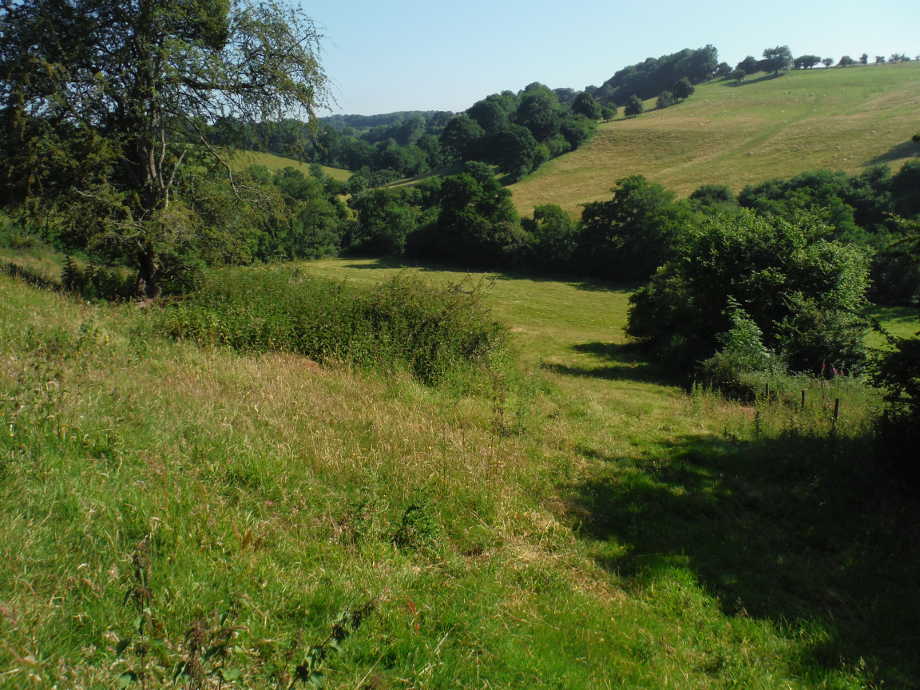
Oliver Burch www.wyevalleyflyfishing.com
June 2018
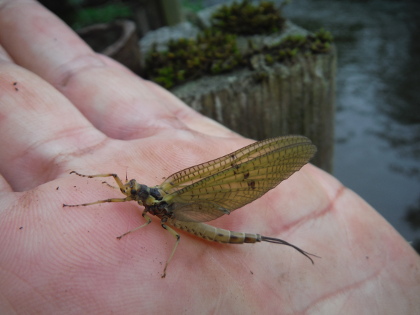
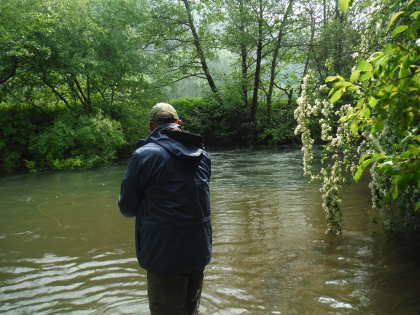
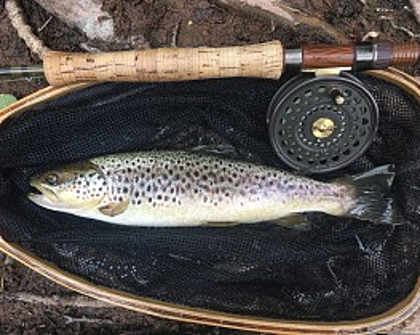
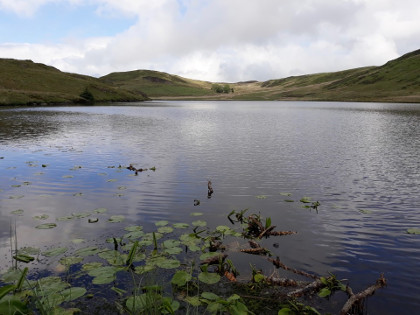
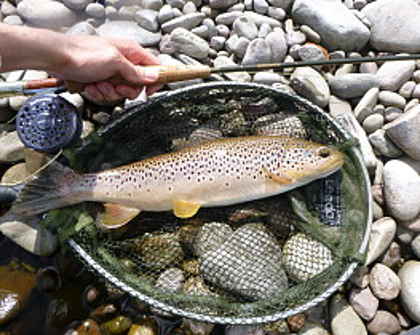
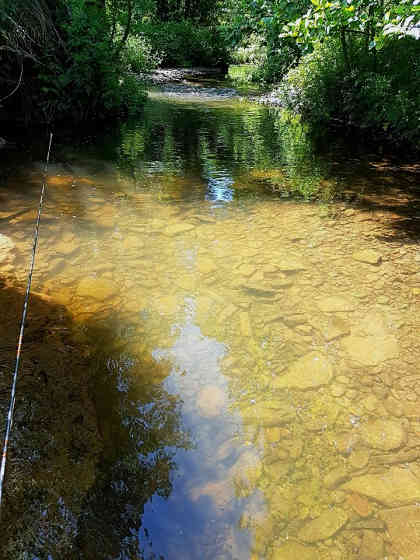
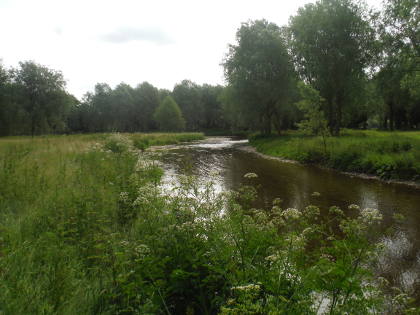
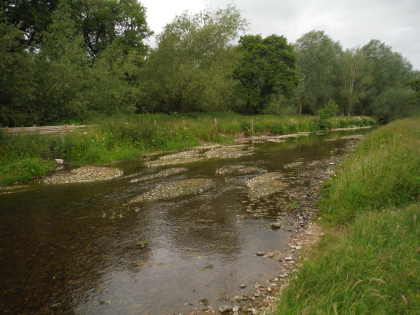
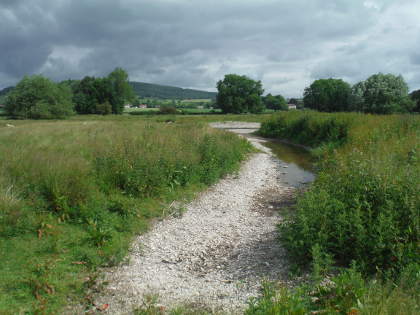
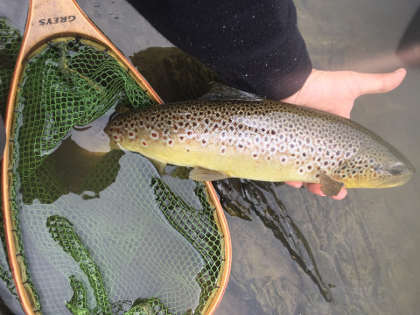
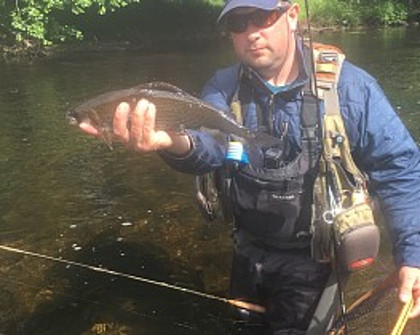
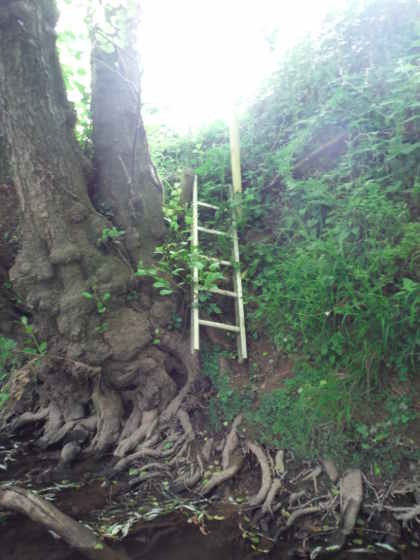
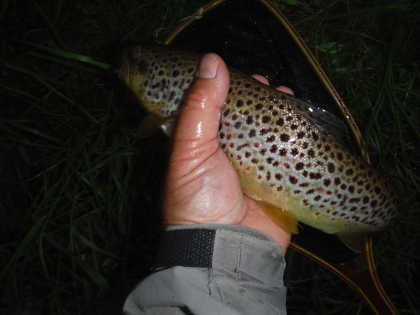
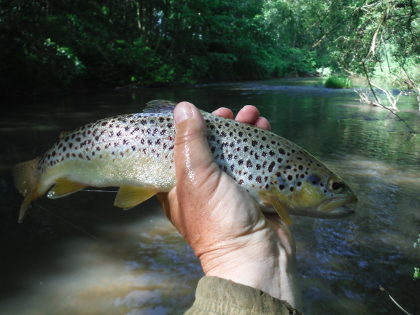
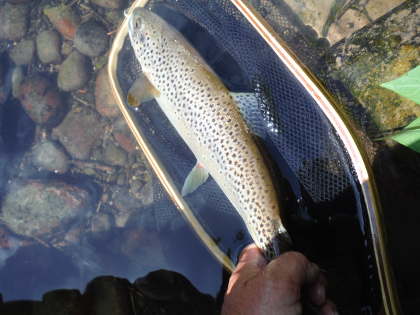
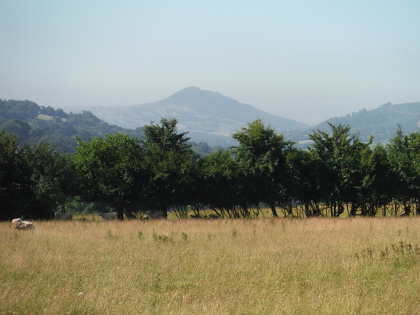
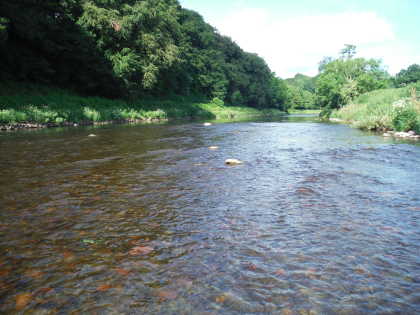
There is much to hope for in the average June: a continuance of the mayfly fishing for a couple of weeks, good fishing on the brooks, usually some rain to wash the rivers out and set two sea winter summer salmon jostling to get upstream, some early sewin fishing with luck and the coarse fishing opening on the lower Wye. This June turned out to be a month of drought and, although the trout and grayling fishing results were at times better than might have been expected in these conditions, by the end of the month most of our rivers and streams were in trouble for lack of water.
Odd thunderstorms and showers at the end of May did not seem to amount to very much in total, so we started June with the main rivers low and most of the tributaries too. The Lugg with its well-charged spring was one exception which kept on running at a good level. The rivers were certainly busy with anglers this month and there were some respectable catches, particularly in shady places or if the day was cloudy. On the 31st May (a rainy day) SM from Dubai caught 6 trout from 12 to 18 inches at Abercynrig using a Klinkhammer. PB of Gloucester had 7 trout, 2 of them at 17 inches, at Trallong and Abercamlais using a Ginger Quill and a Blue Dun - a traditional approach if ever there was one. On the 1st June, MN from Bristol took 19 trout to 17 inches at Glan yr Afon. AD from Richmond had 10 trout on a dry fly from Abernant, MT from Sutton had 8 trout to 1.25 pounds from Chainbridge, while GJ from Sevenoaks had 11 from Llyn Bugeilyn using a Diawl Bach and Coch y Bonddu. Next day, MN from Bristol was out on the Usk again at Fenni Fach, where he took 15 trout although his day was spoiled by illegal canoeists who insisted in paddling through. AS of Newent took 8 trout on a CDC Olive from the Middle Llynfi Dulas beat. On the 2nd TS from London with a friend had a large trout (not measured) in a bag of 4 taken at Trallong and Abercamlais. BP from Pembridge fished the Lugg at Litton the following day and had 9 small trout on a Mayfly Emerger. DM and SW from Hereford fished the Wye at Craig Llyn for 25 trout by various methods. JT from Macclesfield fished the Usk at Dinas and caught 9 trout to 15 inches. MT from Evesham fished at Llyn Gwgia and caught 11 trout to 1 pound in weight using some traditional flies such as the famous Zulu, Black Pennell and a muddled version of the Green Peter. The boat, he reported was, well…just about OK if somewhat battered, but altogether it was a lovely day in the wilds. Meanwhile MD from Walton-on-Thames had some problems with the upper part of the Llynfi Dulas middle beat, which he thought was overgrown and needed a prune. The bad news, I am afraid, is that this part was trimmed by us just this last winter, so I think the present situation is about as good as it is going to get. I admit that this top section is very tight casting.
On the 4th, JA from Leominster caught 5 from the Arrow at Kington using small dry flies. On the same day HP from Monmouth reported an unpleasant experience downstream at Arrow Mill, where an electric fence gave him a jolt in the back. I sympathise with that, although I might point out there is a worse experience you can have. Suffice it to say never, ever, make the mistake of relieving yourself against an electric fence. Others may find it funny, but you will not. On the 5th, HC from Wales had 9 trout from Llyn Bugeilyn using a Black Gnat and a Diawl Bach. JC from Godalming fished two beats of the Edw, seeing a big mayfly hatch on each occasion. Fishing the top at Hundred House, where he remarked on the need for pruning (and where, oddly enough, the stream has a much deeper and slower character than in the lower part of the valley), he took 7 trout. An Adams and a Grey Wulff accounted for 7 more from the faster currents of Aberedw at the bottom end. The following day JP from Bedfordshire found nothing rising in the Monnow at Skenfrith, but took 9 trout with a Black Nymph. NR from Solihull had a good day on the Middle Llynfi Dulas (lower part) and took 11 trout with a Parachute Adams. On the following day, DR from Bristol caught 6 from the Dore, again during a mayfly hatch at the little Abbeydore beat. Beautiful as it is, this is a place of distinctly odd contrasts, at least at certain times. On the one side there are grazing cows, mellow farm buildings and all the rural glories of the peaceful Golden Valley, overlooked for centuries by the mediaeval abbey. On the other, just beyond a chain link fence across the river, is the SAS Regiment's training ground and likely a couple of chaps crawling on the ground with blacked up faces and tufts of grass in their helmets.
On the 7th SF from Madrid enjoyed himself at Ty Newdd on the Wye, taking 5 trout on a dry sedge imitation. GW from Bromsgrove had 15 at Lyepole, mostly with a nymph fished New Zealand-style. JM from London had 7 on dries from the Dore at Chanstone Court, while DR had 6 during a mayfly hatch at Abbeydore. PB of Gloucester with a friend fished the Irfon at Cefnllysgwynne and caught 10 trout up to 15 inches on dries. By now the Irfon, which I think varies in height more drastically than any of our streams, quick to respond to rain or drought, was very low indeed. News came from Snowdonia on the 8th, where HC from Wales with a friend fished Llyn Adair with traditional wet flies and took 17 trout to half a pound. AK from Leominster fished the Arrow at Titley and caught 6 trout to 14 inches. JA from Leominster had 16 trout on traditional wet flies from Llyn Bugeilyn. On the 9th CB from Droitwich, understandably somewhat frustrated, put in a report about the level of weekend activity on the banks of the Usk at Glan yr Afon. I have had much the same experience; this is a very interesting beat, but it does have a footpath along the bank which becomes quite busy at times. Perhaps this one is best fished during the week in high summer. AS of Newent had 17 trout to 13 inches on nymphs from the Hindwell Brook at Knill, but sport ceased during the afternoon when the sun reached its full strength. On the following day NG from Tenterden fished the Monnow at Lower Longtown and took 7 small trout. On the 12th HP from Monmouth enjoyed himself on the Bideford Brook, taking 6 small trout on dry flies. TH of Brecon enjoyed also himself during an evening with mayflies in the air at Llangoed and Lower Llanstephan - slightly unusual to see a really big hatch on the upper Wye – but he got 20 trout on dry flies. KM from Hereford had 8 trout at Abernant. And DR from Wolverhampton with a friend had a big trout in a bag of 8 taken from the Teme at Bucknell, the water being very low as it usually is at this time of the year.
On the 14th TL from Kingsland enjoyed himself on the Arrow at Whittern taking 6 trout, but wondered how you get back from the top of the beat? In fact, it's easier than it looks and certainly there is no need to wade all the way back over a long and uneven river bed from the upper end. If you have reached near the top of Lyonshall Wood - and having covered so much water in the day you should have some aching leg muscles by that time - just look out for the footings of the old railway bridge. At this point, leave the river and make your way a few yards up into the wood where you will find a fairly good foot path. Follow this to the left along the fence of the restored section of railway line, back through the wood, round the edge of a field (footpath signs to mark the way) and along the back of the old station where there are some interesting bits of machinery lying around the track and work sheds. The friendly owner tells me that this is a "private railway" still used by himself and fellow-enthusiasts at weekends. Eventually you emerge on the sealed road where you turn left downhill and so back to Titley Bridge and the all-weather parking. If you left your car on the dry weather parking at Hunton Bridge at the very bottom of the beat, rather than follow the river along the edge of the field, cross Titley bridge and go around by the road, which is much quicker, if slightly longer.
Now back to the fishing. Also on the 14th, GM from Usk had a 17 inch fish in a bag of 5 from Talybont Reservoir. On the 15th, MT from Evesham with a friend took advantage of overcast weather to take 22 trout on nymphs and spiders from the Wye at Ty Newydd. On the following day, the opening of the grayling and coarse season, JS from Oxted had a very good trout in a bag of 6 taken on nymphs from the Irfon at Llanfechan - despite this river being very low. DM and PJ from Hereford fished at Doldowlod and had 31 grayling and a trout on nymphs fished French leader style. For the rest of the month, coarse fishermen kept the middle and lower Wye beats even busier and it seems that many barbel and chub were taken. On the 17th TR from Cape Town came to fish at Craig Llyn and took 12 trout and 6 grayling by various methods. JS from Oxted was on the Rectory beat the same day and took 10 trout and 2 grayling using nymphs in the fast water. AS of Newent fished the Bideford Brook and took 7 trout on nymphs, while ME from Caersws fished from the bank at Llyn Gwgia in Central Wales and took 6 trout. TR of Cape Town was on Abernant on the 18th and recorded a 50 fish day, 30 trout and 20 grayling, mostly fishing heavy nymphs close at hand.
On the following day CB from Ross on Wye with his uncle fished at Monnow Valley for two trout caught, but queried the access arrangements for an ageing angler. Well, I would query them too, and I'm much nearer 70 than 60 myself. These days I don't have an aged progenitor ("give him a nod, Pip") to take fishing, but I reckon I'm old enough to speak for pensioners. (On reflection, I suppose I must keep going to MV because I somehow imagine it keeps me fit!) The subject of access comes up on a regular basis regarding Monnow Valley, but I think the beat description should be read with attention and should be taken literally. It states: "...access to the river can be difficult, particularly in the summer months." By its nature, this fishery is always going to be hard work and it probably isn't the place to take an ageing relative who is new to the water. On the other hand, the fishing can be rewarding if you are ready for some walking along the edge of ploughed fields - it's a good long way to the top of the beat - and in some cases quite severe clambering up and down overgrown banks. There are now 12 (or is it 13?) yellow posts, each of which marks a viable access route to the river. These routes down have also recently been strimmed. Right below the lowest post, the first access point at the bottom of the beat, you will indeed find a ladder secured to the bank - see photograph. As the beat description makes clear, there are places which can be waded once you are in, but the extent of this wading takes some learning and practice, and of course depends on water height. And as the description also makes clear, there are other areas which can't be waded and are obstructed by fallen trees. This is fine with me; plenty of refuge where nobody fishes tends to produces the odd large trout and Monnow Valley is certainly a place you might encounter one. I commend it to anyone who enjoys the sort of fishing I have described.
Meanwhile TR from Cape Town was busy again on the Colonel's Water of the Irfon, where he had 6 trout and 4 grayling. I just love these visitors who go hard at it every day! And RB from Llandysul fished at Teifi Pools for a dozen trout to a pound. He was using a team of small Claret Hoppers, most of the fish coming to the greased one on the top dropper. Llandysul would be a good base for some excellent fishing; I only wish I lived nearer Teifi Pools. On the 20th CB from Ross on Wye fished the Usk at Ashford House with a companion; they had ideal warm and overcast conditions and took 11 trout to 1.25 pounds, mainly on a small Grey Duster. GM from Usk fished Talybont Reservoir and took 7 trout from 10-15 inches, noticing freshwater lice on most of the fish. TR from Cape Town - my goodness, this man is relentless I was starting to think - fished a slightly coloured Lugg at Dayhouse and caught 18 trout including a big one (not measured) using a nymph fished New Zealand-style. HP from Monmouth fished at Aberedw and took 8 trout to 11 inches on various dry flies. EOB from An Cuinche fished the Dee at the Glendwr Preserve for 3 trout and 7 grayling. KH from Gloucester had a super catch of 30 trout from the Dore at Chanstone Court. TR from Cape Town fished at Gromaine and Upper Llanstephan on the 21st for 25 trout and 16 grayling, these being caught during the morning before the heat came in. On the following day TR fished Fenni Fach, this time for just one trout caught well into the evening, but also stated how much he was enjoying himself and how attractive he thought this Usk beat was.
By now the growing heat wave, sun and lack of rain were really making themselves felt. Despite the unforgiving weather, a few of the results were still better than you might expect. On the 22nd, RH from Broadwas had 16 trout and 18 grayling from Ty Newydd, fishing with heavy nymphs and concentrating on the fast, oxygenated water. Up in North Wales, GS of Crewe reported 5 grayling on a small olive dry fly from the Dee at Glyndwr Preserve. Bright as the weather was, a few grayling were apparently rising most of the day. TR from Cape Town was back on the Usk at Penpont the following day. Having learned his lesson about avoiding the sun, he didn't start until 8 in the evening and got half a dozen with the dry fly in fast water before darkness came on. CB from Droitwich took the opposite approach and fished through the morning at Abernant, where he took 15 trout and 12 grayling, mostly with a dry fly. This was TR of Cape Town's last day (half-day to be precise) and he spent the morning at Cefnllysgwynne, where he found the Irfon as about as low as can be. Nevertheless, he got 15 trout to 12 inches, plus a grayling (which he regarded as a rare treat), and finally the sight of a family of otters - after which, and leaving behind thanks to the WUF and everybody he met, he has disappeared into the sunset. I have to comment that I have had the pleasure of hosting a surprising number of visitors from South Africa and, almost without exception, they have been very good fly-fishers. If you visit South Africa, they tell me, the Drakensburg range is the place to go with a dry fly rod.
Water conditions were now becoming quite severe as the hottest days of the year were recorded with no sign of rain. The water temperature of the lower Wye reached 23.5 degrees C which must have amounted to an effective barrier to new salmon entering. Levels on the Wye were to a certain extent sustained by a compensation agreement to release extra water from the Elan Valley dams, and for the Usk by planned repair works to the dam at the head of the river. This entailed lowering the level in the reservoir, the surplus water being channelled down the river until being removed again for Llandegfedd Reservoir (the Newport supply) at Priory Mills. Slightly to my surprise, grayling kept rising on the upper Wye despite glaring sun and air temperatures around 30 degrees and clients were able to take them with dry fly and spiders. Many fish were liberally covered with fresh-water lice. There were also fish to be found in the shady brooks. On the 26th RW from Portishead had 7 trout to 13 inches, fishing with a tiny midge pattern in the Honddu at Maes y Beran. Still, fishing in heat-wave conditions can be frustrating, particularly if your expectations are high or your temper is short. About this time I noticed these two catch returns for the Usk Reservoir, entered on consecutive days:
26th June, AS from Malvern, Usk Reservoir - "A very warm day in the end, had 7 bites and caught 6 x trout, good size ones as well, really pleased with my day's fishing, will return with my dad once he's off his holiday, thanks Usk Reservoir."
27th June, AL from Llanelli plus companion, Usk Reservoir - "Been fishing here for 14 years at least once a month (while season open). Been here 5 times in the last 2 weeks as I had time off work. Not a single trout caught using fly, spinner and ledgering. No fish moving. Plenty of perch. Ain't seen the reservoir stocked for weeks on end. Really, really, poor from a reservoir that I've grown up to fish."
Well, that tells a story, doesn't it? If I were a sarcastic man, I might suggest that AS of Malvern had caught all the fish the previous day! It's a reminder, if one is needed, that even on stocked waters fishing is not quite like putting money in a slot machine, pressing a button and receiving the promised bar of chocolate. God forbid that it ever becomes so. You can study the form and you can study to be a better angler, but there is never a guarantee of success. You can have a red letter day or you can have a bad day, and you can never surely tell which it is going to be. If you are able to accept that truth with an open and optimistic mind, and enjoy the day for whatever it brings, you have discovered the true charm of this sport.
Fly Fishing and Fly Tying magazine is always worth a read. Perhaps with a view to tactics next spring, anglers in our WUF catchments will be interested to see an article by Ceri Thomas in the July edition. This is about Talybont Reservoir, a water which is rich enough to produce some superb brown trout, but which also has a well-earned reputation for being moody and difficult at times. Ceri explains his approach for early season fishing which is based on the use of streamers, although buzzer patterns will also work at times.
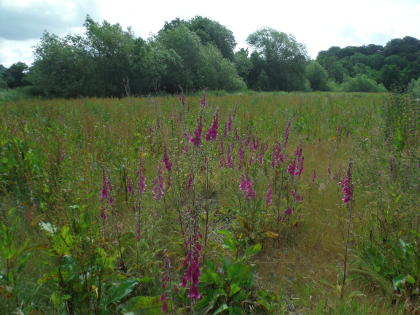
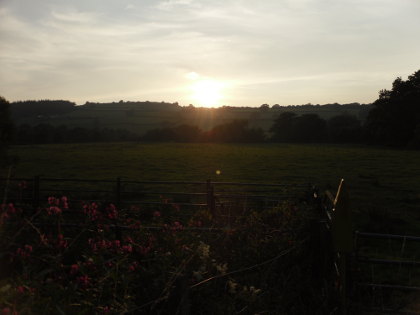
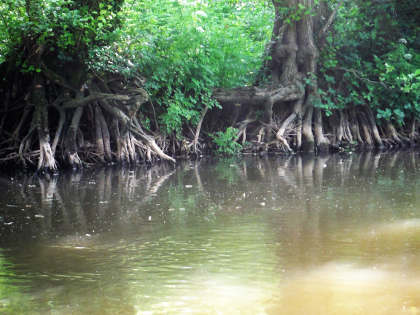
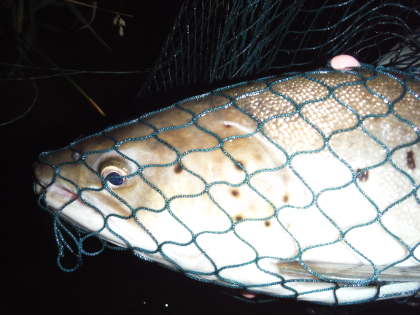
Let's take a look at something different. Fox gloves have been in flower for a while, which means that it must be about sea trout time again. Lord knows we have been waiting to start. Early in June, by which time anglers almost everywhere had already begun praying for rain, we held our committee meeting of the Pontardulais club. Membership this year is slightly down, but we know quite well that a few more will join as soon as the sewin arrive in numbers into the river. There was a big tide coming up the Loughor estuary that night and black clouds were racing overhead, bringing the first few spots of rain to town streets. But Eifion, who had studied the 6 o'clock forecast carefully, said: "It's no good boys, this lot is going to miss us. It's all heading for Ireland and Scotland." So it proved. After the meeting, Lyn and I went down to the Loughor and flicked dry flies around until dusk on a shrunken river, the pools still and black, the pebbles covered with slime. A big sea lamprey came past, for some reason sucking air at the surface as it went (I'm sorry, but I can't find anything loveable about these creatures. I try not to think about them while I'm in the river at night). We saw just one small sewin jump on the tail of Pwll y Wal, but for now all we had to play with were little brown trout nipping at the surface. The rain never came and it was all very disheartening. On the other hand, it's rare for me to fish this river in daylight and it's always interesting (not to mention a good safety precaution) to see how the winter floods have modified the pools. As I write at the end of the month we are still waiting for rain and, to give you a sample of the mood, yesterday I received this email from Lyn:
"I was out guiding last weekend with an American visitor and we stumbled across half a dozen or so sewin in a big deep pool. I watched them for a while and they clearly looked uncomfortable with the algae and the low, low water. I've not seen the river so low for years and they reckon the Towy is worse! I hope the fish that are in the system survive. No news on any fish being caught. Everybody's waiting for rain - then look out!"
It seems we will have to be patient a while longer while we wait for the drought to end. Trout and Salmon's James Beeson recently interviewed Cyril Fox, the legendary gillie at Abercothi on the Towy and certainly a man to take advice from on sewin fishing. He made several points which certainly chimed with my limited experience. Firstly he stated that successful sea trout anglers always lose lots of flies. This point has been drummed into my head time and time again by the old hands of the river. It's usual enough, in the Towy or the Loughor, to be fishing from the shallow side towards deep water overhung by trees. Sewin are the shyest of fish and the big ones appreciate that overhanging cover, even during the dark hours. I can remember an evening on a pool with a local expert who took five sewin, one of them a 6 pounder, while I had a mere one. However, my friend lost quite a lot of flies in the process that night; he was constantly pulling out of branches and several times had to pull for a break or an opened hook. He seemed to have a detailed knowledge, developed over decades rather than years, of certain lies for big sewin tucked right under the far bank and he certainly gave them plenty of attention while I was with him. Like many of us, I tend to be a bit worried about snagging tackle and probably conservative about the distance I cast towards low-hanging tree branches in darkness. This year, I'm resolved to be braver and treat the flies as ammunition, to be expended and lost if need be - Lord knows I have enough of them in store. So I'm determined this time round to extend my casts little by little until I do contact the trees on the far bank ... or just maybe a sewin.
Mr Fox likes a night with no moon, no mist and perfectly clear water. That's an uncompromising statement, although most would agree with it. I have had the odd good fish in moonlight, but I certainly have had no luck at all in a mist. Perhaps there is something discouraging about the cold air conditions which create the mist in the first place, very likely to send the angler back to a warm bed. The only sewin angler I met who could cope with misty nights was the irrepressible John Graham, inventor of the Jambo surface lure. He reckoned that most mists clear upwards if you wait long enough and late enough. The general advice for a coloured river is to use a larger and brighter fly than usual, but this has not helped me much at night. In any case I reason that, if the rivers are up and coloured at all, why not go salmon fishing by day instead? The great thing about night sewin fishing is that it can be good with the rivers at dead summer low, a time and condition when not much else is going on. Finally, and rather sadly, Cyril Fox admits that the sewin fishing is not what it once was. He recalls a time when it was usual to catch four or five and then leave the river by one in the morning. Now it might take all night to catch just one or two. This is the recent experience of most people I know. Still, you never know ...
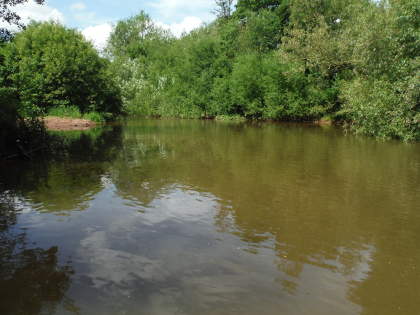
While we are on the subject of problems with our rivers, it might be timely to mention the algal blooms which have caused us problems during this and other summers, particularly on the lower Wye. The reason for the increasing growths in free floating or filamentous algae during periods of sunshine is almost certainly the presence of high phosphate levels in the water. Add the ingredient of bright sunshine and photo-synthesis takes place rapidly; if water weeds are already present, their growth will be accelerated, but elsewhere the rapidly reproducing algae will transform what would otherwise be clear water into a green or brown soup, and the filamentous version of the algae will coat the bed of the river with slime. Anybody with a garden pond will be familiar with this problem on a small scale. Nature will rebalance the situation given time, but the continual addition of phosphates, usually due to poor agricultural practice, will bring the problem back again and again. The strong suspicion is that it is the over-application of farmyard slurry to riverside pastures which is mainly to blame. This year the upper as well as the lower Wye was affected, and also the Monnow which ran a thick brown colour for several weeks during which there was no rain in the catchment. Sadly, it seems my favourite part of the Towy has also been affected. Follow this link to a recent Salmon and Trout Association survey on the middle part of the Towy:
https://www.salmon-trout.org/2018/06/18/stc-cymru-snapshot-survey-of-the-middle-tywi-towy
Anglers in this part of Wales, perhaps sensitized by the recent pollution of the Teifi, once bitten and twice shy, are keeping a careful watch on farming practices and the spreading of slurry on riverside fields.
While waiting for the start of the short sewin season - it ends in September for me as then the serious grayling fishing starts - there is time for some reflection. In recent years at least, I have had that sense of opportunities missed. In the case of sea trout in particular, there is always that idea of a key to be found, a key which once turned in the lock will open the door to the most amazing catches. The particular problem with sea trout - call them sewin, peal, white trout, depending on where you live or fish - is that so many of the experts have such very different approaches to fishing for them. The experts are almost always local and if I am convinced of anything, it is that fishing one particular river for many seasons is the basis for their success. If they like you, local experts may eventually tell you some of what they know, but not so very many have been prepared or interested to write about their experience. For that reason, I collect whatever books I can find about this peculiarly enigmatic creature, the sea trout, and try to glean from them any tips which might turn out to be appropriate for the couple of Welsh rivers which I fish. If you disregard the advice on tackle and concentrate on the water craft and fishing tactics, the publishing date may not matter so very much. Lately I have been re-reading and considering the works, one ancient and one modern, of two experienced West Country peal fishermen, who interestingly enough both fished the same river, the Tavy. Each of them proposed a theory, or more accurately a quite strongly held belief, which has provoked some thought in me. See what you make of them. These anglers and writers were Jeffery Bluett, Sea Trout and Occasional Salmon, 1948, and RW Mountjoy, The Sea Trout Diaries, 2007. The introduction to Bluett's book by Major Kenneth Dawson, another acknowledged West Country expert, certainly set the scene and the times:
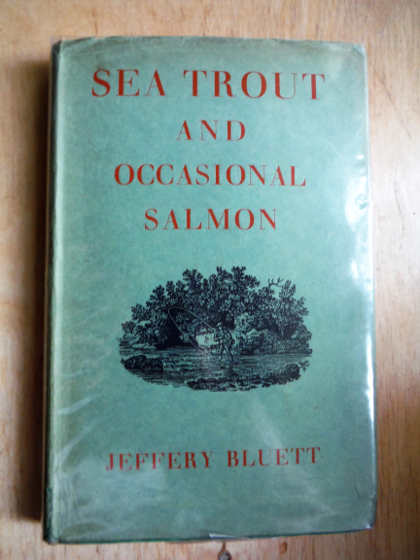
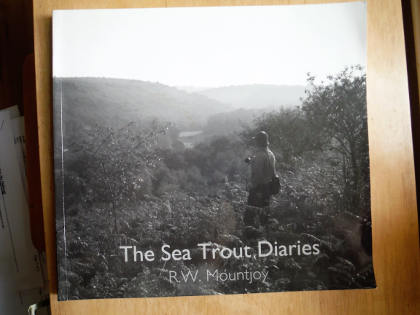
"It was in 1921, that summer of record drought, that I first heard of Mr Bluett. I came home on leave from Constantinople, early in September, to find that everybody on the Tavy was talking about the wonderful success with sea trout at night of a young Cornish schoolmaster. If I remember right he had over 90 in the summer holiday. Since then there have been few seasons when I haven't seen or heard of him on the rivers we both love so well, and his reputation as a highly skilful and successful night fisherman has grown with the years."
Bluett was essentially a night fly-fisherman at a time when that approach was not nearly as popular as today, and he eventually published his book after more than 30 years of experience on West Country rivers. Many of his tactics fit with those we still use. He was largely a down and across wet fly man, bringing the flies back just under the surface with a figure of eight retrieve on a warm night when the fish were lively, but reverting to fishing a large fly slow and deep when the temperature dropped. He did not know about surface lure fishing - it seems that his admirer Dawson was the first to discover that - but he had very definite views about the design and size of flies and in fact was one of the earliest users of multi-hook demons and terrors for sea trout. Generally he didn't like the moon, or at least took pains to find shaded pools to fish on bright nights. He rarely fished all night, but when he did so noted, as so many of us have done, that sea trout briefly come back onto the take at dawn.
Bluett's big theory, however, unique as far as I can tell, was that he always had better results with a growing moon rather than a waning one. He produced a comprehensive catch list over one season, during which he fished for five evenings a week over four months, which does seem to prove his point that he was scoring much better catches during the new moon and the first quarter. To be precise, averaged over four moons, he caught a total of 135 during the growing light phases, and 38 during the growing dark phases.
I felt much more comfortable about my own fishing when I noted that Bluett, too, had quite a few blank nights. However, looking back at my own records I can see nothing to confirm or deny Bluett's contention. This is mainly because I don't fish regularly enough and nor have I been at the game long enough or successfully enough to come up with any meaningful statistics. I can only remember moonlight nights when the river was lively and takes were frequent, or a stormy night, black as pitch, when there was one big fish in the early hours which made all the effort seem worth-while. Bluett did make a remark that the river was tending to be high or unsettled during the early season of his test-case year. However, he made no remarks about the level of cloud on different nights. I would be very interested to hear from anybody else who has experience of different levels of success with a waxing or a waning moon. Meanwhile, I can only think that there are so many other factors combining against the organising of night fishing expeditions - high water, family commitments, distance to drive, things to do in the morning - so that if in addition we can only go during the first half of the moon, there won't be many trips in a season!
Finally note that Major Dawson, writing again in his introduction, highlighted the value of Bluett's local dedication: "I am sure Mr Bluett is right in asserting that the man who sticks to one or two rivers until almost every stone is a personal friend will, in the vast majority of cases, be a better fisherman on these rivers than he who is forever changing his angling venue."
RW Mountjoy's The Sea Trout Diaries is a very different and rather romantic book which includes a description of a West Country childhood in a coastal fishing port and a West Country life in which sea trout fishing and the landscape of Devon and Cornwall have clearly played a big part. The soft-back publishing format is modern and unusual, with lots of black and white photos and reproduced pages of the fishing diaries alongside paragraphs of explanation of the fishing tactics, accounts of special nights, and descriptions of landscapes, communities and characters. Mountjoy also emphasizes that famous "need to do the time" for success in peal fishing and describes how long it was before the old timers on the river would open up to him and discuss their methods. He also has spent many seasons fishing the same river in a tight, wooded valley, not easy to navigate in the dark, but causing him the same delight as Bluett felt before him. He is a night fly fisher, but also a day time spinner, perhaps more so in the past than today.
It is in terms of spinning with a Mepps spoon that Mountjoy has produced diagrams to illustrate his own theory of sea trout fishing and the means of provoking a take, which should be just as valid for fly-fishing or for salmon fishing. Effectively, he proposes that there is a zone within which a migratory fish will be disposed to be annoyed by, and with luck attack, a small object coming close to him. And there is another zone within which a migratory fish will be capable of seeing such an object. In clear, still water, the zone within which a fish can see an approaching object will be far greater than the "annoyance zone" within which an attack may be provoked. In the case that an angler is approaching a few steps at a time from upstream with a fly or spinner, cast across the stream and allowed to swing, a fish on a lie will see the lure quite a number of times before it comes close enough to be within the "annoyance zone." By the time that happens, so the theory goes, the fish has become used to the sight of the lure, even bored with it you might say, and so declines to attack it.
On the other hand, in the case that the water is somewhat coloured, the visibility zone of the fish on station is reduced in size to something like the same size or even a smaller size than the annoyance zone. In this case, the first sight of the lure is its sudden appearance out of the murk, at close hand and within the annoyance zone, and the immediate response by the fish is to bite at it. (Obviously if the water is so coloured as to preclude the fish seeing the lure at all, then all bets are off). Coloured flood water is not the only circumstance where this may happen; a turbulent run with refractions from a tumbling surface current can reduce visibility in the same way, so that the lure suddenly appears in front of the fish. Mountjoy also argues that the success of upstream spinning with a quill minnow is due to the same effect. When the minnow is dropped just ahead of a fish to be spun briskly back down the current, the response is often an immediate take. Similarly if the lure can be made to appear suddenly around a stone or other obstruction, the result is more likely to be positive.
I think I am at least half convinced by this theory and if you believe in it at all, there are lessons for the salmon as well as the sea trout angler. For example, when you are fishing a pool down and across with the traditional "wet fly swing," if you wade down no more than a step per cast, effectively less than a yard at a time, any fish is going to get quite a few sightings of your fly gradually approaching from upstream before it comes within taking range. When it finally does, the fish may have switched off and simply not bother. The lesson is that rather than fish a pool down very slowly - which I see many anglers doing, covering the water almost by inches - it might be more productive to take quite a few steps between casts, 2 or 3 yards or even more, with the idea that the first or second time any fish sees the fly it will already be within taking range. You can always fish the pool down a second time if you feel you have not been sufficiently thorough. In my limited experience, it is the fast-moving angler who tends to get results.
There is another conclusion to be taken from this theory, which is that it explains the effectiveness of "backing up." What do you do when fishing a pool down if a salmon or sea trout shows behind you in water which you have already covered? Many would advise that you get out of the water, wait a spell and then get back in higher up and fish down to it again. Another approach would be to start throwing casts fairly square across, taking a few steps upstream after each one, so that the fly comes round in a curve fairly quickly. More often than you might imagine, the fish takes when you get to it, even though it didn't like your earlier presentation from above. The theory is that the fly suddenly appears from behind the fish on a different trajectory and that this time it is startled into taking.
The backing up trick can be particularly effective when sea trout fishing. For example there is a particularly tight little pool on the Loughor called Swing-bridge (the bridge itself has long gone), where you cast your way down a difficult run until the water deepens and slows and you eventually run out of wading depth under a steep bank on your own side. The bottom there is all encumbered with rotten logs and silt, so you know well enough by feel when you have to stop. Just before that point, through the gloom, you can make out a little bay under the far bank, equally steep, which looks as if it would hold a sewin. Fish the fly down past the bay, casting as far into it as you dare, and in my experience nothing ever happens. However, rather than crawling up the bank and moving on to another pool, try backing up for a few steps, casting straight across before moving upstream again. Try and pop a cast right into that bay, take a couple of steps back and ...bang, Bob's your uncle! It's surprising how often a sewin turns out to have been there all along.

There is a very different and much larger pool on the Towy near Llandeilo. We always fish the whole pool down, although we know the hotspots are likely to be the slowest, deepest part at the bottom end, or the wide shallowing tail immediately below. However, in the case that I reach the tail and nothing has happened, I make a point of beginning a process of wading slowly back, casting squarer now and making an effort to drop the fly as far under the overhanging bushes on the far side as I can manage. Experience has proved this to be well worth doing and often produces a take when none came before. In this case often I will go halfway back up the pool and it should be mentioned that the method also works for the surface lure. Incidentally Hugh Falkus was a great believer in backing-up. However, there are two final notes of warning which should be sounded. One is that the method is much safer where the wading is secure, but that it is quite easy to trip up while walking backwards on rough ground. The second is that if you are fishing club water (which so much sea trout water is) and people are queuing to fish down a pool, anybody who starts backing up from the bottom end is likely to provoke justified annoyance. You have been warned!
Let's all now hope for rain, which will benefit every kind of fishing. Tight lines!
Oliver Burch www.wyevalleyflyfishing.com
May 2018
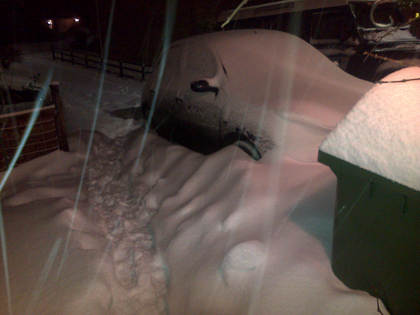
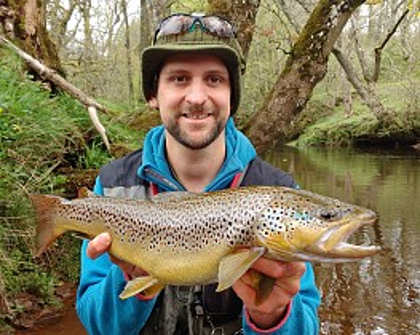
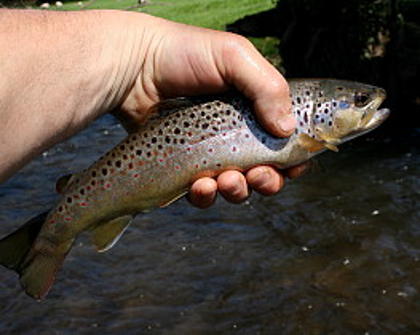
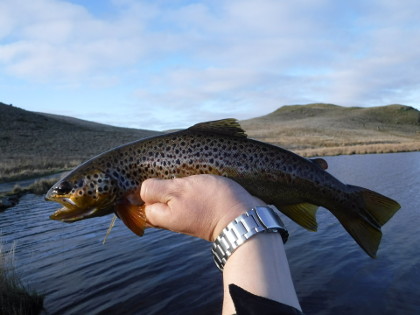
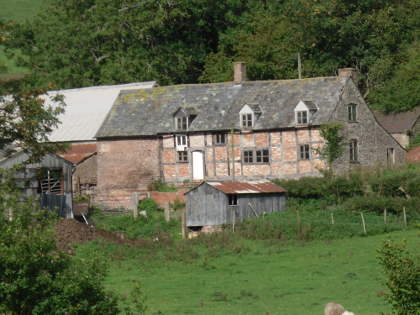
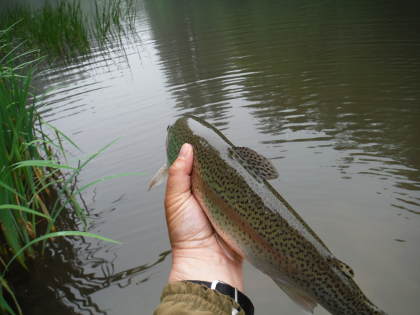
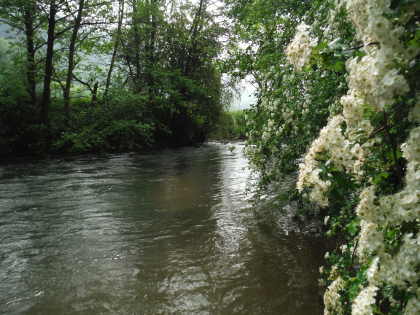
After two cold and difficult months (I think March was actually better than April), we started off May in an encouraging way with two big fish. On the 1st BG from Exeter sharing a rod with friend D had just 5 trout on nymphs from the upper Usk at Pantyscallog. However, one was a superb Usk specimen of 21.5 inches. BG hadn't been fishing for a while and Pantyscallog in the spring is a glorious setting. Altogether it must have been a happy day. JA from Leominster had 9 small trout from the Arrow at Kington, also on the 1st May. DR from Bristol fished the Lwyd at Llantarnam Abbey on the 3rd and had a memorable day. He caught another big trout, again 21.5 inches, and this time on a small Kinkhammer. The Lwyd is known as the "grey river," and it does tend to have this colour most of the time. Much of it is urban, although the abbey grounds are an oasis of green and it has long had a reputation for producing the occasional really big trout. On the 4th, PT from Kidderminster fished the Arrow at Kington, taking 8 trout to 10 inches on nymphs from the fast water. SR from Richmond was up at Llyn Bugeilyn on the same day and had 10 of its small dark trout.
The bank holiday weekend which followed was a bit of a shock, as a proper three-day heat wave arrived with the sun very high and bright and the water very clear. Air temperatures reached the high twenties. Generally anglers reported that fly were hatching, but trout just weren't interested and rises were few and far between. The nymph fishermen seemed to achieve better results, as had really been the case since this season opened. AS of Newent fished the Honddu at Lower Stanton on the 5th and had 11 trout from 10-12 inches on nymphs. CT from Cardiff with companion MM had a super day on Teifi Pools, catching 25 trout headed by a fine fish of 18 inches from Llyn Hir. Apparently they fished from dawn to dusk - no small effort at this time of year - and the best of the fishing came early and late. They used intermediate lines while the sun was bright overhead. The following day, DM from Cwmbran was told about a silo spill affecting the Honddu at Pandy. I understand from the WUF there was an incident here a couple of years ago, but, without wishing to underplay the seriousness of pollution incidents, an intervening winter usually restocks the river quite quickly. Note that the catch made by AS at Lower Stanton the previous day indicates that the river above is certainly healthy. Rather similarly on the 6th, AS from Godalming and a friend were locally advised about low water and fish rescues carried out last year on the local Dulas and Dore brooks. Again, it isn't unusual for the Dore to go very low in a dry summer (the bore holes further up the Golden Valley near Vowchurch may have something to do with that) and the EA will certainly pay any attention to any fish considered at risk. And again, generally fish move in during the winter to fill empty stretches; this has certainly been our experience with the Teme at Bucknell, similarly affected regularly by low flows. Far be it for me to underestimate the seriousness of low water, abstraction and farm pollution - we seem to have too many incidents altogether and with a growing human population we probably face more - but the general consensus is that neither of these incidents has caused serious damage. Also on the 6th, BP from Pembridge fished the Edw at Hergest with nymphs and a tenkara rod and had 5 trout from 6-12 inches. On the 7th, AS from Newent took 19 trout to 10 inches on nymphs from the Edw at Hergest. LH from Hereford drove his family up to Usk Reservoir, where they all picnicked in the sunshine and watched him take half a dozen rainbows on buzzer patterns. BS from Bristol expressed dissatisfaction with a day on the Monnow at Skenfrith, a very beautiful and normally fairly quiet spot. However, on this bank holiday Monday the river was unfortunately noisy with splashing swimmers and rafters. It seems that Skenfrith has been discovered! He also mentioned that the Bell Inn has put out tables on the allocated parking space. JS from Windsor fished at Fenni Fach for just two trout on dry flies: "...having fished nymphs all winter...I wanted to stay on top." JD from Gloucester had 5 from the Cannop Brook, although there were "lots of walkers, dogs, cyclists, etc."
During the warm bank holiday weekend, quite apart from the usual paddlers, stone skippers and swimming dogs splashing around in anglers' pools, we had some more "silly season" events. AS from Malmsey encountered a poacher spinning the little Bideford Brook - I have warned the owner about that one. CO from Swansea and a friend turned off two teenagers spinning at Dinas in the upper pool. I am afraid this is a perennial problem around Brecon where the poacher's weapon of choice is a short rod, a fixed spool reel and a 7mm Rapala lure, an outfit which can rake trout out of the pools with great efficiency. The nearness of the A40 dual carriageway is a two edged sword in this case. One year with the former owner of Abercynrig I remember chasing a couple of characters with spinning rods across the fields in my Landrover, only to have them get away in a car they had left on the by-pass. On the other hand, it's easy enough when driving across the by-pass bridge to spot if anybody is fishing where they shouldn't - something which might be born in mind by anybody tempted to encroach on the neighbouring beat when fishing late in the day. There was also some spinning rod poaching last year at Ashford House. With reduced resources, NRW don't seem to be able to establish much control over this although I am pretty sure anybody who is actually caught red-handed spinning the Usk during the spring will face a fine of at least 2,000 pounds.
On the 12th, AS of Newent fished the Lugg at Litton and caught 16 trout to 12 inches, again on nymphs. On the same day, PAC visiting from Arrecife (Lanzarote, I think) fished at Ashford House and, as a welcome change, reported using dry flies to catch 8 trout to 2 pounds. He suggested that the access to the lower end of the beat was difficult from the parking at the house itself, and that access from the road bridge at the top might work better. I can see his point, but it's possible that the owners would prefer to see who is on the beat by having them park at the house. DM from Wrexham with a friend fished Llyn Gwgia for 13 trout, but warned that the track is rough and the boat somewhat dilapidated. CC from Cambridge had 8 small trout from the Arrow at Whittern on nymphs. However, on the next day IC from Gloucestershire fished upstream at Kington and managed to get 11 trout to 11 inches on a Deer Hair Emerger. PAC from Arrecife was also fishing the surface with CDC dries at Glan yr Afaon on the Usk and got 6 trout to 0.75kg. DA from Brecon had 6 trout from the Irfon at Llanfechan. LH from Ealing earned my sympathy by beginning a report from Fenni Fach with "This is going to be one of those 'Nevertheless, a good day to be out on the river' type of returns." I know, LH, it hasn't been an easy spring and it's always difficult with a high, bright sun. On the 14th GW from Bromsgrove fished Lyepole with nymphs for 5 trout. DR from Bristol had 13 little trout to 9 inches from the Cannop Brook using an Olive Klinkhammer and Deer Hair Emerger (the very shaded nature of this forest brook may have helped here). PAC of Arrecife ended his holiday by fishing the Usk at Glan yr Afon and had 7 trout on small dry flies. On the 15th, JC from Barry caught 6 trout at Ashford House after recording a blank at Upper Tower. AK from Blakeney had a good morning at Dinas where lots of fish were rising until early afternoon. He took 7 trout, including one of 18 inches, on an Adams.
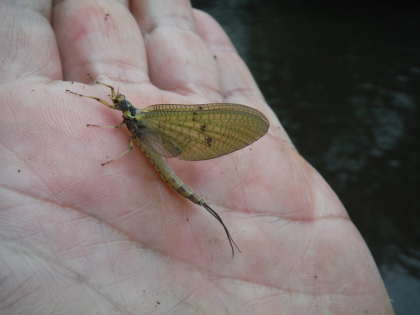
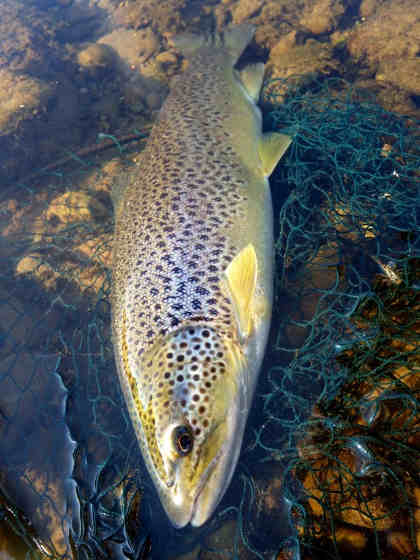
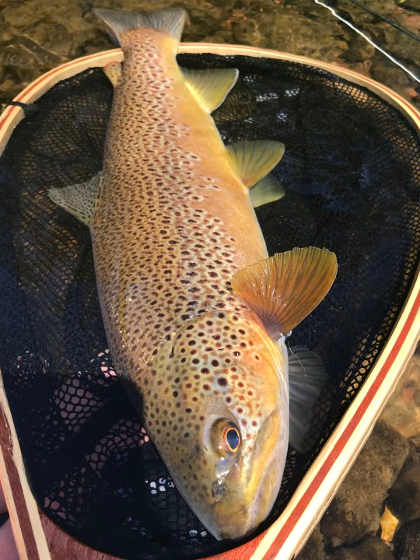
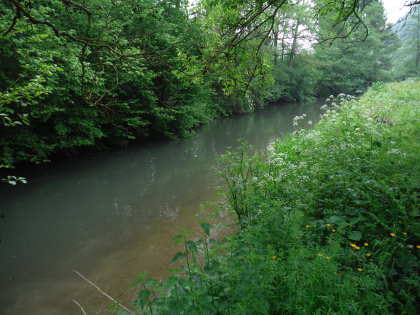
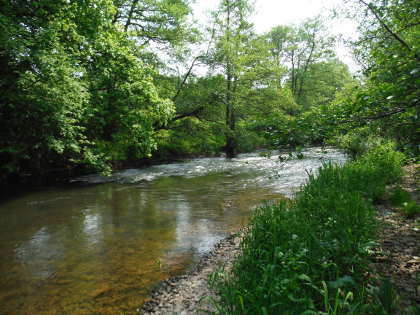
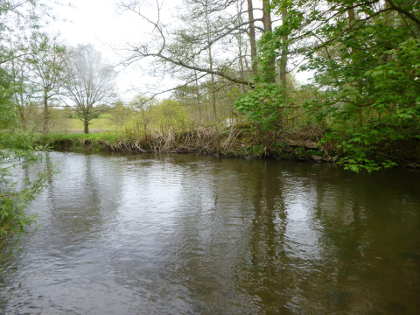
By the middle of the month, I had the impression that fishing conditions were starting to normalise. While out on the upper Arrow with a client on the 15th, a very hot and bright day without a cloud in the sky, it was noticeable that trout were rising in the shaded pools, but not in the ones exposed to the sun. As it was, we caught a few and there was no more need to use nymphs. The 16th was a much cooler day with full cloud cover and drizzly rain in the west of our region. DH from Gloucester used it to take 7 small trout from the Bideford Brook with nymphs. Had it been later in the month and on a Wye tributary, I would have called this perfect mayfly weather, but I was out with clients on the middle Usk and we were treated to a whole mixture of hatching flies. Olive Uprights were the main interest through the day and the trout were going hard at it - we watched one nymph chased up to the surface and a couple of duns were snatched several inches in mid-air as they tried to get away. At the same time, apart from gnats and midges, large dark olives were still around, some of the first pale wateries, and during the afternoon there was a flurry of hatching March browns - yes really - which seemed to me very late indeed for this species. They must surely be large brook duns I thought at first, but a close look revealed the contrary. Most fish were risen on Parachute Adams, Bob Wyatt's Deer Hair Emerger, some little CDC emergers and Paul Proctor's Humpback Spider which is meant to imitate an emerging March brown. Altogether it was an interesting day with much rifling through the fly boxes and some good trout on the move at the surface. When the Usk is kind to you, it is easy to forget how dour she can be at other times! And the day after that, the 17th, the first true mayfly of the year was reported from the Upper Monnow. I found myself on the same river the next day; the hatch wasn't general yet and there was more interest in olive uprights, but I found one fish tucked in among the alder roots which was definitely nailing mayfly duns and caught him with a Monnow Gosling. Very satisfactory. Over that same weekend, while visiting my son who has moved to Sussex and thus become a Weldishman, I saw quite a batch of mayfly spinners dancing in the evening sunshine beside the slow gliding Rother. Meanwhile, and at the other end of the size spectrum, a very big hen salmon of 37 pounds had been taken from Lower Bigsweir using a single hooked Flying C. Overall numbers of salmon have been down this spring, but there certainly have been some big ones. There was also an intriguing report from MR of Winchester, who while salmon fishing at the Rectory reported accidental dace to 2 pounds taken on the salmon fly. The best guess is that these were twaite shad, which certainly were by now in the Wye on their spawning run - and that the British dace record is therefore safe!
Now back to the trout fishing and for the rest of the month the reports came thick and fast! On the 16th RW from Portishead took 6 trout to 13 inches prospecting with dries on the Honddu at Half Moon. JM from Birmingham was using Haul y Gwynt, the traditional Sun and Wind fly, to take a brace from Llyn Egnant. On the 17th, PBM from Chipping Norton had a 15 inch fish in a bag of three taken with a small Rough Olive from Upper Longtown. On the 18th JE from New Malden reported 7 small trout from the Edw at Hergest, while MN from Bristol had a dozen to 13 inches on nymphs at Craig Llyn. SJM from Hereford with a friend had a very good day on the Usk at Greenbank on the 19th. They had intended to fish for salmon but eventually caught 10 trout weighing between 1 and 2.75 pounds. KH from Gloucester reported 8 trout from Abbeydore in the Golden Valley, while AS of Newent fishing upstream at Chanstone Court had 19 to a tiny size 20 F-fly. On the following day AW from Salisbury reported 14 small trout from the Edw at Cregrina while PT from Kidderminster had 8 on dries from the Lugg at Litton. On the 21st AK from Blakeney had a single large trout (size not given) on an Olive Emerger at Cefn Rhosan Fawr. RD from Dorking, fishing at Lower Longtown on the 22nd, reported a single large trout (again size not given) taken on a mayfly pattern. Another large fish (and again size not given) was reported from the Usk at Dinas by CH of Bromsgrove, who laid siege to it over some time with a home-made dry fly until it was eventually accepted. On the 23rd Dave Collins from W Herefordshire reported 8 trout from 10-14 inches taken on dry flies from the Usk at Penpont. MF from Totnes reported a fish of 2.5 pounds in a catch of 7 taken at Ashford House. We had news of more good fishing on the Taff and TB from Switzerland reported a sea trout from Glan yr Afon.
By now long days of hot sunshine had resulted in most of our rivers having fallen relatively low. On the 24th it rained through most of an overcast and humid day – what I call proper mayfly weather in fact and good for most other hatches too. (The cloudy weather with showers lasted to the end of the month, but the rainfall was not enough to do much more than produce some slight rises and some colour in the tributaries). MR from Monmouth fished the Honddu at Lower Stanton and caught 10 trout from 8-10 inches. These included a rainbow apparently, which must be a relic of the nearby trout farm, now closed. AB from Bristol had a good day on the Usk at Penpont and without taking a count reported many large trout taken with a Parachute Adams. JC from Barry while fishing Dinas on the Usk was troubled again by poachers on the opposite bank. On the 25th MF from Totnes with a friend had a great dry fly day, also at Dinas. It was raining and the river was slightly up and slightly coloured; between them the pair recorded 29 trout to 3 pounds. JC from Barry fished upstream at Fenni Fach and recorded 8 trout, one of them a 20 inch fish weighing 3.25 pounds. CB from Presteigne had half a dozen from the Arrow at the beautiful Mowley Wood beat. On the following day, NH from Truro had 8 trout on nymphs and spiders from the Wye at Doldowlod while RB from Worthing with two friends recorded 32 trout with the French nymph method from the Usk at the Breconshire Fishery. CA from London had 8 trout from the Monnow at Lower Longtown during a late afternoon mayfly hatch. JM from Salcombe had 8 trout to 12 inches on dry flies from the Wye at Abernant. (That's our old friend Jeremy Mantle, formerly of Kingsland, who lives on the coast now and chases mullet with a fly rod). MN from Bristol had 12 from the Usk at Cefn Rhosan Fawr, AS of Newent had 10 from the Llynfi at Pontithel, and LK from Cwmbran had 8 on loch-style wet flies at Llyn Bugeilyn. On the 27th MN from Bristol fished again at Trallong and Abercamlais and got 10 trout to 17 inches, while NH from Truro fished the Teme at Bucknell and got 8 trout although the water here was already very low. CH from Bexleyheath enjoyed himself on the Bideford Brook where he took 15 small trout on a size 18 Olive Sedge. On the 28th AS of Newent had 12 trout to 17 inches from the Lwyd at Llantarnam Abbey, mostly on nymphs. JR from Innsworth had an adventure climbing the gorge of the little Clettwr at least as far as the ruined mill, and caught 9 trout to 12 inches. The following day JL from Bigglewade had 25 small trout at Aberedw during big hatches and with colour in the little stream. PT from Kidderminster managed 19 trout to 13 inches from the Ithon at Llandewi while KH from Gloucester caught 18 of the pretty Dore trout at Abbeydore.
On the 30th DC from Worcester had remarks to make about the Lugg at Dayhouse, where it is not permitted to fish opposite the owner's house. I must admit this sort of quest for privacy by owners who nevertheless wish get an income out of the water can seem mildly irritating at times – especially when the restricted section seems to be the best pool! I'm slightly reminded of the Lugg at Lyepole, where anglers are strictly adjured not to fish opposite the holiday cottage when it is occupied. At the same time, anglers are advised that while fishing they "may be joined" on the water by occupants of the holiday cottage, if any. A friend of mine was heard to growl at this: "I don't mind at all if they join me, but why should they mind if I join them?" Anyway, the choice is with the owners at the end of the day; at the same time anglers can vote with their feet if they wish to and DC says that he plans to! On the last day of the month AF from Stroud had 12 trout at Lyepole where fish were rising to mayfly, AL from Bromsgrove caught 11 downstream at Eyton and MB from Seaton had 9 small trout from the rain-coloured Dore at Chanstone Court.
So ended our 2018 spring, a cold and difficult one to begin with, but with the trout fishing getting back into its usual stride by the middle of May. We saw most of the expected river hatches, although once again the grannom were slightly disappointing this year. For those who like still-water fishing, there were some excellent buzzer hatches. As already mentioned, the salmon angling spring turned out to be one of big fish, but low overall numbers, so I hear mixed feelings from salmon angling friends. Needless to say, I'm now hoping for a cloudy June without too much hot sun. For many of our streams and the main rivers, we could use a little more rain now. Others may pine for barbecue and sun-tan weather, but I would be pleased with a few more showers. With luck, the mayfly should keep going until the middle of the month; this and the availability of shade should be good reason to concentrate on some of the small streams now. The Usk usually produces well until mid-June, but much depends on the weather as always. Sea trout fishing is not too far away. And the upland lakes, moody as they sometimes can be, often fish quite well in high summer.
Imagine this scenario. You are out on the river having hooked into what feels like a very heavy fish and, after several minutes with the rod bent and vibrating with its lunges, on one of the turns you get a brief look at it for the first time. You realise that it is a really huge trout (if you like substitute grayling, salmon or your preferred species), certainly bigger than any trout you have ever caught before. What follows next is the sickening realisation that last time you checked the flies, you noticed a slight fraying in the fine tippet and, the day having been slow so far and you feeling lazy, you left it to be dealt with later. Well, you only have yourself to blame for what might or might not happen next, but I can predict you are going to feel pretty nervous for the next few minutes, until the matter is decided one way or the other.
This is leading us to the important and rather lengthy subject of playing fish. I am not referring to the equally important matter of striking or setting the hook, although there is surely much to discuss on that subject and will be as long as anglers take a drink together. That can wait for another occasion. But if truth be told, dealing with a powerful fish is something which many of us have learned the hard way, leaving a trail of broken tippets and pulled hooks behind us. We end up sadder and wiser men, and we certainly should be painfully aware that it is a shameful matter to make a mistake which leaves tackle in fish. Beginners tend to either be too delicate or too tough in their playing of fish, applying either too little or too much pressure, and above all are liable to be taken by surprise when the fish makes a sudden move.
Oddly enough, beginners don't get much written advice on this particular subject, either from magazine articles or even from books, so it seems worth putting down the basic principles involved in playing a fish successfully to the net. In fact there are a host of extra tips and wrinkles which, again for the sake of beginners, I will try to list here. It is also the case that having "good hands and judgement" is very important in playing fish, that both can be developed by experience and that the angler who fishes a lot and catches a lot usually becomes very effective in dealing with his fish effectively and humanely. Experience and fore-knowledge of what the fish is likely to do counts for a good deal. We are primarily talking about trout and grayling of course, and there are some slight differences between those two species and their behaviour when hooked. However, there is no reason why I shouldn't mention salmon and sea trout as well, or even chub and other coarse fish which may come the game fisher's way. The scale may be different but in general principle the approach of an angler using a 3 weight rod who is now attached to a one pound trout is not completely different to that of an angler armed with a 10/11 weight double-hander who has hooked a heavy salmon. Of course these species all have their peculiarities and there are differences between the behaviour of individual fish and even genders of fish (I know salmon anglers who reckon that they can tell, early in the fight and before the fish is seen, whether they are attached to a cock or a hen). There are also some differences between playing fish in still and in running water. But the basic principles hold good for all.
Object of the exercise. I make no apologies for reminding that the object is to establish control over a freshly-hooked fish and to wear down its ability to resist as quickly as possible so that it can be safely brought to hand or netted, unhooked and then released with minimal harm. Usually these days we are going to release the fish and the modern angler needs to bear in mind that the shorter the fight, the better. An angler's skill can establish dominance over the fish in the shortest possible period, but, if the fight is allowed to drag on and on, a totally exhausted fish has much poorer chances of survival. The larger the fish the more vulnerable it is and the more time which might be needed for its recovery.
Skull hauling. "Why are you messing about; why not just reel it in?" I heard literally these words once from a non-angling passer-by, unable to understand why my rod was bent and nodding while the reel buzzed and a big trout streaked across the lake on its first run. Of course a small fish can just be reeled or pulled in. In theory, if the nylon used is thick enough, the hooks large and strong enough with a secure enough hold, you could point the rod down the line and just wind or drag in line while a big fish thrashes on the surface on its way to you. Assuming you have the strength of course. I once had a terrifying night on the Loughor, when I encountered what must have been a pod of very large fresh-run sewin lying together in a certain pool. In the darkness, I never saw any of these fish, but my goodness I felt them! The pool itself is a tight one, the tail overhung with alders with roots forming a sort of mangrove swamp wall down into the water on the far side. I was fishing a small tube fly (size 10 treble) on a slow intermediate line. Soon after dusk I hooked the first fish which almost immediately made a very powerful try for the alder roots downstream. I had the rod bent over side-ways with as much drag from the clutch on the reel applied as I dared, but I failed to stop this fish. It got into the alder roots and all felt movement stopped; eventually I had to pull for a break on the 15 pounds BS tippet. After a minute muttering to myself in the darkness to recover my composure I put a new leader on and started to fish again; very quickly I hooked another one in almost the same place. This fish felt as big or even bigger, and again it made a very determined bid to go down-stream (typical of sewin fresh from the sea and newly arrived in a pool). This time I was equally determined that I must keep it out of the alder roots at all costs, so I wound down and held on hard. I have never felt so much power in a fish at close quarters, before or since. It pulled the rod down to the horizontal and I could feel each sweep of the big tail as it strove for the roots while my reel hand was pulled round inexorably, releasing line a turn at a time. I think this fish was skull-hauling me. Amazingly I did manage to prevent it from reaching the alder roots and instead the fish went upstream for a series of turns around the pool in a more familiar kind of fight. I was thus encouraged to think that I had won and was getting the net ready on the third turn when the hook suddenly fell out and everything went slack. I didn't doubt that the hook-hold in a soft mouth (again typical of a fresh fish) had been elongated by the stress of that initial stand-up fight. There was a third fish later on which came off also. It was a terrible if exciting night and I almost threw my rods away in the dark woods on the way back to the car. I knew enough by then to appreciate that close encounters with runs of fish such as that are rarely experienced. It's very true that the fish you lose are the ones you remember for ever!
Those were extreme circumstances, but generally skull hauling is a brutal affair which should be avoided at all costs. If you fish with very heavy tackle, you may make short work of playing fish of the size which you are likely to hook, but you may not hook many. On the other hand, if you deliberately fish with ridiculously light tackle where the fish encountered may be large, you are being irresponsible. I have no time whatever for those who boast about fishing for large fish with ultra-light tippets for no particularly good reason or supposedly to emphasize their skill. Accidental hook-ups aside, tackle should be chosen which will not result in playing and exhausting fish over an unnecessarily extended period. At the same time, selection of balanced tackle in which rod, line, tippet and hook size are matched, is a mark of the experienced angler and will also give most pleasure.
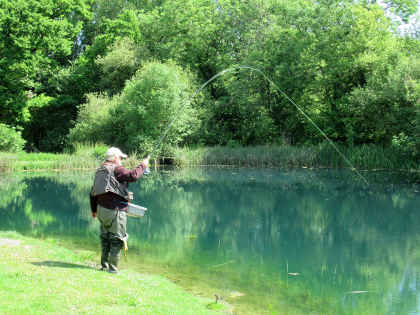
The effect of the rod. The rod is an extension of your arm, a spring for storing energy when casting and, when playing a fish, it also becomes a shock absorber and a means of applying pressure at different angles. Fly rods are chosen first of all for making casts and delivering flies; modern carbon rods are tending towards fast actions with most of the flexing taking place in the tip or upper third. Compared to the rods we had 50 years ago, the results are now remarkable if the caster has the right technique. However, once playing a big fish, a time when the rod is mainly wanted as a lever and a shock absorber, oddly enough an old-fashioned through-action rod makes life easier. With a stiff tip-actioned rod, a sudden lunge from the fish will require skill from the angler who must respond by releasing line. A soft through-actioned rod which bends right down into the butt will absorb some of the force of the fish, even if the angler is inexperienced and fails to release line promptly. I sometimes take disabled children fishing on a small rainbow trout pool and we use an old fibre glass through action rod from the seventies. This floppy rod is horrible to cast with, but combined with a fairly heavy tippet it is just the ticket for a beginner gaining the experience of playing a 2 pound trout for the first time. The tug is the drug; we all like that wonderful feeling of vibrating life through the rod when we have a fish on and they are no exception. "Now tell me if that wasn't fun?" I always ask them after their fish is netted. When selecting a rod, you might like to bear in mind this aspect of its functions and note that, for many of us, a middle to tip rather than a tip-action weapon is the more useful tool for daily use.
Rod angle. The angle at which you hold the rod affects the amount of pull you can apply to the fish through the line. If you hold the rod vertically, at 90 degrees, you are comparatively safe in that the full spring of the rod is available as a shock absorber to cushion against any sudden movement of the fish. On the other hand, you will apply very little force to the fish this way and what pressure there is all comes on the top section of the rod. If you pull hard into the fish with the rod at 45 degrees, the butt section now comes into play and significantly more power is applied to the fish and is likely to wear it down sooner. On the other hand, you now have less safety "shock absorption" reserve should the fish make a sudden lunge for freedom. In any case, the rod, even a salmon rod, applies much less pull than you might imagine. Try pulling with the rod and line on a set of scales tied to a fence post and have somebody read off the maximum poundage you achieve; you might be surprised at how little it is. It is possible, of course, to hold the rod back well beyond the vertical 90 degrees mentioned. This used to be called "giving a fish the butt" and in fact it applies very little effective force. It also puts a huge strain on the rod and can even result in breakage. However, especially with longer rods, it almost inevitably occurs for a moment while netting a fish. Be careful! Also, be aware that for much of the time you will not be holding the rod vertically, but sideways. This side strain is judiciously applied in constant attempts to pull the fish off balance and divert it from its intended direction. Overall, I spend much more time applying side strain than holding the rod vertically.
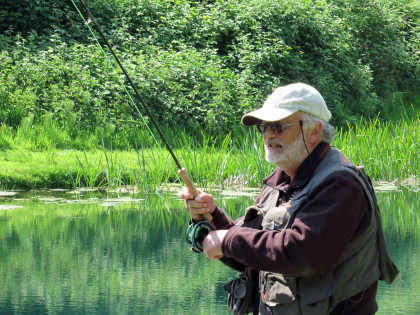
Holding the handle. You should avoid holding the rod in such a way that the handle flops around in your grip. That will result in bad casting at least. But especially when playing fish with a single-handed rod, make sure you have your thumb pointing up the back of the handle, 180 degrees away from the front of the rod. This is the easiest way to keep the handle, wrist and forearm locked while under pressure.
Rod length and fighting butts. There is an ideal rod length for casting (let us say 9 feet for an adult with a single handed rod). But there may be a good reason for using a somewhat longer rod: for reach when fishing nymphs, for mending line, or even for steering fish when hooked. For reasons such as these, I have quite a collection of 10 foot rods. However, a substantial fish hooked and played on a 10 foot rod has more leverage effect on your suffering wrist and fore-arm than one hooked on a 9 foot rod. Imagine catching a dozen rainbow trout of 2.5 pounds each (no more than average size on a modern fishery) during a morning. That equates to 30 pounds of fish played through your right arm over a few hours. If you don't have arthritis and tendon strain yet, you may have them coming! Manufacturers often add a cork covered extension below the handle and reel of rods over 9 feet long, which does add some support under your fore-arm to ease the strain. Makers of single handed rods intended for sea trout and grilse often used to include quite a large fighting butt 4 or 5 inches long - a good idea to my thinking. Some of these screw on and off. 10 and 11 foot fine tipped rods designed for modern nymph fishing generally don't come with a fighting butt, although I think such an addition would be worth the extra weight. One method to relieve the stress on your rod holding fore-arm, one which I often use myself for short periods, is to take the other hand off the reel for a while and use it to support the butt section between the handle and the first ring. A single handed rod doesn't have to be held with one hand only all the time. The salmon double-hander gives you more options, including holding the rod with both hands while the butt is tucked into your groin.
The first few seconds. This varies between species and even between individuals, but it helps to have some idea in advance what the fish you have just hooked is likely to do. A big brown trout usually takes off like a rocket and without delay. A sudden streak across to the other side of the river is absolutely typical with a good Usk trout and very likely he will be heading for some form of cover such as roots or woody debris. The main thing is that you should be prepared for this sudden charge and also that you have a reel check or drag which doesn't suffer from inertia. A tippet-snapping jolt is the last thing you want as the slack is taken up and the reel begins to spin.
A big grayling doesn't make the decision so quickly, nor is he likely to be so focussed on cover as the trout, but you can certainly expect a determined effort to run downstream in the early stages. Bearing in mind that grayling are very often hooked at range downstream of the angler in a big current (winter trotting for example), that the hooks used are small fine wire affairs and that most (but not all) parts of a grayling's mouth are soft; this puts you in immediate danger. You will almost certainly have to cede line initially to a good grayling and you should be prepared to do so without delay. James Evans, writing of our little border streams in his famous Small-River Fly Fishing for Trout and Grayling, remarked that he rarely had to yield line to a trout but he quite often did for a large grayling. Another point about grayling is that while a trout tends to think of bankside cover or snags as its immediate refuge, a grayling usually looks for the strongest current as the place where it feels safest and will continue to do so for the rest of the fight. And in the case of the grayling with its large sail of a dorsal fin erected, the main current is indeed the place where it can exert the most pressure against the rod. Grayling have to be teased upstream, little by little (much as Mark Twain said that the truth can't just be thrown out of the window, but needs to be teased downstairs, a step at a time). Side pressure from a soft through-action rod is the best way of doing this. I'm reminded that last winter I had a 16 inch grayling turn on the fly and foul-hook itself in the tail; it took me 50 yards downstream before I caught up with it. More about foul-hooked fish below.
The big risk with sea trout (and many or most of them do this) is that of coming to the surface immediately after being hooked and shaking their head violently with open jaws. Of course you can't see much of this in the dark, but it feels just like having a tug of war game with a terrier pulling on an old slipper and you could almost swear you can hear the fish growling while he thrashes the surface to foam. Believe me, you should discourage this behaviour because very often it results in a thrown hook. Holding the fish hard with an upright rod tends to prolong it. The best response from the angler is to cant the rod sideways in order to persuade the fish below the surface and probably to yield some line also. With luck the sewin will set out on its first run, which will much improve the angler's chances.
It's not always the case (see below on playing fish on the reel), but salmon usually take a few seconds after being hooked, as if trying to make their minds up about what to do next. The traditional advice was for the angler to use the time in making his way to a safe position on dry land from which to conduct the rest of the battle. It would be the gillie's job to go down to the water with net or gaff at the end! In modern times when we fish alone, I'm all for retreating to a good stand in the shallows if the wading is safe enough, but if you are propped in a tricky spot amongst the mid-stream boulders, you might just have to stay there for now. With quite a lot of salmon - more than many reporters would have you believe - what now follows is a fairly dour slogging match, with the fish boring down to the bottom or out across the stream in a series of short runs, while you apply side strain and attempt to regain line. Try all you can to persuade the fish to swim up past you, or move below the fish yourself if you can. Particularly try to avoid the fish which "rests on the line" hanging below you. However, a few hot fish do go tearing off in a powerful run which really cannot be stopped at first - and you shouldn't try. The point at which you should begin to apply pressure or the tactics to be used for persuading it back upstream is a matter of judgement - again, see below. Most salmon do not go directly for cover, tree roots etc ... but then again, some do.
It might be worth mentioning the chub, which exists in many of our rivers and is often caught by game anglers, either by accident or design. Even a big chub has a rather unfortunate reputation for being sluggish in fight and so they often are. However, hook one at all close to a snag and it will make a very fast bee-line for it at once. Once in there amongst the branches or the roots, it will miraculously transfer the hook from its own jaw to the nearest piece of timber within seconds. All this happens almost before you realise what is going on, but if you survive the initial rush, the fish will probably be yours without too much further trouble.
Establishing control. Let's be honest; sometimes this is more easily said than done! But you do see beginners who allow the fish to remain in charge all through the fight, reacting to the fish's moves and making no real attempt to dominate the situation. An experienced angler, using the rod as a lever to steer the fish left and right as he wishes, keeps the fish working to tire itself out in the shortest possible time. More to the point, he insistently keeps the fish moving, giving it no chance to rest. Remember your objective is to wear down the fish's strength as quickly as possible until it is ready for the net. The final trick of it lies in recognising that point as soon as it is reached.
Applying pressure and keeping the fish moving. A brave fish, prepared to run, is exactly what we want and probably the safest situation of all. All the angler has to do is keep pulling the fish off balance. He does this by canting the rod over and applying side strain, to the left or to the right as necessary while the fish runs back and forth. The angler should always be looking to provoke the next turn; all he really has to worry about then is keeping the fish out of snags. In a river a fish may circle rather than go back and forth, which is fine, provided the fish is kept working. It may even be possible to persuade the fish to a position slightly upstream of the angler, working in a heavy current while the angler applies side pressure, tiring the fish steadily as the seconds elapse. Less desirable is the fish which makes short and sudden runs, between which it stops for periods of rest. Pike routinely behave in this way as do some trout.
Playing a fish on or off the reel? Some would say, get any loose line wound onto the reel as soon as possible, then play the fish off the reel from that point, with judicious use of the check or palming the spool rim as necessary. That may seem the safe option. However, as you gain confidence in playing fish, you will also gain confidence in dealing with the smaller ones at least, by using your retrieving hand to deal with loose line, pulling it down in stages from the butt ring and trapping it under your rod hand when you are able to gain line, letting it go in a controlled way when the fish really must be allowed to run. If the fish comes towards you really fast, hold the rod high in the air above your head so that you can take large amounts of line with each pull of your retrieving hand.
All this process is called hand-lining. It's often the case that hand-lined fish remain slightly calmer than fish played off the reel, especially when reeling up fast as a fish runs towards you. In this case the motion of the reel imparts a slight jogging movement to the line which does seem disturbing to fish, increasing their level of panic. Again, there are other risks to consider. If you are wading in the river playing a decent fish by hand-lining and with a big loop of free line trailing below the reel in the current, there is always the risk that the fish will jump into the loop. This has happened to me on several occasions with a fair amount of chaos ensuing. These days I tend to hand-line rainbows, for which I normally use 5 and 6 weight rods, unless one makes such a run away from me as to use up all the loose line, in which case I play it on the reel from that point onward. This is partly because I don't mind so very much if a rainbow comes off, so perhaps you can put it down to laziness on my part. Using my mostly 4 weight river rods, I'm likely to play any trout or grayling larger than 15 inches or so on the reel. An Usk trout of 2 pounds or 17 inches can be quite a determined opponent in the early stages of play. I wouldn't dream of trying to hand-line a sewin in the dark; the situation then can become quite complicated enough and very quickly too. Similarly with salmon of any size I get the line back onto the reel with the drag appropriately set as quickly as I can possibly manage. I once had a fresh salmon of about 18 pounds take a tube fly in a fast, shallow run I was wading above a deep holding pool. I had already retrieved a fair amount of shooting line which I was holding trapped against the cork handle. The fish was off downstream like greased lightning, the shooting line sizzling up to the butt ring between my hand and the handle. Once it reached the deep water where it felt safe, the fish turned and I was able to play it successfully on the reel, but the burn marks on my hand lasted for a couple of months.
The effect of current. Fishing a river rather than a lake, the current forms that interesting and all important extra dimension. While playing a fish, the force of the water can obviously work for you and against you. Without exception, I would rather be dealing with a fish which is upstream of my own stance. This can work out often enough if fishing an upstream dry fly for trout. After hooking it, you will naturally enough be pulling downstream which will encourage the trout to stay upstream, so that it will be forced to fight the current as well as your own efforts. A trout kept swimming steadily against the current until it tires is ideal. In this way, the fight can be shortened considerably. On the other hand, a big trout may very well bolt down past you in the early stages, in which case the odds will change rather, particularly if he has knowledge of a nice snag to dive into. Grayling always use the current against you, so that I am much relieved once I get the fish upstream of my own position. The current also plays a huge part in playing a salmon, particularly in the upper Wye where we have some powerful runs and falls. Again, I would do everything possible to persuade the fish upstream of my own position if possible. To be absolutely fair, nearly all my sewin fishing is done with the fly at night in low steadily moving water, so perhaps I don't pay enough attention to currents as they affect sea trout. They are hugely powerful fish anyway, with or without the current to help them. In the case of all migratory fish, it's worth remembering that a freshly arrived one will be very inclined to head downstream while a stale fish is likely to stay in the pool. Just as in nymph fishing, when playing fish you should be aware of different current characteristics in different parts of the pool. In a run, where water is tumbling under the influence of gravity into the top of a pool, the current at the surface will be as much as three times as faster as the current along the bottom. For this reason, a hooked fish lying at the bottom in a run may not be under much pressure. The same fish swimming at the surface is making big efforts to stay there. A strong salmon swimming at the surface of a fast run is a magnificent sight, but even this big fish will tire quickly. The smooth glide at the tail of a pool is created by suction as water accelerates towards the rapids below, but in this case the current speed will be roughly the same at the bottom as at the surface of the river. A deep dub may not have much more current than a lake.
Fish refuge. Quite apart from fish which try to bolt into snags, there is another hazard which the wading angler should be aware of. If you are in waist-deep while playing your fish, there is a finite risk that your own legs and body will be perceived as cover during the last stages of playing your fish. This applies sometimes to grayling and very definitely if you hook a chub which go for cover anywhere they can find it. Imagine if the fish then snags your waders with a trailing dropper! Try therefore to use the rod to hold the fish well away from your body until it is ready for the net. Once in the upper Wye and using a 14 foot trotting rod, I had a chub of a full 4 pounds decide to bolt between my legs. The situation was a bit chaotic for a while but I did manage to persuade the fish back the same way he came and finally net it. I don't know who was the most confused afterwards, the chub or me, and I was grateful that there were no onlookers to watch this circus.
Adjusting the pressure. This is of course very much a matter for the angler's judgement, but once you are playing the fish on the reel, a number of mechanisms are likely to be at your disposal to slow the fish down while it is taking line without overstressing the tackle connections and hook-hold. The obvious one is the adjustable drag or clutch, with which most modern reels are fitted. Alternatively the reel may have an audible check mechanism which also creates a (lesser) drag effect, quite apart from its main function of avoiding accidental over-runs on the reel. A few reels are thankfully equipped with both. The drag or check may be supplemented by hand or palm pressure on the exposed rim of the winding plate and this is a surprisingly sensitive method of control. In the case of a full cage or a crank wind reel with no exposed rim, it is still possible to apply some braking by putting a couple of fingers into the back of the reel cage and pressing on the rotating drum with its line pack. Personally, I'm quite happy to work with a click check reel with some carefully applied hand pressure on the rim as needed. If the reel has a drag, these days I tend to leave it on a fairly light setting and supplement with hand pressure, again as needed. (With all reel drags and in the interests of extended reel life, after fishing remember to store them with the setting dialled down to zero).
Quite apart from the reel, you can vary the pressure you are applying to a running fish by the angle at which you hold the rod. If you hold it vertically, the pressure will be much increased by the friction drag of the line rubbing against all the rings. If you drop the rod to 45 degrees this friction will be much reduced. The reduction will be even greater if you drop the angle to zero, pointing the rod straight at the fish while the reel is unwinding so that ring friction is reduced also to almost nothing. You might choose do this in an emergency when a fish really takes you by surprise, but be very sure that you have the line evenly wound on the spool because any checks or jerks caused by trapped coils are likely to be disastrous.
Most dangerous situation. This is worth repeating, because it catches so many beginners out. Early in the fight, a strong fish makes a sudden dash and pulls the rod hard down so that all flexibility is lost. The rod "locks up" as we say. You should be ready for this and you must respond by yielding at least some line to the fish, or the hook-hold or tippet will fail.
Thrashing on the surface. This may occur at any stage in the fight, but it is always to be considered dangerous as far as the hook-hold is concerned. Salmon, trout and grayling all do it at times; generally the best remedy is not to hold the fish too hard and to cant the rod over sideways to encourage it down from the surface. Again, as far as the hook-hold is concerned, a steadily swimming fish is a relatively safe fish and ideally it should be kept that way until it shows signs of being ready for the net by losing its balance and starting to keel over on its side.
Head shaking. All large fish do this to some extent when hooked, but salmon and rainbow trout are particularly liable to do it over extended periods. I have an idea that cock salmon are more prone to angry head-shaking than hens. As with thrashing on the surface, head shaking is dangerous to the hook-hold. There is a limit to what can be done about it, but I would try to provoke a run and keep the fish busy.
Drowned lines. In every way a drowned line is dangerous. As fly-fishers using relatively thick casting lines (a floating line is even thicker than a sinking line), we are particularly at risk. The problem is that the drag caused by a huge curve of line being trailed through the water behind a running fish removes almost all flexibility from the tackle. Many yards of drowned line trapped under the surface become almost rigid and applies growing pressure to the fish increasing the existing panic even further. The normal reaction of the fish is to head to the surface and jump against the direction of pull. With the line behind it almost completely lacking in flexibility, that jump has a very good chance of breaking the hook-hold loose. I have seen it stated - and I think I agree - that the trout angler who lets a big fish take him right into the backing in the first run, probably has a less than 50/50 chance of netting that fish. The inertia and weight of the drowned fly line is the main reason. It is not an ideal situation for the salmon angler either; there is very little control with the backing out of the tip ring. This unfortunate situation usually happens if the fish is hooked at a considerable distance or makes a very strong first run. Neither of these circumstances is totally avoidable, although one can certainly be caught out. Many years ago, when my eldest sons (now both in their forties) were small boys, they used to take turns to come with me boat-fishing on Bewl Reservoir in Kent. We normally shared a rod; I would cast the heavy gear and we would take turns to retrieve. I cast a line out for Steven one morning, handed him the rod and started to pour a coffee from the thermos. "Dad, something funny is happening," he said after a few seconds waiting for the line to sink. I looked over his shoulder, trying to see what he meant by this, when suddenly a fair-sized rainbow came flying out of the water straight at us and flopped into the boat. In its jaw was our fly and behind it was the leader and the sinking line which was now trailing in a huge U-shaped bight. Somewhat bemused for the moment I tapped the fish on the head while Steven reeled up. I realised that the fish had taken the fly on the drop, hooked itself against the weight of the line, panicked against the growing pressure and finally jumped...right into the boat! "That's the equivalent of a golfing hole-in-one," I told Steven. "I bet you won't do that again." Nor have either of us done it again, at least not as yet!
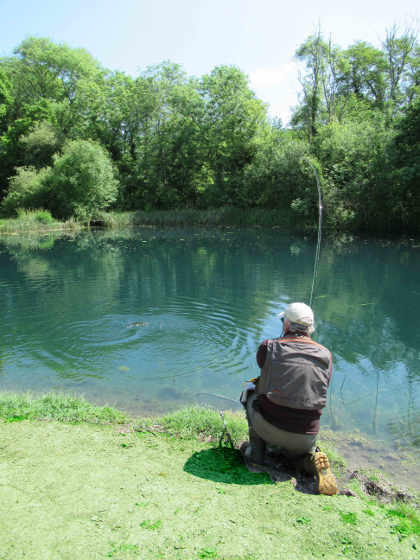
Degrees of panic. You would think that the moment a fish feels the hook it would be terrified and go absolutely crazy. That can happen of course, but very often it doesn't, or not at first. Sometimes I have the distinct impression that the fish has no more than a mild concern that it is restrained or tangled in something which interferes slightly with where it wants to go. Most of us have come across a fish which is netted quite easily, but then seems to wake up and thrash the water to a foam while in the net. If a fish hasn't quite tumbled to what is going on, I am all for keeping the fish relaxed as long as possible. Try to make your handling smooth and systematic. The fish surely isn't happy, but we know that certain things induce extra panic, and one of these is shallow water. If possible, play and also net your fish over deepish water where it feels safer. Don't go looming over your fish, adding the frightening sight of your own person to its existing fears. If I'm fishing from the bank I go down on one knee when the fish gets near and stay low thereafter. Above all, don't go scooping for your fish early with the net; that way the moving net becomes an object of fear as if it were a predator itself. Fear of the net can add minutes to the fight or even lose it. Use the net as a trap, keeping it low and still until you have drawn the fish over it and a final lift and capture is certain.
Leaping fish. Game fish, of course, are famous for leaping. Salmon and sea trout do it regularly as a matter of course and brown and rainbow trout, quite often. In ordinary life a leap may be an expression of irritation, an attempt to rid the fish of parasites, necessary for an upstream spawning journey, or even - who knows - an expression of sheer joy. So much for a fish's ordinary life. Hooked rainbow trout leap in lakes and tiny brown trout leap in brooks. It may happen anyway, but in fact an unwise amount of additional pressure put on by the angler will very likely provoke leaping. (Professional angling photographers will sometimes ask anglers playing fish to hold hard so that they can get the aerial photograph they want – which I find quite annoying). In any case, be aware that leaping fish are a moment of danger for the hook-hold and caution is advised. Fish can leap under the rod top or, even worse, many yards away against the dead weight of a drowned line. "He jumped himself off on the far side of the river" is something you hear often from salmon anglers. Traditionally, big game and salmon anglers were advised to "bow to the fish" and drop the rod to slacken line as the leap occurred, thus momentarily reducing the strain. I can see the logic of this, but I never seem to remember to do it in the heat of the moment. What is noticeable is that when big fish jump against a taut line, the line itself usually pulls them off balance in the air. The fish seem to find this disconcerting and it certainly takes some of the steam out of them. This is the plus side of fish leaping during the fight. Every leap which the hook-hold survives results in a fish which is reduced in strength, although on occasion I have counted half a dozen or more in a row. (The other day, a fit spring rainbow I had hooked took to the air more than a dozen times). Incidentally, the feel of a big sea trout hooked and leaping in the dark is never to be forgotten. A sort of vibration begins on the line, felt in turn down into the rod, which is caused by every muscle in that powerful body flexing at speed as it drives towards the surface. A soaring moment and then the crash as the fish comes down on its tail. Even on a night when the shoalies are leaping free, you hear a whirring sound from the vibrating tail while they are in the air. They must look like flying fish at that moment...if only we could see them.
Incidentally, I have seen it stated more than once that grayling don't leap while being played. That is nonsense; a big grayling will often leap above the surface several times, especially towards the end of the fight. Again, this is a message that a bit too much pressure is being applied, perhaps by an angler in a hurry. Remember that tender grayling mouth and be careful. To the best of my knowledge chub never leap, but carp sometimes do, not when hooked, but on windy days in the middle of the lake, as if for sport. A hooked pike can walk on its tail. But I think we are getting too far away from our main subject...
I think my summarised advice about a leaping fish must be that if it happens close to the rod, use a little less pressure and encourage the fish down from the surface by applying side strain with the rod. If it happens far away against the dead weight of a drowned line, assuming you survive the first leap, hold the rod high and take steps to get that line up into the air as soon as possible until you can see the leader cutting the surface.
Sulking fish. Salmon are sometimes prone to this and large trout also on occasion. What happens is that the fish, still strong but alarmed by the sense of being tethered, finds itself a place against the bottom where it feels safer and holds there without moving. This is all the easier if it the fish finds its way between rocks or other obstructions. You apply pressure, but the fish refuses to move on its own account and the rod itself does not apply sufficient pull to start the process. It's a dangerous situation because the fish is now resting, recovering its strength and you may eventually be properly snagged in underwater obstructions. Some interesting advice has been given about this situation in the past, including having something like a curtain ring which can be clipped to the line and slid down until it bumps the fish on the nose and surprises it into moving. Tapping the rod on a tight line is said to send a vibration down to the fish which might be annoyed enough to move, but this has never worked for me any more than leaving the fish a slack line for a while. Stoning the fish, which also would be advised traditionally, is illegal today. I once saw a carp moved from a tangle of willow branches by half a brick being heaved in. My suggestion would be first to try applying strain from different angles, by walking up and down the bank. If that fails, try hand-lining with a direct pull, again from different angles. Obviously this puts the hook-hold at a certain amount of risk, but this is the last resort and you may have no choice. Get the fish back onto the rod as soon as it starts to move.
Pumping a fish. Sea anglers who fish down into the depths from a boat know all about this. If you feel able to gain line against a resistant fish, which is nevertheless not swimming towards you, use the rod rather than the reel. A reel should not be used as a winch. From a high position, lower the rod towards the surface winding in the slack as you go so that pressure is maintained. Then, with the reel stationary, raise the rod steadily so that you bring the fish a yard or two nearer using the power of the butt section. Lower the rod again, winding in as you go, and repeat the whole process. Be ready to react to any sudden movements by the fish, such as a new run. This is a good tactic to use with any set of fishing tackle, but with a reel involving multiplying gears (such as a multiplier or fixed spool reel used for salmon spinning) it is absolutely essential.
Walking a fish. Hugh Falkus wrote a good deal about this. For reasons which I have never quite been able to understand, powerful fish which are still ready to cause all sorts of trouble while being played on or off the reel, sometimes become relatively docile if you just hold the rod high and go on a little walk to adjust your own position on the bank. Something about the steady pull thus applied must be calming, because after a second's hesitation the hitherto angry fish often follows along like a dog on a lead. There are obvious uses for this ploy, if for example there is a much better netting place on the bank than opposite the spot where the fish was hooked. Also, fish which have been walked for a while seem to be rather more controllable thereafter. Falkus was writing about salmon, but other game fish seem to react in much the same way. I once successfully walked a big lake trout more than 50 yards along the bank, simply to reach the place where 10 minutes earlier I had forgotten the net.
Throwing slack line on a fish. This really applies to salmon. I used to fish a beat where the two best taking lies were both in pool tails immediately above fast running gutters. If conditions were right, these places would hold resting fish which had just come up the gutter. When hooked, the immediate response of a high proportion of these fish would be to run immediately downstream and descend the gutter they had just climbed. Unfortunately, in both cases a difficult and dangerous scramble was involved for an angler who wanted to follow the fish down. The scramble was reserved for desperate cases. On the other hand, a stand-up fight with a freshly-hooked salmon having a powerful current pulling on its side while the angler is trying to avoid conceding a yard of line is never a very good idea. What did work quite well, however, was to strip line off the reel as quickly as possible and throw it on the surface. With the upstream pull removed, the salmon would cease its desperate struggle to go down in the opposite direction, turn round and face upstream again. If enough slack line was thrown on the surface to drift down and form a belly in the current below the fish, it would begin to feel a downstream pull. Usually it would react against this by moving slowly upstream. By repeating this once or twice, it was usually possible to "tickle your fish" further upstream from your own stance to a position in the upper pool where the contest could be brought to safe conclusion. This tactic worked almost as well when spinning the same places with a fixed spool reel. When attached to a salmon making a determined bid to go downstream, the solution was not to screw down the drag and hold on tight. Instead, assuming the hook was properly set, if the drag was slackened off completely you could rely on the fish turning and eventually heading back upstream. You could then re-apply the drag, wind down on the fish and recommence the conflict. Personally I would not recommend this tactic when using barbless hooks... which we may all be doing soon according to NRW's projected new by-laws.
Incidentally, the "throwing down line" tactic is used by some anglers of the "no strike" school to hook salmon in very fast rivers. The idea is that when you see the fly taken by a fish you respond by stripping lots of line off the reel and dumping it onto the surface. You don't tighten at all, but while the salmon holds onto the fly, the line collects in a loop below the fish and drags the fly down into the corner of its mouth. It is in fact the power of the current which sets the hook.
Line flex. It should be remembered that most fly lines and nylon for casts incorporate an element of stretch when pulled hard. Typically this is about 10%, but it varies between brands and some lines with a braided core now have the selling point that they stretch very little; this is supposed to be very good for detecting takes promptly. If a long line is out (but not drowned), the elastic stretch capability can be added to the flexibility of the rod tip in providing a shock absorber effect, protecting the tippet and the hook-hold from sudden jerks. If the fish is closer to the angler on a short line, however, the elasticity is obviously very much less. From Roman Moser and other sources a material called Shock Gum is available. This has the characteristic of stretching to a certain percentage above its original length, and then suddenly locking up. Thus a section of it can be included between the line and the leader butt in order to increase the overall elasticity. Using Shock Gum, it might be possible to get away with a tippet one or two sizes thinner than could otherwise be used. John Goddard used to be a great enthusiast for this material.
Hook-holds. There is a case for stating that, once a fish is hooked, the hold is either secure or not and there is then not so much that the angler can do about it. In fact there are things which the angler can do to help the situation especially should the hold turn out to be a tenuous one. Remember that, every time the fish makes a turn, the hook levers round in its jaw to take a new direction of pull. Therefore, the longer the fight goes on, the greater chance there is of the hook pulling clear from an enlarged hole as the angle of strain goes back and forth. If you want to reduce the leverage effect, there is a case for tying your flies on short or standard shanked hooks rather than long-shanked lure hooks. As already explained, take steps to avoid frantic thrashing on the surface and bouts of head-shaking, both of which can easily destroy light hook-holds. The other time of great pressure on the hook-hold is that last moment before netting, when the line is shortened and the rod is moved back over your shoulder to draw the fish over the net rim. This is a time of great danger, as all the flexibility in the shortened line and bent rod has already been taken up. The head of the fish may even be raised up by the line slightly; all it takes now is for the fish to give a last shake of his head, the hook will pull out against the tension and all is lost. Particularly to be avoided, should you be wading in a strong flow, is to end up with the fish lying downstream and try to drag it head-first up towards the net against the pull of the current. This doubles the strain on the hook-hold. Instead, always try to persuade the fish to swim up past you so that it can eventually be netted from below, tail first if needed be. Some suggest that netting a fish tail first is dangerous as it might be prompted to kick out before it is fully secured; however, that has not been my experience.
Mud and weed. Visibility through the water, whether muddy or clear, makes a big difference to the way in which fish behave. If water is deep and clear, hooked trout will work up to a tremendous speed when they make a run; boat fishing in reservoirs is a very good way to experience this. In murky water they are generally much slower and more circumspect and I suppose this is quite logical; I presume that like motorists travelling in fog, they don't want to run into an obstruction and knock themselves silly! (However, I'm reminded that in a shallow and muddy farm pond many years ago, wild carp used to achieve runs of a terrifying speed within a couple of seconds of being hooked. I have heard it said they can achieve 40 knots. Maybe they had other means than eye sight to find their way?) Meanwhile a muddy patch in the margins can be a useful place to net a somewhat disorientated trout. The famous salmon angler Robert Pashley made use of a shallow and muddy area on the edge of one of his Wye pools. Towards the end of the fight, when he was due to net or gaff a fish, he would stamp around to scuff up the mud in order to make the final stage easy.
Weed is, for obvious reasons, dangerous to an angler playing a fish. To some extent this depends on what weed is involved. In lakes, trout soon learn to dive into tough stuff like Elodea or Canadian pondweed, which grows in thick masses by the ton (and is very difficult to get rid of). Some would suggest allowing the fish slack line to see if it will come out, but this does not normally work for me. Using the alternative method, I usually manage to hand-line fish out, but fish are easily lost in weed, particularly if droppers are used. Water lilies are also dangerous due to the toughness of their stems (although wild brown trout in upland lakes do like to hang around lily beds). Hornwort is thick, but doesn't root, so it is less troublesome. Similarly pickerel weed and water milfoil are comparatively flimsy. You can play a fish through a bed of water milfoil with the leader cutting through vegetation like a cheese wire and amputated weeds rising to the surface behind. Bear in mind that a fish which accidentally collects a piece of weed to obscure sight by covering even one of its eyes, usually gives up at that point and can quickly be drawn over the net. Most of our rivers do not carry dense beds of vegetation and so weeds are not a huge problem when dealing with our trout and grayling. The middle and lower Wye, where there is a lot of ranunculus, is the main exception, but I haven't found the salmon we cast for here are particularly prone to dive into weed beds. The chalk streams are a different matter; thick beds of weed grow naturally there and many fish are lost in them. The science of cutting weed beds, which affect water levels, trout food production and the beats downstream is an integral part of chalk stream management.
Foul-hooked fish. It happens, although it shouldn't, and it certainly shouldn't happen deliberately. Sometimes the fish makes a close pass at the fly, misses it and hooks itself in one of the fins. Or it takes the fly, you tighten, the hook fails to catch in the jaw and ends up somewhere it shouldn't. You will quickly learn that while a fish hooked by the head can fairly quickly be dominated and steered with the rod, there is very little which can be done at first to control a fish hooked by the tail or the dorsal. For a time you think you have something twice the size it really is. However, note that you will not feel the usual rhythm of the swimming fish transmitted by the line from the head - with experience a foul-hooked fish should be recognized for what it is fairly quickly. What usually happens is that the fish makes a series of runs downstream. With difficulty you manage to stop each one, but the fish is left hanging head downstream in the current and drowning as it cannot breathe properly. After a few seconds to recover its strength, it will probably try to run again. I usually try to deal with this by scrambling down the bank to get opposite or below the fish and haul it in as best I can and as quickly as I can. I once accidentally foul-hooked a large grass carp (in the dorsal fin) while fishing a sinking line in a lake for trout and a rather nerve racking 10 minutes followed.
Tangled fish. Brown trout in rivers are sometimes prone to do this. For some reason, certain fish react to being hooked by thrashing and rolling in the current. As a result, a wet fly leader, for example, can get wrapped several times round the front of the body, the pectoral fins and even round the head, closing the fish's jaws so that it cannot breathe. A fish tangled in this way rarely puts up much of a fight. Best to get it into the net as quickly as possible so that it can be unravelled or the leader carefully cut away.
Bringing the matter to a conclusion. The right moment for achieving this is the 64,000 dollar question. Dating from days of yore when most fish were killed, you would read exhortations that the fish should be completely quiescent, lying on its side, before the net or gaff was extended. Tailers and gaffs were designed for killing fish and are of course outlawed these days. Otherwise, I would suggest that if you keep playing the fish until it is permanently on its side with no risk of movement, you may very well have gone on far too long. Recovery then is likely to be extended or totally compromised. On the other hand, a fish which is still upright, still swimming and watching for escape opportunities, should not be netted. Trying the net too early is a very good way of losing fish. But once the fish begins to lose its balance for a few seconds at a time, particularly when the head is held slightly above the surface by the leader, then you start to have opportunities for netting. Be aware that a fish which is swimming at the surface most of the time cannot really get a grip with its fins, so it is already in trouble. Don't take a chance, but take the first opportunity, as driving instructors say about negotiating road junctions. Don't create extra fear by scooping with the net, and certainly don't prod the fish or the leader with it. Instead, lay the net below the surface keeping it still as a trap, skate or draw the fish over it along the surface and lift firmly and quickly when you have the fish squarely in position. Ideally you don't want the fish to see the net until he is inside it. All this is much better done from a position downstream of the fish if you can manage it. There is always a temptation to dispense with the net, particularly in the case of salmon fishing, when the net constitutes a relatively heavy burden. However, in these days of catch and release and concern about damaging the flanks of fish, I always feel happier when using a net, even when a shingle beach is available. Once you have it in the net, slacken the line at once to protect the rod tip. Don't lift the net out of the water but bring it to the marginal shallows where measuring, unhooking, photography if required and recovery can be dealt with as quickly as possible, meanwhile keeping the fish in the water. Please don't lay live fish on grass or dry stones under any circumstances. All these activities have been discussed on other occasions.
Tenkara rods, trotting rods and other exotica. The Tenkara rod is a delightful thing, long and light and so easy to carry and handle. Lacking the weight of a reel and rod rings, effectively you pay for the lightness by giving up the possibility to extend and shorten line as you fish. What matter, you may think, with this long light rod I surely have all the range I need? It's easy to hook fish with the Tenkara rod and you quickly find that it will play a heavy fish quite well, despite there being no possibility to yield line. Mine is a 12 foot 6:4 action rod, feels to be something equivalent to a conventional 2 weight, and has managed to deal with every heavy grayling I have come across with it. The fact that I can't yield extra line doesn't really seem to matter because the almost infinitely flexible rod, although bent to a hoop shape, absorbs and takes the steam out of the heaviest plunges. I can add yet more flexibility by yielding slightly with my hands if need be. You can also move your body slightly in tune with the plunges; sagging momentarily at the knees may be enough to absorb the shock and turn the fish. I know people who have played salmon successfully with Tenkara rods. Where it gets tricky is when the time comes to net the fish. Newcomers to Tenkara fishing usually make a simple calculation about this. Let's see, they think to themselves. A 12 foot rod combined with a 12 foot leader. That should be alright. I just hold the rod up behind my head and reach out with the net, yes? Well, actually no, because the rod will be significantly bent. So you hold the rod up behind your head and reach out with your net, but the fish is still 3 or 4 feet away. What you must do, strange as it may sound, is make a sensible judgment about when sufficient steam is taken out of your fish (which doesn't take long with a Tenkara rod). At which point you hold the rod back until you can grab the leader as close to the fish as possible and then quickly steer it into the net. Make it quick and all will be well, or at least 9 times out of 10 in my experience.
The new specialist nymphing rods are getting more and more like Tenkara by the day and we now have 11 foot 2 weight rods designed for this branch of fishing. Fish are usually hooked close at hand and are played close at hand in very much the same manner as the Tenkara enthusiast employs. In this case line can be ceded from the reel of course, but this is not often necessary. A long soft rod tip, good for playing fish, is also very good for keeping barbless hooks in contact; not many will come off.
Long trotting for grayling (or chub for that matter) is a very different affair. You are likely to be working at two or even three times the distance in which you might fly-fish. The first thing that will strike you is how very easy it is to hook a fish once the float disappears. Then you feel your fish, with surprising sensitivity given maybe 60 yards of distance, and realise that even a modest grayling feels powerful in a winter current. You may well have to yield line for a few yards during initial downstream runs. I know, because I have watched them from above, that the grayling will have curved its muscular body into an elongated S-shape, using the current against its own body as well as that big dorsal fin in order to resist you every foot of the way. So now you have to recover that 60 yards of fine nylon, taking as long as it takes, always aware of the fine wire of the hook which may open and of that down-angled grayling mouth which is mostly soft (although there is a gristly spot on the upper jaw). It's very easy to lose a grayling hooked a long way downstream. I usually engage the check on the centre pin reel as soon as a fish is hooked, just to avoid any overrun accidents if my hand slips off the spool. I usually cant the rod over sideways, holding it in two hands as I work the fish slowly upstream, feeling the level of resistance as it tacks back and forth. Having a rod with a through action is a tremendous help at this stage, although they are now difficult to find; most modern float rods have a tip action. Once you have persuaded the fish past you in the current, the odds are in your favour.
Lakes and playing a fish from a boat. Generally you are advised to keep a fish to windward when playing it from a drifting boat in a lake or reservoir. It all gets more complicated if it turns out to be a big one and you are alone in the boat, particularly if drifting onto a lee shore in a strong wind. A drogue towed behind you can also make life more difficult. My experience with rainbow trout in reservoirs is that the open space and clear water means that they are often prepared to make really long and powerful runs. They may also be prepared to sound deeply. I find that one big danger when playing rainbows when afloat is that the fish takes shelter under the boat and decides to stay there. Meanwhile you contemplate the possibility of a trailing dropper fouling the keel. Usually you have to put the rod right down into the water and apply side-strain to get him out into clear water. Some would suggest stamping on the bottom boards to scare him away; something which of course you should never normally do. A fairly long handled net is useful while fishing from a boat.
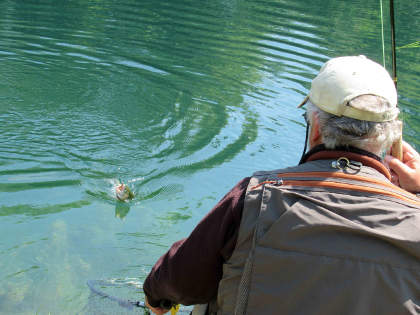
Final thoughts. To be honest, despite having fished all my life, I always start to feel as anxious as any beginner once I realise that the fish I am attached to is a big one. I'm exactly the same when a client is in the hot seat. Will anything go wrong? Will I make the right move with the net, timing it neither too early nor too late? There is a rather nice story about Frederic Halford and friends who invited the famous northern angler Francis Walbran to the Test in order to observe his methods with spiders and trotting gear. This occurred in November 1891. Walbran impressed them all with the number and quality of grayling he caught trotting with a worm. Walbran was impressed in turn with Marryat's demonstration of wonderful fly casting and stated that this man's skill with rod and line was "worth going from Yorkshire to Hampshire to see." Then, on his last day, Walbran hooked a very big grayling on the worm in Houghton mill pool. Halford got the first look at the fish as it passed him and spoke nonchalantly: "...about 2 pounds, I think." Walbran wasn't at all sure about that idea as the fish was giving him all kinds of trouble and he would have remembered at that moment that he was using very fine gut. Eventually Halford netted the fish out while it was weeded and it weighed 3 pounds 9 ounces. It measured over 19 inches from the neb to the last scale on the body (not the centre of the tail fin). Halford later explained that he hadn't wanted to unnerve his guest at the critical moment of the fight by revealing its true size early. Very thoughtful and very wise, or so it seems to me.
Tight lines for the June fishing!
Oliver Burch www.wyevalleyflyfishing.com
April 2018
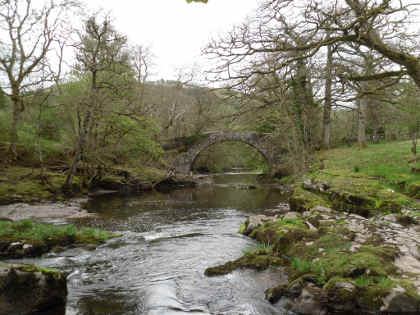
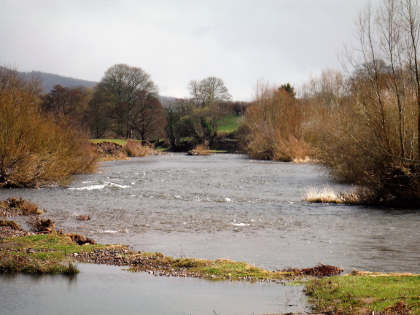
There were a few red letter days in April, but results were also disappointing for many of our trout fishers. For much of the month the lower parts of the main rivers were in flood due to continuing showers onto saturated ground. Continuing cold winds and temperatures weather resulted in the tributaries being slower than usual to wake up and then, as if to add insult to injury, an unexpected if brief heat-wave and bright sun inhibited fly hatches for several days. Most of the angling concentration was inevitably on the middle and upper Usk and most of us, myself included, had been hoping for hatches and good dry fly sport. Even on a well-known beat, this can be a bit of a lottery. Sometimes we were lucky, but very often we were not and I think the spring of 2018 has reminded me that you need a "plan B" when on the river in case the little insects don’t appear on cue. For many that will mean a spare rod made up with heavy nymphs; in my case I often found that a team of spiders on the spare rod helped out when rises were not apparent. For salmon anglers, by contrast, the wet weather and high water levels made the early season quite interesting and springers seem to have been spread well up both rivers. Overall numbers caught have been low so far due to difficult river conditions, but they included some superb three sea winter fish which will have resulted from the successful 2012-13 spawning season.
Let's start with what happened during a wet and windy Easter with all our rivers running high. These were the same difficult conditions we had experienced throughout March. However, we now began to receive just a few of the reports we had been waiting for since the season opened. On Good Friday, March 30th, regular angler AS of Newent fished again at Dinas and caught 7 trout from 12-17 inches, 5 on heavy nymphs and 2 on a CDC March Brown dry fly. He reported a few large dark olives and March browns hatching, but generally fish were not very inclined to rise, still "...not playing ball," as he put it. On the same day, JL from London fished the Gliffaes Hotel water further down the Usk and experienced a very good large dark olive hatch between 1 and 2.30. This one did bring fish to the surface and he was able to make full use of the dry fly. He caught 6 excellent trout including two at 17 inches and one at 18 inches, all on a dry Comparadun: "...wonderful fishing for a cold day in March." Meanwhile AL from Swansea had 6 rainbows from the Usk Reservoir while CP visiting from Colchester caught 2 rainbows, a brown and a perch. On the 1st April, Easter Sunday, SB from Neath fished at Brecon town and had 7 trout during a large dark olive hatch (note that the section mentioned above the bridge is, I think, still restricted to town residents). NM from Shoreham fished the Breconshire Fishery, catching 4 fish, and also noted large dark olives followed by March browns in the afternoon. Upstream at Fenni Fach, JL from London with a friend saw large dark olives, but few rises. They caught 5 trout between them. HW from Swansea was further upstream still at Trallong and Abercamlais and recorded 4 trout. DP from Aberdare had 5 rainbows from Llwyn On Reservoir.
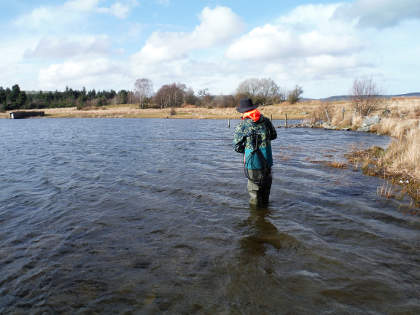
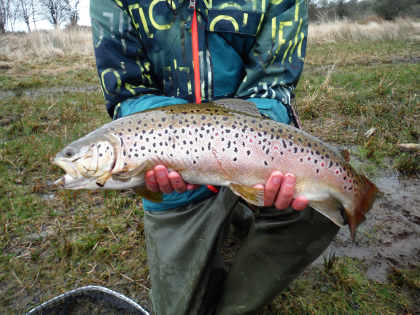
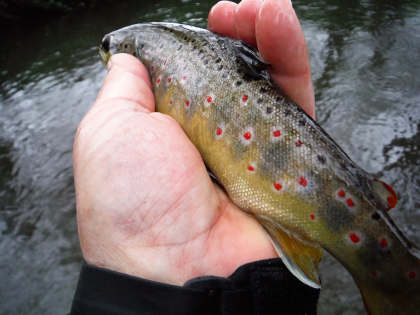
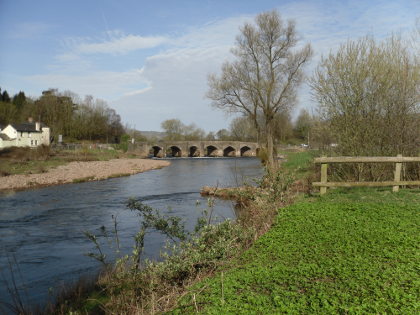
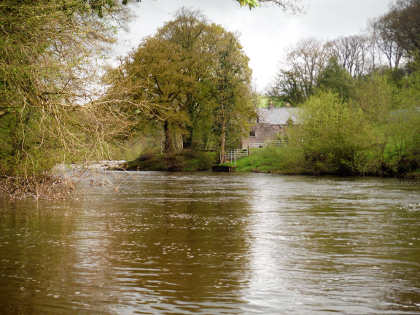
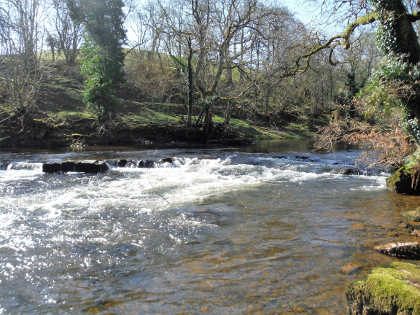
That night everything changed as another big fall of rain and snow arrived. By the morning of Easter Monday, the hills were pure white above the valleys while the saturated landscape had become seamed with livid streaks of reddish brown and yellow as every stream and river rose into flood, seemingly determined to transport its load of silt into the Bristol Channel. The Usk quickly burst its banks around Scethrog while the following day the lower Wye brimmed over in turn and washed across Herefordshire fields. And it continued to rain as the week went on, so that for a while there was really no fishing to be had, except on still-waters. I had to switch clients from the rivers to lakes, which was nobody's preferred plan. However, I did have the pleasure of netting a brownie of 5 pounds for a teenaged lad who caught it in Llyn Gwyn near Rhayader. We had to tell him that it probably wasn't a native, but still a very nice fish to catch.
On the 6th April, JA from Leominster using nymphs managed to winkle 6 small trout out of the Pinsley Brook, a tiny stream which is never easy fishing. The upper Usk was by now low enough again to be fished, with some large dark olives hatching and a few rising trout in places. Spiders worked for my guests that afternoon. JL from London, who I think booked both Dinas and Abercynrig (just like the good old days if you can afford it) had a fine catch of 9 trout to 17 inches, mostly on the dry fly. A Deer Hair Emerger worked during a couple of March brown hatches after lunch. MJ from Treorchy had 6 trout from Llwyn On. Immediately after this more rain fell and the rivers were once again out of condition. With the ground so saturated, only a couple of hours of rain is enough to send the levels shooting up. On the 8th CT from Cardiff with a friend fished Talybont Reservoir in good conditions - warm, cloudy, with a ripple - and found chironomid midges hatching all over the reservoir. This led to an exciting afternoon. (It's not always appreciated that this lake has a good spring buzzer hatch, almost like the Irish duck fly. I can remember wading a downwind shore at this time of year and finding myself in a massive soup of empty buzzer shucks, large ones at that). CT and his companion had 19 trout from 12 to 17 inches. On the same day PJ from Ammanford with a friend fished at Beacons Reservoir and caught 9 trout, some on emerging midge patterns and some on traditional wet flies. IC of Gloucester had half a dozen trout to 9 inches from the Forest of Dean's Bideford Brook. Fishing at Brecon on the 9th, I was surprised to meet salmon anglers out on the river. This seemed early for so high up the Usk, but I gather several salmon have already been caught around the town and they certainly have had the running water. On the same day a magnificent hen fish of 19 pounds was caught by JD of Ross on Wye while fishing the Mardy beat (above Abergavenny). Apparently it was taken on a sinking line worked deep off one of the croys.
PJ of Ammanford had a very good day at Fenni Fach on the 11th, taking 15 trout, mostly on dries, during a large dark olive hatch. "The fishery came alive" as he described it. From this point on, while the weather remained unseasonably grey and cold, the Usk hatches and fishing results became more consistent. Large dark olives were typically being seen from lunch-time on with March browns mixing in as the day progressed. On the 12th Dave Collins from West Herefordshire had 8 on dries from the Gwent AS water at Gilwern and passed on word of grannom being seen downstream. JR from Innsworth had 5 on dries from the Glanusk Ty Mawr / Canal and Rivers Trust water below Brecon, although he had to keep changing patterns to keep the takes coming. RB from Redditch had 5 from Dinas upstream, again with large dark olives and March browns hatching during the afternoon. During Spey casting lessons at Chainbridge on the lower Usk, although the water was high, we saw all three flies: dark olives, March browns and increasing numbers of grannom fluttering over the banks. A salmon also moved in the pool while were there on the platform delivering a scrap of red wool across the stream. "Why do you need to go chasing off to Scotland?" I asked my client, who was practising with a double-hander for a holiday on the Dee the following week. On the 13th NG from Dilwyn had a very good day on the upper Usk at Trallong and Abercamlais. His bag of five fish taken on dries included two at 16 inches and one at 18 inches. Truly there are not so many rivers in the UK which can offer wild brown trout fishing like that. CT from Cardiff with a friend fished Talybont reservoir again and had 8 to 17 inches.
The 14th was the first really warm day of the year and, remarkably, it didn't rain for once although there was early morning fog before the sun broke through. By now, the upper parts of both main rivers were in reasonable trout fishing condition although the lower sections were still flooding with a fair amount of colour. For sure the levels will stay high for quite a time this spring until the ground dries out. On the upper Wye I saw hatching of all three flies, large dark olives, March browns and grannom too, although the water was still quite cold and only a few out of season grayling seemed prepared to rise. CH from Bromsgrove fished at Craig Llyn with a dry fly and managed just one trout, but it was a real specimen at 20 inches. MF from Cobham fished the Usk at Glan yr Afon and in a catch of 3 had a 17 inch fish on a New Zealand style suspended nymph. HW of Swansea was on the Usk at Penpont with a friend and they had 15 trout to 16 inches, mostly on a CDC Dun pattern during a March brown hatch. NG from Dilwyn (who had a nice springer from the Wye the following day) fished at Trallong and Abercamlais, taking 5 trout to 18 inches. Rain arrived again on the 15th, which started the rivers rising rapidly once more, but not before JJ from Stourbridge had 5 trout to 2 pounds on nymphs from Dinas. There followed a period when not much fishing was possible due to high and muddy rivers and then a heatwave arrived on the 19th which brought air temperatures at a stroke from single figures up to the mid-twenties with a bright sun burning from on high. The hottest April day since 1949 we were told and you can imagine how difficult it was to find a really good day of trout fishing in conditions like these! It was beautiful spring weather with sprays of white blossom and fresh green leaves emerging everywhere, but on the river the hatches slowed down. MN from Bristol fished Fenni Fach on the 19th and got 8 trout, 4 on nymphs and 4 on a Parachute Adams, but noted that while olives were hatching at 8.30 in the morning, the sun had brought action to a halt by midday. On the 21st SF from London fished the Wye at Craig Llyn and apart from out of season grayling got 6 very good trout, "most of the fish were around 2 pounds," which is remarkable in itself. Think about this for a moment. How many British rivers will give you a bag of half a dozen 17 inch wild trout? AS of Newent fished the Llynfi at Pontithel using a team of nymphs on a French leader and got 12 trout from 7-12 inches.
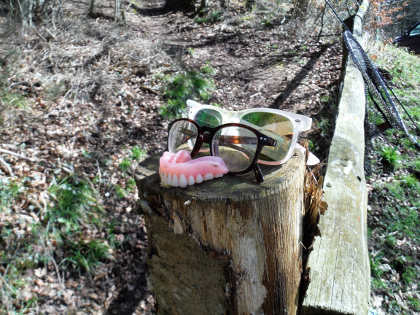
CT from Cardiff fished at Llantarnam Abbey again on the 22nd and had 5 small trout on nymphs. TJ from Crickhowell fished the Usk Reservoir and was one of many who complained about the rubbish being left here, by anglers and others. This seems a great shame and it really is something which Welsh Water should be policing better. Among other items which TJ found by the water was, of all things, an emptied funerary urn. (I'm minded to tell you the story of my Uncle Dennis's remains and their eventual and not entirely successful consignment to the deep as undertaken from a bridge by my aunt, but I guess this is not really a laughing matter). TJ fished with an intermediate line and had a good rainbow and a large collection of perch. On the 24th, VC from Ashford had to work hard at Glan yr Afon where he found a few large dark olives and even fewer rises. However, he did manage a brace of good fish: 1lb 1oz and 2lbs 8oz. PJ from Newport fished the Irfon at Cefnllysgwynne on the 26th and got 9 trout on nymphs. CT from Cardiff had a good evening on Talybont Reservoir and had 15 trout up to a pound, while DR from Bristol fished the Cannop Brook in the Forest of Dean and had 11 small trout to 8 inches on a nymph with a red target spot.
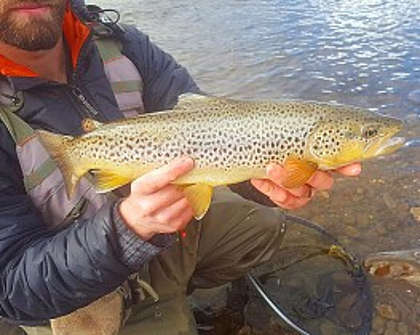
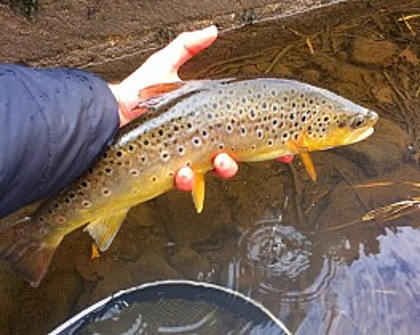
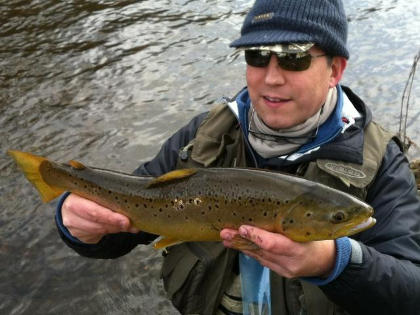
The cold weather came back and with it the rain. It was noticeable that with leaves now beginning to emerge in our valleys and the trees sucking up water, showers did not affect the water levels quite as rapidly as before. Lower parts of the Wye and Usk remained high, perhaps with some salmon fishing opportunities, but there were certainly chances on some days to fish the upper rivers for trout. Unfortunately a north wind kept temperatures low and rising fish were few and far between. On the 27th RB from Redditch had 4 trout from Dinas and on the 28th VG from Feltham caught 4 on nymphs at Glan yr Afon. Also on the 28th, AS of Newent had a very good day on the little Dore at Chanstone Court, taking 20 trout from 6-10 inches with a single nymph. He remarked that there was a little colour in the water and the air temperature never rose above 8 degrees. On the 29th MS from Farnborough had a nice catch of 5 trout between 1 and 2 pounds on nymphs and dries from Glan yr Afon. Finally, and while it may be outside my remit for trout and grayling, it was nice to see an that old friend of the WUF had a fresh salmon of 38 inches taken with fly from Lady Alexander's catch on Abernant. This was KG of Birmingham and I'm guessing this is probably his favourite Wye beat. It's an example of the kind of salmon which have been in the river this spring.
During the month TR of Merthyr Tydfil (I'm guessing that must surely be MTAA Treasurer Tony Rees) sent us some nice pictures of Taff trout and pointed out that this restored river fishes well at this time of the year. He also recommended the Taff Fechan, a wild stream tributary which fishes at its best when the reservoir at the top is over-spilling. While many parts of the main Taff are urban in appearance, the Taff Fechan has a different character as you can see from the photograph. Note that now the Taff Fechan is on the wild stream list we have a much better map available which I am sure is going to be helpful. There are plenty of access points and more than 4 miles of fishing. We had a number of photographs of nice trout sent in from the Taff during the month. I'm not sure exactly who caught what and when, but the message is that the Taff is fishing well and visitors are welcome. I'm reminded of my friend Rob Evans, who a few years ago was invited for the first time to this Valleys river by friends in the MTAA. Rob was fishing nymphs and was, as he described it, "gob-smacked" to hook into a brownie of about 5 pounds. "Welcome to the Taff," said the locals, viewing the impressive fish without batting an eyelid.
Somebody gave me a new tip for repairing leaking waders the other day; I think it came from a letter to Trout and Salmon. The idea is that instead of messing about spraying isopropyl alcohol onto the inside in an attempt to show up the leaking places, never very successful in my experience, you make use of contrasting light and darkness. Simply put, you take one of those garage inspection lamps on a flexible lead and in a darkened room you lower it first into the trunk and then into each leg of the dubious waders, make a mark wherever you can see light coming through and finally apply your glue. These lamps normally come provided with a protective cage to prevent the hot bulb burning the wader material.
The other day one of my lightweight pairs of waders suddenly developed a leak which filled one leg up with water quite briskly. However, I couldn't see much wrong when I looked at them closely, so rather reluctantly I put them in a pile with a couple of others due to go up to Aberdeen for treatment by Diver Dave. Then I was told about the light inspection idea. I don't have a proper garage inspection lamp, but I tried checking them in a rather gloomy store room with my sewin fishing head torch inside, switched to the white light LEDs. The check was remarkably easy; there was a single hole with a beam like a search light coming out of it. I applied the water-proof marker pen followed by a dab of Storm-sure glue and the following day spent 6 hours standing waist-deep in the cold Usk and remained perfectly dry. Next plan was to deal with an old pair of wild stream waders which had already been patched up many a time. I found five pin-prick holes in those and now they too seem to be dry, at least for a while. A pleasing success, I thought, and one not always familiar to amateur wader repairers! Why didn't I think of that before? No, don’t bother to write in with an answer to that question.
Have you noticed the surfeit of capital letters which seem to be thrown around these days? Anglers seem to be departing from the long established customs for describing living things, particularly if they happen to be insects which fish eat. What do I mean exactly? Well, I'm referring to the random awarding of capital letters when referring to insects by their common English names, rather than just when starting a sentence. I'm not sure why it's happening, because there is, or used to be a protocol or at least a convention for the use of capitals which might have been devised for anglers. Now we seem to be uncertain about how to describe these all-important little insects. Take this sentence: "I was on the river yesterday and Large Dark Olives were hatching all afternoon." What is the logic for the capitals instead of lower case letters? In fact why not simply: "I was on the river yesterday and large dark olives were hatching all afternoon?" You would not be likely to write: "We went to the zoo yesterday and saw Lions and Tigers and a Giraffe. And by the way the Daffodils were already out in the gardens."
Use lower case letters for the common English names of living things. "Fair enough, but what about the (M)arch brown?" I hear you cry. Well, in this instance I think I have been getting it wrong. I used to reckon the march word was being used as an adjective, so it should go in the lower case. However, recent advice is that it is a proper adjective and therefore should be capitalised. So March brown it is, after much discussion. Editor Seth and I had a debate about this a while ago. Sad, you say and have we nothing better to do? Perhaps I am being pernickety here, but never mind, I have started so I will finish. Now then, if you want to describe a living organism by its binomial Latin name, the convention (since Carl Linnaeus I think) is that you use a capital letter to start the first word defining the genus, but lower case for the second word defining the species. So our friend the large dark olive described by taxonomists is Baetis rhodani. No, I don't know why; that is just the way it is.
Names of artificial flies, on the other hand, whether Dunkeld or the Mosely Mayfly or even Moonlight on Mrs Higginbottom (which must be my all-time favourite fly pattern name), are proper nouns and always merit capital letters. For example, if your name is Alfred Norman Other and in your own personal attempt at immortality you have just come up with a fly pattern to imitate the large dark olive, you will be expected to award capital letters to the proper name which you give your invention. This applies even if you name it after the insect which it imitates. So your new fly pattern will become known to history as the Large Dark Olive by AN Other. Are we all clear, so far?
While I am on the subject of patterns and descriptions, I might also mention there is another useful convention applying this time to fly dressings, which is that you list the materials in the order in which they are tied in. So, typically:
Hook: Wet fly, size 12
Thread: Black, 8/0
Tail: Golden pheasant topping
Rib: ...and so on, finishing with the final operation, possibly the application of head
cement.
(I think this one might be on its way to becoming a Connemara Black).
Anyway, I'm glad I got all that off my chest and I hope I haven't offended anyone. I have always had a belief in the fair distribution of the right letters in the right places. In fact at a UN inter-agency meeting during the early days of the Yugoslav wars, I once put in a plea for the air-drop of desperately needed vowels to deprived towns like Krk. I think my colleagues thought I was not taking the situation sufficiently seriously. All right, I will be quiet now, but don't say I didn't tell you when the Capitalisation Correctness Police come to call on you.
There is a distinct feeling amongst many Welsh game anglers that they have been sold down the river, and are now seen by government as a minority interest in comparison with dog-walkers, ramblers, free swimmers, kayak paddlers, bird watchers and re-wilders. All of these seem to have their own plans for our countryside and waters. (I imagine British commercial fishermen must be feeling much the same way this month, having been told that EU boats will continue to have access to British waters for several more years to come). The NRW's Peter Gough has written to Trout and Salmon about the pending legislation for Wales and the tone of his letter is quite uncompromising, with a reference to "uncontrolled killing" of fish by anglers. In Mr Gough's final paragraph, he did refer to other threats to fish stocks beyond angling and stated that the NRW is determined to take "...all appropriate action to ensure the continued survival of these wonderful fish in Welsh rivers..." Editor Andrew Flitcroft added the comment: "If "all appropriate action" is to be carried out to ensure the survival of salmon and sea trout in Welsh rivers, maybe NRW would like to reveal its action plan to deal with avian predation. Is this not "uncontrolled killing" on a greater scale?"
Which is a very good point, to which no response has been made so far. On the 25th April NRW issued a press release announcing that, in order to avoid uncertainty for anglers and commercial fishermen, the planned new regulations for salmon and sea trout would now be delayed until the 2019 season. The release included the rather waspish remark by Mr Gough that "...this does not mean there will be further debate on the subject as NRW has concluded its position." There is an element of circling the wagons about that remark and I guess there can be debate on any measures put before the Welsh Assembly. NRW's Dave Mee, on the other hand, put in a plea for anglers to show restraint during 2018: "...we are again asking all anglers to release all of their salmon." Personally I have no problem with that at all, although I don't agree with the suggested new hook regulations.
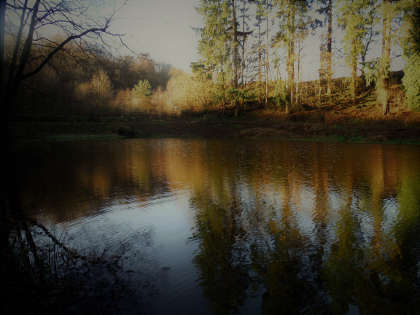
Early the other morning and for the first time in living memory as far as I know, a large otter was seen crossing our Forest pool and disappearing over the dam, following the brook down the valley. Our syndicate secretary phoned me as soon as heard. Now and again otter footprints are seen on margins of local streams and one was killed by a car on a Forest road recently. A few years ago I was shown otter prints in the mud several hundred yards underground, in a sloping drain adit leading from the lower galleries of Broadwell Colliery down to Cannop Ponds. Generally though, otters aren't much seen in the Forest. This isn't the case just outside the tree-line; Woolaston Court fishery in open fields on nearby Severnside has recently erected a low electric fence all around the pools to keep otters out. What to do? Well, there isn't anything as far as I know. I doubt there is much chance of permission for a fence on our lake which is a SSSI. Of course he might just have been on a long range foray - otters certainly do travel for many miles at night - but having found a pool full of rainbow trout I'm sure he will be visiting again and I don't doubt will be munching his way through our stock fish. This happened just as I breathed a sigh of relief that the goosanders which were with us all winter have gone elsewhere.
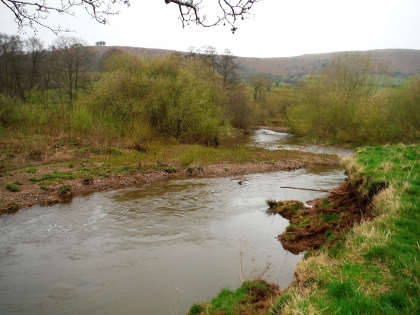
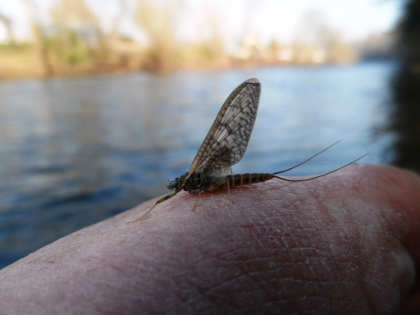
We really must expect some warmer weather. May is the month when everything should open up; it is in fact the time our fly fishing is no longer "all about the Usk." The upper Wye should be fishing well now as should Wye tributaries such as Lugg, Arrow and Monnow system, while the small streams should be at their best. While waiting for the true mayfly, we can expect to see several other species including the large brook dun, but I often find the mainstay of early May fishing, particularly on the Monnow, is the olive upright. I have already seen a few of these this year. The Latin name for this one is Rithrogena semicolorata, and don’t be confused by its English name into thinking it is closely related to the large dark olive or the medium olive or others of the Baetis tribe. The nymph of this fly is a heptagenid stone clinger witha broad, squat profile, so it is rather a cousin to the March brown, yellow may and large brook dun. As such it is a medium to large fly and, come to think of it, the colour does not even look particularly olive to me. The body is more of a light brown or straw colour. The tails are on the short side. What I really like about the olive upright is that if you find a fish on station and rising to the duns, you have a very good chance of persuading it to take an artificial. I usually find a Parachute Adams in about size 14 works.
Traditionally, in those silty streams of our region where they live, the true mayfly will start to emerge in the last week of May and carry on for the first two weeks of June with a few late specimens turning up for the rest of the summer. In recent years, the hatch has started about a week early, although I am not sure what effect this cold spring will have had. I am almost loathe to recommend a mayfly dun pattern as there are so many to play with. I particularly like one called the Monnow Gosling (scroll back to April 2015 for the dressing) but the main thing above all to remember, I think, is that the fish will be looking for a bigger fly during this period and you need to accommodate that wish.
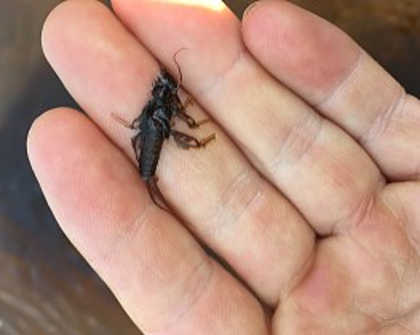
I noticed a report from DP of Orpington, who fished Dinas on the 18th April and who commented on the number of large stone-flies about. I saw the same a couple of days later. Both the large two tailed nymphs and the adults are pretty distinctive. There is a significant difference between the adult males, which have fore-shortened wings and cannot fly, and the females with full sized wings, who can. They are friendly things, stone flies, who seem to like to perch on my glasses. In any case, their presence anywhere is a very good sign because they are pollution intolerant and will only live in relatively pure water. Generally we see much less of them in the lower Usk below Brecon, but they are common on the upper river. Later in the year we will see some of their smaller relations, such as the willow fly - a common sight while autumn grayling fishing.
It's a very curious thing that the many of the historic writers on angling, from Dame Juliana Berners right up to Charles Kingsley, made a great point of providing a dressing to imitate the aquatic alder fly. You might wonder why, because few anglers trouble with it now. It is still a common enough fly in May, the adult looking rather like a meaty sedge fly with shiny rather than hairy wings, held in a roof pattern when at rest. They are clumsy fliers, but rarely seem to fall on the water, so that many modern anglers claim that they have never seen a trout eat one. This may be true on rivers, but I can tell you that I have definitely seen rainbow trout polishing off adult alder flies which were being blown by the wind off the dam on to the surface of a still pool. Perhaps more important is the nymph, which is a rather vicious little thing about 1 inch long with a single tail. It lives, like the mayfly nymph, in a silt tunnel and eats any small creature it can get its mandibles into before migrating to shore during the spring to hatch. On warm, calm spring days by Forest pools, I used to do quite well fishing an alder nymph imitation with a floating line and a very long leader, just inching it very slowly along the bottom towards the bank, watching the tip of the line for twitches and pulls. This ploy is great fun for a small still water in spring. The pattern I used was one by Donald Downes which I found years ago in Pat O'Reilly's Matching the Hatch:
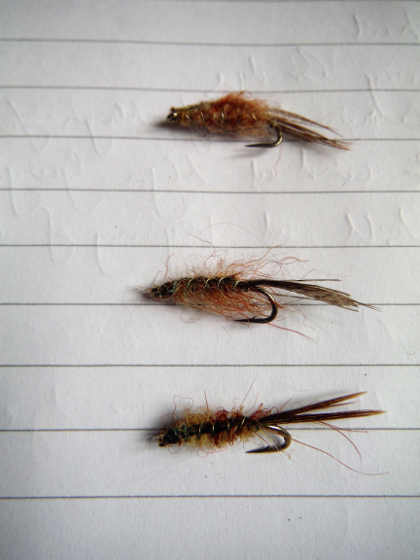
Bardogs Aldie
Hook: Long-shank 12
Thread: Brown or tan
Tail and back: Strip of pheasant tail fibres glued together with flexible adhesive.
Rib: Fine silver wire
Body: Natural sheep's wool taken from a barbed wire fence, teased out between the
ribbing to imitate gills.
Note that in a still pool it is possible to move the fly more slowly and naturally along the bottom if no weight is added.
Little silvery salmon smolts are already gathering on the gravel flats in parts of our rivers. If you find yourself pestered while trout fishing, unhook and return it carefully. I always express a solemn wish for us to meet again in three years' time. Then move away and fish elsewhere. Finally - and it seems extraordinary that I need to remind anglers of this, but I make no apology - grayling are out of season at the moment and will be until 16th June. Leave them in peace during their spawning period and concentrate on the trout. Obviously it's impossible to avoid catching the occasional accidental grayling during their fence season (in which case return it quickly and carefully), but if it's more than the odd one turning up either try changing your method or fish in a different section of the river.
Tight lines!
Oliver Burch www.wyevalleyflyfishing.com
March 2018
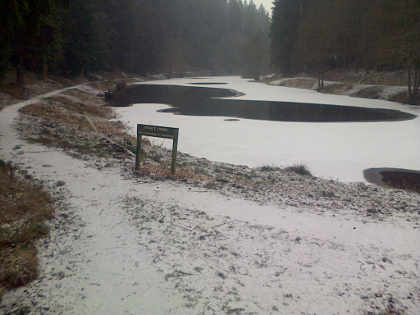
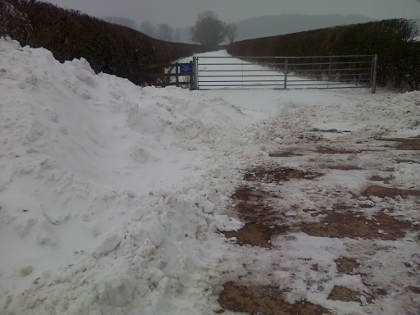
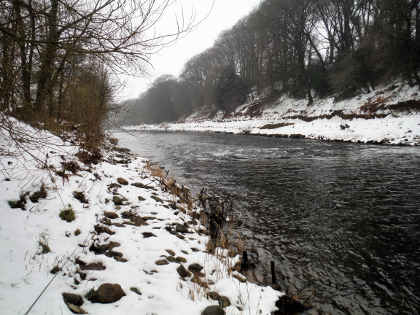
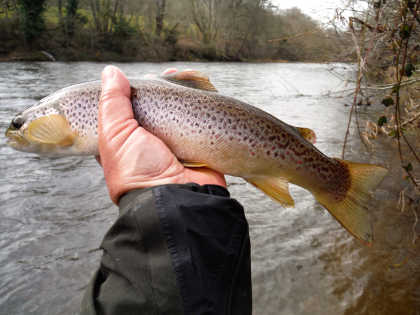
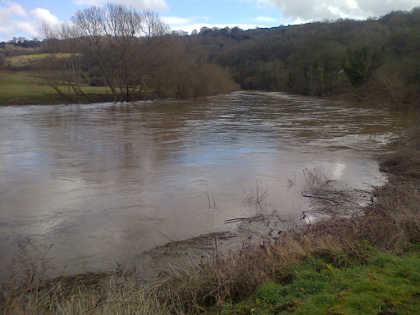
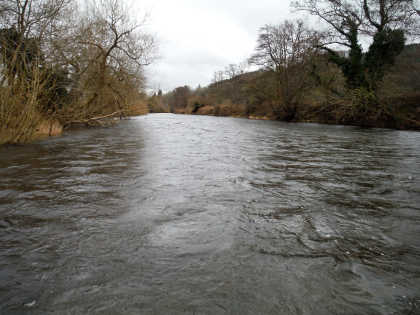
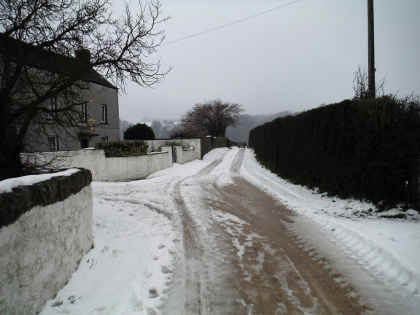
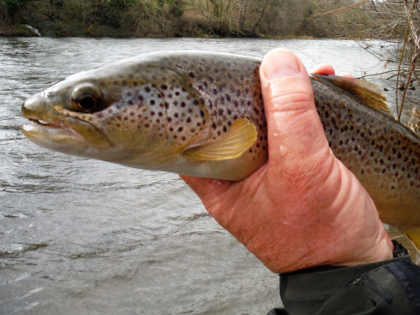
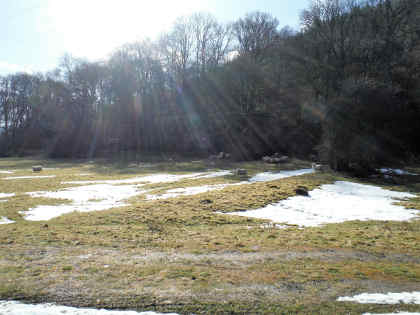
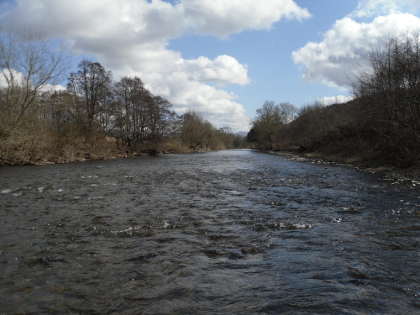
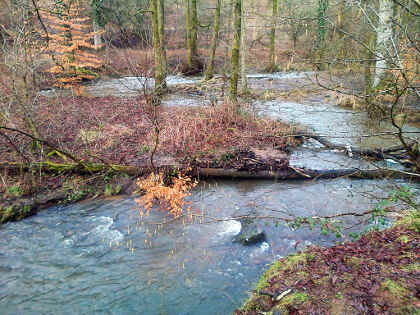
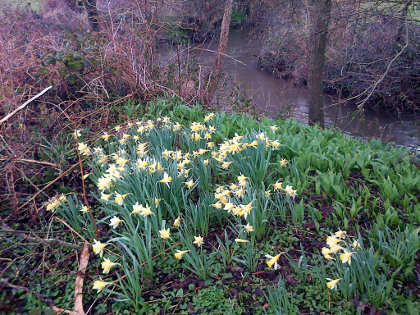
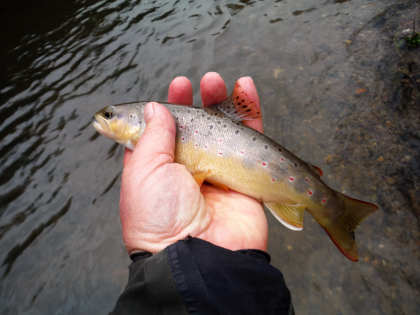
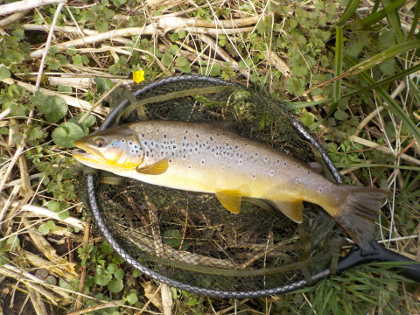
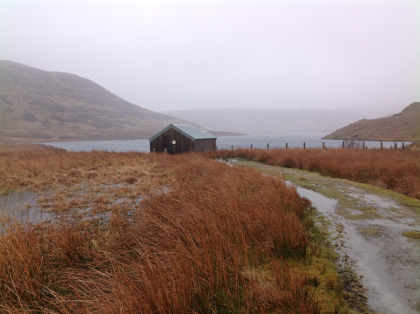
To summarise March, there was enough cold weather and precipitation of snow and rain to make an angler's life quite difficult. After the first couple of days, the Wye rose and was then out of condition all through, except for the possibility to do some high water salmon fishing towards the end. The Lugg and Arrow springs, now well charged, kept those rivers high. The Monnow seemed to be discharging mud whenever I looked at it. Which left the possibility of fishing the Usk, for those ready to wade a strong current, and also some of the low altitude small streams in the WUF portfolio.
In fact spring seemed very far away as March began, with the thermometer apparently stuck well below zero, arctic winds blowing and mounds of snow rising all around us. Ponds gradually froze at the surface, but for some reason more slowly than usual, possibly because the strong winds were turning over the layers of water. Meanwhile marginal shelves of ice quickly grew on the banks of the Wye, while the dark river filled up with floating rafts of proper Scottish-style grue. March may be said to come in like a lion and go out like a lamb, but this year it arrived more like an angry polar bear. As usual at these times, and because Britons (including me) don't trouble to keep snow chains, the countryside came to a halt. Where I live, taking the car out of the drive was more than most people could manage. Offices, shops and schools were closed while people stayed home and cranked up the thermostat a couple of points, waiting for better times and watching the weather reports. A few people were still out on the main roads, quite apart from the children sledding down the hill leading into town. The lads from our daughter's battalion in Shropshire were out helping motorists keep moving while one of our sons, a linesman for the power company, was down at Plymouth reconnecting overhead cables. Eventually the media came in for some criticism from those who complained they were over-dramatising what was, after all, just another spell of wintry weather arriving late in the season. The Beast from the East, the critics claimed, had become the Hysteria from Siberia!
Whatever the weather was called, the opening day for trout and salmon, 3rd of March, was spoiled for most of us. The problem was access. I always like the idea of a cast for salmon on the first day, even if the conditions are difficult. In fact this year I reckoned that the Wye was at quite a nice height for once. It seemed to me that if I could somehow get myself down to the water's edge and make a few casts with a big tube, there might be something waiting for me in the Stones, Dog Hole or maybe down in the Vanstone. However, after I struggled to get the Landrover across the Forest as far as the gates of Goodrich Court, I had to retreat when faced with virgin snow drifts across the road. Meanwhile the brave boys from Merthyr Tydfil, so I heard, did manage to get down into the River Taff that first day and a few nice trout were caught.
On the 4th, one day into the season, I managed to tote the salmon rod through snow-covered lanes down to the lower Usk at Kemys, got into the river hoping my casting wouldn't be too rusty and then thoroughly enjoyed myself. It was just good to watch the line going out across the river. Unsurprisingly there was no sign of salmon although a big trout banged into the Black and Yellow tube at the bottom of the pool. The Usk seemed significantly warmer than the Wye, not uncomfortable to stand in and accordingly there was no grue, although a river between snowy banks always looks cold and black. Nevertheless, on the same day Stacey Arthur while spinning at Ingestone opened the Wye's account (and her own personal salmon account) with a 21 pounds springer. Between 2 and 3 o'clock that same afternoon on the Usk, Lee Evans reported a half dozen trout rising to large dark olives in a sheltered corner upstream. This is, of course, exactly the situation we hope for at the beginning of the season, but when it actually happens it always seems like a small miracle and it must have seemed especially so with thick snow on the banks.
By now it was already clear that a thaw was on the way and that snow-melt water would be the next threat to our fishing. That night the melting snows began to affect the level of the Usk first, while the higher mountains at the head of the Wye remained frozen. Later the Usk dropped back a bit, while the Wye became very high indeed. It seemed that all the tributaries were full of muddy floodwater and as the snow melted more showers of rain arrived. The rain continued to fall day after day and there were very few fishing chances. On the 7th a client chose to fish the Usk with a salmon rod right up at Brecon, where the water was high but clear. It was mostly early season casting practice but, just like me three days earlier, he got a nice trout on a Black and Yellow tube. Meanwhile I have to comment how impressively determined some of the coarse fishermen were to achieve something in the last days of their season on the Middle Wye. They struggled through snow drifts to reach a bank-high river and still managed to extract a few chub and even barbel. MW from Stalybridge with a friend had a marathon to reach and fish Backney on the 3rd and on the 4th they had a trek through the snow to reach and return from Middle Hill Court, the end of which sounded like Napoleon's retreat from Moscow. Digging the van out of snow drifts was all part of the fun for them, it seems.
After the thaw, AL and AT, two intrepid game fishers visiting from London, were not to be outdone. They also had Dinas on the Usk near Brecon booked for two days. They were washed off on the 10th, but the following day they managed to fish. The EA gauge at Brecon showed 0.70, which is very high indeed, but the water was reasonably clear and dark olives and some march browns were in evidence during the day. They managed 7 trout to 1.25 pounds, which is very creditable in the circumstances. I found a few ready to take spiders when I fished at Brecon on the 14th. On the 16th PC and PN from Kenfig Hill had 4 rainbows from Usk Reservoir. It was on the next day that freezing weather, winds and more falling snow came back with a vengeance, resulting in an amber weather warning over most of our region. Once more roads were blocked and flights were cancelled. Rivers were out of reach. The countryside had a distinctly battered appearance as this latest round of snow melted away to reveal frost-damaged roads and a landscape still composed of dull sepia and brown shades. Branches were splintered by the weight of recent snows. Winter pastures were nibbled down to a nub of muddy grass with no green to be seen, while in my local Forest of Dean the boar seemed to have ploughed up every inch of ground under the trees.
The weather slowly improved and snow melted away little by little, although unpleasantly cold winds continued. The Usk was about the only one of our rivers in fishing condition (if you could reach it), still pretty high and cold, but running clear. Simon Jones managed to produce the first Usk salmon of the year from Llanover. A few of us made visits to the middle river, still looking for an early trout. There was usually some sort of large dark olive hatch around the middle of the day, although, presumably because of the cold temperatures, it took a long while for the trout to switch on to taking the duns from the surface. I found that to begin with I did better with spiders fished a few inches down. CT from Cardiff (see report on article below) had 4 between 12 and 15 inches from the Breconshire Fishery on the 22nd. JJ from Stourbridge with a friend had 4 trout from Glanusk Ty Mawr with nymphs and spiders. On the same day, DC from West Herefordshire had a couple from the Gwent Angling Society at Gilwern with a Duck's Dun. DL from Rhymney with a friend visited Llwyn On Reservoir and took 7 rainbows.
Frustration continued, with most Usk anglers remarking on midday large dark olive hatches, but surprisingly few trout responding in the accustomed way. We put this down to the cold conditions, particularly the winds, and the high water levels: "They aren't looking up yet." AS of Newent's visit to Dinas on the 24th accentuated the problem and the reason for it. He fished with 1ft 6 inches on the Brecon gauge, which is very high water, and he achieved a nice bag of 8 trout from 12-16 inches. Every one of these fish, however, was taken with heavy Baetis Nymphs fished along the bottom and although there was a large dark olive hatch, he saw no rises. I think the lesson was that indeed the trout were not looking up, or not many of them, and not yet. The problem is that so many of us have become used to taking Usk trout from the surface right at the beginning of the season, spoiled as we have been perhaps by a succession of mild winters and warm springs, that this year caught us out. The water by this time seemed no warmer than at the beginning of the month. AS judged the situation correctly and did the sensible thing. However, looking at the problem from another angle, AL from London also fished Dinas that day, did see a few rises during the hatch and managed 4 trout on dries. It's not the numbers or the weight; it's whether you enjoyed yourself and found the day interesting that matters! Also for the 24th, we have a report from GS of Crewe, who describes himself as new to fly-fishing. He fished the Dee at the Glyndwr Preserve in N Wales and during a hatch managed 10 trout on dry flies, which must have been great fun. I don't know the Welsh Dee as well as I perhaps should, but that report indicates it may have warmed up a little quicker than our local rivers this year.
During the last week before Easter, the weather was a little kinder and the sun made a few appearances. There was even some new green evident now with dog's mercury coming up under Forest trees and willow buds looking fresh while more and more daffodils were waving in the cold wind. Most rivers were still too high with snow melt, but there were some opportunities on the Usk where I saw some quite extended large dark olive hatches with occasional march browns amongst them and trout were now starting to rise more. On the 26th, AR from Merthyr Tydfil fished the Llwyn On Reservoir for 3 rainbow trout. In his catch return he expressed dissatisfaction with the 3 pounds booking charge levied on the ticket by the WUF office. I should point out that the booking office scheme is not a profit-making one and that, taken as a whole, the WUF provides a marketing service valued by fishery owners and a wonderful "one stop shopping" service to the ordinary angler who has a pretty much unrivalled portfolio of angling available to him. Imagine how much work it would be if we, the punters, tried to negotiate all that fishing for ourselves. I have some personal experience of the wonderful world of NGOs and know that it is the case that, while it may be possible to get funding for specific time-bound projects such as river restoration, funding the core costs (office, administration etc) is usually a greater problem and less attractive to the big donors. The booking office helps to keep the show on the road, so let's support it. (The WUF has made its own response to AR's points including the information that, in the case of Llwyn On at least, it is possible to avoid the booking charge by buying a ticket from the cash machine on site).
Meanwhile MN from Bristol fished with a dry fly at Glan yr Afon and took 3 trout to 15 inches. He also had to turn off two poachers who were spinning the water: the ultimate crime on the Usk in spring! I'm afraid this river suffers a fair bit from poaching and it is necessary to be alert; ring NRW if necessary on 03000 65 3000. On the same day DR, also from Bristol (and who I see from his photograph fishes with one of those cute little Wychwood stream reels), visited the Forest of Dean and had 10 trout from the Cannop Brook and one from the Bideford Brook. He was fishing a nymph with the duo system. Meanwhile RW from Portishead, one of our regulars, visited the Lwyd at Llantarnam Abbey. This lower Usk tributary is an unusual fishery: a little haven of peace in what is quite an urban area, but the stream has been restored from former industrial pollution. He had just the one trout of 18 inches on a tiny dry fly after seeing it rising. It was a handsome fish (see the photograph) and I think this one gets my vote for "fish of the month." DR from Bristol fished the same beat on the 29th and also had a single trout of 14 inches. The odd big fish rather than lots of little ones is typical of the Lwyd. Note that these small streams are all at a low altitude and usually among the first to wake up. Going to the opposite extreme, on the 27th JA from Leominster, who must be Bugeilyn's biggest fan, made his way up into the clouds to visit the lake for the first time this year and caught 5 trout despite the cold weather. He commented that the fishing tended to "switch on and off" during the day and also that the winter has done some more damage to the access track near the ruined farm-house. You definitely need a high ground clearance vehicle to access this one.
The Easter reports are not to hand at the time of writing (Good Friday), although the rivers look to be high once more and it is raining yet again. I should mention that the April issue of Fly Fishing and Fly Tying has an article from Ceri Thomas and Tim Hughes, who both work for Airflo at Brecon and who fish the Usk in early spring. The article is a good description of the early season hatches and angling techniques for the Usk (although this year certainly won't go down as a typical one, given the very cold start). It's just about possible in the spring, Ceri tells us, to take a lunch break from the office and fish a hatch of large dark olives on the Breconshire Fishery (the town water) before returning for an afternoon at the desk. That's a plan for our angling visitors from London to envy. And God bless modern flexible working practices, say I.
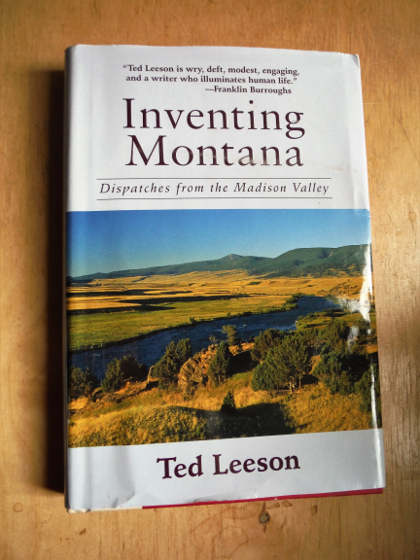
There was unexpected time for fly-tying and other indoor activities this March. I have been reading a Christmas present, Ted Leeson's Inventing Montana: Dispatches from the Madison Valley, which is available from Skyhorse Publishing. This book is quite well-known, but it was somewhat different from what I expected. A more accurate sub-title might be: "Deck-chair philosophy from a Madison Valley porch." Just to dispel any illusions to begin with, it isn't really about fishing. In fact you would learn as much about fishing from this as you would about motor-cycles from Zen and the Art of Motor Cycle Maintenance (which also touches on Montana by the way). To be fair, Ted Leeson has written other books which are about fishing and fly tying, and I guess every writer should be granted a break. The basic plot behind this book is that for a couple of decades now, a bunch of middle-aged Americans, mostly academics, have rented a Montana farm-house for a few weeks every summer. They are out of state visitors, arriving at different times from all over the USA. A couple of them tow in drift boats. Leeson and his wife arrive from Oregon and seem to stay the longest. They fish the Madison most days, either wading or drifting, pushing through the crowds of visitors and guides as best they can. Others from the party paint or take photographs. They cook communally, concocting elegant meals from bought-in ingredients (nobody ever cooks trout). The food is a big part of the holiday; not all of them fish, but everybody likes to cook. And they sit around on the porch, drink wine, chat and generally philosophise about life and its meaning. It's this part which the book is really about.
A holiday should be relaxing and it certainly does seem the case that Mr Leeson on holiday can find time to ponder at great length over what some of us might find insignificant events or observations. Anyway, we get to go along on the journey. For example, there is the matter of the little wave which strangers give each other when their pick-up trucks pass on remote country roads. What exactly does each of them mean or understand by this gesture? He spends a chapter on that. He spends a lot of time looking at the objects in the town rubbish dump. Then there is the lady who politely asks him at a dinner party what is his favourite fishing spot? This starts him wondering about what exactly should be meant by "favourite?" And what precisely does she mean by "fishing spot?" Poor lady! And poor us; there goes another chapter. For no particular reason that I can see, there are quotations from Coleridge's Ancient Mariner, Dante's Inferno and Beckett's Waiting for Godot thrown into the mix. There are a few good jokes in there now and then, but you have to cover a lot of ground to find them. I feel Tom McGuane - who is mentioned - would have done this better. I don't know if this would be your cup of tea; I'm afraid it wasn't really mine.
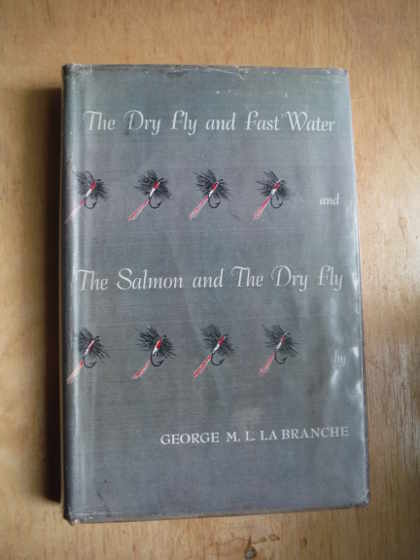
I also re-read an old favourite. I am not sure how many times I have been through The Dry Fly and Fast Water by George ML La Branche, but every time I seem to get something new from it. This was published in 1914 by Charles Scribner's Sons of New York, so you may find it surprising that I'm recommending a hundred year-old book as a practical how-to-do-it guide. However, that is exactly what it is and I think it is as useful today as ever. La Branche was an American who fished the rivers of New York State and Pennsylvania, originally with the wet fly. Note that in his day many east coast rivers such as the Brodhead and the Beaverkill, tributaries of the Delaware, had already been stocked with European brown trout and rainbows, both of which had established themselves alongside the native fontinalis char (brook trout). There was almost as much interchange between anglers across the Atlantic then as now, and La Branche was one of many Americans who avidly studied the works of Frederic Halford extolling new ideas about dry fly fishing on English chalk streams. La Branche was impressed with Halford and began to fish dry, but he was early to make the observation that the rivers he was fishing, while usually clear, were also relatively weed-free and much faster and rockier than the Test and the Itchen. (I am not sure if La Branche ever fished on upland British streams such as our own, but he certainly visited the Houghton Club's water of the Test when the elder Lunn was keeper). I suspect that this perceived difference between the tumbling waters of American east coast streams and the stately glide of Halford's Test was something of a relief to La Branche, allowing him to express his own ideas and observations without the need to challenge the man regarded by many as the father of the dry fly art. The monolithic figure of Halford rather loomed over the sport by this time and the idea of challenging his pronouncements, even for an American, was slightly intimidating. The English nymph fisher Skues later found this out to his cost.
La Branche doesn't go into much depth in discussion of tackle, which certainly saves his book from obsolescence. However, given that we are still using a basically similar rod, a floating line, a leader and a floating fly, what he suggests about short range casting and the behaviour of trout when lying in a rough and swirling stream with projecting rocks and boulders is perfectly understandable to us today. La Branche spent a lot of time targeting fish which he could see, this according to the custom of the time, but he was also quite prepared to prospect in likely places, a habit of which Halford would certainly have disapproved. More interesting to me is his description of his personal journey from moving quickly on the water, taking just two or three shots at each seen fish or likely spot, this approach having been taught to him when an apprentice on the river, to a much more intensive campaign in which he might eventually take 50 shots at or near a fish which he could see. By all accounts, he usually got it sooner or later! I'm not going to replicate all his advice, but essentially La Branche tells you where and how to cast, how long to drift your fly before lifting off, when to try a smaller or a larger fly on a difficult fish, and many things more. His ideas on flies are conventional although distinctly different from the exact imitation attempts of Halford. He mentions some famous American fancy patterns of the time, the Queen of the Waters wet fly and the Royal Coachman dry, while suggesting his own small range of winged, quill-bodied dries. However, he seems to have a definite preference for worrying more about the size of the fly, as many of us do today. La Branche had his complaints over the effect of the growing human population on his favourite streams - but whenever did an angling writer not have such environmental concerns? For La Branche, the problem was the felling of the great eastern woods of the continent which had stood for time immemorial, resulting by the end of the 19th century in more rapid run-off from the cleared hillsides and higher water temperatures.
The Dry Fly and Fast Water is thoroughly recommended if you can find a copy; I often see them around. My own version, which according to the fly leaf belonged to a Shropshire angler in 1955, is twinned with another book by the same author: The Salmon and the Dry Fly. La Branche would have been the first to admit that he was primarily a trout angler, but in salmon angling he had a mentor, Colonel Ambrose Monell, who fished the Upsalquitch in New Brunswick. Monell died in 1921, but not before he and La Branche had carried out what must have been some of the earlier experiments in fishing the dry fly for Atlantic salmon. This book describes the experiences of the two men with a method which is standard in Eastern Canada today. La Branche's advice, which he drums into the reader again and again, is not to let the fly drag, be very careful about the exact line taken by the fly down the current and, if necessary, show it to the fish again and again. I have never taken a salmon on a dry fly - it seems to be a method which works better the further north you go - but it's surely an exciting idea.
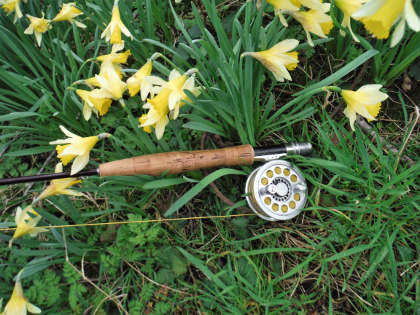
What happens in April? As discussed in previous newsletters, the spring is always a busy time, particularly on the Usk, with hatches following each other in quick succession. This year, given the cold winter and early spring which have surely retarded the activities of insects and fish, I'm guessing that hatches will now come with a real rush. The large dark olives of early season will probably keep going for a while. If you fish spiders, the Waterhen Bloa and (for reasons which I don't fully understand) Dark Moorgame are the ones which generally work during the olive hatches. For a dry fly, you could try the traditional approach with Oliver Kite's Imperial or maybe use our own Stuart Jarvis's Bastard Adams. Lately I have found an Oliver Jingler to be pretty good medicine. We can expect march browns to continue appearing in short bursts during the day. Woodcock and Hare's Lug seems to be a good spider to take fish during a march brown hatch, usually more effectively than some specifically designed march brown spider patterns, and I would try a March Brown Jingler as a dry fly. As you can see, I'm quite into Jinglers these days! A large Deer Hair Emerger with a dark wing is another useful one when march browns are on the water. By the end of April and into May we can expect to see another very similar fly, the large brook dun. My advice is not to worry too much about what the exact differences are, although the large brook dun, which hatches from a similar heptagenid stone-clinging nymph, has a distinct yellowish tinge which is absent from the march brown. The fact is that the fish like them both and the same fly patterns will do for them both.
Again, I'm hoping this year for some grannom sedge hatches which cannot be too far away. A sunny mid-morning is a typical time for the grannom to appear and hatches can be intense if short-lived. Fishing can be difficult, as is often the case when fish are excited by flies in very large numbers and all sorts of patterns have been designed for the grannom at different stages. My best suggestion is to try spiders fished across the stream for the beginning of the hatch when the pupae are coming up, and the light gold and brown coloured Hare's Lug and Plover usually works - I use three of them in a team. For a dry fly as the hatch develops, a small Hair Wing Sedge with a light coloured wing seems to be as good as anything.
Finally - and apologies if this is a big helping of entomology for just one month - towards the end of April, the hawthorn fly might put in an appearance. This is a terrestrial fly, the little black creature with two trailing hind legs which you sometimes find hovering on warm days in the lee of hedges, particularly hawthorn bushes, as its name suggests. The female is about twice the size of the male. Whether or not it actually falls on the water is completely down to vagaries of wind and weather, but trout are certainly very fond of them when they do. Be prepared for the event with an imitation such as Charles Jardine's excellent St Mark's Fly - or any suitably sized black dry fly in your box, such as a Black Gnat, Williams Favourite or even a Black Klinkhammer. Does anybody still fish with an imitation of the alder fly? We can discuss that one next month.
Tight lines!
Oliver Burch www.wyevalleyflyfishing.com
February 2018
The first part of February involved yet more rain, more high water and few opportunities for fishing, except occasionally on the tributaries. Similarly, it has been difficult to keep up the schedule of wild stream cleaning this year and we were all too aware that February was the last opportunity for most of us to get some work done. It is no easier to prune a stream which is in flood than it is to fish it. Only during the last 10 days of the month did we get the sort of cold and dry weather which would allow levels to fall and produce more opportunities. The problem was that when it came it was very cold indeed, even by the standards of February. The "Beast from the East" is what they called a bitter wind blowing to us straight from the steppes of Siberia. At the end of the month, with the temperatures well below zero and snow showers around the country, schools closed and trains cancelled, Britain was in its familiar state of cold weather chaos!
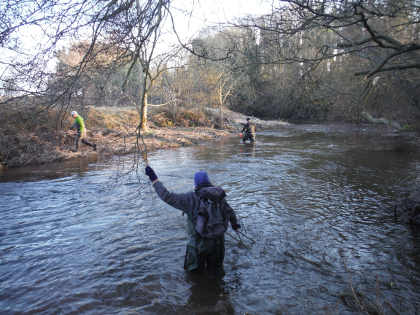
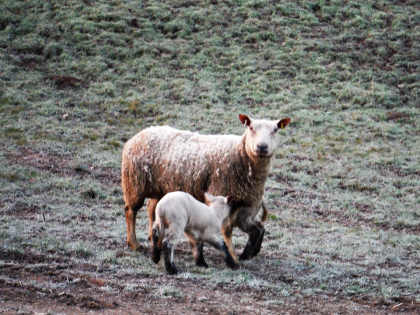
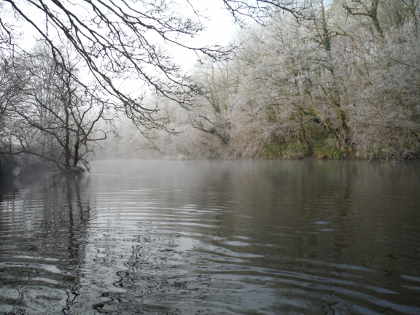
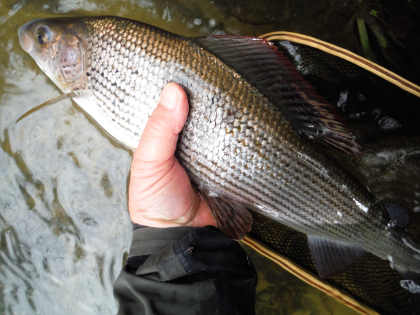
For all the difficulties, some nice grayling were caught this month. AM from Worcester had a quite remarkable day on the little Arrow at Court of Noke on 2nd February, despite high water. He reported eight grayling and, of these, two were 18 inches and three were 17 inches, caught while trotting deep water with maggots. I would call that a red-letter day on any river and in any conditions. By the 4th, the rainfall having reduced for a time, Irfon was down to a respectable 0.60 metres on the Cilmery gauge, so that KD of Swansea and a companion were able to take 17 grayling between them in clear water. AB from Blaenavon was out on the same day fishing the Craig Llyn beat of the upper Wye. He reported 8 grayling, possibly shared with owner Shaun - it wasn't clear. Incidentally he mentioned the new fishing hut by the river at Craig Llyn, which is a rather marvellous thing on wheels. It reminds me of Gabriel Oak's shepherding hut in Far from the Madding Crowd. On the 7th I managed to fish the main Wye at Gromaine for the first time in three months; the water although clear was still very high and trotting seemed the only viable method. Immediately after this the weather resumed its regular bouts of rain, with light snow and sleet at times, so that the rivers rose again. Anybody who took a walk in our countryside during February would have been convinced that the ground was absolutely saturated, squeezing out water like a sponge with every footfall. Many of the sloping pastures still holding livestock were trampled to mud and much of that silt surely reached the streams. When the rain stopped, the volunteer maintenance teams managed a few lightning visits to trim wild streams. While working on the Llynfi, I took several photographs of poached sheep pastures in the valley which looked more like ploughed fields. On the 17th MN from Bristol managed to fish the Llynfi at Pontithel, taking 5 grayling to 16 inches and AS from Newent had 6 from the Colonel's Water on the upper Irfon.
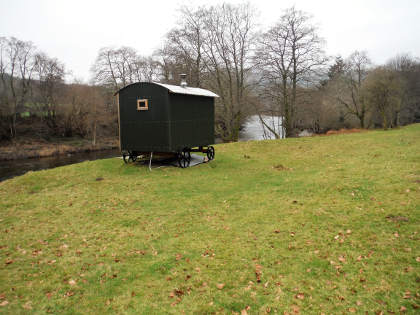
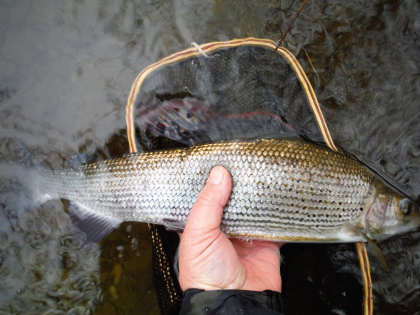
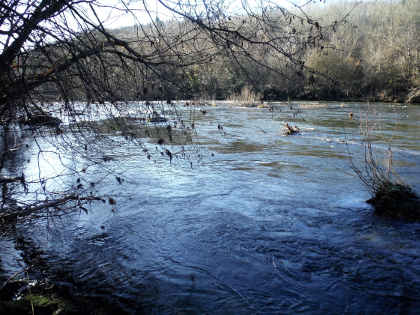
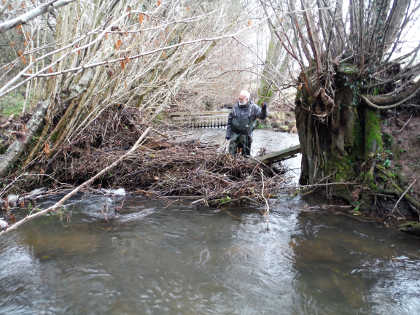
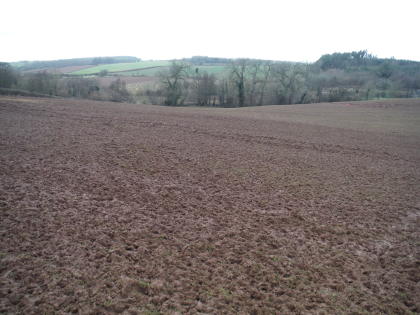
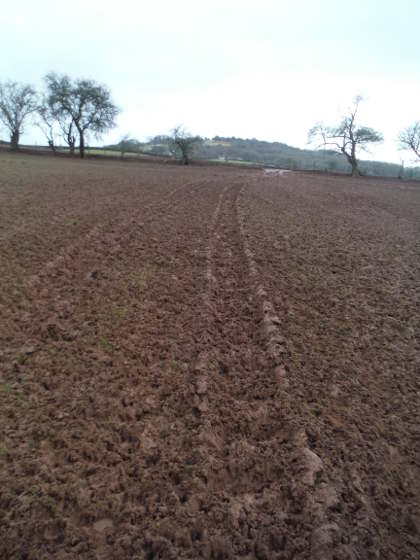
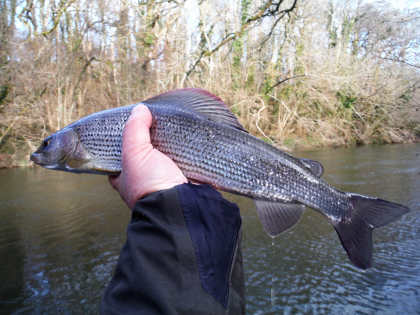
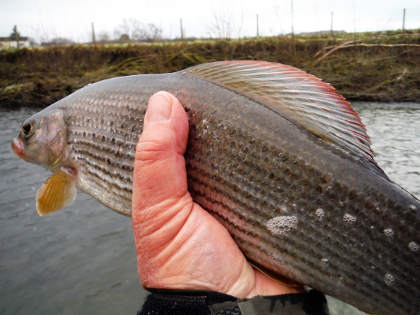
At last, with the month drawing to an end, we began to experience the kind of cold, dry, high pressure weather which has been lacking for most of this winter. Days were frosty with an icy east wind blowing and water levels slowly began to fall. On the 22nd, AM from Worcester returned to Court of Noke with the trotting rod and had another grayling of 18 inches in a bag of 4. Incidentally, and for the second time, I have an apology to make to AM. On that very same day I had committed the cardinal sin of forgetting to check on-line if anybody had booked the Court of Noke before setting off for the river myself. It turned out that AM had booked it, and found me in the parking place setting up when he arrived. Oh dear me! Sorry about that; I will be more careful in future! I'm glad AM had a good day and I did something else which was fun. On the 24th AS of Newent tried Lyepole with 18 inches showing on the gauge, which seems very high. Nevertheless, he managed 8 grayling, 2 of which measured 17 inches. Lyn Davies and Rob Evans of Swansea were out at Ty Newydd on the 27th, the main river being in condition at last. They managed a creditable 27 grayling between them, although Lyn tells me his abiding memory of the day will be of how very cold it was. I was there the following day, caught a handful of shots, but just couldn't stand the wind for more than a couple of hours. At the time of writing, with sub-zero temperatures, that wind from the east still blowing and more snow predicted, spring somehow seems far away.
Here is the latest news on the rules for the coming salmon and sea trout fishing season in Wales. Currently we are waiting on the Welsh Assembly to enshrine NRW suggestions in law. Assuming they do so, just as anticipated, all angling for migratory fish will be catch and release. The likelihood is that these rules will last for a 10 year period. As already described, I personally have no problem with catch and release or the ban on worming for salmon (although apparently worming will be permitted for sea trout). I am not so happy with the plan that all treble hooks except very small sizes will be banned as will any barbs on hooks. For this reason I have been holding off tying any more flies for migratory fish during this winter. I have to remark that the relationship between the NRW and the angling community seems to be at an all-time low. At the end of a laborious consultation process during which NRW has sought anglers' views, they have, almost without exception, ignored our advice. Why do we co-operate if we are not being listened to? Are consultations, of which there are so many these days, really intended to inform the organisations which launch them, or are they merely devices for deflecting criticism. I have been happily releasing salmon and sewin for years, but I find myself now in gloomy moments contemplating a new season in which any contact with a big fish may last a few seconds only before it cartwheels or head-shakes itself off. It's a delicate matter this, but my own experience is that salmon and sewin hooked at range are very different from trout or grayling hooked close at hand - they come off all too easily - and I haven't personally experienced much trouble removing barbed trebles of size 8 or 10 with forceps. I would be happy with single hooks if small barbs are allowed. Never mind, Simon at the WUF tells me to cheer up, because he has mashed the barbs on his hooks down for quite a while now (it's been WUF policy for a long time) and is convinced it makes no difference to speak of. Well, he admits maybe a few were lost!
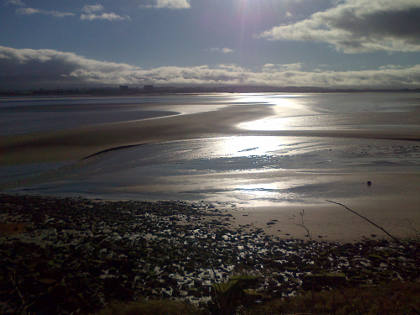
Meanwhile, another kind of discontent has been brewing in England. Here in the Forest there has been much discussion about a Supreme Court ruling in a long running case between a Severn Estuary putcher rank fisherman, Nigel Mott, and the Environment Agency. Mr Mott claims rather inaccurately to be the last of the commercial salmon fishers on the Severn, but he is certainly one of a dwindling band. Back in 2012, he was ordered to restrict the catch on his putcher rank, which is about a mile above the mouth of the Wye into the Severn, to 30 fish for the season. At the same time the lave-netters, I think, were reduced to 5 fish each. Mr Mott, who claimed he caught 600 fish a year and made a good living before the restriction, made a point of taking 31 for the 2012 year and invited the press and anybody else who was interested to watch him take the final one. An EA enforcement officer turned up and confiscated the fish and then, as Mr Mott had surely intended, they all went to court and a long legal process began. Mr Mott argued that while there were concerns about the Wye salmon run, his activities were not impinging on Wye fish and, furthermore, he should be compensated for loss of earnings. As I understand the situation now that the case has gone right up to the Supreme Court, Mr Mott has accepted a ruling that his activities might be damaging to the Wye run, but he has won his second point - that the EA is liable to compensate him for his loss of professional earnings. I understand the EA has accepted this and a further hearing will determine what the compensation should be. Interestingly, one of the Supreme Court judges made reference to the likely position of the European Court of Human Rights on loss of earnings caused by such a decision and hinted that Mr Mott seemed to have been unfairly treated in comparison with rod and line leisure fishermen. It's an interesting dilemma that; how do you balance the living of one man with the spare time pleasure of many? I wonder if the individual lave-netters (who have more recently been reduced to one fish) will now make claims for losses they have incurred? One thing is for sure, the lawyers will be keeping busy. Rumpole would surely have enjoyed himself with this one!
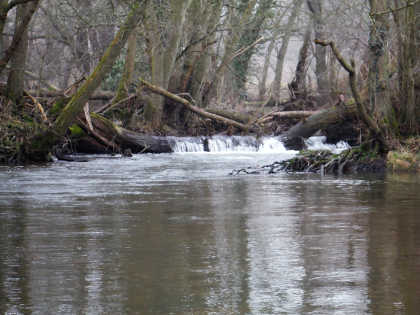
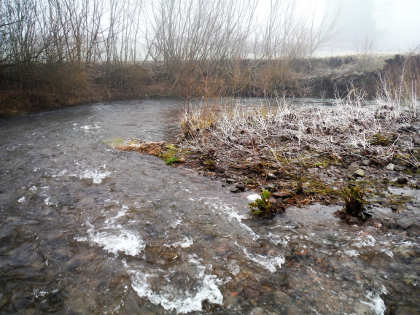
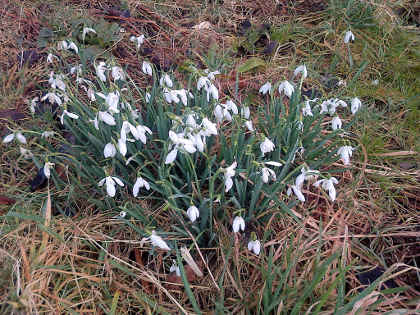
Back to another rather sad tale: I was disappointed to hear that we are losing the top part of the Upper Longtown beat of the Monnow from the Wild Streams scheme. This beat has been somewhat awkward to fish for a while, as for several years the owner of one field in the middle of the water did not want his part of the river fished, or even for anglers to pass along his field, so a long hike round was necessary. It's a shame, because this is a lovely little mayfly stream, a real dry fly jewel. The final decision is that the short lower part of this beat will be retained, because it is certainly good fishing and a couple of hours there can easily be combined with Lower Longtown, the Olchon or one of the Escley beats. One of the problems associated with some Wild Stream beats, at least in comparison with typical main river beats, is that often more than one land owner / fishing rights holder is involved. Sometimes there are many and for some reason particularly so in the upper Monnow valleys, where in extreme cases there seem to be 6, 7 or even 8 individuals owning about a field each. The idea is that the WUF puts them together as a group and they share the profits to be had from the fishing. This is fine until somebody falls out with a neighbour, with an angler, or for some other reason wants to pull out of the arrangement. A field missing in the middle of the beat spoils the whole thing. The formerly impressive Escley valley beats nearby have been badly damaged in that way as small sections of fishing have been lost. Remember we are, after all, in the hands of the owners, each and every one of them, for access to this fascinating fishing. As a preventative measure, my advice to anglers is that it's definitely best to treat all land owners you meet with kid gloves and the friendliest of smiles lest they become "territorial."
I am not sure why the land plots in this particular part of Herefordshire are so sub-divided - further down the valley in Monmouthshire, the Kentchurch estate with its fishing is huge. I'm reminded of Greece where the custom of dividing land equally between children, including the dowries paid on daughters' marriages (within living memory), compared with the British tradition of leaving everything to the eldest son. So the average Cretan farmer today (if he hasn't given up, opened a hotel or gone to Athens or Melbourne) owns about 20 little patches of land and spends most of his time travelling between them. Is that the problem in the upper Monnow valley? Come to think of it, here's an idea for a PhD thesis for somebody: "Land Inheritance Practices in rural Herefordshire."
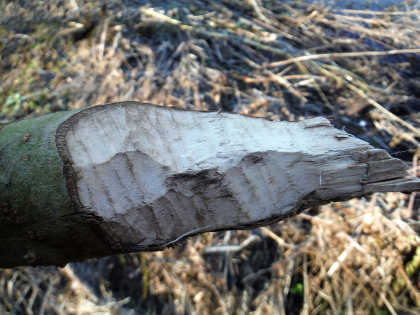
In December's newsletter I expressed concerns about some plans to release beavers into a Wye tributary in the Forest of Dean next year. Enclosures are not secure and the effect on our streams and fishing is likely to be damaging according to most angling sources in countries which host beavers. While we are busy unblocking streams to facilitate fish migration, why on earth should we introduce an animal which makes its living by blocking streams? Instead of worrying about the Forest streams, maybe I should have been more worried about some other activities with beavers further upstream. There has recently been some correspondence - and considerable disbelief - about a beaver said to be have been seen in the gorge of the Bachawy in Radnorshire. A beaver in this location did seem most unlikely. But this month, Richard Adeney and I were busy trimming a section of the Llynfi not far from Talgarth, when Richard found a four inch willow stem chewed off with some very suspicious looking marks from chisel-like teeth. Have a look at the photograph opposite. If that wasn't gnawed off by a beaver, what do you think might be responsible? We now learn that since 2017 a group of beavers may been kept in an enclosure in our catchment with a view to gaining permission for a future wild introduction. In this case it seems there is not much point in waiting for any permission; they are already out! Anglers carp a good deal about some of the environmental regulations we are faced with, but generally we respect them. I do wish those with other interests affecting our rivers would do the same. If the introduction was accidental, I would point out that beavers, like most of the rodent family, are remarkably good at escaping from enclosures, a fact which I would have thought would be pretty obvious to anybody. Exactly what has happened here is unclear at the moment, but meanwhile I would be grateful for any more information about beaver sightings or other relevant facts.
There is one reason to be cheerful this month. It was really good to hear that Chew Valley Reservoir, where trout fishing was reported recently as under threat, is to be reprieved for another year. Advocacy by a combination of anglers, business owners and the local MP seems to have had an effect and some new investments are due to be made. Let’s hope that the water company achieves good returns during 2018.
t may be unseasonal, but I'm minded to write some more about nymph fishing. Those of us anxiously trying to keep up with the rapid evolution of modern nymphing methods will have been interested in a series of articles by Howard Croston beginning in the January edition of Fly Fishing and Fly Tying. Croston has worked as a consultant for Hardy-Greys for years and I believe he was the original designer of the excellent Greys Streamflex range of rods. The article is nominally concerned with different ways of adding weight to bead-head nymph patterns, but it actually covers much more ground than that and is certainly relevant to the border streams we fish. The same edition of the magazine carries another article by Howard Colmer on fishing for spooky chalk stream grayling which have been subjected to increasing fishing pressure in recent years. I think this article could be relevant to us also; some of our more popular WUF beats are now fished much harder than they were five years ago. Both these articles provoked me to think harder about the subject of nymphing.
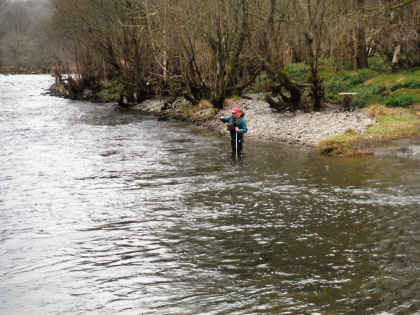
OK, at the time of writing this winter's grayling season is very nearly at an end, but for a moment let's think ahead 7 or 8 months. And of course a lot of nymph fishing is done for trout during the spring and summer, so it's always worth taking another look at the subject. Even during the mayfly season, many anglers seem to want to understand nymphing better. If for no other reason, I find I get a lot of questions about fishing with heavy nymphs from British anglers who are obviously confused between what is called Czech nymphing, French leader or French nymphing and various other fishing styles which have arrived from Europe in recent years. This comes up regularly and perhaps the confusion is not surprising. I don't by any means consider myself particularly adept at any of these, but I am doing my best to follow the developments. You could very crudely summarise the history of upstream nymph fishing over the last 100 years like this:
A: Skues. A single pattern cast upstream intended to imitate a hatching nymph coming to the surface. Relatively stream-lined flies but no added weight, fished below the surface but in the upper few inches. Chalk streams.
B. Sawyer followed by Kite. Imitative and stream-lined single nymph pattern, lightly weighted with copper wire or fuse wire, also to be cast upstream, fishing somewhat deeper than the unweighted flies of Skues. Chalk streams.
C. Initially East Europeans, but eventually followed by everybody else. Teams of two or three nymphs, weighted heavily with brass or tungsten beads and lead wire, designed to be fished along the bottom of the river. Everywhere, used in depths of up to 4 or 5 feet, although usually less. Experiments continue.
Rather than completely dissect both articles, I have pulled out some points and added some of my own which might be helpful to those who have set themselves to learning the nymphing game for catching winter grayling. To my amazement, this has come to no less than 29 numbered points. See if you find any of these suggestions helpful:
Look for grayling over a gravel rather than a rocky bed. Follow the current. Pool tails, gravel runs, steady glides and steep gravel shelves leading into holes are all good places and 2-4 feet of depth is usually acceptable or ideal.
Fish the margins of the river under overhanging cover for trout, but the centre of the stream for grayling. Trout have a tendency to be solitary, but grayling often like to lie in shoals.
Remember that the current on the surface of the river may well be running at three times the speed of the slower current running against the bottom. So grayling may find it easier than you think to lie under that fast run down the centre of the pool. This is a simple but very important fact and modern nymphing techniques are largely based on it.
Following from 3, it is necessary to cut down through that fast surface water so that your nymphs will reach the fish lying in the slower water close to the bottom. There are times when a grayling will come up to grab a mid-water nymph - but many more times when it won't.
The best way to get your nymphs down through the fast-moving surface layer is to use the finest possible fluorocarbon or nylon for the tippet, always considering the risk of breaking off in a fish or a bottom snag. Fine fluorocarbon will cut through the surface with minimal drag. A long upstream cast can also help the nymphs to reach bottom, at least after a few yards drifting.
A long soft-tipped rod will handle a fine tippet much more safely than a stiff-tipped one. Hence the use of 10 foot 3 weight or even 2 weight rods for this work. A long soft rod is also very effective at playing a large grayling close at hand, especially if a barbless hook is used. The same applies to a Tenkara rod. Casting with a team of nymphs almost always involves rolling and lobbing them upstream, rather than conventional overhead casting.
The fine leader is most important. The effect of a separate indicator, thick tippet or a tapered leader in the fast-moving surface layer will tend to drag the flies up off the bottom and down-stream away from the fish.
If surface drag is overcoming the tendency of the nymphs to sink, it is of course possible to use larger/heavier flies to compensate.
However, grayling and particularly grayling on pressurised beats are much more likely to take small flies - size 16 or below - with confidence. So merely increasing the weight and size of the flies to compensate for a thick tippet tends to be counter-productive and results in a less sensitive fishing outfit.
Neither of these authors sees a need for an enormous number of grayling nymph patterns. Rather the angler would be wise to have a few reliable patterns in a range of weights and to be prepared to experiment with nymph weights while progressing though different pools. Most of Croston's nymphs are apparently constructed along the lines of the well-proven pheasant tail and hare's ear types as well as the French Perdigons. Spooky grayling on hard-fished beats eventually become nervous of gold and silver coloured beads, which is when dull black coloured tungsten beds can be very useful.
Anglers who tie their own flies tend to develop an advanced sense of proportion when choosing hook sizes and the applied materials. For example, a size 12 hook looks right with a 3mm bead, a size 14 hook with a 2.8 mm bead, and so on. According to Howard Croston, we should forget these inhibitions right away, because grayling do not share them! Croston is quite prepared to apply a 3.9mm tungsten bead to a size 18 hook if he can get away with it. That would be an extreme example, but he typically fishes with nymphs which are both smaller and heavier than those of most anglers.
Croston gives a number of ways of applying extra weight to small hooks as needed, with the proviso that the hook gape should not be compromised. Jig hooks are very useful for preventing extra-large beads coming over the eye, jig-back weights can be applied and lead wire can be packed in behind the bead. (This reminds me, does anybody still have a source for that excellent square section lead wire which used to be available for weighting hooks? Square section lead obviously packs on more weight per turn than round sectioned lead).
Many of Croston's nymphs are in the French Perdigon style, in which the whole nymph is hard and covered with glue or varnish, excepting only fibres for the tail. I think this is what used to be called the Piam nymph, after a fly dresser of that name. These are certainly very good for rapid sinking.
Croston also likes the Squirmy Worm! Heavens! I leave this to you and your conscience, but everybody says it works!
Croston, as he often tells us, fishes to FIPS Mouche competition rules. Thus he will not fit a bead larger than 3.9mm and if he uses a second bead on the same hook it must be covered by the dressing. There is no reason whatever for you to follow suit, unless you plan to go competition fishing.
Croston's flies, usually two or three, are about 2 feet apart on the leader. Again according to the latest competition rules which ban leaders more than twice the length of the rod, he uses a modified form of French leader which tapers over about 10 feet before the coloured sighting nylon and tippet are attached (some of the original French leaders were no less than 10 or 12 metres long). However, please note, he has the fine tippet sunk into and cutting through the surface layer, but not the thicker tapered section which is held above.
Howard Croston is therefore quite honest in stating that he rarely fishes the "true" French leader style. By this he means long distance sight fishing with a very long leader and a single fly which he hopes to see the fish take, a method which originated in the abnormally clear rivers of south-eastern France and was as likely to be used with a dry fly as a nymph. And not what he calls the "hybrid French/Czech style" combining the (now very much shortened) French leader with multiple flies fished close at hand, which is of course what most of us in the UK are doing with it. I can add a quite blunt remark about this - a lot of nonsense is currently talked about French leaders or French nymphing, words which are almost seen as a magic incantation which will result in lots of fish! Very rarely will you see the original long French leader style used in the UK!
Howard Croston also admits on occasions to fishing a single nymph conventionally cast upstream on a relatively short greased tapered leader. This, of course, is exactly what Frank Sawyer and Oliver Kite were doing on the Avon all those years ago. Because sometimes, as Croston argues to my great delight, this is the right thing to do! Generally speaking this system works best on small streams and relatively shallow water as often found in chalk streams.
While fishing a team of heavy flies at close hand, try to imagine what your nymphs are doing. Once lobbed upstream, they may spend two or three yards doing nothing more than sinking down to a fishing depth. They may then fish effectively along the bottom for a couple more yards, after which the flies are below you, the leader tenses and the flies inevitably swing up off the bottom.
Are you certain that the nymphs are reaching the bottom? You should see a vibration on the indicator section as they trip along the river bed. If this doesn't happen, adjust the weight of your flies. I have heard it said that if you make five passes without either catching a fish or snagging the bottom, the weight needs adjusting. The idea should be to try to keep your flies moving, but as slowly and as deep as possible.
Try to lead the flies downstream behind the tip of the rod, watching the indicator section closely. If you let the flies get ahead of the rod, you will almost certainly miss takes.
Be aware that you are only covering a small section of the river bottom with each pass, so keep searching likely places systematically. React to any hesitation or stop of the leader with a horizontal downstream strike. Most of these indications will be caused by the flies hitching momentarily on a rock or other obstruction, but sooner rather than later you will find a fish and feel it kicking down there, mirabile dictu!
Quite often a fish will take as the flies lift slightly at the bottom of the pass. So often in fact that I automatically strike the flies out every time I start to roll forward into the new lob upstream. There may be a surprise fish there which you had not detected.
Always strike downstream parallel with the water. An upward strike is much less likely to hook a fish and will probably entangle your team of nymphs, either in each other or in branches overhead. Have fun sorting that lot out! It's surprising, though, how many anglers insist on striking up, time after time, tangle after tangle!
Back again to the all-important matter of weighting your team of nymphs. Personally, I like to put the heaviest nymph on the point. This makes the team easy to manage and avoids tangles. If I use a third nymph on the top dropper, I like to make it a small and light one which will wave around a little above the bottom of the river. A standard copper wire Pheasant Tail Nymph on a size 18 is ideal for this. However, many of the specialists have a different view, according to how they want to pull the whole team towards the bottom, and may choose to put the main weight on the middle dropper or even the top one.
If you are new to heavy nymphing, do accept that, strange as it seems, grayling will in most cases allow you to stand very close to them in the river while you fish. A number of things scare grayling, but standing close is usually not one of them. Once you have caught a few under your rod tip you will become a believer, but for now have faith.
This method is something of a strain on your constantly outstretched rod arm (but less so with a Tenkara rod without the weight of a reel). While fishing in this way, as far as I know there is nothing to do with your non-rod hand, in my case the left one. I have never found a solution for this curious problem. Stand like a tea-pot if you care to. You can bring your spare hand into action when you pull the net off your back ready to land a fish.
If you would like to go more deeply into the history of "true" French leader fishing and how it has evolved, look at Jonathan White's Nymphing the New Way: French Leader Fishing for Trout (reviewed in the September 2016 letter).
This is something of an afterthought, but the constant roll casting used for this kind of nymphing puts a twisting strain on your rod sections, similar to that experienced by Spey-casting salmon anglers. If you experience any tendency for your rod sections to come loose during a long day, follow the salmon anglers' lead and try taping the sections - you might save yourself a breakage!
Further articles from Croston in the February and March issues of the magazine give more details about his methods, including exact dimensions for the leaders he is currently using, with advice on floatants and bite detector sections. Alternatively of course, if you are one of those for whom a more visual demonstration of fishing methods works better, don't take my written word for all this. My fellow guide and role model Hank Patterson from the USA - and what a master of the art he is - can surely explain the route to better nymph fishing with more eloquence than me - see: https://youtu.be/5m0QbVTWhtw
Now it's March or very nearly March, and we are almost finished with the grayling. A new trout season is upon us and hopefully, despite the present cold, everything is about to change. I hope to be focussing on the Usk for the first few weeks as I dare say others will too. There is nothing quite as delightful as an early spring day on the Usk, particularly if flies are hatching and trout are rising. I have been watching occasional large dark olives come off the Wye tributaries since Christmas on rare grayling fishing afternoons when the floods permitted. If recent seasons on the Usk are anything to go by, we can also hope for March browns. Over on the main Wye the spring salmon fishing will be starting and after a winter of continuous high water it may well be that a few fish are by now well up-river. For the same reason I don't suppose there will be many kelts still in fresh water. Still, if I were a betting man I think I would put my money on the middle river for the first clean fish.
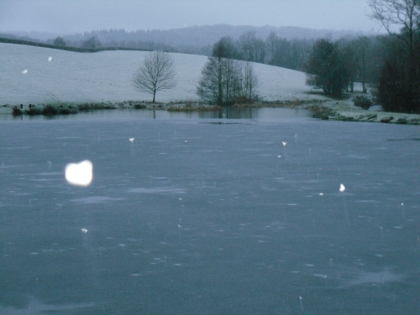
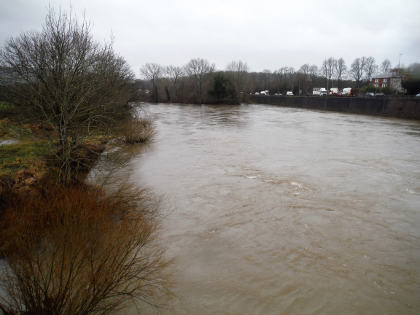
Tight lines for a new season!
Oliver Burch www.wyevalleyflyfishing.com
January 2018
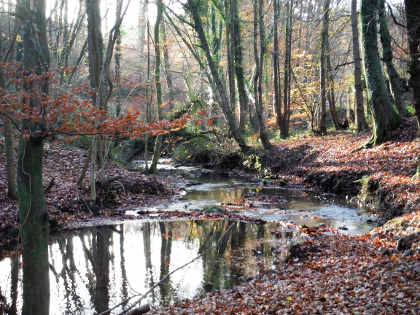
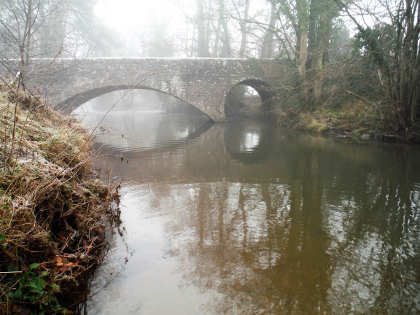
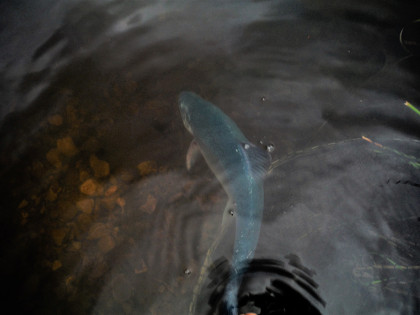
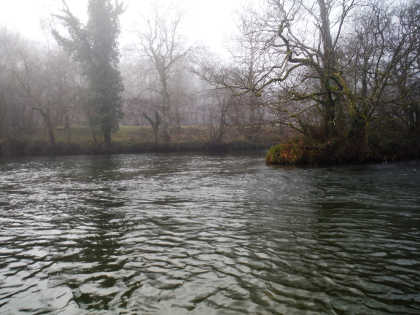
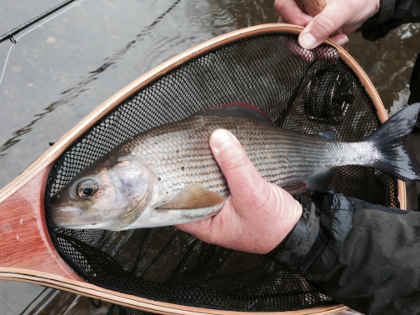
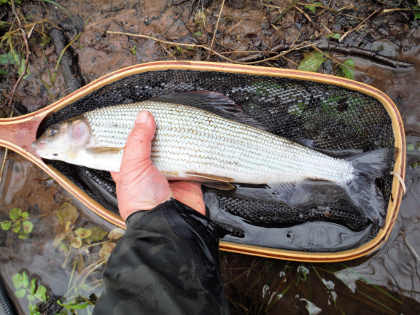
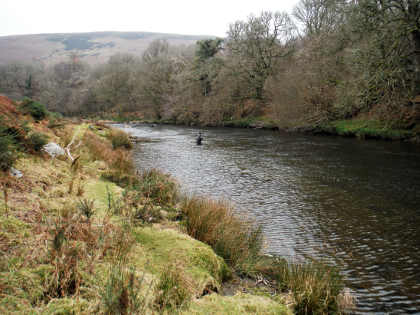
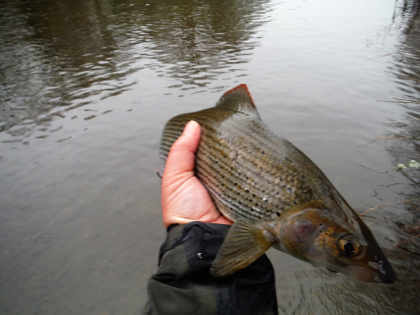
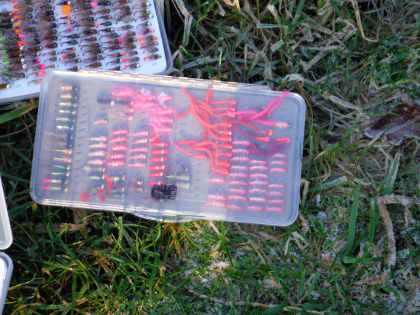
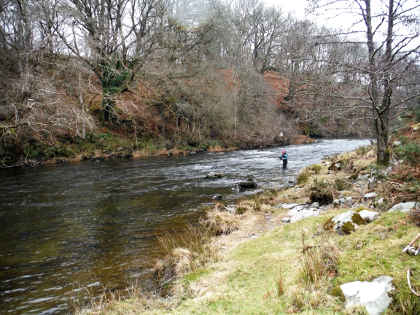
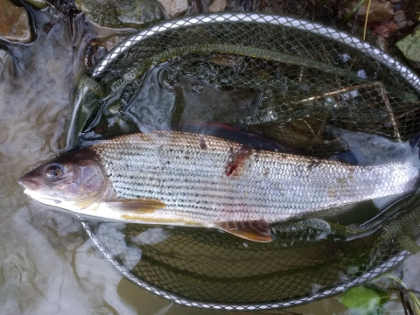
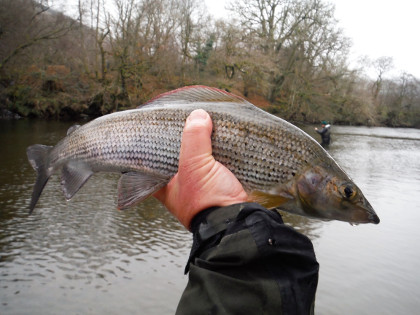
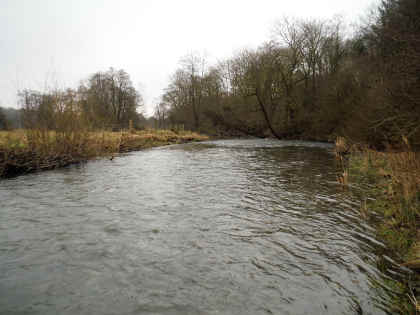
There was not so much fishing to write about this last month. As we all know, grayling don't mind cold weather once they have a little time to get used to it, so I would have been happy enough with frost or even snow, provided the rivers remained in condition. However, it turned out to be very different and the flood levels during this winter have made river fishing pretty well impossible for long periods. Some of the tributaries were briefly available for a few days. On the other hand the main Wye below Builth has been frustratingly out of action for three solid months now. My own angling activities this winter have mainly been confined to fishing for rainbow trout from clear spring-fed pools; the other stream-fed forest lakes, including our syndicate water, were frozen for more than 10 days before Christmas and later still full of muddy water. Once we had reached the solstice, 8 hours of light to 16 hours of depressing darkness, open air life was in any case somewhat restricted. I often wonder how my brother-in-law's family in Sweden manages to get through the dark months.
A few hours angling on commercial fisheries for twitchy catch and release rainbows does not exactly constitute engagement with nature in the wild, but lake fishing can be interesting at times and certainly better than sitting indoors. I spent some time at Woolaston with a five weight rod, floating line and a very long leader on which was mounted a size 18 Black Speck Nymph, casting into a low winter sun and letting the tiny fly sink deep before the leader would slide away. The fish were too nervous to take any larger fly, but it was amazing how the small hook would hold under pressure while yet another muscular rainbow would dash off dragging a drowned fly line behind it. The water temperature was around 4 degrees, so the trout were definitely by now in winter mode and at times a small Bloodworm would also work. It was mainly a matter of locating where the shoal was and letting the little red fly flutter down towards the bottom amongst them without retrieving at all. There are many ways of fishing lakes in winter. On another occasion with a cold wind blowing I even had a fish come up under a ripple and hit a little Snipe and Purple spider pulling round just under the surface.
After the New Year holidays I made a trip to the Glyncorrwg Ponds fishery in the hills behind Port Talbot, in order to plan a training day there next month. This was the day of Storm Eleanor and a major hazard driving down on the M4 had consisted of broken branches blown horizontally by the wind. "Why not have a fish in the pool while you are here?" the management kindly invited me. Thus I found myself standing on the dam throwing a very long line far out over the waves, which wasn't so difficult with the gale directly behind me. Despite the wind, it was not cold and every so often I could see the impressive black outline of a big trout very slowly head and tailing through the disturbed surface. Fishing was difficult using sunken flies, but eventually I got three from the top, all of them blue trout and the first fish of my year. One took a tiny Black Speck nymph fished round just below the surface, one on Bob Wyatt's Hare's Ear Emerger and one more on Bob Carnill's Shuttlecock Buzzer. On such a dark day, the small dry flies were quite invisible to me in that confusion of water, but if a rise showed as a patch of smooth water in about the right place I lifted the rod and a fish was there. I really hadn't expected to start January off using dry flies. Broadstone Fishery at Staunton near Monmouth also fished quite well with rainbows showing on the surface.
January on flowing water continued to be difficult. However, by the 7th the Irfon had come down to 0.70 metres on the Cilmery gauge. This is really still too high, but Lyn Davies, Rob Evans and I, all of us now badly affected by mid-winter cabin fever, felt we just had to get out and give it a go. It was a cold day, but the sun was bright and the river ran high and clear. It was hard fishing, but with the other two bugging while I wielded a trotting rod, occasionally resorting to a wee bit of Tenkara fishing, we managed to put a reasonable catch of grayling together. Unfortunately leaking waders and a wet leg had me gasping with cold on this occasion. High pressure and dry weather stayed with us for another week and while we were still waiting for the main Wye levels to fall, opportunities for grayling started to present themselves on the head waters and tributaries: the upper Wye above Builth, the Irfon, Ithon, Llynfi and the Monnow system. The Lugg and the Arrow were unfortunately still very high; once these springs are charged it takes many weeks for the levels to fall off again. Not wishing to waste any chances, I managed trips to the Monnow and the Ithon during this brief period. The lads and I also met to fish the upper Wye at Craig Llyn, where the water was running preternaturally clear as it sometimes does in winter after floods have cleaned out every last bit of silt or slime. Fishing on this day turned out to be difficult. We experimented with various nymphing ideas, but the best couple of grayling, curiously enough, were accounted for by the now extremely dated idea of using a floating line with a team of grayling fancy wet flies - Red Tag, Yellow Bumble and Grayling Steel Blue - all weighted with lead under the dressing. A few other regular anglers were now coming out to join us on the rivers and AS of Newent had 8 grayling from Cefnllysgwynne on the 13th. CP from Clevedon had 5 from the same fishery on the 14th . Everything changed again on the morning of the 15th, when some concentrated rain sent the water gauges shooting back up to flood levels very quickly. PB of Cheltenham nevertheless managed to extract 4 from Lyepole that day, including a cormorant-damaged fish taken on a Pink Shrimp. The Byton gauge on the Lugg was showing a good 1ft 10 inches at the time, so this cannot have been easy. On the 17th LJ from Machen took 5 from Cefnllysgwynne using the trotting rod, still in high water. Before we knew it, rivers had reached the serious levels of flood which moves gravel around in the pools and have us worrying about trout and salmon redds. The Wye at Erwood briefly shot up to 3 metres on the NRW gauge, close to the recent record. Warm gales continued from the west with band after band of rain. There followed a long period of no reported fishing which was broken by a call from Lyn and Rob on the 27th to explain that they had managed to catch half a dozen grayling, one of them a decent fish, from the Cammarch Hotel's lower beat on the Irfon. This was managed with difficulty while the level was showing 0.80 at Cilmery, and they were forced to abandon fishing early in the afternoon as the level started to rise again. To summarise it all, January opportunities for river angling were few. Bravo to all those who tried!
Mid-winter, while fishing opportunities are limited by weather, is inevitably a time for reflecting on the year just gone. Apart from the poor sewin run, the season of 2017 was really not a bad one to look back on and I can certainly remember some good days. In early spring the Usk fished well for trout, as it often does from the very beginning of the season. March browns and dark olives played their part. We are blessed in our region with some excellent mayfly fishing and the smaller streams of the Welsh borderlands did not disappoint during May and June. Moving on, there was also some excellent autumn grayling fishing until floods closed it all down by December. Salmon numbers for 2017 were slightly down, but not enough to dent the overall trend too much and the Wye still seems to be producing better results than other rivers. I recall that bright silver springer which came off after five minutes play in the Quarry Pool at Aramstone during March, the pleasure of taking a grilse on a little Black Pennell from the Chapel Catch gutter of the upper river during low water in summer, and a surprisingly excellent autumn day at Goodrich Court with the river running hard. All of these are reasons to be thankful that we have access to such interesting and varied fishing. I would appreciate some more grayling fishing now rather than to be confined at home tying flies, but I will also make an effort to be content and see what the rest of the winter brings.
My mid-winter reflections included more than angling. You may or may not accept the premise that in The Compleat Angler Isaak Walton was, among his other purposes, slyly, surreptitiously, raising a voice in dissent against the political policies of his time. Cromwell's Protectorate, puritanism and prescriptions against simple pleasures such as Christmas mince pies, music and maypole dancing may seem very distant to us today, but on reflection some of the social policies of the modern Taliban or Islamic State are quite similar. In his book Ike Walton had plenty of comments to make about life in his time and the universe beyond the business immediately at hand, that of fishing. Personally, I have never found it possible to keep my own interest in the sport of angling totally insulated from the outside world. Even if we wanted to, we can't live our lives in a dream, although the delightful process of angling can make it seem so for a few brief hours. Harsh reality breaks in. During the more routine parts of the operation, the mind wanders from the actual act of fishing and the problems of the world do intrude at times. It may be Catalonia, the Middle East, North Korea, US presidential politics or Brexit. Some may say: "I go fishing to get away from all that." In practice I can't quite, not for ever. Another inevitable truth is that a retired man who spends much time fishing alone, is going to be looking back in his thoughts rather than forward. I listen to the radio a lot while coming and going from fishing. And somebody caught my attention with an interesting statement on the radio the other day: "The further away the past gets from us, the sharper it becomes in its focus." That is strangely true. Looking back to the years of international work and our "nation-building" attempts, I confess that most of it now looks like failure.
If I spend some of my time alone and happy with a fishing rod these days, it is not that I hate social interaction. I like the charm of many small things and much to the fore in those would be a glass of wine with partner or friends. What should we talk about, fishing aside? Now Greeks and Italians, for example, just love to discuss politics. What do you think all those old men in the cafes are talking about while sitting for hours over a single coffee? But there is a polite British tradition of avoiding discussion of politics, national or international, as much as possible. Somebody might be upset, so let's rather discuss trivia. Thus were born our chattering classes, capable of making much noise with squeals of laughter, but saying little. My wife when first in this country asked why it is that Englishwomen, when they meet, do all this air- kissing of cheeks and high-pitched squeaking. I admit that sounds rather jaded and cynical, but I think this was a serious question from a genuinely bemused foreigner. Blessed if I can explain why. For myself, I rather tire of being British and polite all the time, but I will emphasise that the following thoughts and memories are mine alone and nothing to do with the WUF.
One late evening in the summer of 2016 I came back to the car in warm darkness after fishing Talybont Reservoir, feeling very relaxed and happy about a couple of nice brown trout I had caught. The world seemed pretty good at that moment. I put the tackle away, shrugged out of my waders, drank a coffee from the flask, started the car engine and switched on the radio as I began to drive. Immediately I learned that a military coup was apparently under way in Turkey. All the way home I listened to a dramatic live commentary as events unfolded. It is true there is a history of military coups in modern Turkey, which has been described as an army looking for a country. The Army certainly used to regard itself as the guardian of the modern Turkish republic's founding principles as defined by Mustafa Kemal. Even today the Turkish Army is the second largest in NATO. It consists of a professional corps of officers and NCOs with a very large number of conscripts doing their 12 months national service. I thought of Turkish officers I had known, in North Cyprus, and in eastern Anatolia where they were posted to deal with a Kurdish insurrection, a brutal conflict which was about as popular with individuals in the Turkish military as Northern Ireland used to be with the British Army. In Bosnia after the Dayton Agreement, a Turkish brigade in the south of my AOR had done excellent peace-keeping work and exceeded expectations by winning the respect of Serbs as well as Muslims. (The brigade also had quite a good military band, which everybody else in SFOR borrowed for parties). Most of the officers I had met had been reasonable, professional people, competent in their work. The soldiers were mostly cheerful teenagers, every one of them knowing exactly how many days they had left to serve. And I wondered what was happening to those individuals now.
By the next morning I was becoming unsure in my own mind that there even had been a real coup attempt. If there was, it was a terrible mistake. Erdogan certainly had his arrest lists all ready and waiting. The purge of Turkish society has continued ever since, so that more than 150,000 people have now been detained or fired from their positions in something like a reign of terror. Meanwhile Erdogan has been voted unprecedented powers. The state of emergency has just been extended for the sixth time. I used to like the old secular, Kemalist Turkey, which was more than anxious to befriend Europe, although elements within the EU persistently kept it at arm's length. The key to understanding Turkey is to appreciate that, with the Turks, national pride is always more important than money. They share that characteristic with Russians and Serbs. Rebuffed again and again on the West European side, they will now look East and North. I hardly recognise what Turkey has now become.
At the staff college last year I bumped into an old friend from the UN who served with me in Bosnia and Croatia. Once a British soldier, he lives now in Germany with his German wife. I told him over dinner that I had once imagined we had seen the last of fascism in Europe with the ending of the Franco and Salazar dictatorships. Certainly we never thought to see the politics of the 1930s and 40s again. But instead fascism - I don't use the word lightly - turned out to be alive and well and living in south-eastern Europe. "That's the point," said my friend. "It never really went away, did it?" During and after the years of war in Yugoslavia we had both of us seen more than enough of that notorious "Roman salute" and accompanying shouts of "Ready for the Fatherland, Commander!" Most countries have lunatic fringes on the far right and far left. But such a chanting demonstration is illegal today in Germany or in Italy. Those are nations which have confronted the past and atoned for it. In my book, they are square with the house and have been for a long time. But further east, among other former allies of the Axis Powers, the chant with its accompanying extended arm salute is being heard more and more, at rock concerts, at football matches and in church. There is a strong modern nationalist movement to reinstate the memory of fascist leaders from the 1940s, masses are said for them, even streets renamed after them. Russia is the one nation which has taken note and objected to this revisionism; Foreign Minister Lavrov mentioned it in a recent speech to the UN General Assembly. It is surprising how many of the more senior individuals in the resurrected right wing nationalist parties of the Balkans were once officials in the Communist party in the old days. The point is that these are people who have learned to work a system, any system, to their own advantage. A very clever Columbian I worked for in UNHCR had an expression from his homeland to describe this phenomenon: "Same pigs; different ribbons."
For a week at the end of November, my wife stayed with her mother in Mostar. The old lady is feeling her age these days. The usual winter trip to visit us in the UK, preceded by the necessary journeys to the British Embassy in Sarajevo for visa applications, is now getting beyond her. Our friend Mustafa heard Nerma was coming and put in a request for her to bring some fly-fishing bits and pieces - you can't get Gink and Zink in Mostar, or so it seems. My wife has known Mustafa and his family for a very long time. 25 years ago I had something of a professional relationship with Mustafa when he was an intelligence officer in the Bosnian Army in East Mostar. Even then, once we discovered each other's mutual sporting interest, conversations we were necessarily having about conditions in military prisons tended to end in fishing reminiscences. A fundamentally decent man, he was responsible for the release, may have saved the lives even, of two young Croats who were being tortured.
Early on the morning of 29th November, towards the end of her stay, I had a text from Nerma. It seems there had been one of the "hot" nights in Croatian controlled West Mostar where her mother still lives, last Muslim in the block. All the churches had been open as all-night vigils were held and the Franciscans offered prayers for six convicted war criminals, who had already been given sentences ranging from 10-25 years for organising the murder of civilians and ethnic cleansing during the past conflict. In the morning they were due to hear the results of their appeal after final consideration of their cases by the International Criminal Tribunal for Yugoslavia at the Hague. Having worked since 1993, this was to be the ICTY's last task before the institution's closure. In West Mostar that night the cafes were full and drunken anger became palpable as the old fascist songs rang out. Well before midnight tracer was flying up into the sky and windows vibrated as magazines were emptied defiantly at the stars. Nothing seems to change; so much for all those disarmament programmes we ran post-war. The few remaining Muslims and Serbs kept close to their apartments with locked doors.
Next morning the Hague tribunal issued their judgment. The original verdicts and sentences were confirmed. The judgment also made it clear that, had he not died some years before, Croatia's former president and HDZ party leader Franjo Tudjman, would have been indicted on the same charges. The original 1940s project to create an enlarged Croatian state, ethnically pure, white and ultra-Catholic, including the whole Bosnian city of Mostar and surrounding areas of Herzegovina, had as much support during the 1990s from the Croatian capital Zagreb as from West Herzegovina. As an eye witness, I can confirm that tanks, artillery and special forces from Croatia proper took part in the operation. With the television cameras running, Slobodan Praljak, wartime leader of the Croatian Defence Force in Mostar, stood up in court to hear his sentence reconfirmed, shouted in defiance and committed suicide by drinking poison. How could he have obtained it in a supposedly secure UN facility? Interestingly enough, as he had been detained since 2003, he would only have had a few months left to serve. He probably thought - and I guess he was right - that martyrdom was by that time the best contribution he could make to the continuing cause of a Greater Croatia.
And today? Nerma came home in stages as usual, first by car with cousin Enver to Split and then in short air hops to Heathrow via Zagreb and Vienna. Waiting in the lounge of the Franjo Tudjman Airport in Zagreb, she saw on the television that the Sabor, the Croatian parliament, were standing heads bowed holding a minute of silence in homage for the soul of Slobodan Praljak. Prayers were being offered in Zagreb churches too. It's a curious thing, you might think, for an EU national parliament to be standing in hushed respect for a convicted war criminal who engaged in genocide, treating him as a patriotic hero. But that's the way things are in those parts of Europe. I wonder if Brussels will ever sit up and take notice. For that matter, I wonder if Rome will.
Western European politicians can be remarkably naive and the full consequences of a rapid expansion of the EU into Eastern Europe with all its corruptions, tensions and prejudices have yet to be felt. Until the next military round - of which I am quite certain - ethnic engineering continues in ways which are strategic and reprehensible, but difficult to challenge as they are perfectly legal. Croatian families will pay three times the market price for Muslim-owned property in Mostar just as Israeli Jewish families pay over the odds to buy out Arab owners in East Jerusalem. There are many ways to gain and hold control of territory. Meanwhile that chant continues, even in schools: "Za Dom, spremni! For the Fatherland, we are ready!"
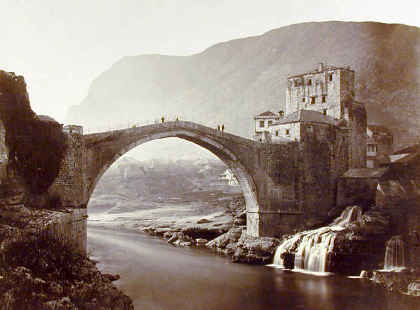
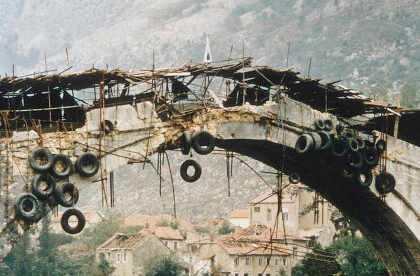
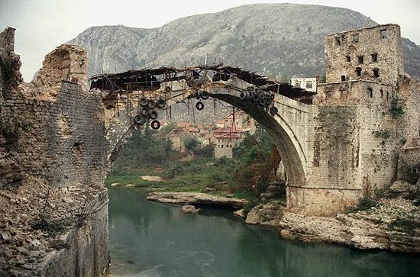

Nerma is more than relieved to be home. My wife still tries to think of herself as a South Slav and would prefer that nobody cares about the ethnicity or the religion. For her, there has never been an East or West Mostar. Her family lived as long as anybody can remember in the city the Ottoman Turks built by Stari Most, the Old One, as everybody calls Hairudin's 16th century bridge over the Neretva. The city adorned with its mosques and churches, both Orthodox and Catholic, was named for the bridge and its people have always been called "Bridgers," or Mostari. The city's famous and very oriental love song, Emina, which begins "In the garden of the old Imam," was written during the 19th century by a Mostar Serb, Aleksa Santic. Later the Turkish bridge came to be seen as a visible symbol of Yugoslavia, linking religions and communities: as such it was on the jacket of Rebecca West's renowned book about pre-war Yugoslavia: Black Lamb and Grey Falcon. But in 1993 the Croatian authorities who had taken over West Mostar forced her along with other Muslims to identify themselves by wearing a white arm band at all times while Muslim men of military age were interned under brutal conditions. A year before, her father and his team had scrambled overnight to protect the Old One from shells and snipers with tyres and a roof of boiler plating. In the end, the protection proved to be futile; a Croatian tank parked on a bluff worked for two days to destroy it. Muslim and Croat forces fought themselves to a standstill in the city over 10 months while Serb forces on the eastern hills lobbed shells onto both sides as the whim took them - or according to payments received.
The aspect of a city which has experienced an internal war is always striking, stone and concrete eaten away by small arms fire and shells. Afterwards, visitors shown the Boulevarde and Santic Street, where the front lines had been, invariably came up with the word "Stalingrad." Elsewhere, newcomers would remark the sniper screens to protect pedestrians, made from rows of school lockers filled with bricks, every shady pavement tree cut down for firewood, every little city park full of fresh graves. "I hate this place," Nerma had written to me in her November text from her once beloved and beautiful home town. "I'm so ashamed of my people." Most of her old school friends left long ago, and are now making new lives for their families all over the world: in the US, Canada, Australia, New Zealand or Western Europe.
During December the Welsh Marches were gripped in ice with a bitter wind blowing fallen snow into drifts. In some areas the temperatures were as low as minus 12 degrees and rural roads were closed. With the rivers high, I hadn't even thought about fishing for a few days. Our daughter was due back with her battalion in North Shropshire early the following morning, but the train had been cancelled due to tree falls on the Shrewsbury line. Rather than have her try the roads in her little 2 wheel drive, I fired up the old Landrover and we headed across the snow-bound forest and then north for Hereford and the A49. Despite the cold, the winter scenery in bright sunlight was enchanting. In succession the Wye, Lugg, Teme, Onny and finally upper Severn flowed sullenly black between white banks. We chugged along slowly on icy roads with an arctic wind blowing snow across the fields. Reaching Ternhill just after midday, I dropped Medina off with her bag at the guardhouse to drink coffee with her Ranger mates, before heading for home.
It's a long way back without any company, so I switched on the radio, which is a battered old set and now only gets long-wave BBC Radio 4 and a few French stations. Radio 4 gives an excellent service discussing mostly serious issues between 7 and 9, and again in the evening, but I find the middle of the day can be drearily anglo- centric: Woman's Hour, You and Yours, Gardeners' Question Time, Money Box, Just a Minute. There seem to be endless programmes about the National Health Service. When it comes to The Archers, I just have to switch off. Maybe I should get a new radio for the old car? Maybe I should get a new car? If these are some of your favourite programmes I can only apologise for my growing intolerance, which may very well be a sign of increasing senility. At this time of year, with no fishing to keep me happy, I'm starting to sound as grouchy as Jack Dee on a bad night. But if I was at home tucked up on the sofa, I would probably have been be flicking through the satellite news channels - Sky, BBC News 24, Euro-News, Russia Today, CNN, France Vingt-Quatre, Al-Jazeera - in hope of finding something interesting or significant. News channel hopping can become almost as obsessive as continual river gauge watching. I might even have tried to do the Trout and Salmon crossword while waiting for Have I got News for You? Instead, here I was crossing the desolate snows of Shropshire accompanied by the favourite radio channel of the English middle classes. In fact, I was pleasantly surprised and perked up in my seat. An international reporter was presenting a piece about the Yazidis of northern Iraq and particularly the Yazidi women.
Another conversation at the staff college, this time a few years back. On this exercise I was sitting next to a colleague seconded from the Foreign Office, what we call a STABAD or stabilisation advisor. As it happened, we had both spent time working for the reconstruction of Iraq and of course we discussed the whole situation. A favourite subject between us was speculation on just when would the Iraqi Kurds go for full independence and would they get the oil field of Kirkuk to finance it? These are still matters of interest - the Kurds tried it disastrously last year and they failed to hold Kirkuk. But that particular morning the news came online of a new force emerging in the turmoil of the Sunni Arab areas of central Iraq. This was something called Islamic State, an extremist group which was proclaiming a new caliphate and actually controlling territory. I was taken aback, quite appalled. My colleague, no fool by any means, was taking the optimistic view which our government was then promoting. "It's ephemeral," he said. "Nothing to worry about. The Iraqi National Army will take that back in a few days." "My God!" I told him. "I do hope you are right about that."
Of course he wasn't right. I only wish he had been. At one point IS managed to control 1/3 of Iraq. I was always more or less a pessimist about the Iraq reconstruction project and found it hard to see how modern Iraq could remain a unified state in the long term. Three times during the period of our military presence I gave evidence to a parliamentary select committee on the subject and told them each time that the situation was becoming worse and the problem wasn't money, but resentment of Coalition forces and a lack of security for the domestic population. MPs would ask whether more development money devoted to this sector or that sector would help; my advice was always that the problem for our Iraqi partners was not a lack of money, but a need for security so that they could work. Other humanitarians delivered the same message. Back in in 2005, Andy Bearpark and I were invited to a Panorama debate on the status of Iraq reconstruction (Michael Gove, of all people, was leading an argument that the project was succeeding). Andy's view was even more pessimistic than mine; he felt that the situation in Iraq was becoming worse by the day and that we should pull our troops out as soon as possible.
One thing I do recall from the Iraq years, was that for a short time, while the money lasted, I looked after a programme to benefit the Yazidi people in the Sinjar area of Northern Iraq. This was a mainly agricultural and community support programme implemented by a Kurdish partner. There is something very likable about the Yazidis of Ninevah, where they seem to have existed for 4,000 years. They are a minority without any strong aims to nationhood or independence, anti-militaristic by choice, mainly engaged in agriculture, and closely aligned to the natural world and their ancestral landscape which they regard as something mystical. Their religion is most unusual, combining elements of Islam, Judaism, Zoroastrianism and Christianity. They believe themselves to be children of Adam alone, but not Eve. They believe in seven angels, the most important of which is the so-called Peacock Angel, whose image adorns many of their shrines. Another of the angels, which they call Shaitan, has led to them to be inaccurately accused of devil worship. They also believe in elements of Sufism, the non-violent Islamic cult which can be found in Afghanistan and Central Asia.
Including the diaspora, there might be as many as one million Yazidis in the world. They have been described as a Kurdish minority following a particular sect, but although they speak the Kurdish language most Yazidis deny this and feel themselves to be a totally separate people. Nevertheless, despite very different philosophies, generally the relationship with the Kurds is good. No doubt there have been exceptions but Kurds I knew seemed to want to look after Yazidis as fondly as they would slightly eccentric and colourful cousins. Yazidis do not intermarry and do not look for converts. They have no ambitions beyond cultivating their traditional lands. In the region they had the reputation of being a threat to no-one.
However, the Yazidis suffered more than any group when Islamic State took over their villages. Many fled, and you will remember President Obama authorising air strikes to help Kurdish forces trying to rescue Yazidi civilians trapped without water on Mount Sinjar. In despair, they had seen the dry mountain as a holy place of sanctuary. While Islamic State was brutal enough towards Christians and Shia Muslims, they regarded the Yazidis as barely human due to the nature of their religious beliefs. Something over 5,000 Yazidi men were executed when they refused to convert to Islam. Their women became sex slaves, traded as "wives" around IS fighters in their barracks, and sold openly with their children in the markets of Mosul.
Today the tide of war has turned and Islamic State are on the back foot. As the BBC reporter described, escaped Yazidi women are being welcomed back into their community with something like a baptism or rebirth ceremony to wipe away the pain of their enslavement. Pacifism did not serve the Yazidis so well and many, including women, have joined the Kurdish Peshmerga to continue the fight against the remnants of IS. Today it is Mosul which looks like Stalingrad. As their territory collapses, the new humanitarian and security concern is what will happen now to the families of IS fighters and other civilians who supported Islamic State. Many of the surrendered seem to have disappeared without trace. This includes numbers of foreigners who were persuaded by the propaganda to join the movement. Families in Chechnya and other European countries, including Britain, are also without news of their children.
It's interesting how our society has changed in the way we view people who go off to fight in foreign wars. British "volunteers" fought on both sides in the Spanish Civil War, and were generally rather approved afterwards as having shown a spirit of adventure and commitment. No British law had been broken. The British socialist writer George Orwell came back and wrote Homage to Catalonia about his experiences. To have fought for the Spanish republic in the International Brigades was almost an essential qualification for a career in the British trade union movement during the 1950s. I had a great-uncle, a flyer named Peter Russell Burch, who in 1939 went with other British volunteers to fight for Finland against the invading Soviet Union, seen then as a David and Goliath conflict. These Winter War volunteers appear to have received a certain amount of unofficial Foreign Office approval. He never saw action, but eventually came back with others in a sealed train through German- occupied Europe, finally arriving home on a ship from neutral Portugal. According to family legend he turned up in Gloucestershire with a knapsack full of Portuguese oranges.
Later still, "volunteers" were more usually called "mercenaries" and were much less likely to be approved by the press or the public. Three Brits with military experience that I know of fought in the Mostar Brigade during the Muslim-Croat war. "Ron," a one-time apartment block janitor from North London, married a Bosnian wife and brought her out to Split in my car in 1994. "Scottie", believed to have been AWOL from the Scots Guards at the time, filmed the destruction of the Old Bridge and was killed the following month. "Norrie," formerly of Hereford, trained snipers for the Brigade and is doubtless still around somewhere, getting into trouble in bars. "Mercenary" was an inaccurate word to apply in these cases. As far as I could tell no money to speak of was involved, although there may have been something of a Walter Mitty element to their decision to serve. You might say the same about the humanitarian volunteers, except that we had not picked a side, or at least we tried not to.
After the Dayton Agreement, I came across several Russians who had fought in the Bosnian Serb forces, married locally and thus avoided the Agreement's clause defining that all foreign fighters should leave within a month. They were now living quietly in the Serb-controlled area of rural Eastern Bosnia and seemed pretty decent people. One of them was particularly helpful to displaced Bosnian Muslims returning to nearby destroyed property and ran power lines to help them while rebuilding. In their case, the dire state of the Russian economy at the time was definitely a factor in keeping them in Bosnia.
The so-called Mujahadin Brigades based on Zenica during the war were another matter entirely. These included some of the scum of the Middle East, supposedly released from long jail terms or even death sentences on condition that they go to fight the jihad in Bosnia. Most of these left the country after Dayton along with the Iranians and other theoretically clandestine supporters of the Bosnian state, but a surprising number remained, again having married Bosnian wives. On my own patch I was left with a particularly problematic mujahadin community occupying the Serb village of Bocinja in Maglaj municipality. They had been deliberately placed there because of the village's strategic location on a river crossing; at the same time the displaced Serbs from Bocinja were my beneficiaries and they wanted their village back. It was difficult to identify just who they were, because they used pseudonyms (their leader styled himself Abu Hamza), but Arabic was their language and we were fairly sure the community included among others Yemenis, Tunisians, Egyptians and Saudis. We identified support from the Bosnian Government (President Izetbegovic's political advisor described to us having "... a moral dilemma about this as we owe a debt of gratitude to those people"), support from the Maglaj municipality which donated the rents from a market to the community, and also from the Saudi embassy which was supplying vehicles and food. When approached, the US embassy was surprisingly reluctant at first to use political leverage to move the mujahadin out of Bosnian Serb property. One American official asked with a smile if they had big beards and curly-toed shoes. This was, of course, before 9/11.
Meanwhile, local Bosnian people, Serbs, Croats and Muslims alike, were all absolutely terrified of the group, which had managed to create a dark cloud of fear around Bocinja. When I came to the area even most SFOR and international UN police units were avoiding the village. Everybody locally knew that the mujahidin had fought a truly horrific war by European or any other standards, avoiding taking prisoners but instead torturing and cutting heads. Rather than hide such war crimes, the mujahidin were now actively publicising them, taking care to circulate various notorious photographs of their fighters holding severed Serb heads. This is the first time I saw evidence of war crimes actually used by the perpetrators as psychological weapons. With a Polish SFOR major, I interviewed two Serbs who had ventured to look at their houses, but been captured and held 48 hours in Bocinja, undergoing several mock executions in which a running chain saw was passed over their outstretched necks. This happened more than two years after the Dayton Agreement. Although it took years, eventually the mujahidin were moved out of Bocinja to make way for those Serbs who had the courage to return, but not before another group of them had set off a car bomb outside a police station.
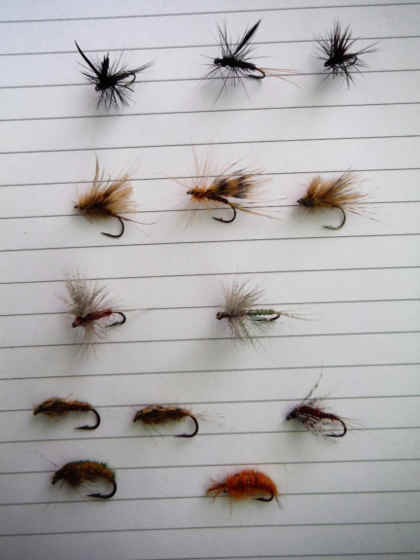
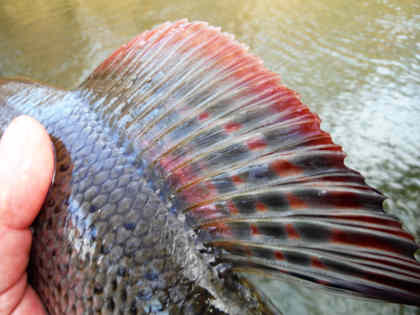
So now we have the collapse of Islamic State, which also used terror as a potent psychological weapon, and whoever controls Iraq and Syria will have to consider the future of those who joined the group. For our part we will have to consider not only the volunteers, including British, who gave IS their whole hearted support, but also their wives and their children. Will they come home and how? As our security services point out, people with that ideology and that training pose a most serious danger to our society. It's a far cry from George Orwell's return from Spain in 1937, is it not? Civil wars are dirty wars; only give stupid people power and a gun and finally everybody dishonours themselves. At the same time, they provide opportunities for extremists. Of the identified Al Qaeda 9/11 hi-jackers, it's not generally known that two of the Saudi-born were jihadist veterans from Bosnia. Khalid al-Mihdhar and Nawaf al-Hazmi were in the team which crashed Flight 77 into the Pentagon. Khalid Sheikh Mohammed, widely seen as the main planner of 9/11 and currently held at Guantanamo Bay, took out a Bosnian passport in 1995. These depth of winter thoughts are leading into dark places, so forgive me.
Nerma came back from Mostar with a small box of Neretva fishing flies sent by Mustafa. I hadn't realised how the Herzegovina school of fly fishing has changed during the last years - they have caught up with the rest of Europe! Instead of nymphs pulled deep by heavy lead weights they are now using proper fly rods, casting lines and even dry flies on some of the tributaries. Here the patterns are. The nymphs and a couple of shrimp patterns are unweighted and rather remind me of the first nymphs developed by GEM Skues. In fact Skues actually fished in Western Bosnia, a rather unusual destination during the 1930s and well off the beaten track. The dry flies certainly look like the kind of patterns which would work on our rivers - I will let you know about that in the course of time. There are some obvious Black Gnats with hackle point wings, and a couple of dry flies with forward pointing wings made of something like mallard breast, rather like John Storey. Also brown flies, reminiscent of sedges, which apparently have eagle feathers involved in their construction - which is slightly worrying, if true. In fact, knowing the vagaries of the language, I suspect for eagle you might substitute griffon vulture, an equally rare bird which nevertheless can be seen haunting those limestone cliffs above the Neretva. Whatever I may feel about cormorants and goosanders, please don't imagine that I have no care for genuinely rare birds!
I promise to try to write something useful about fishing next month! Snow drops and the first lambs have already been seen, so spring and a new season are not far away now.
Oliver Burch www.wyevalleyflyfishing.com